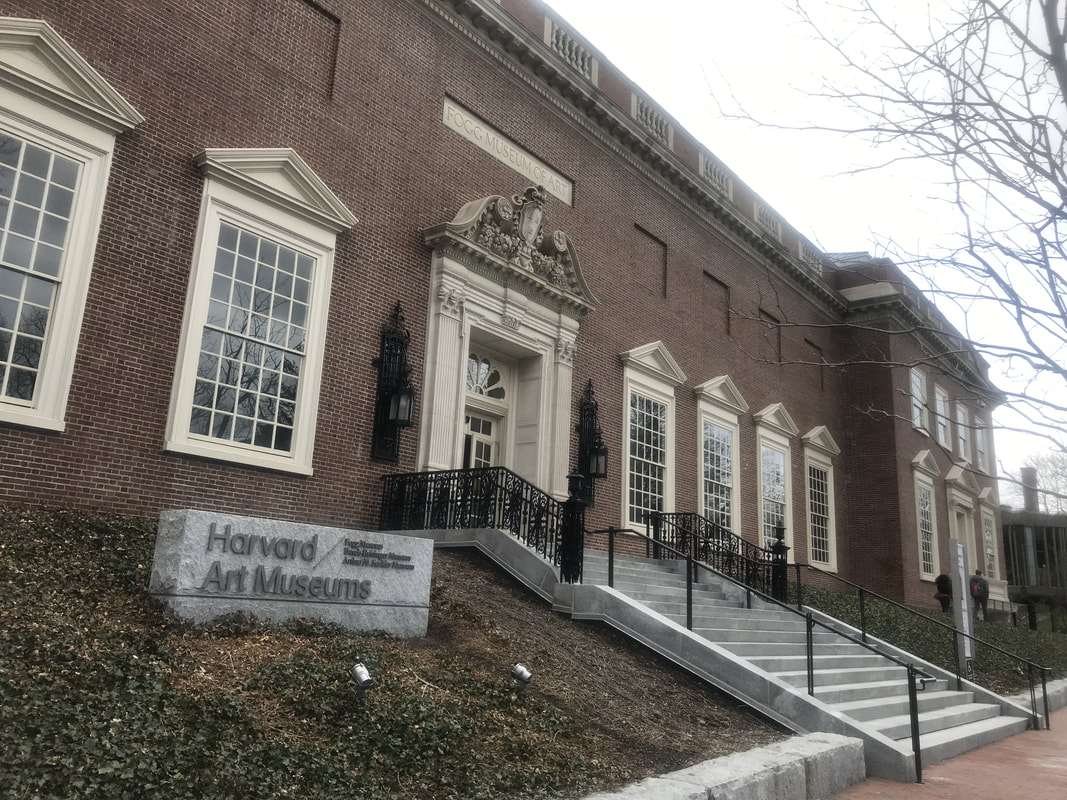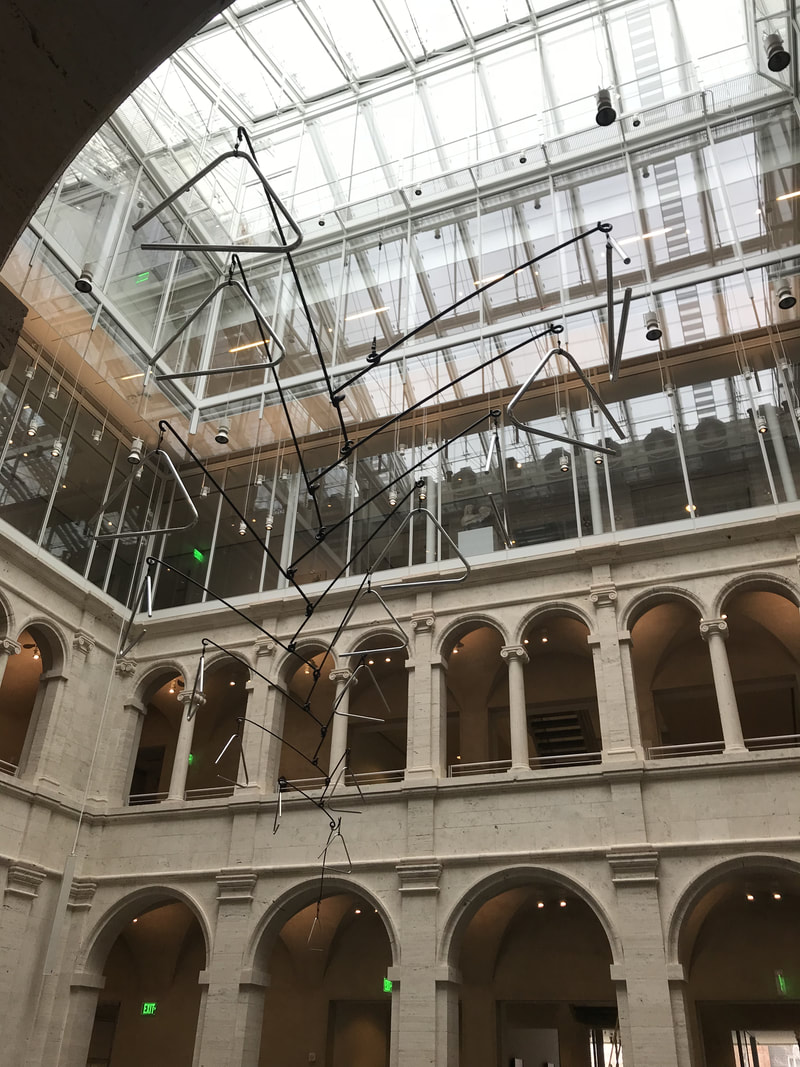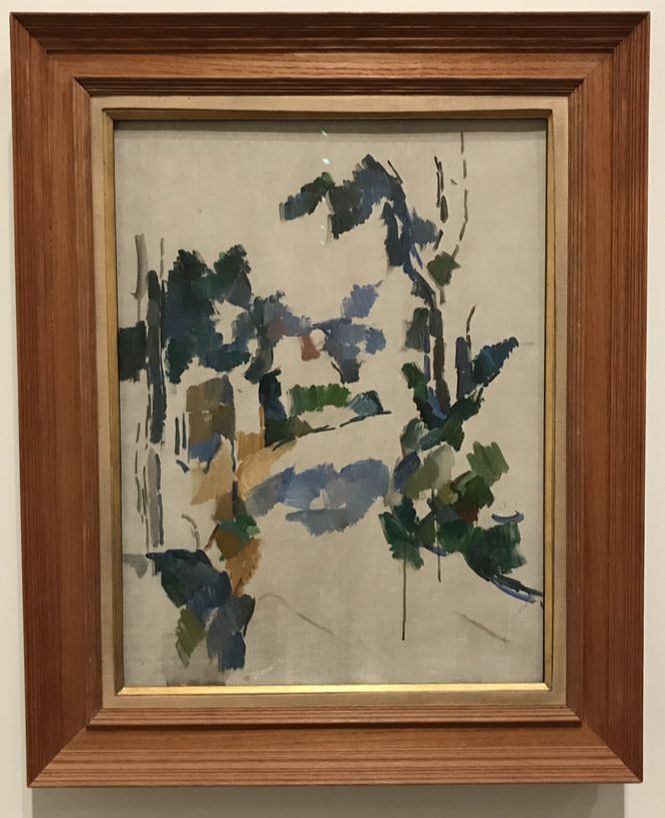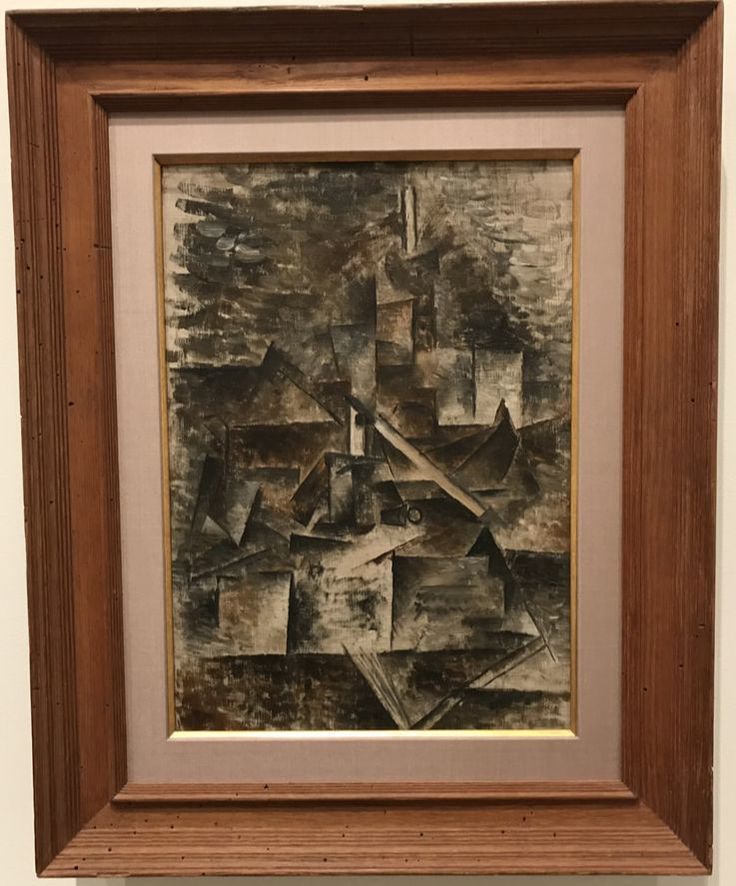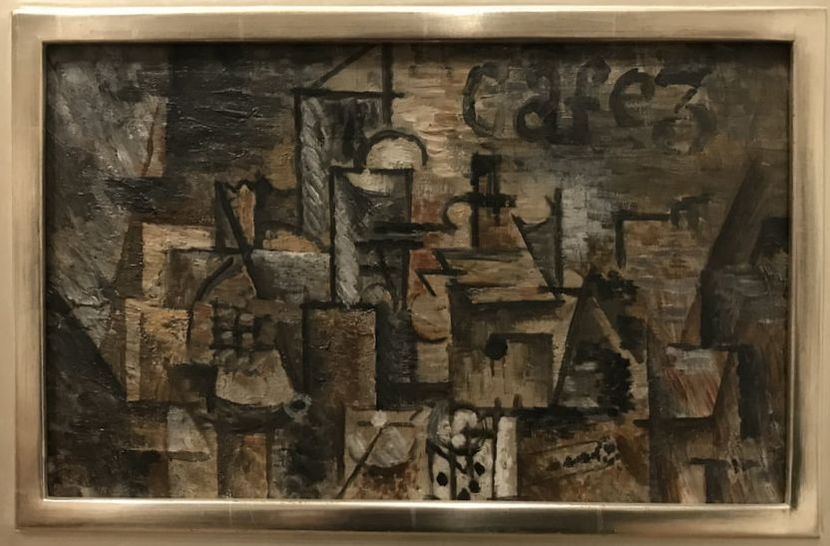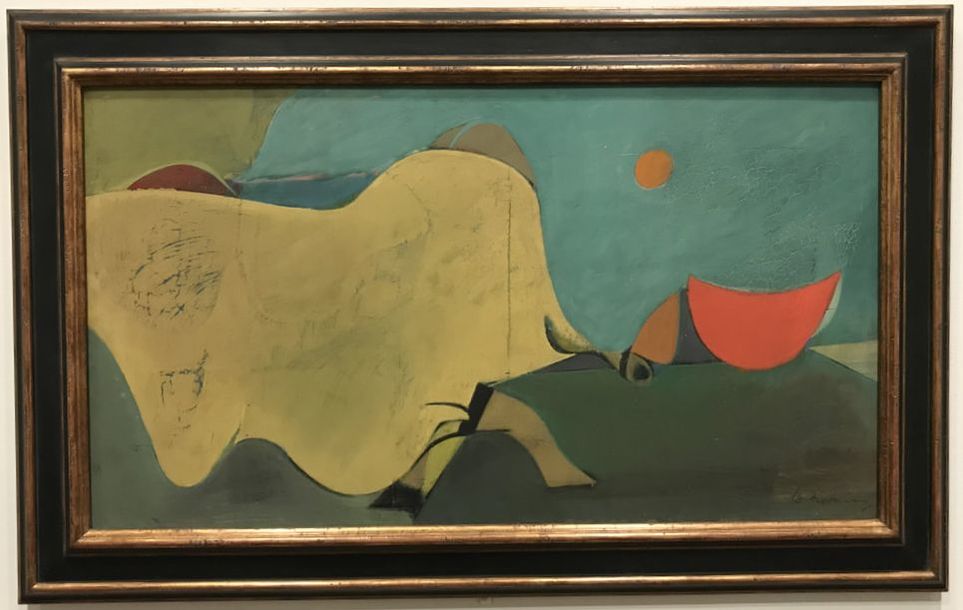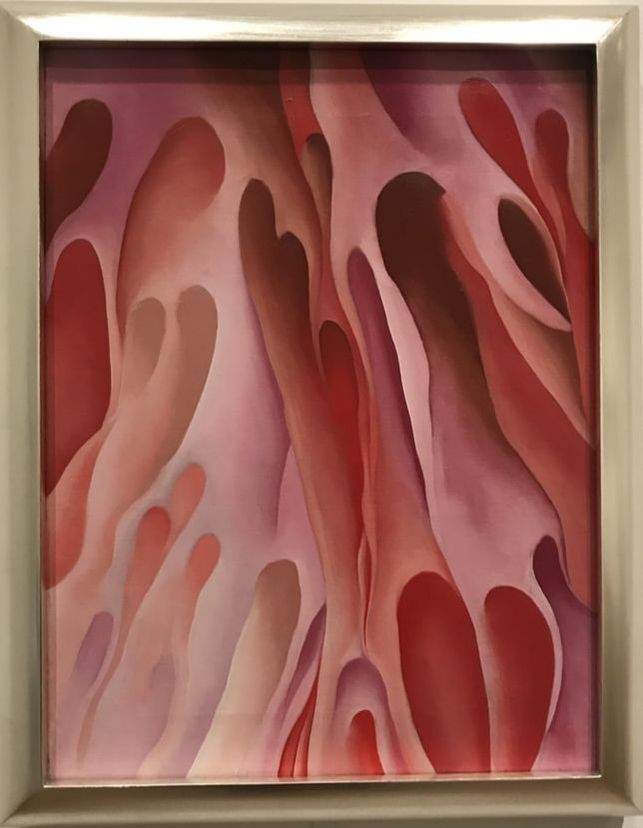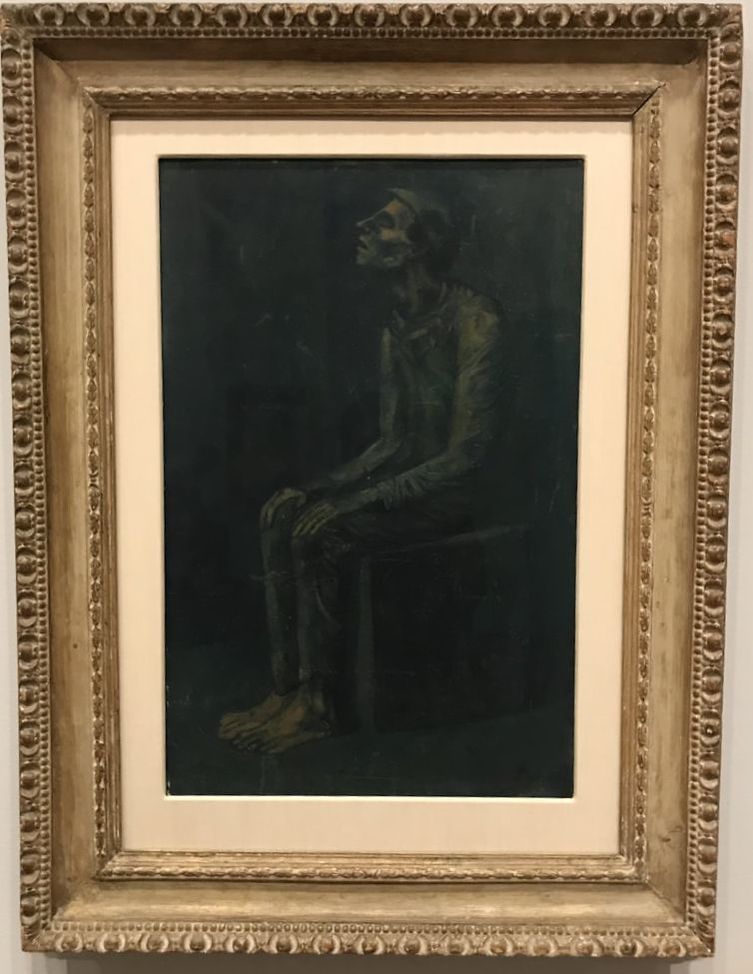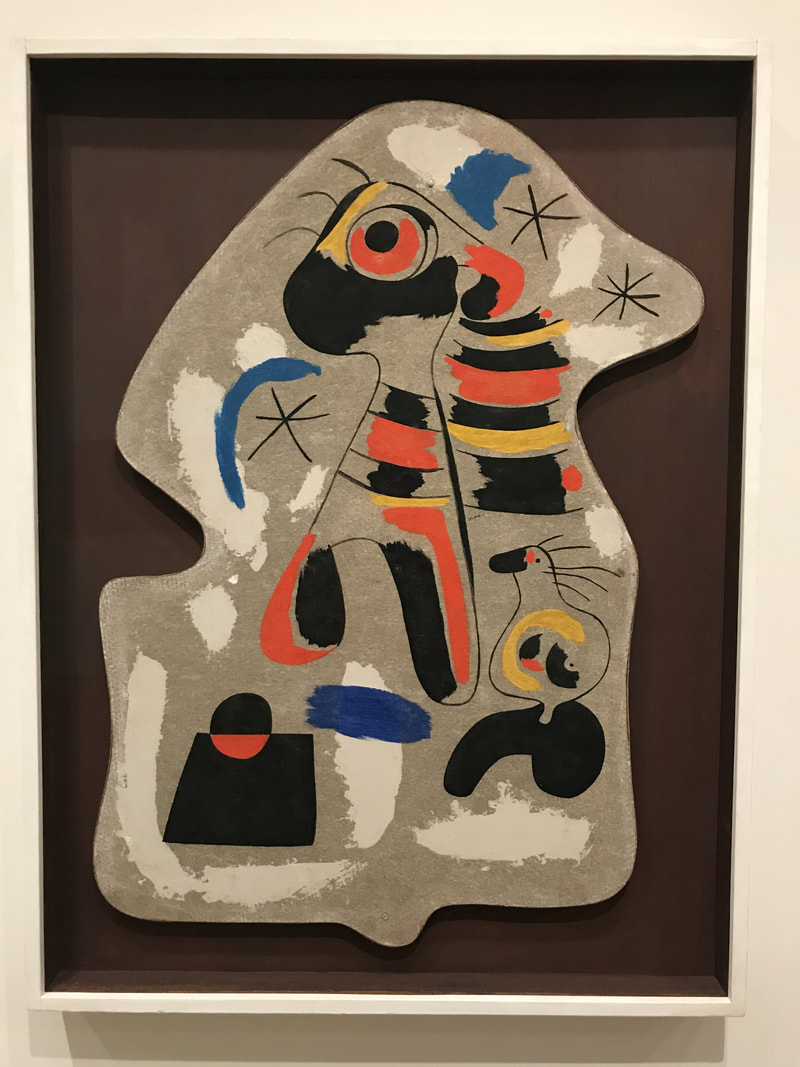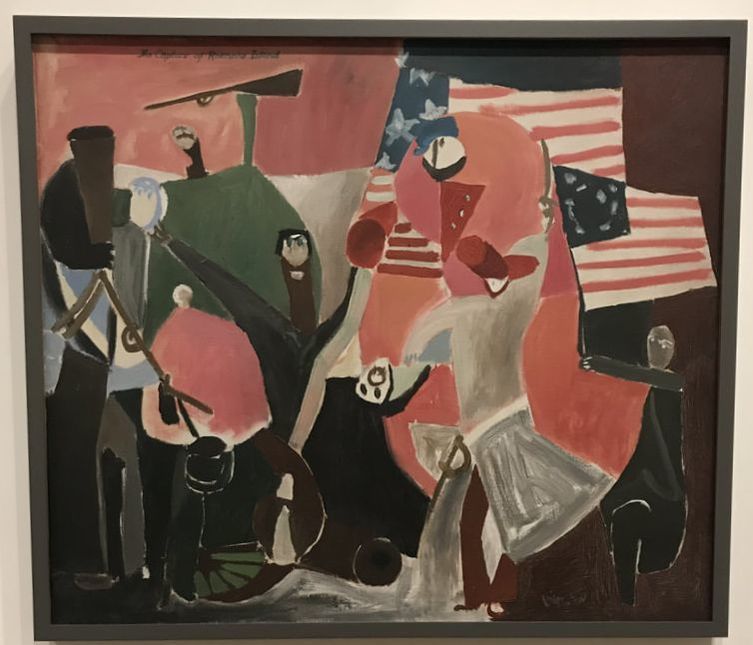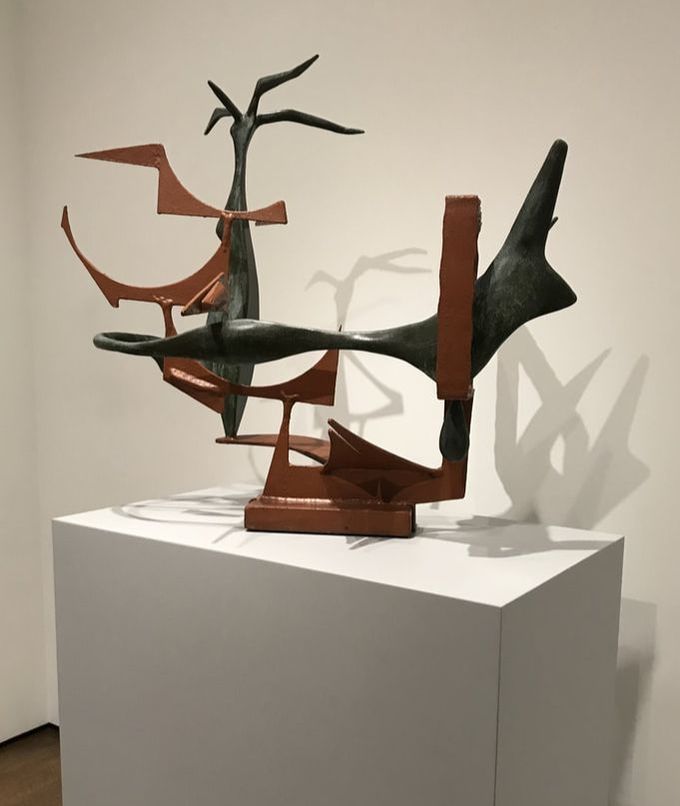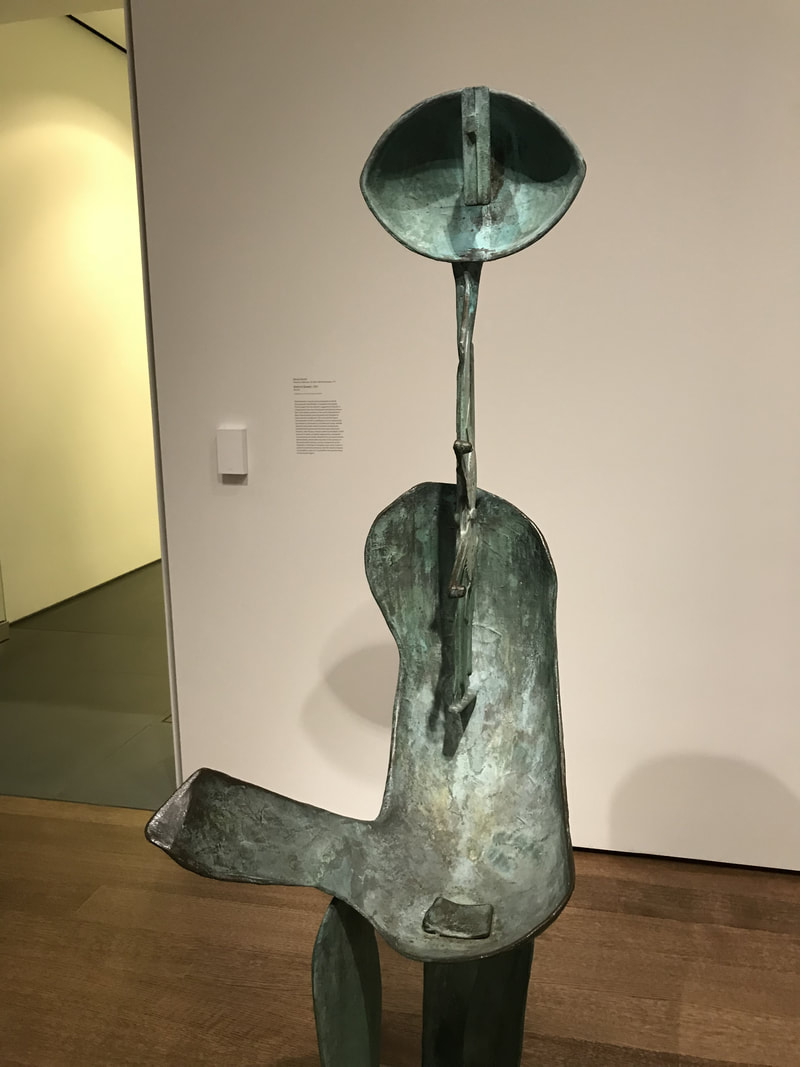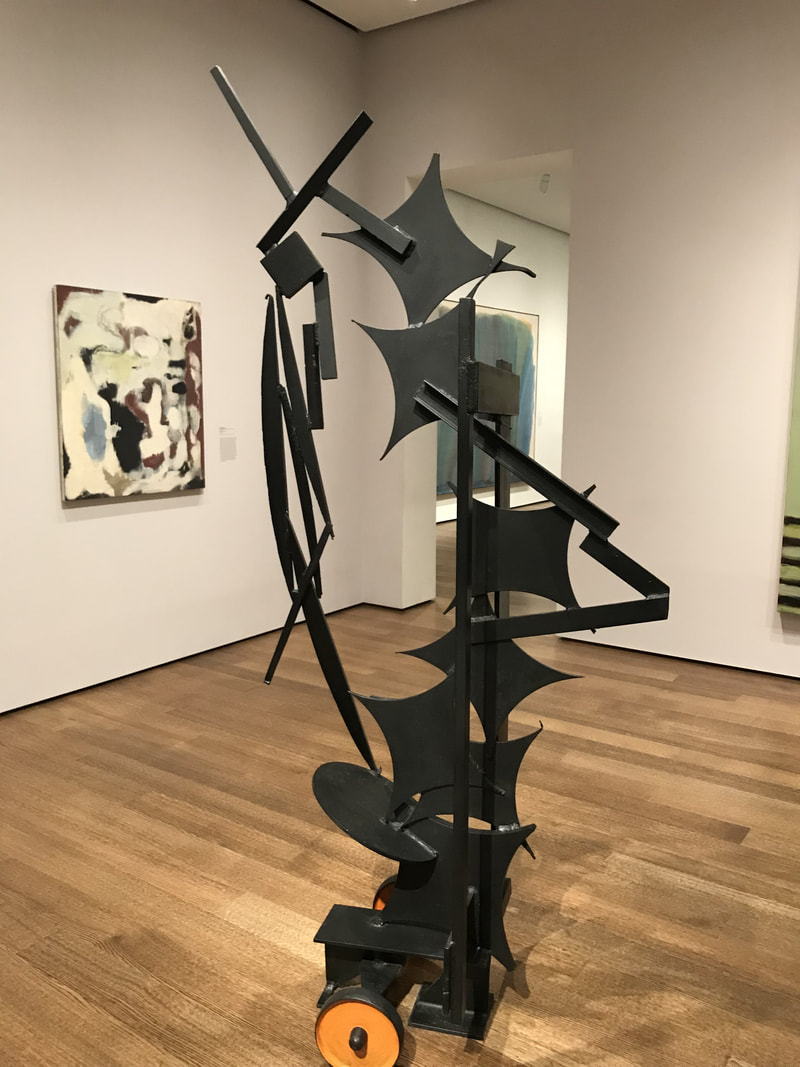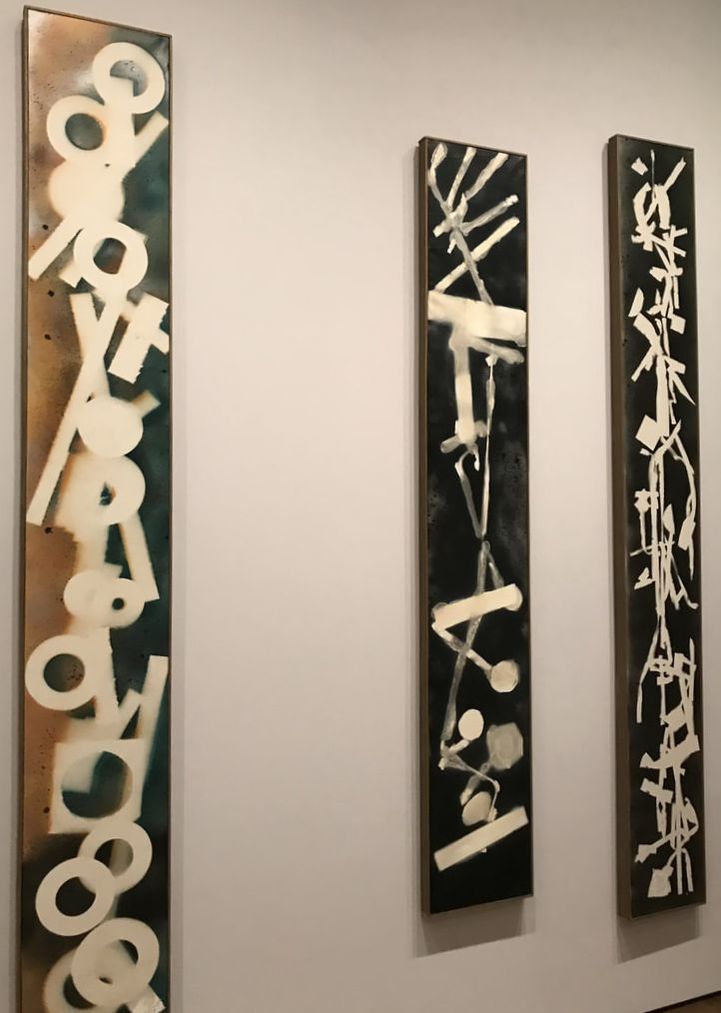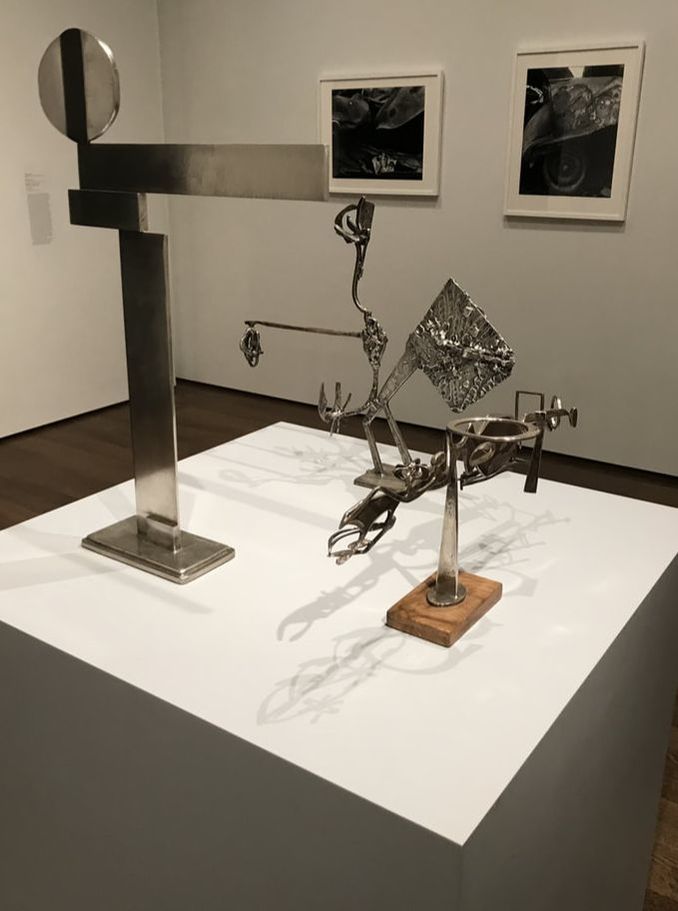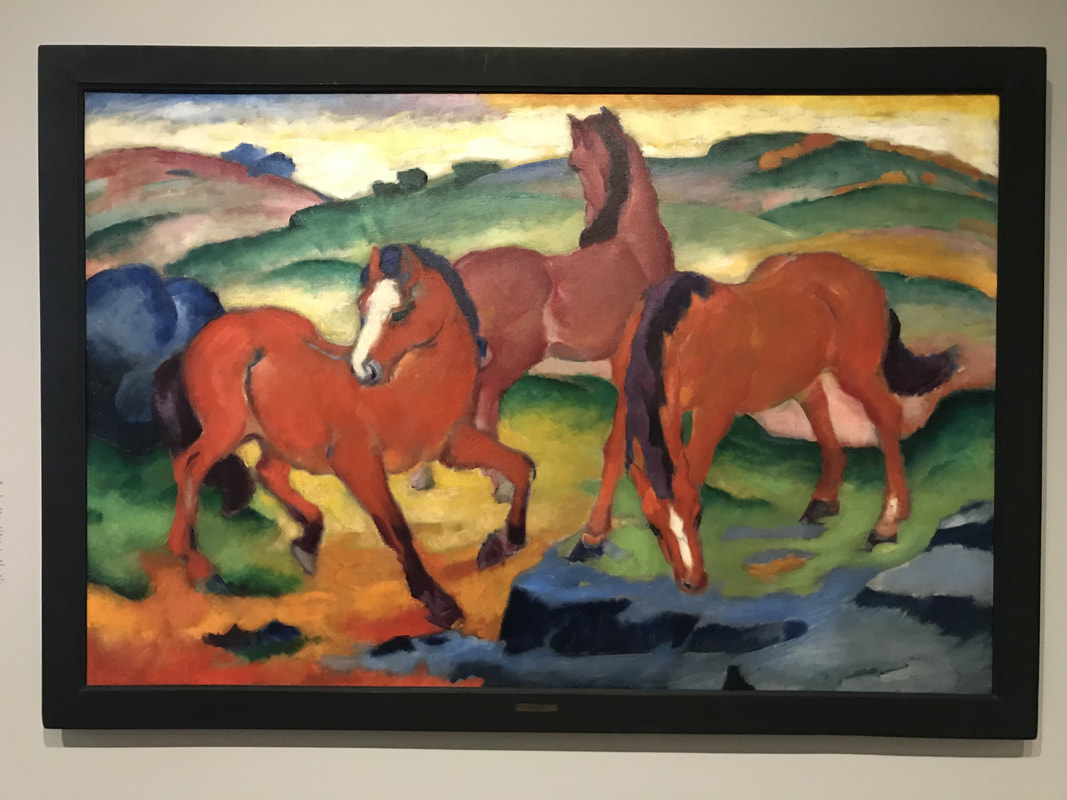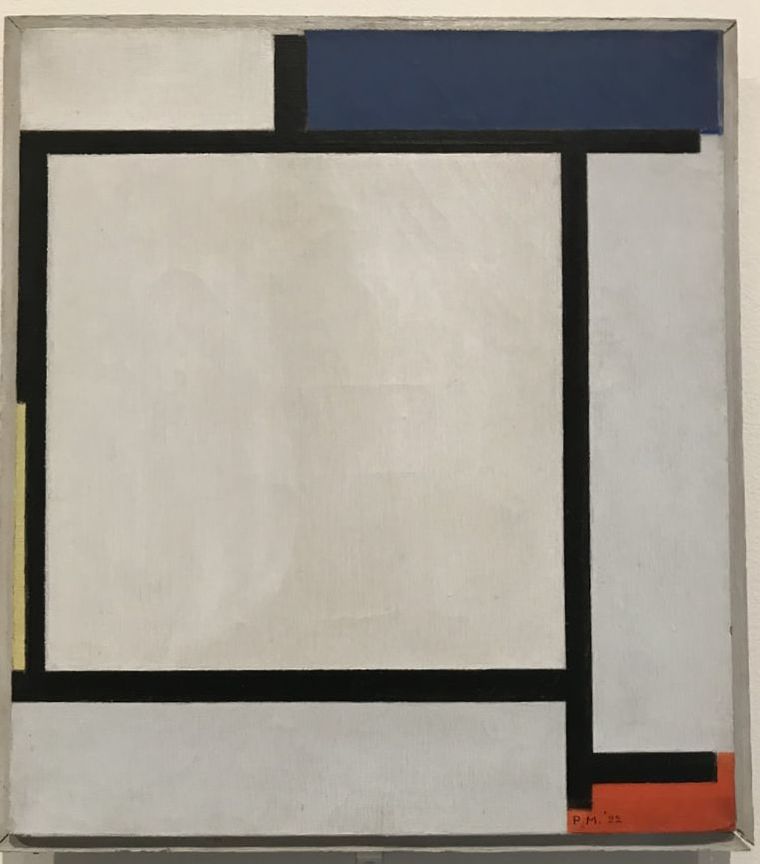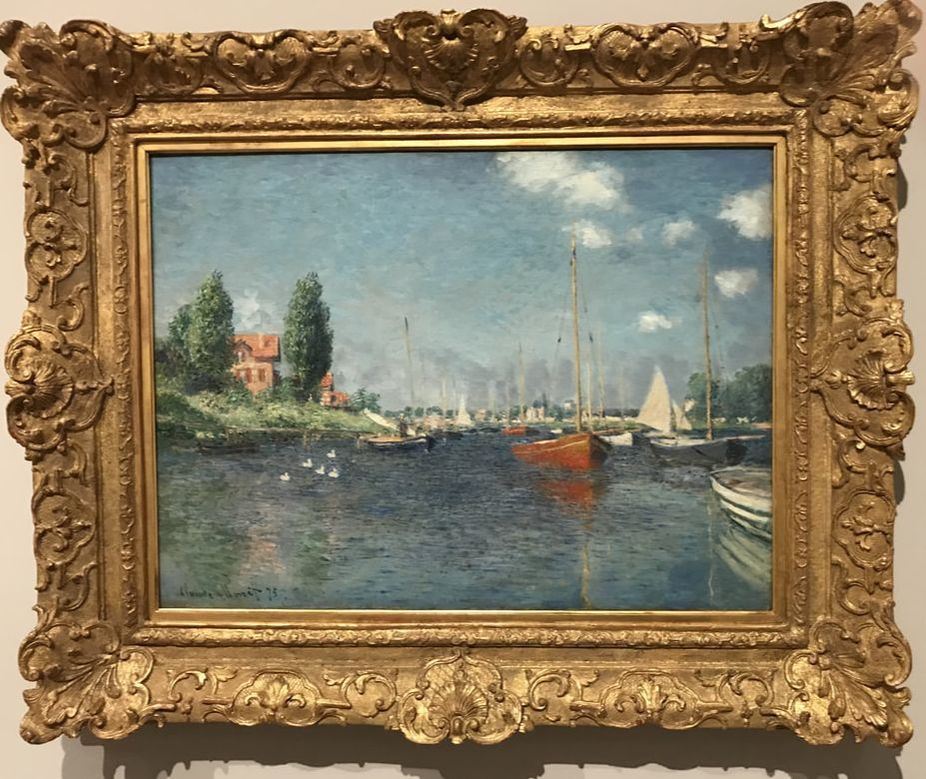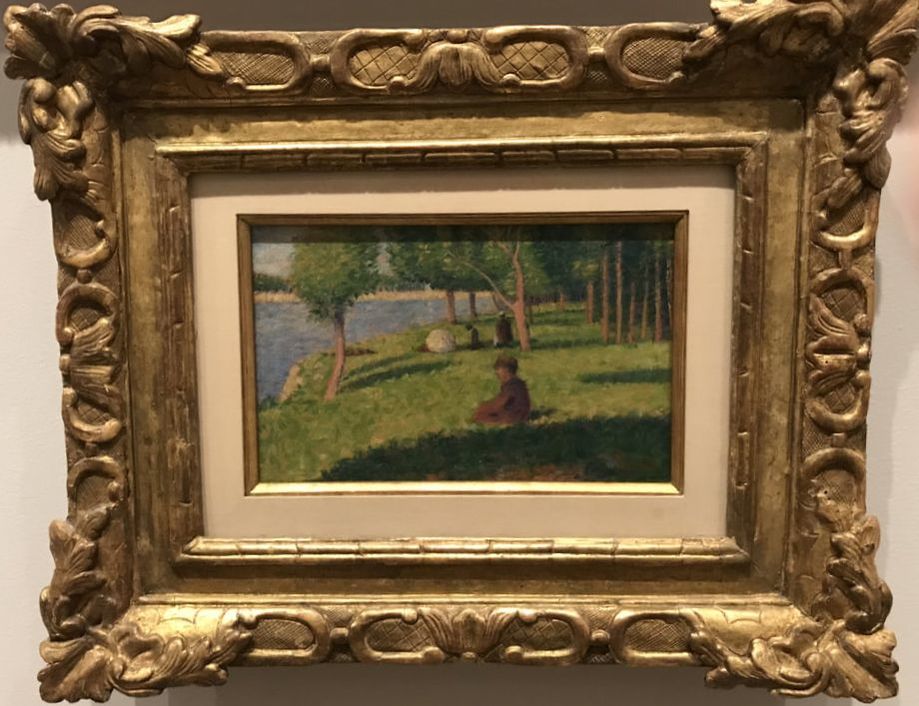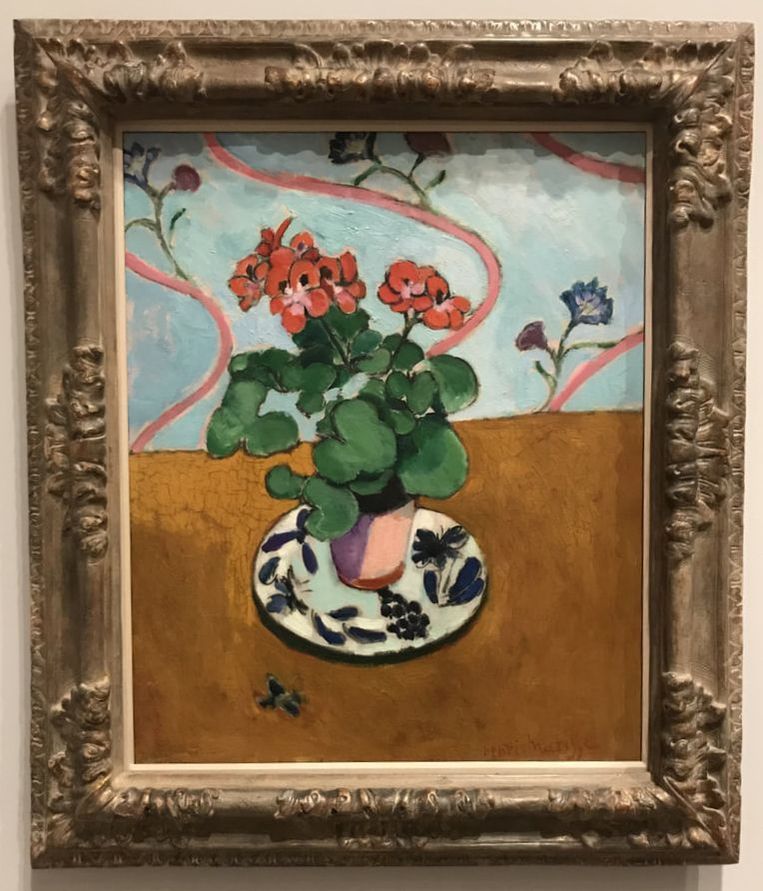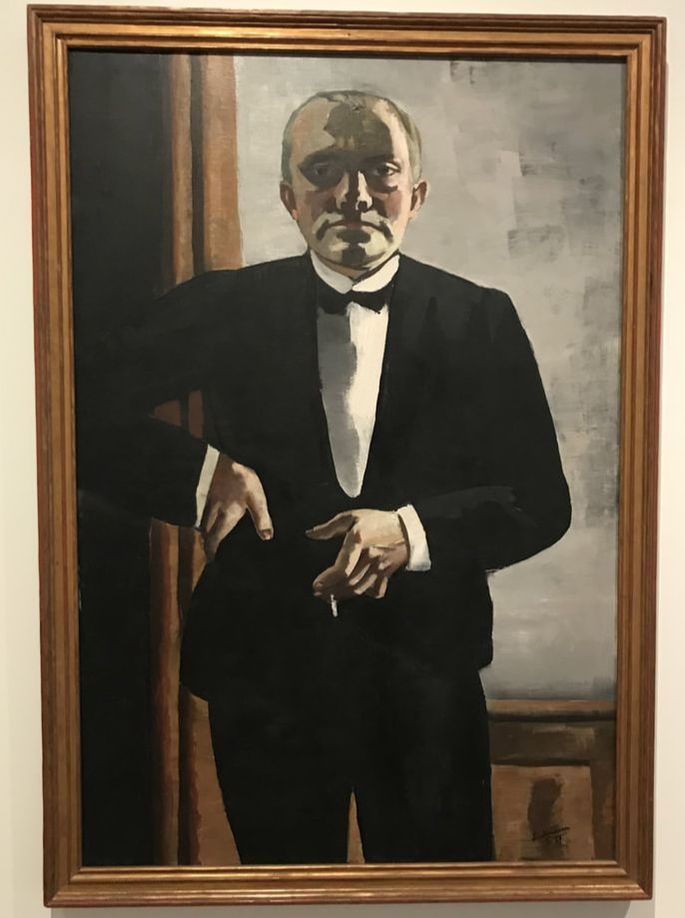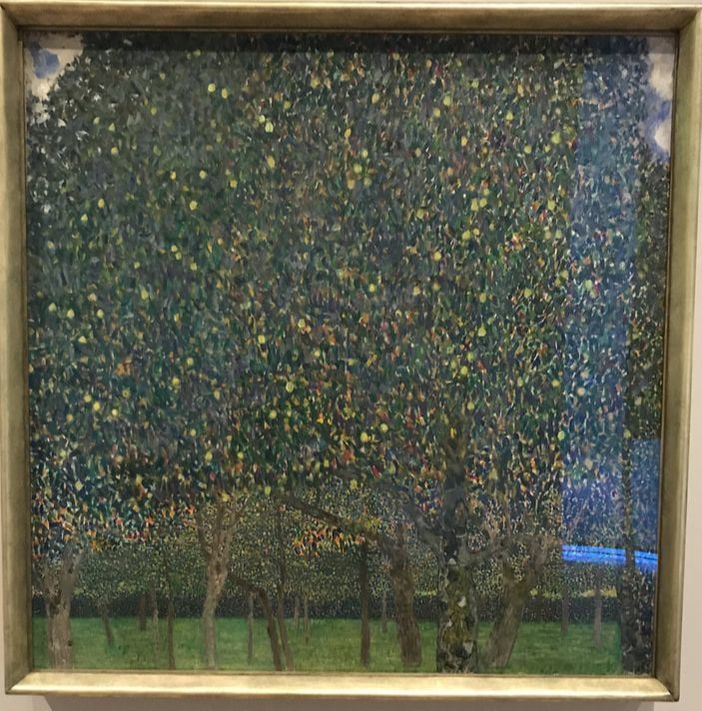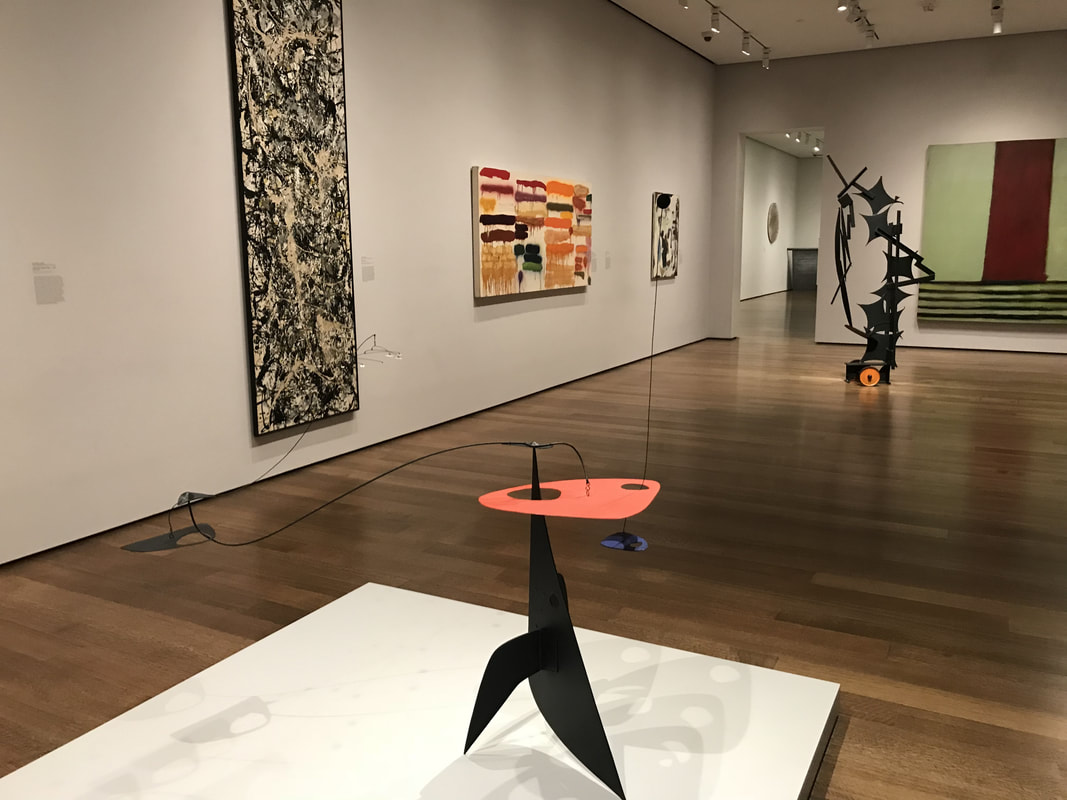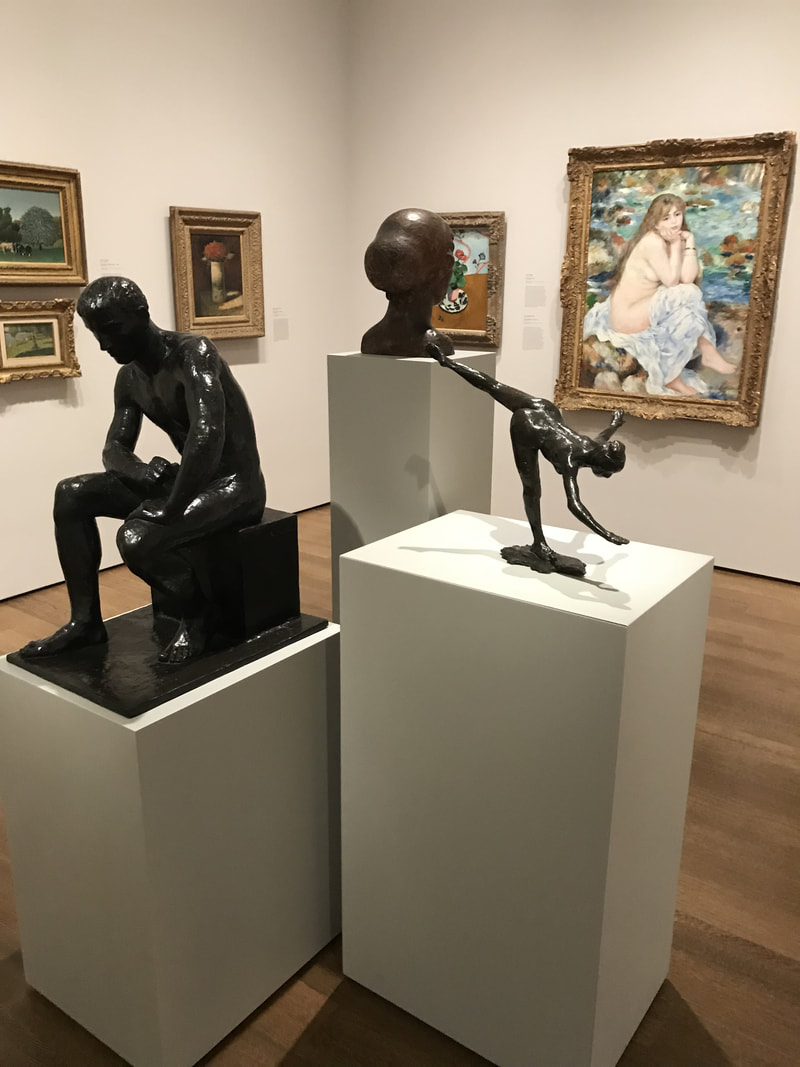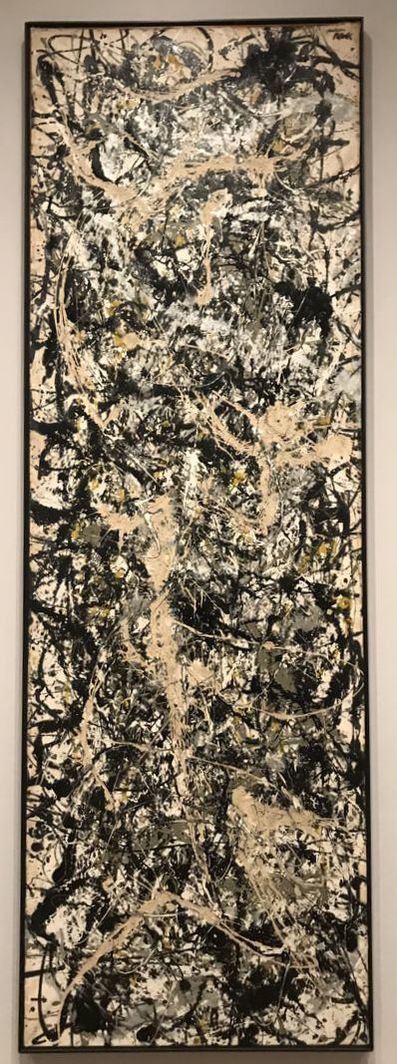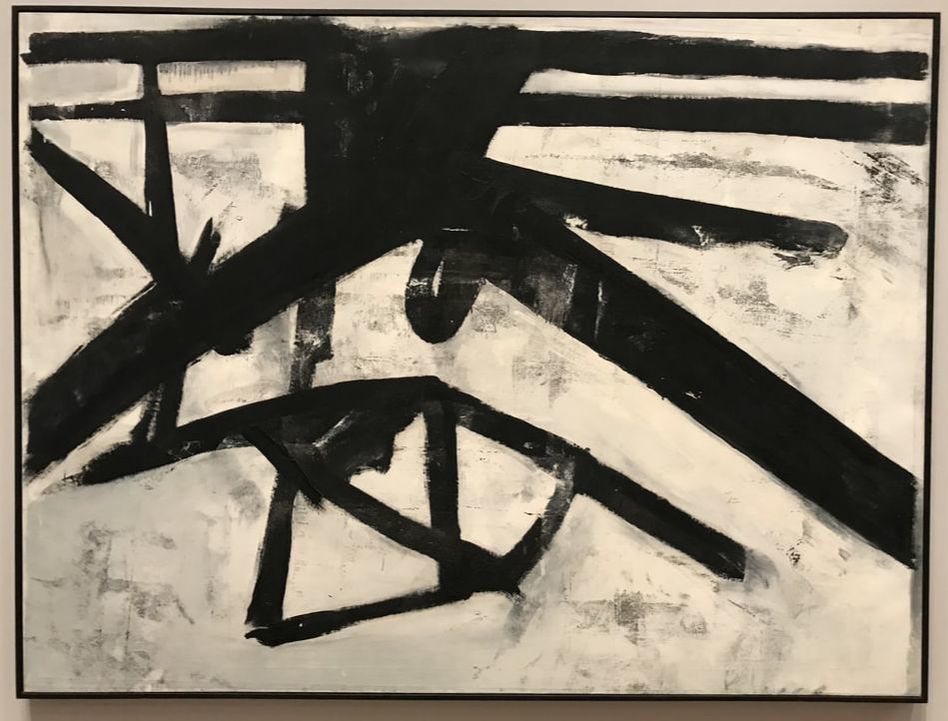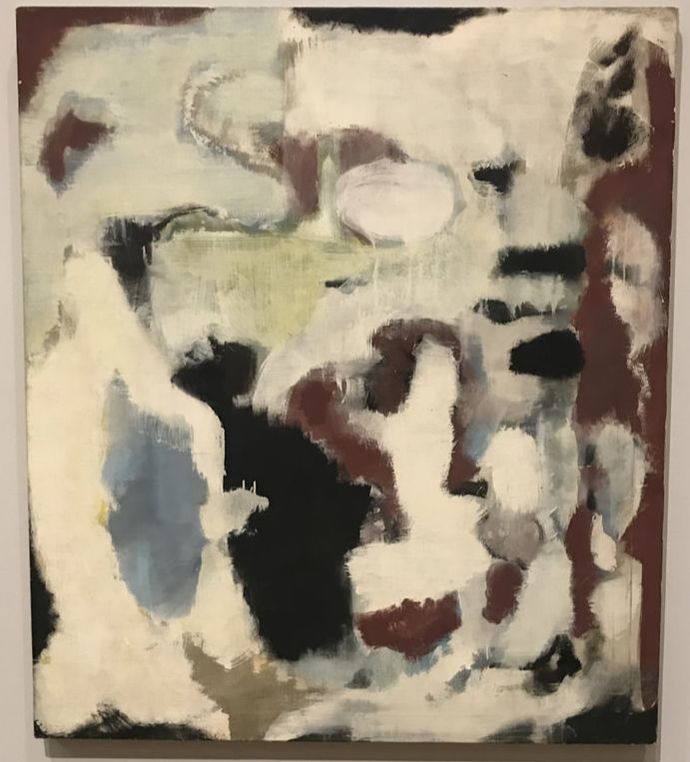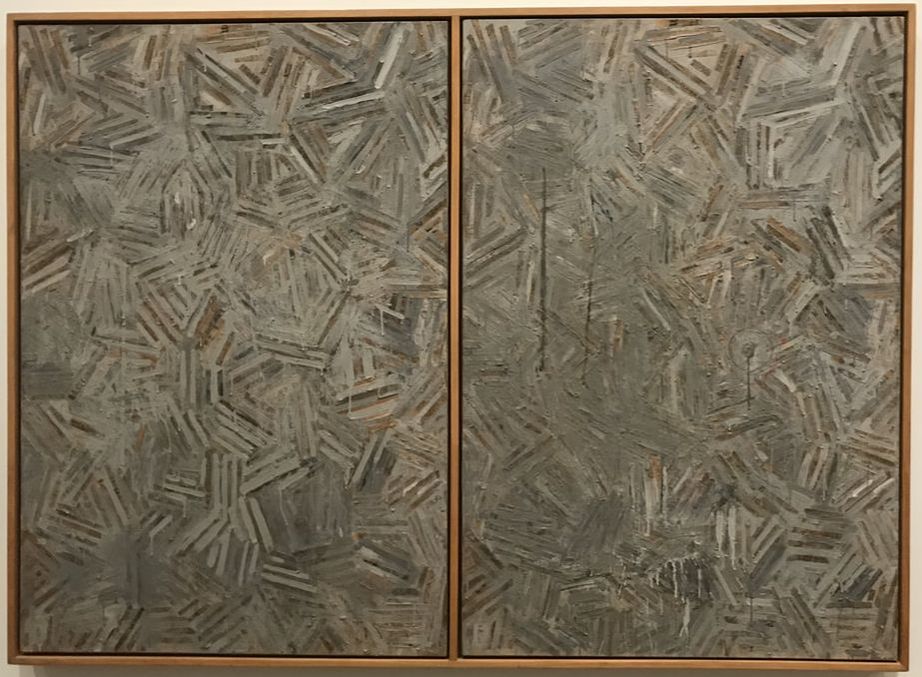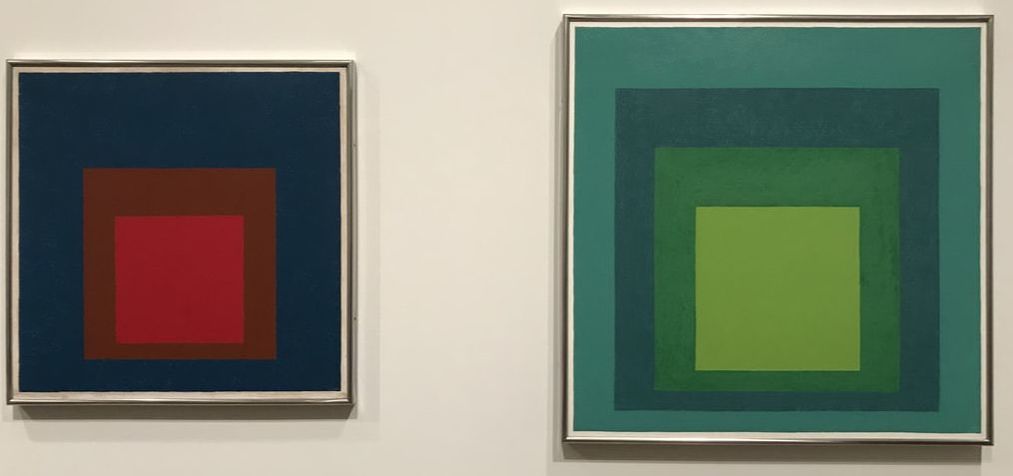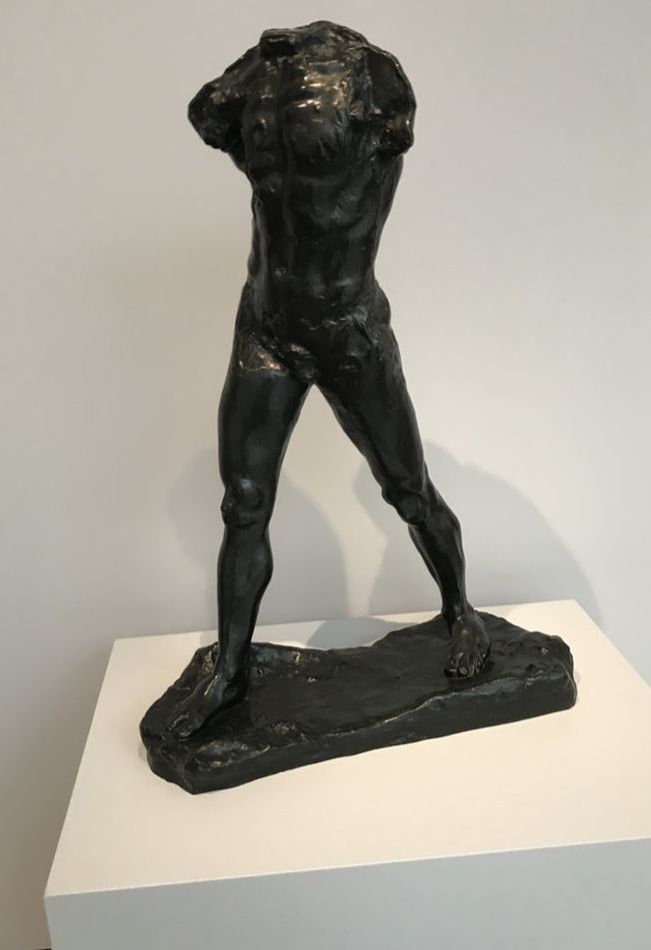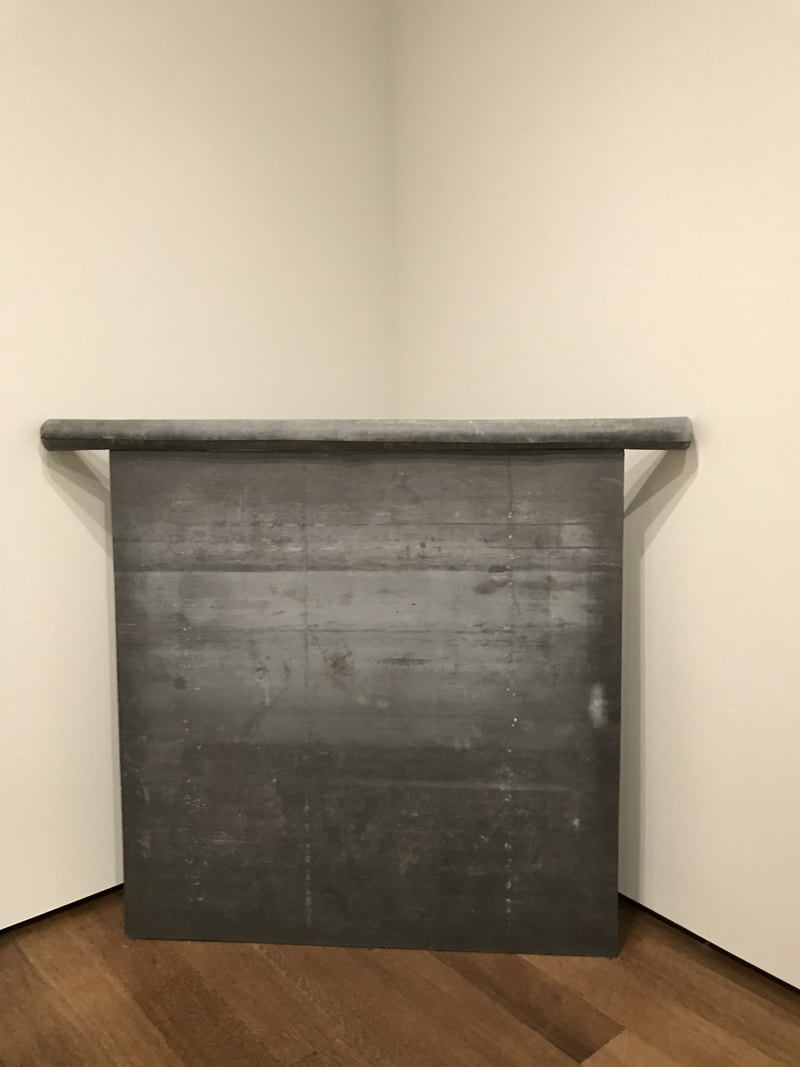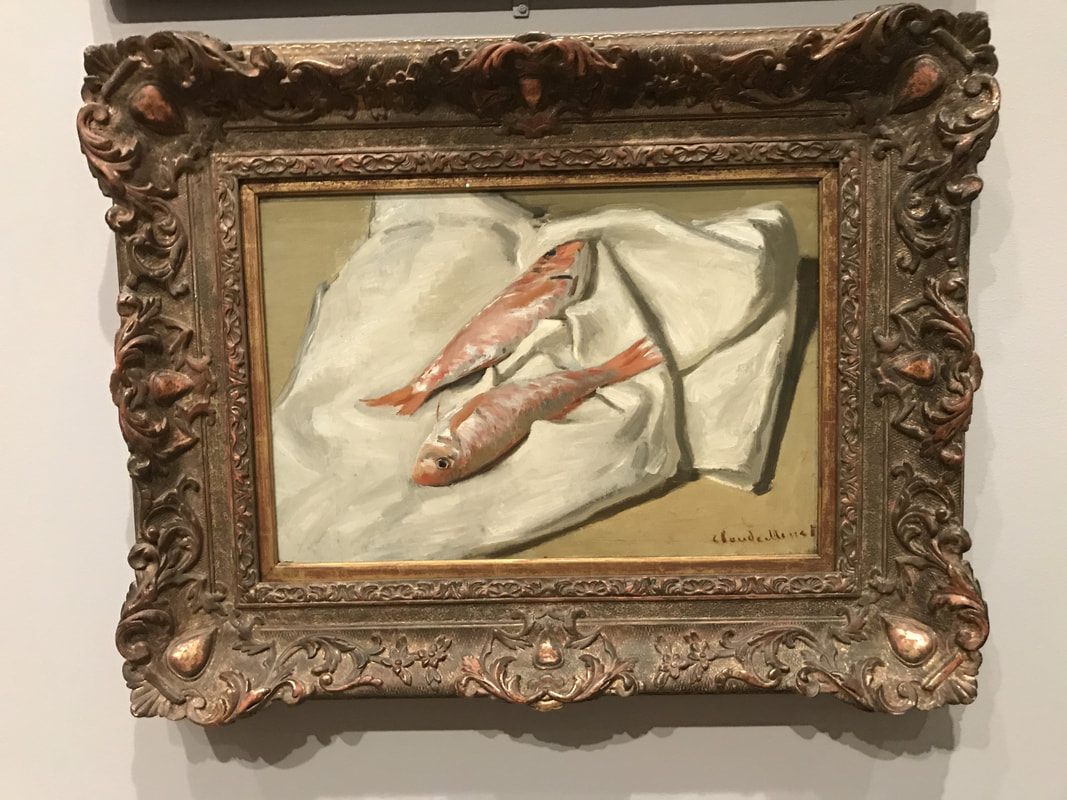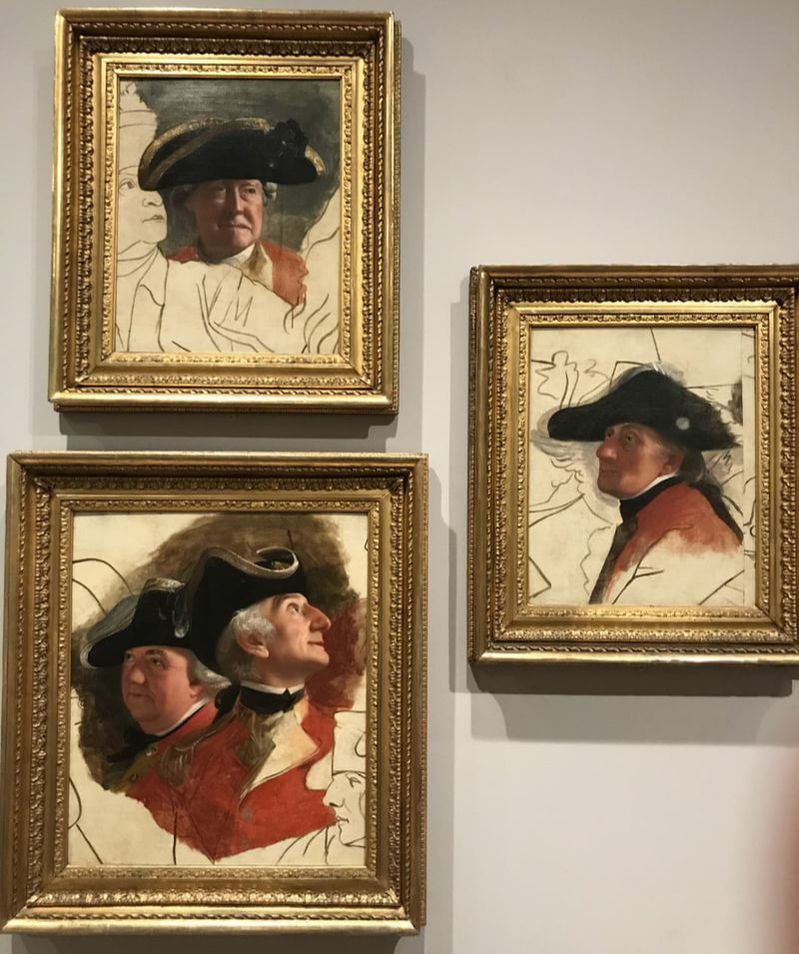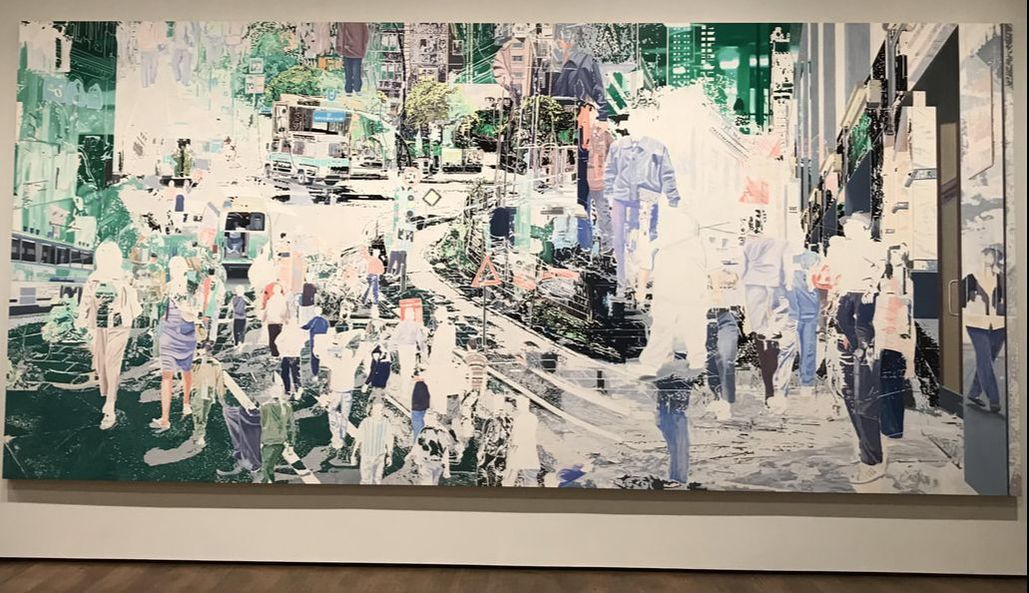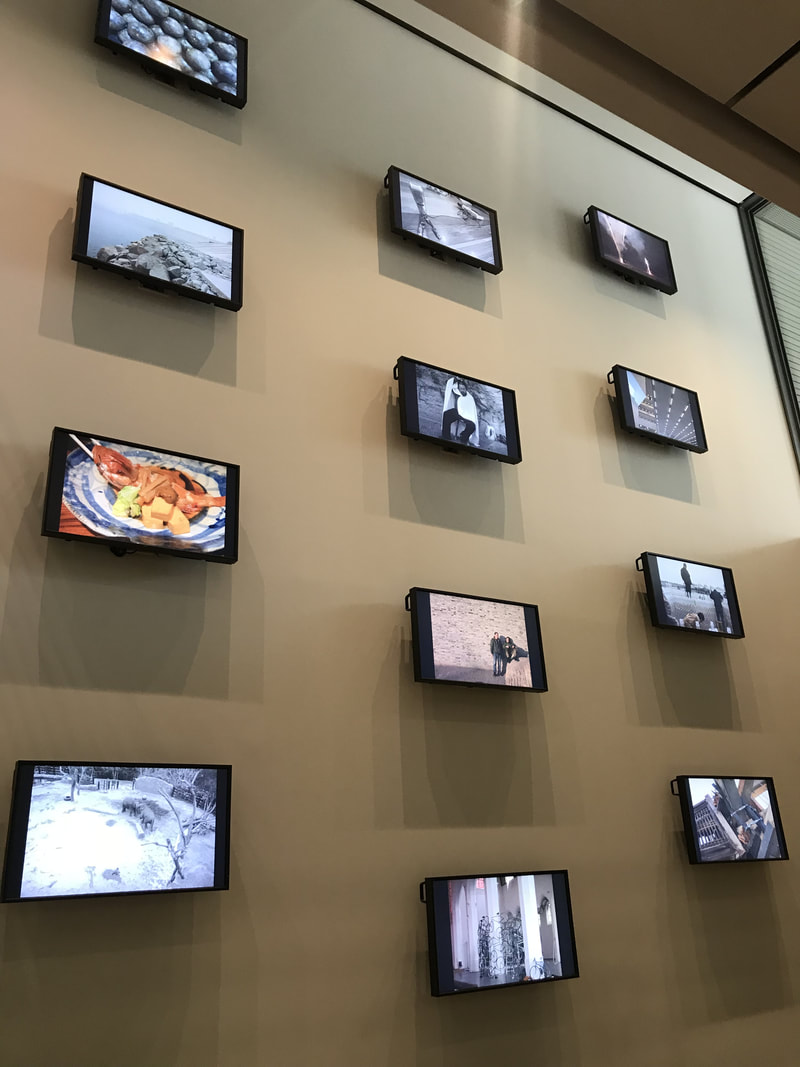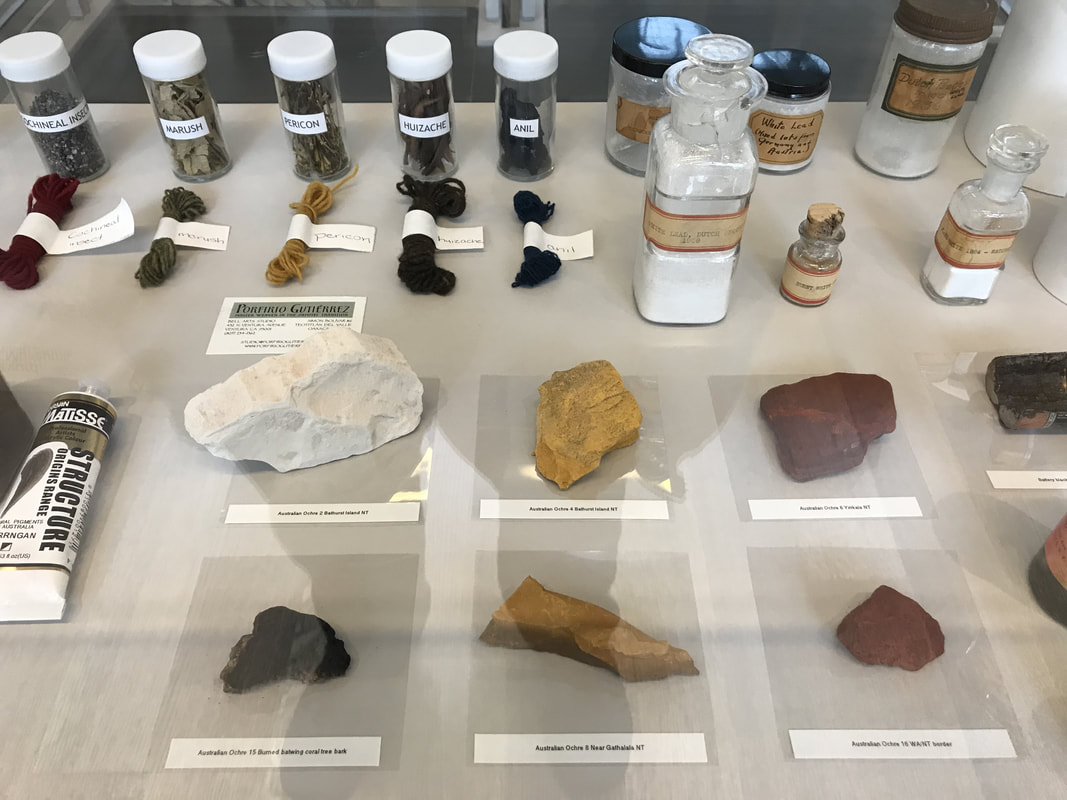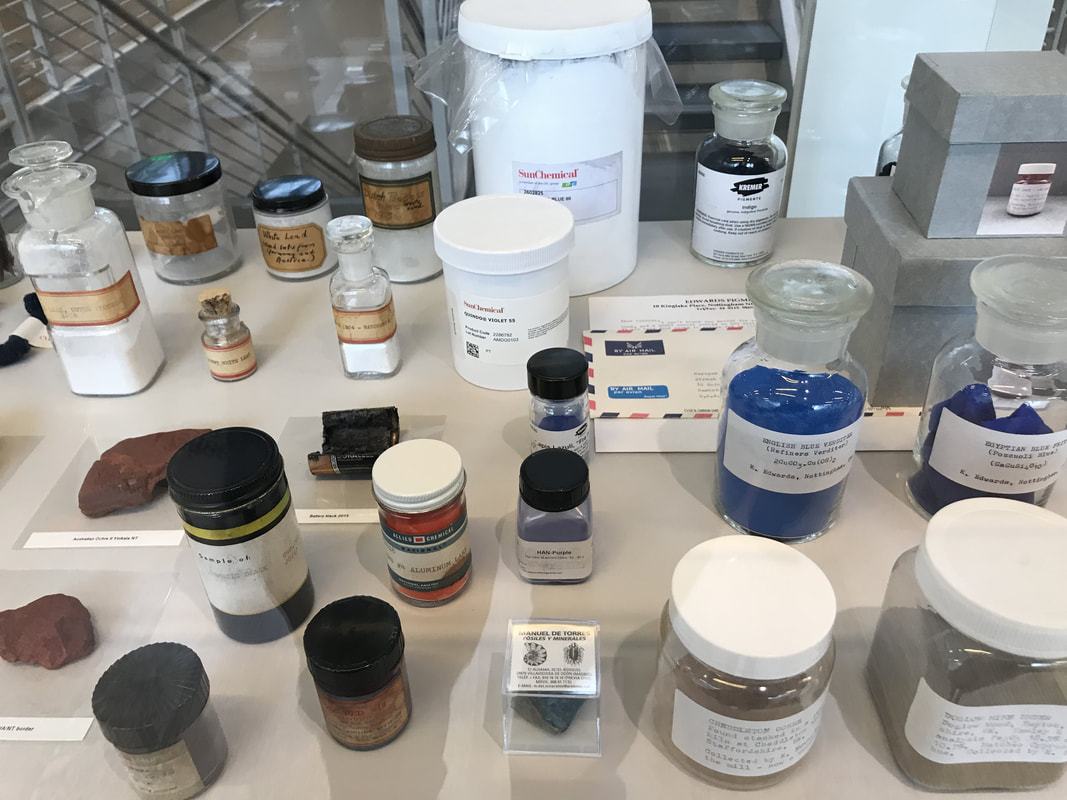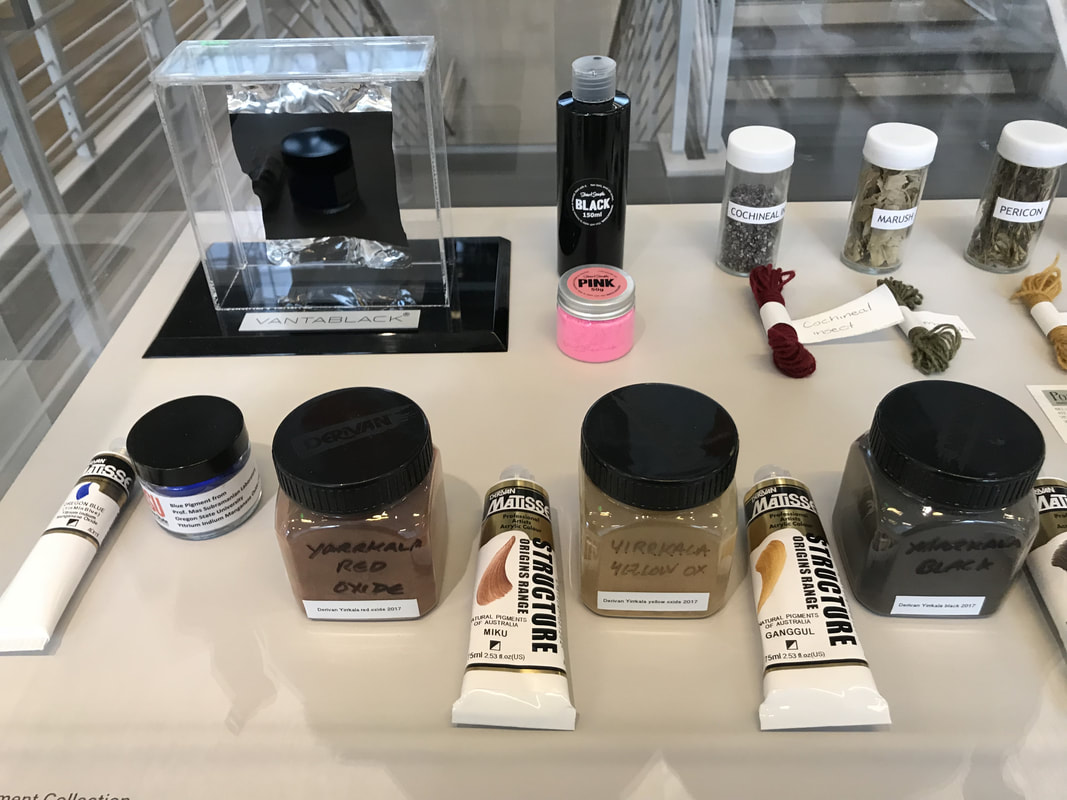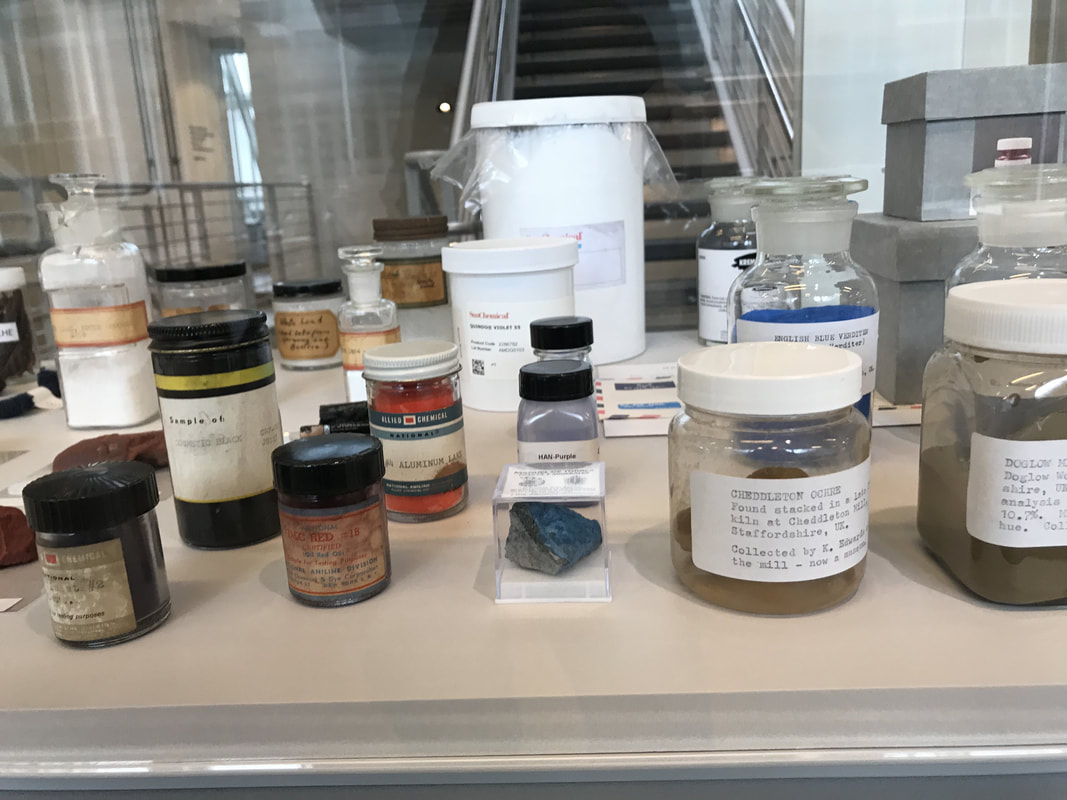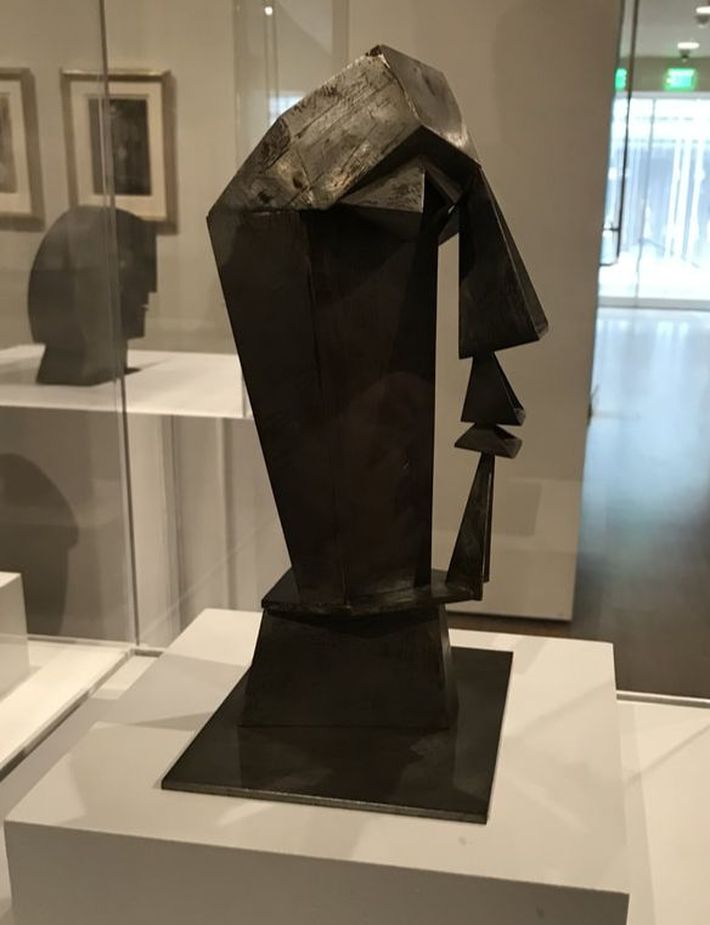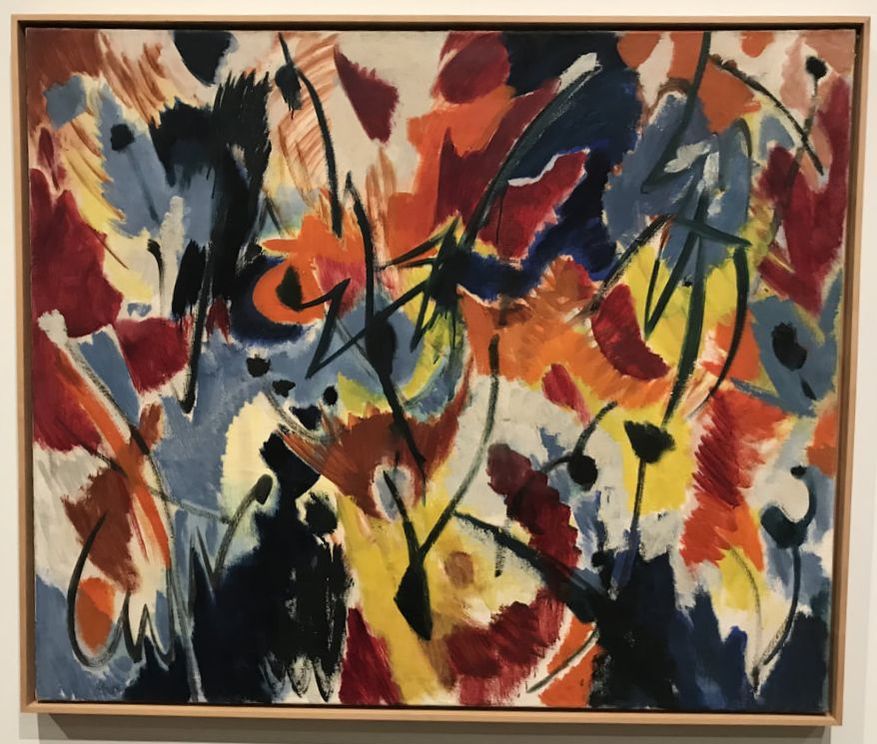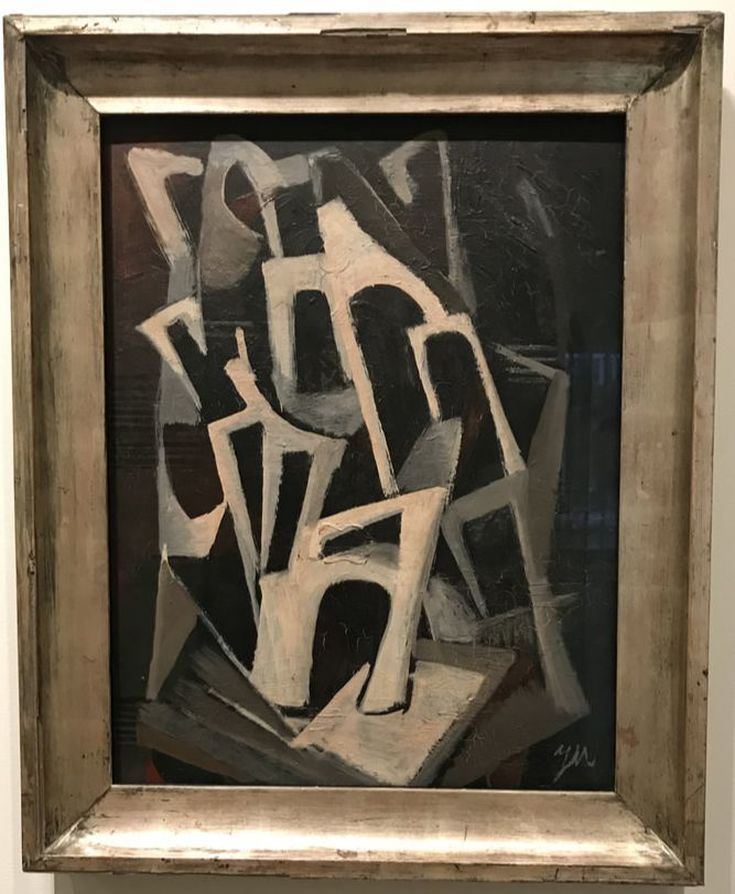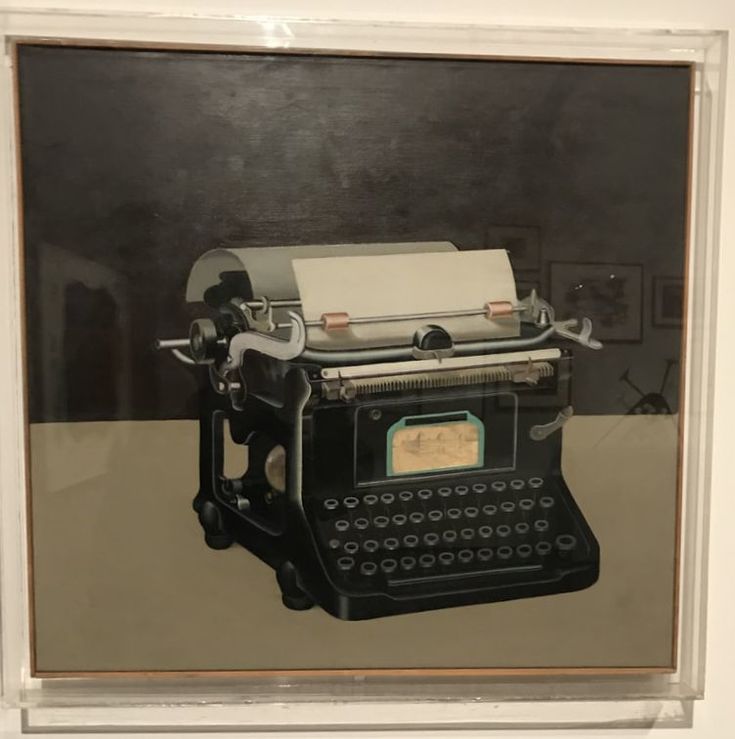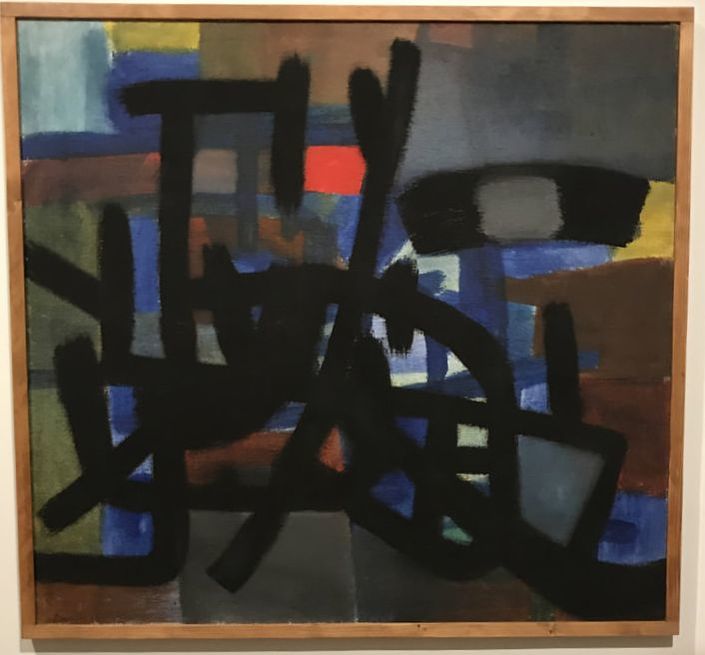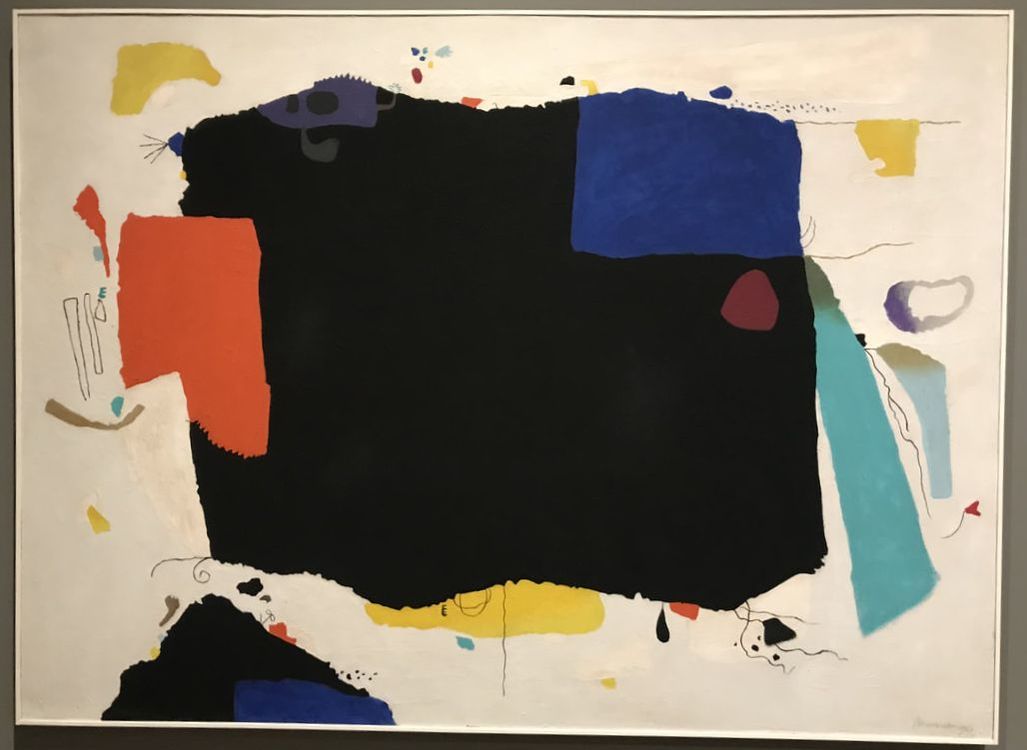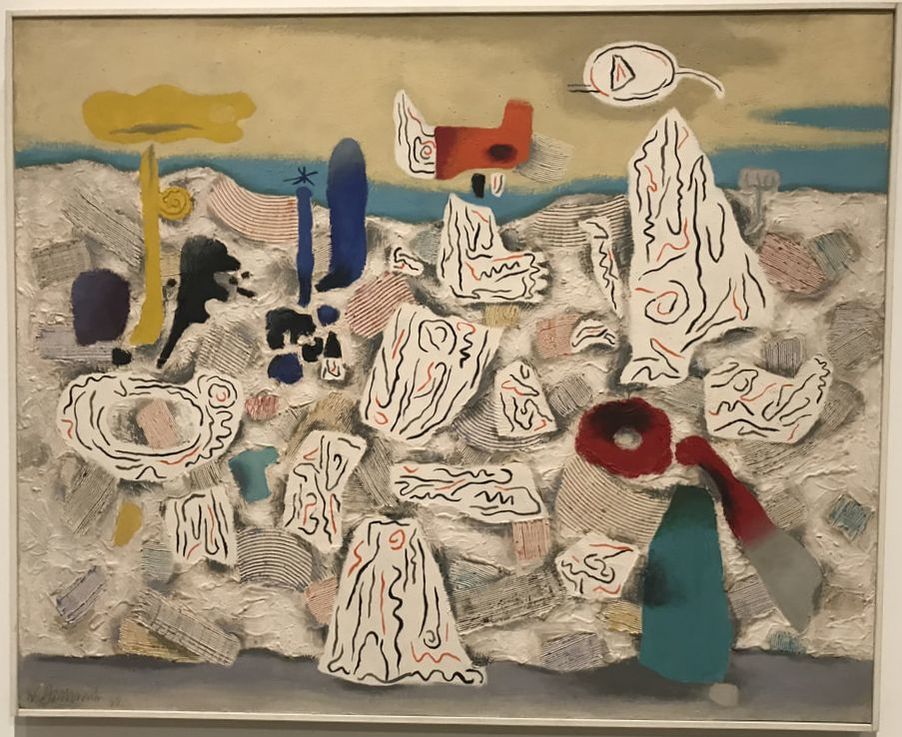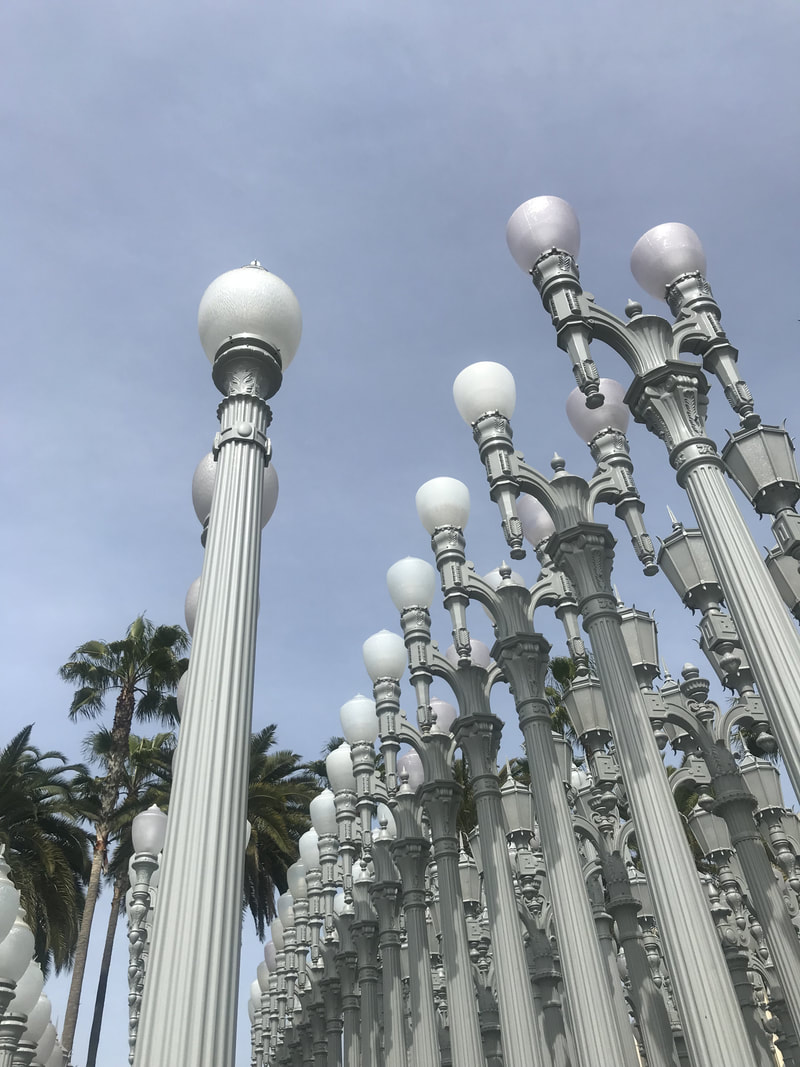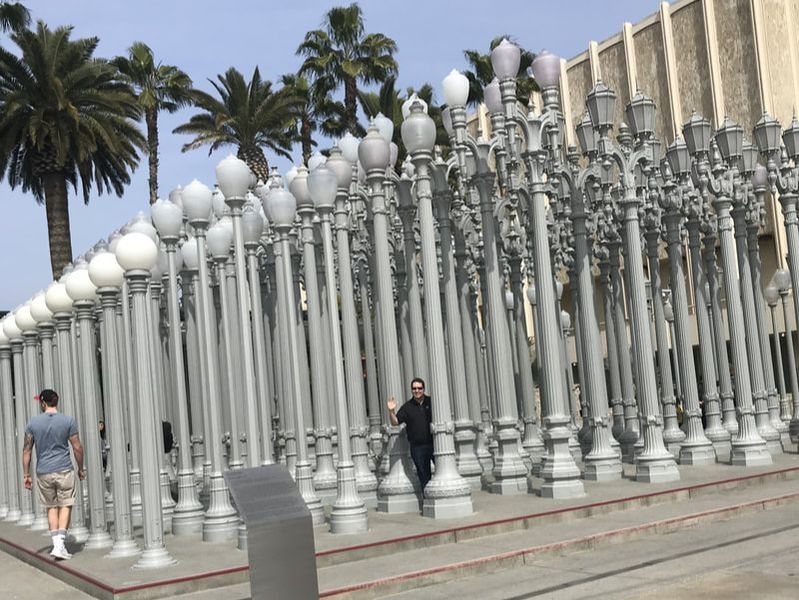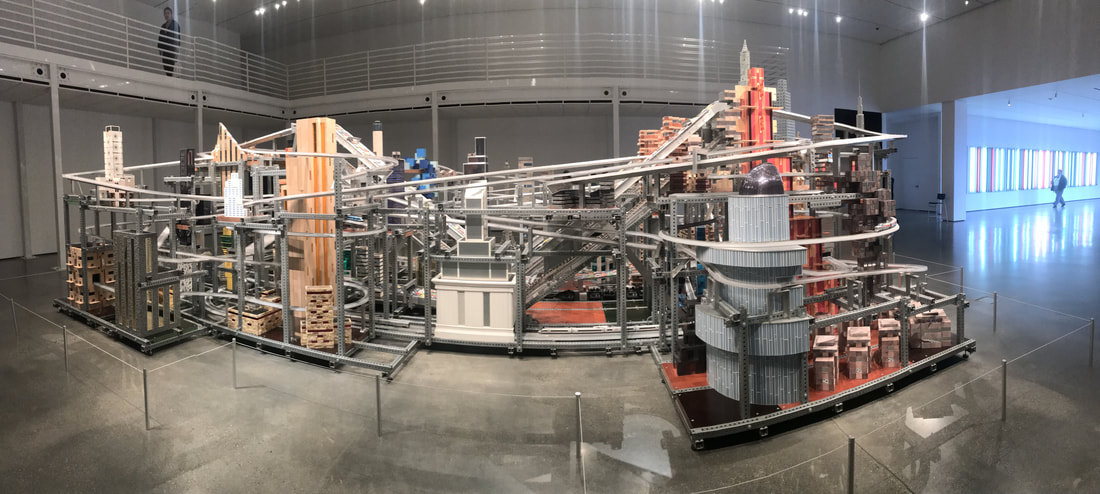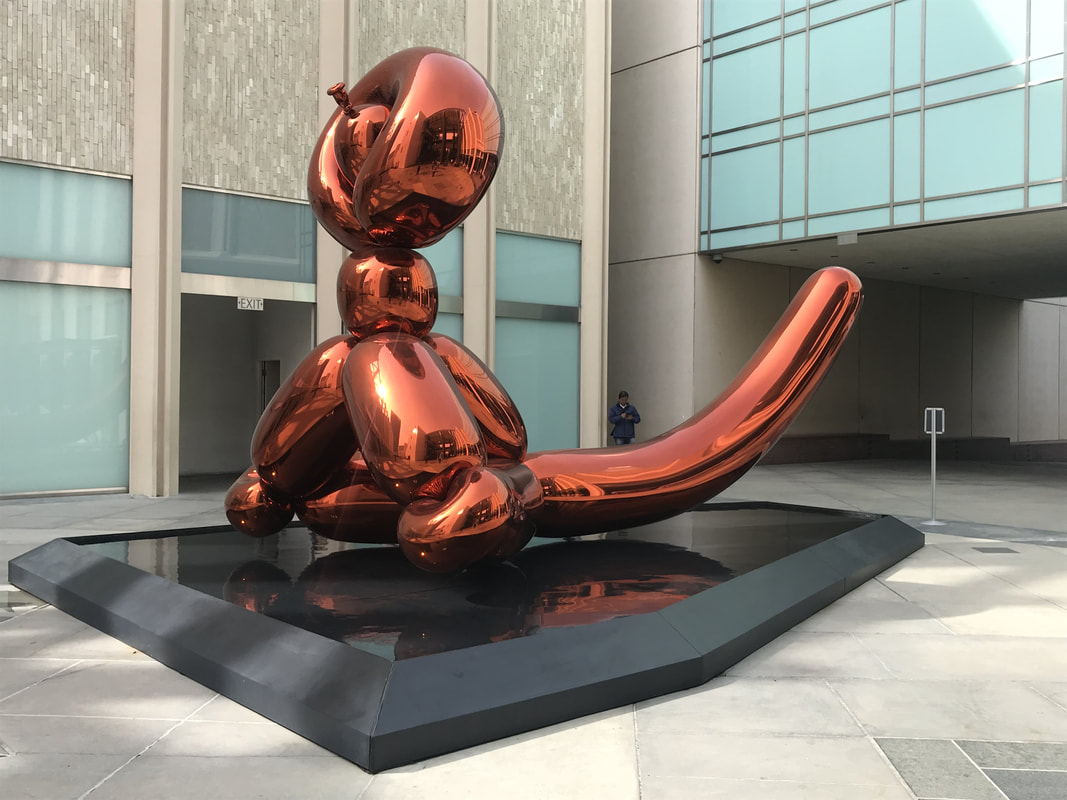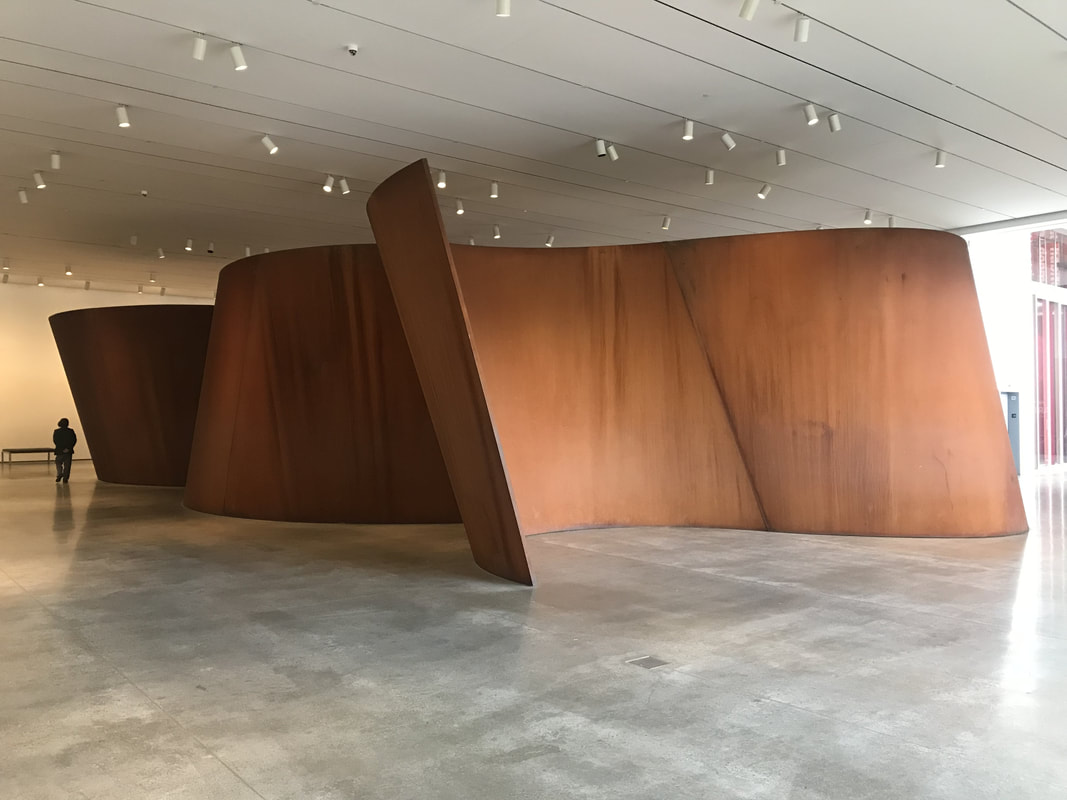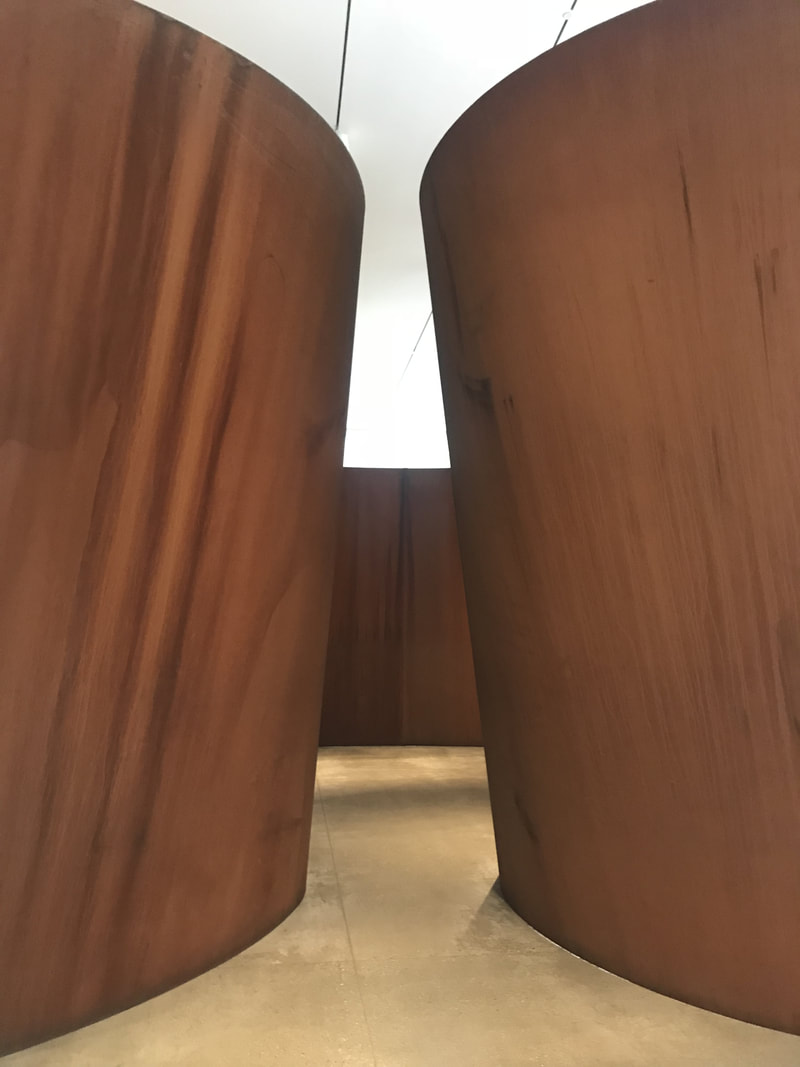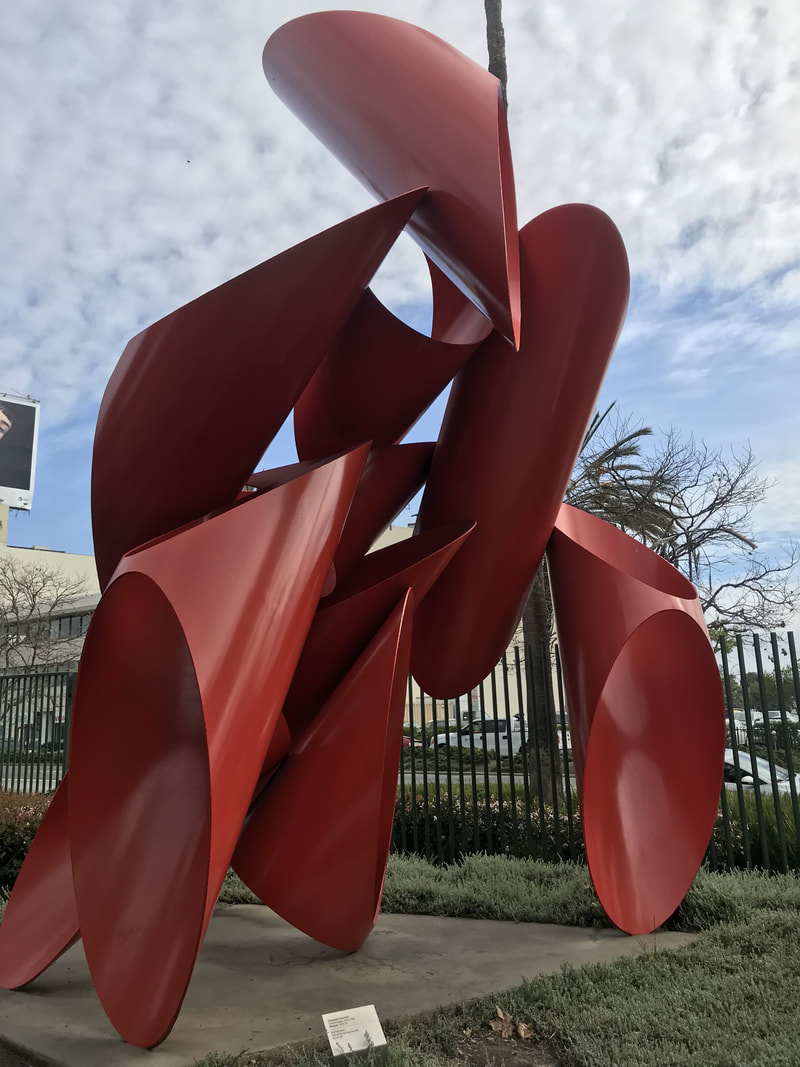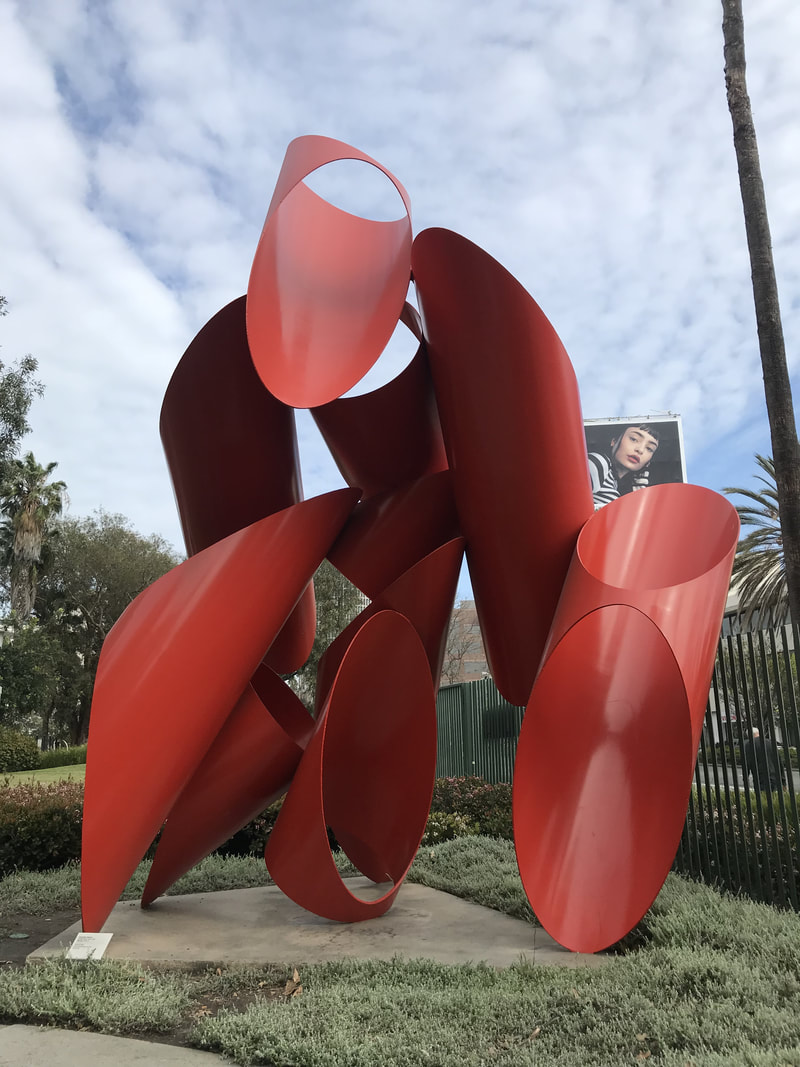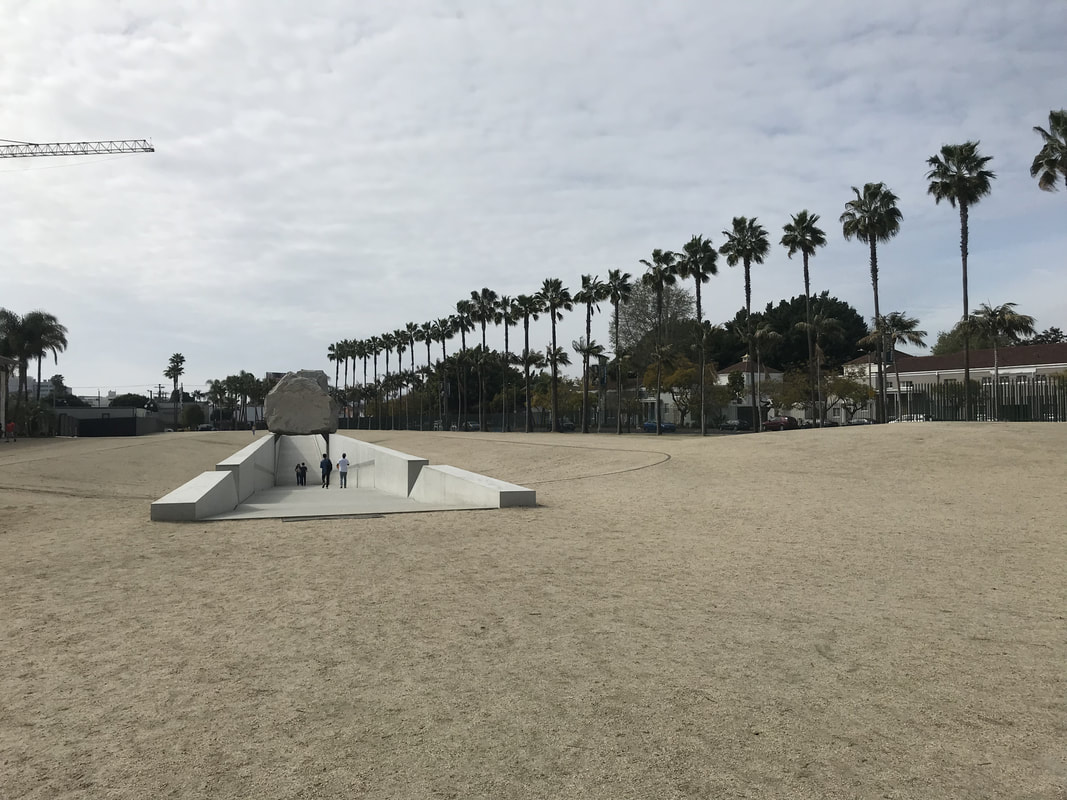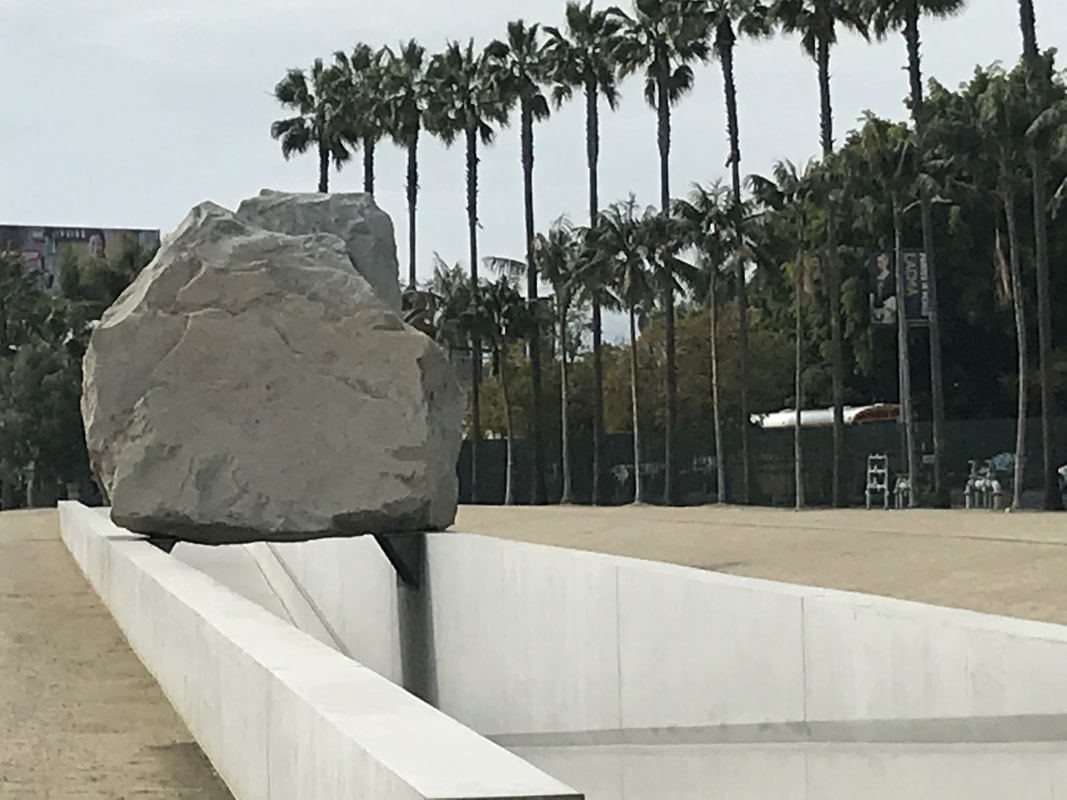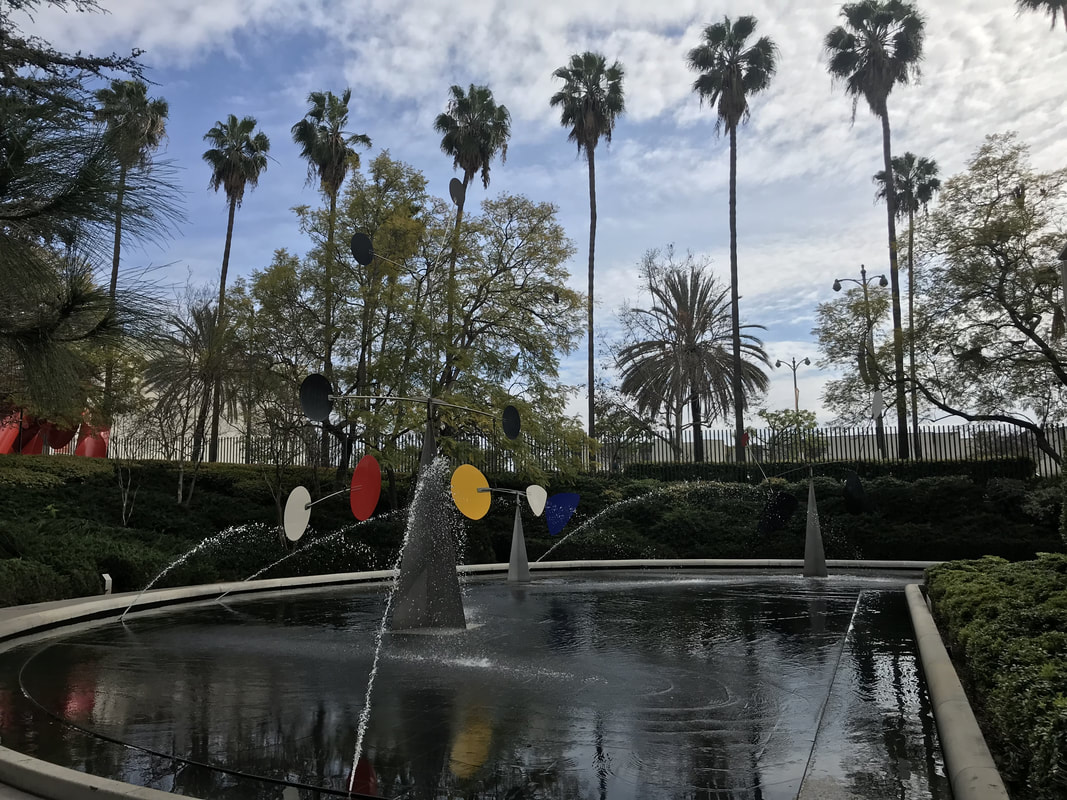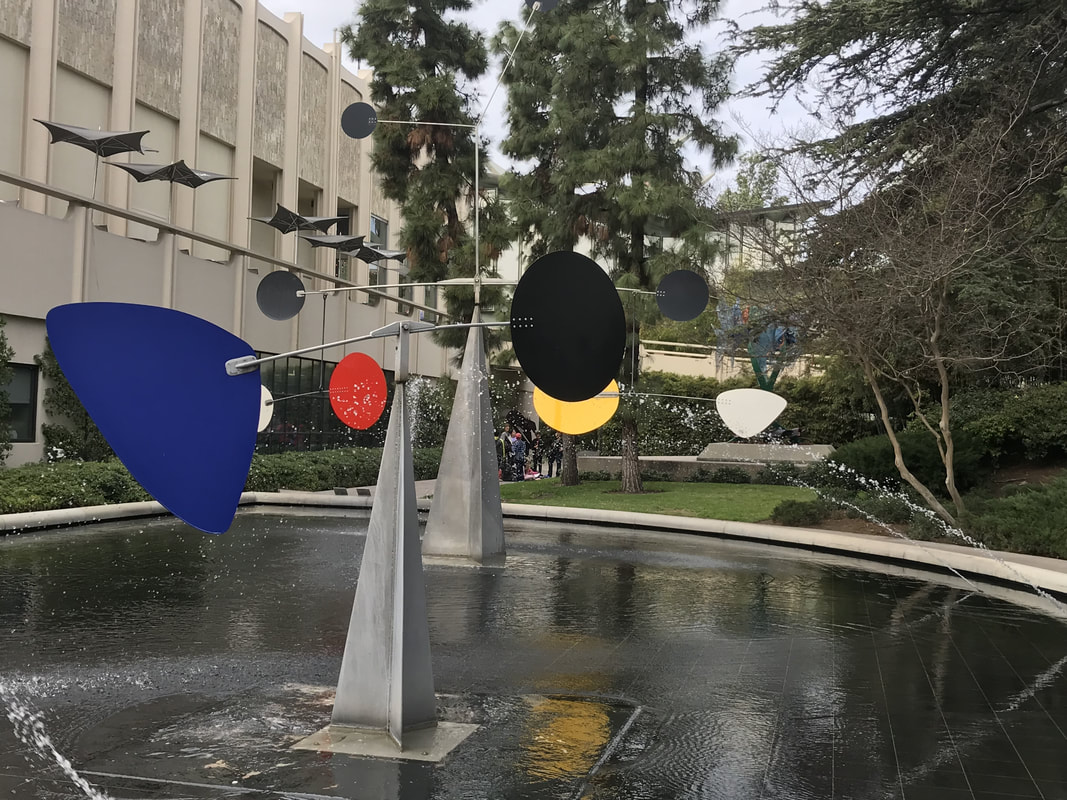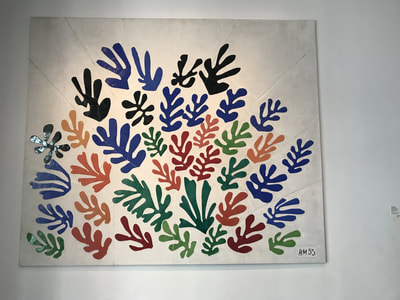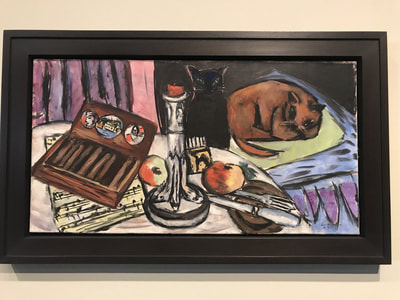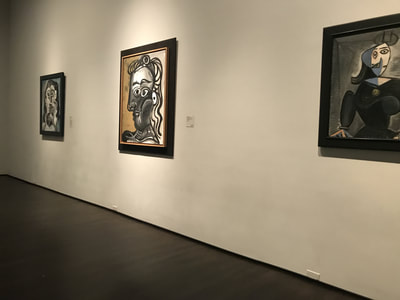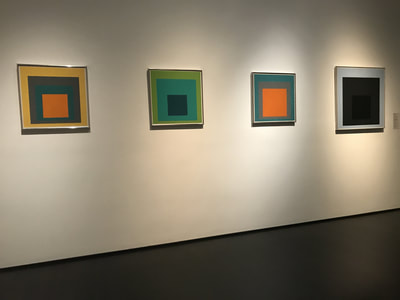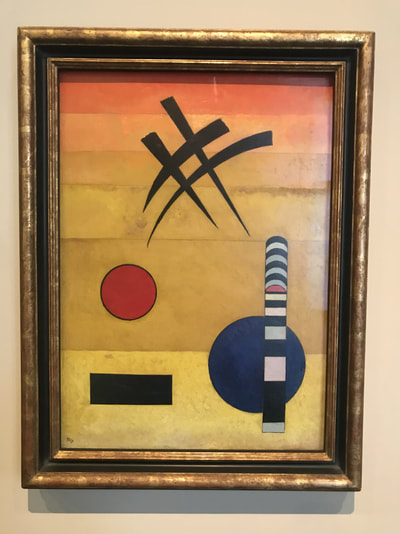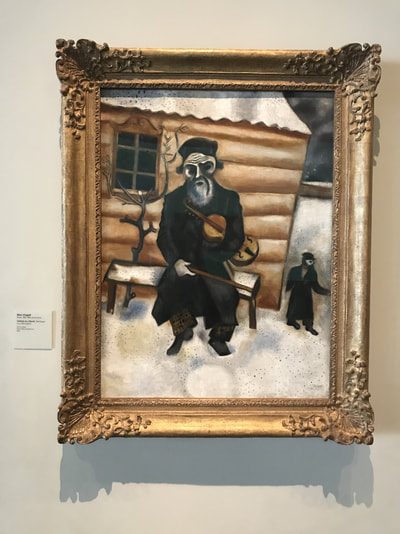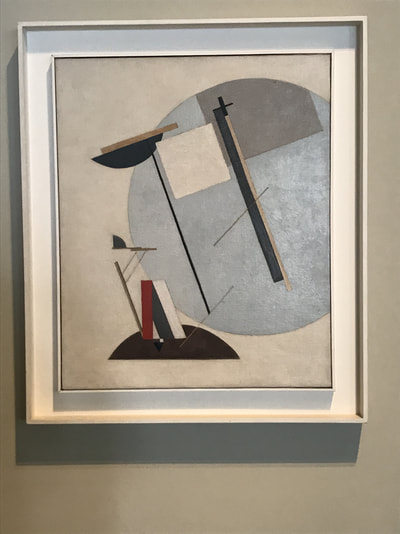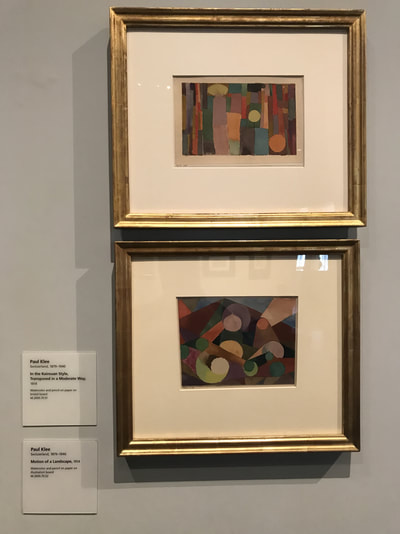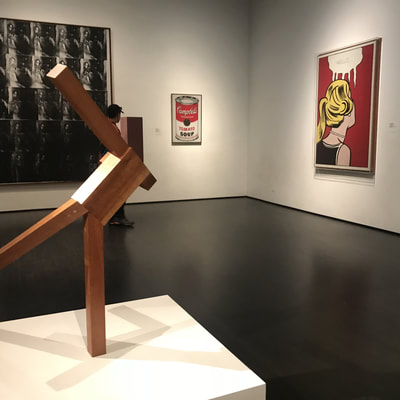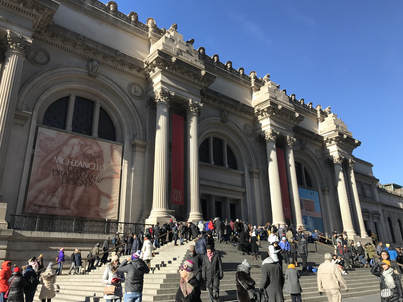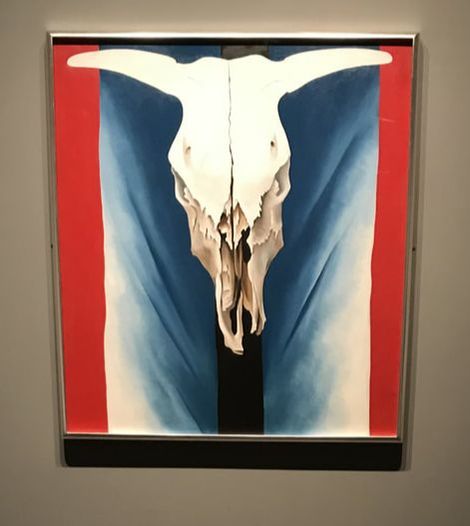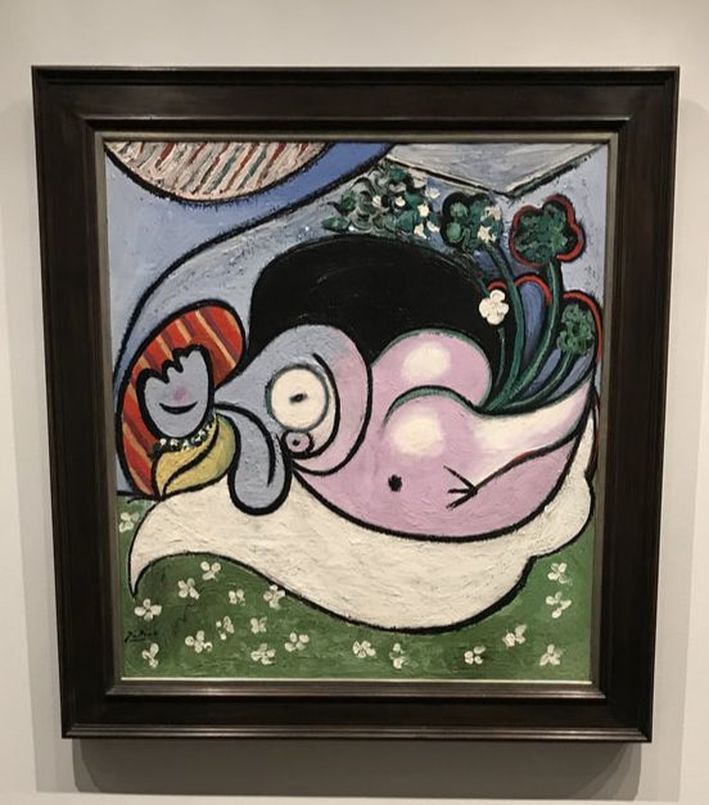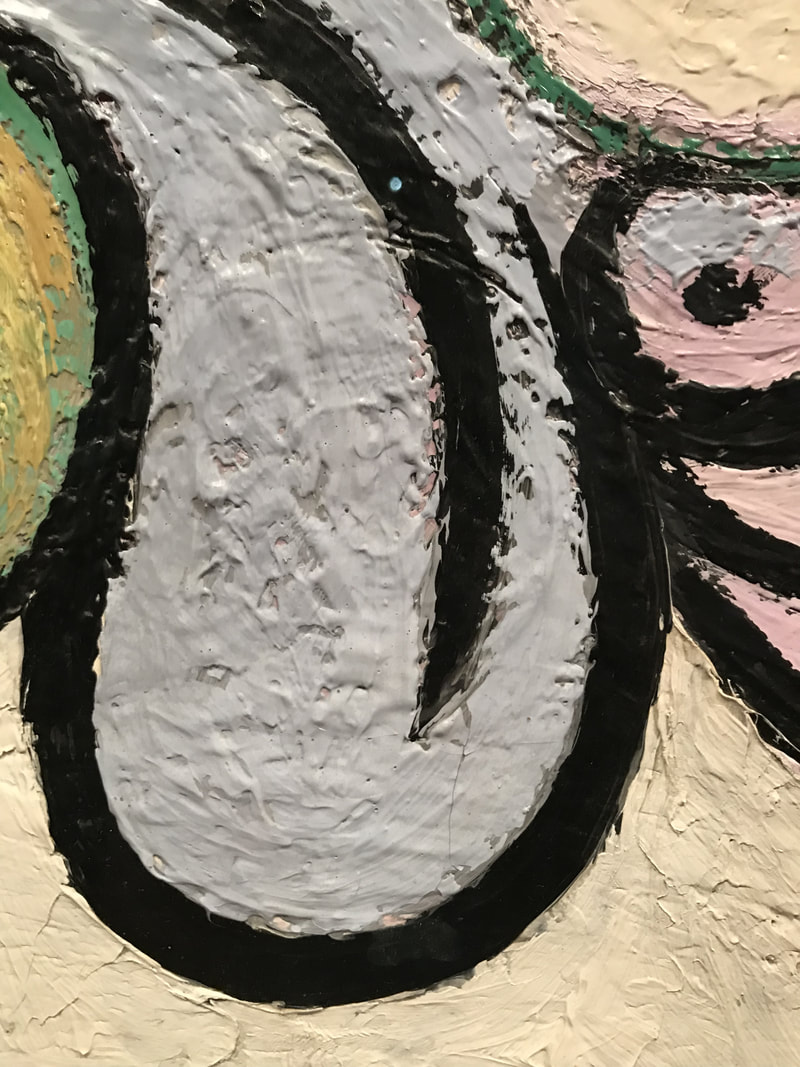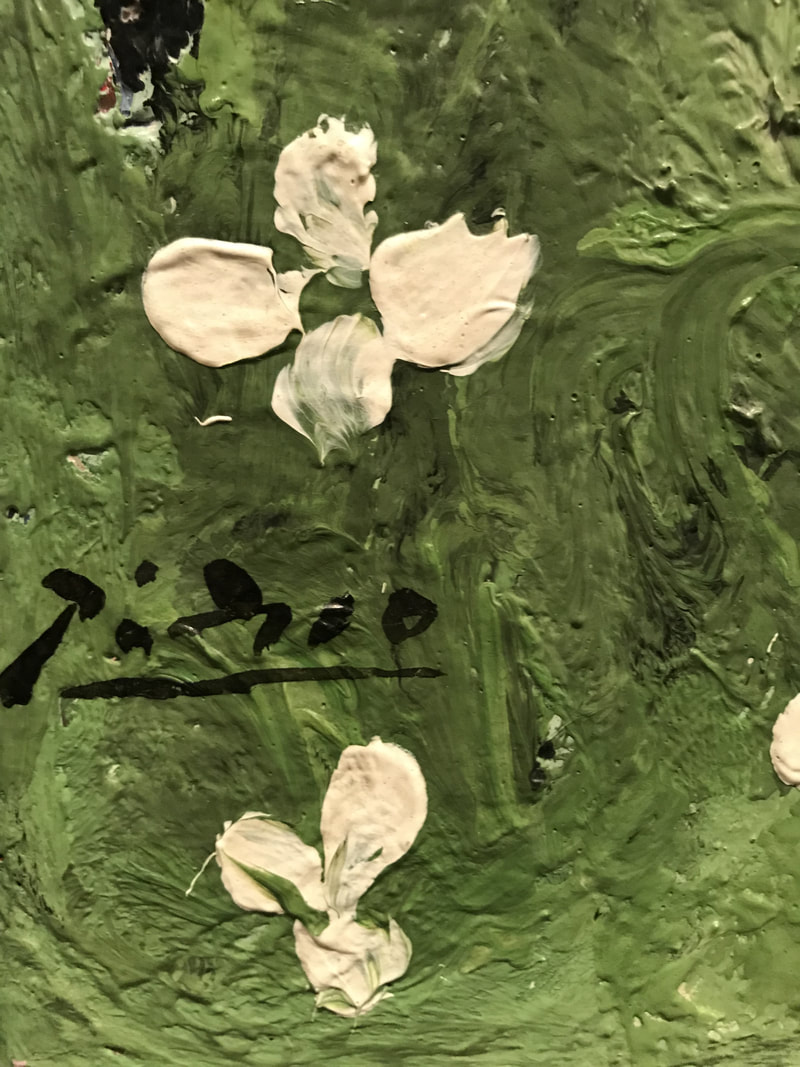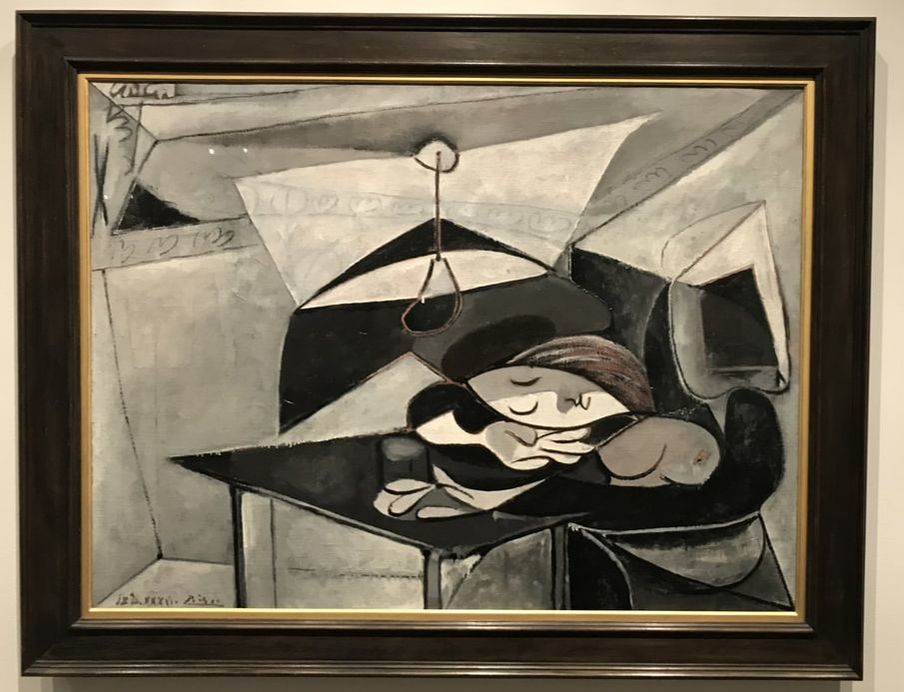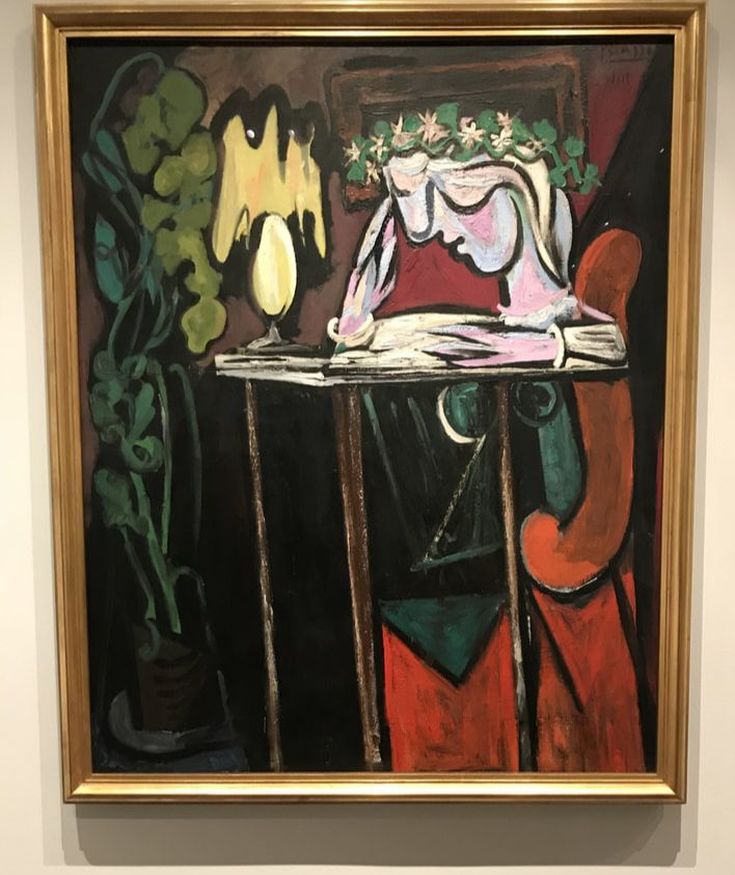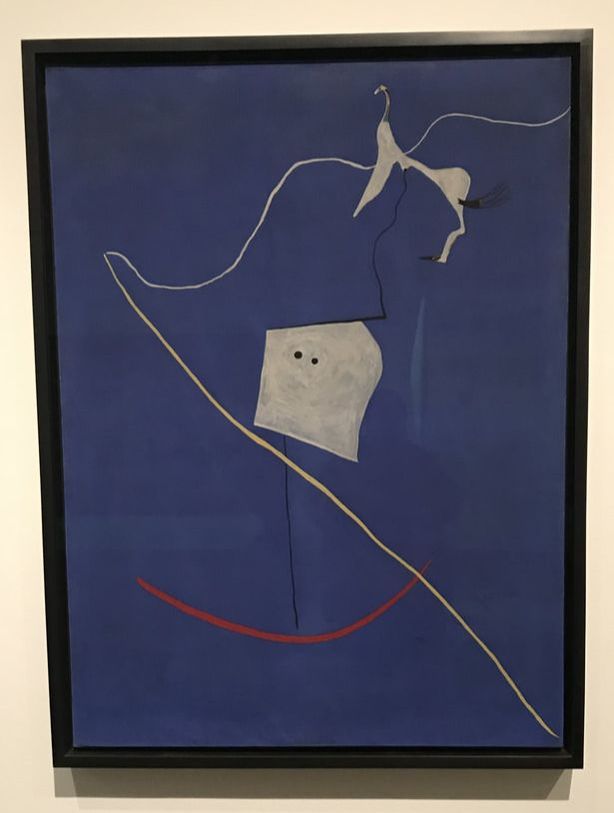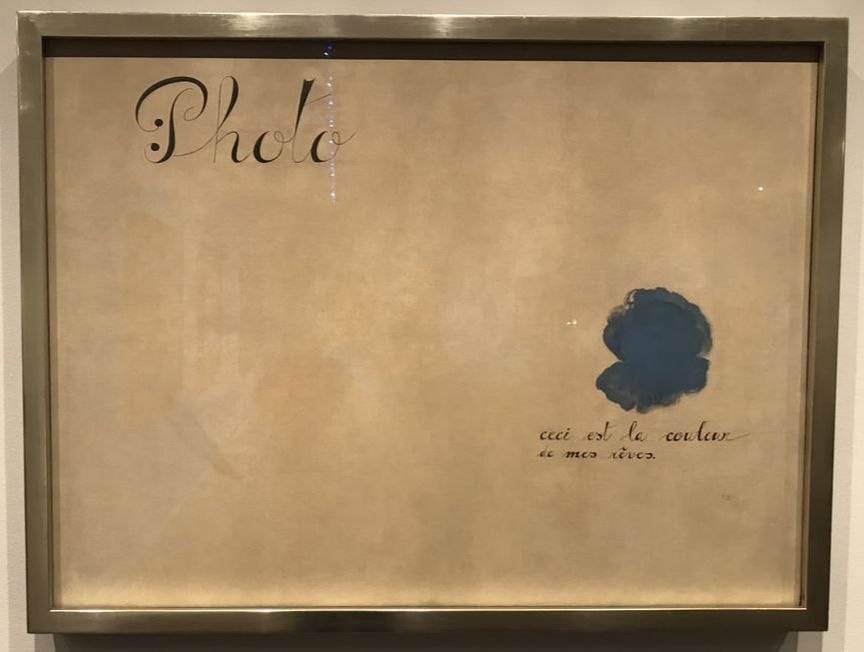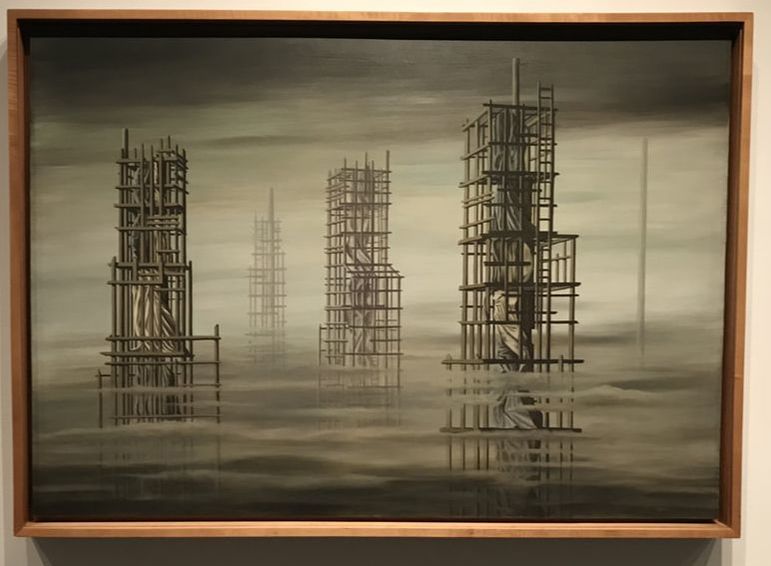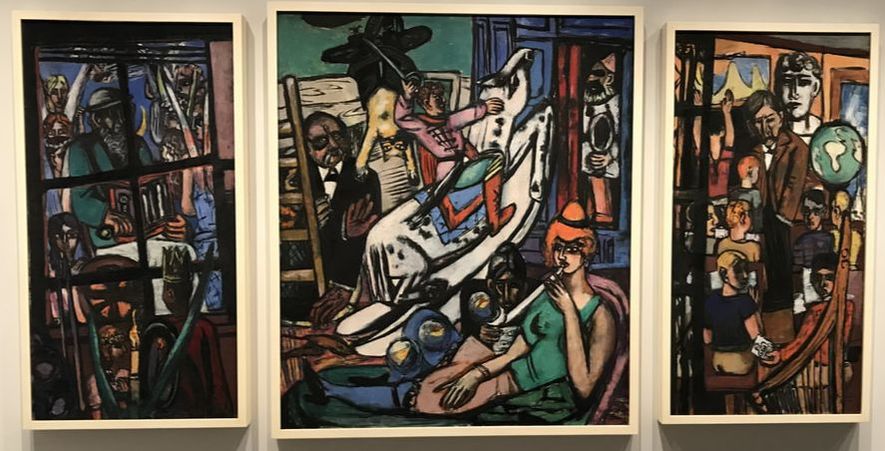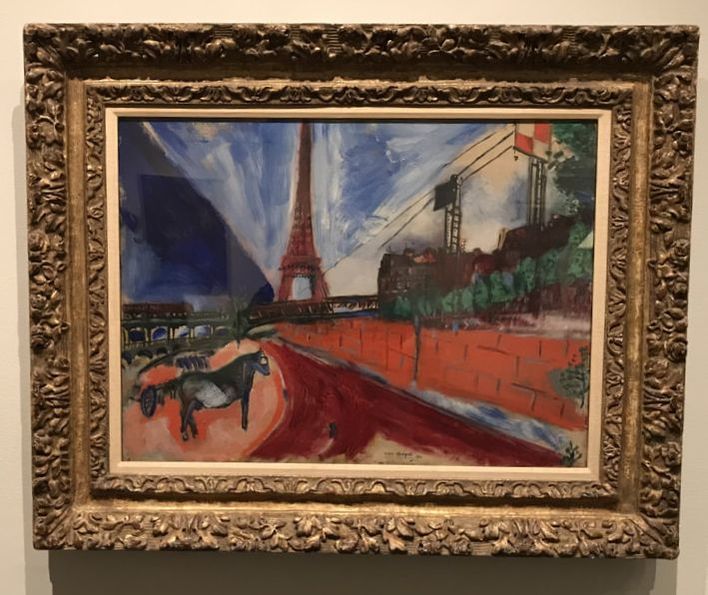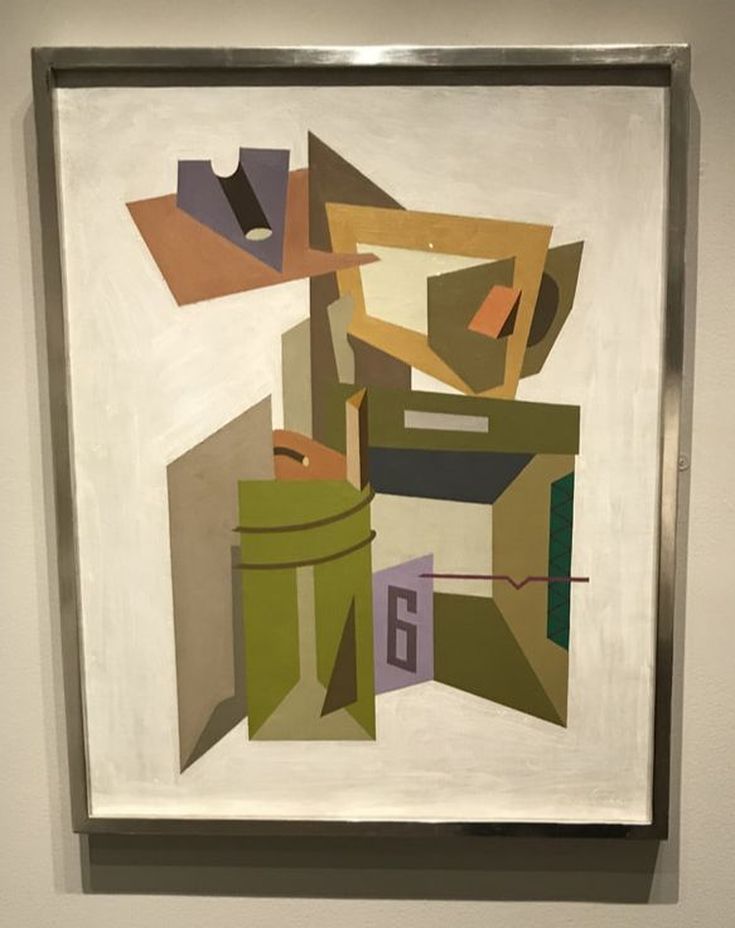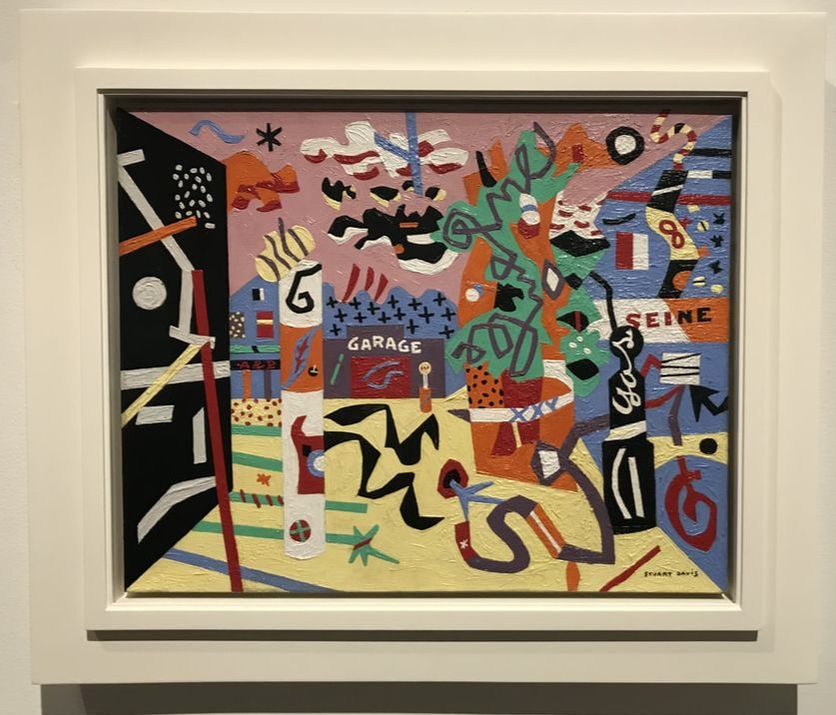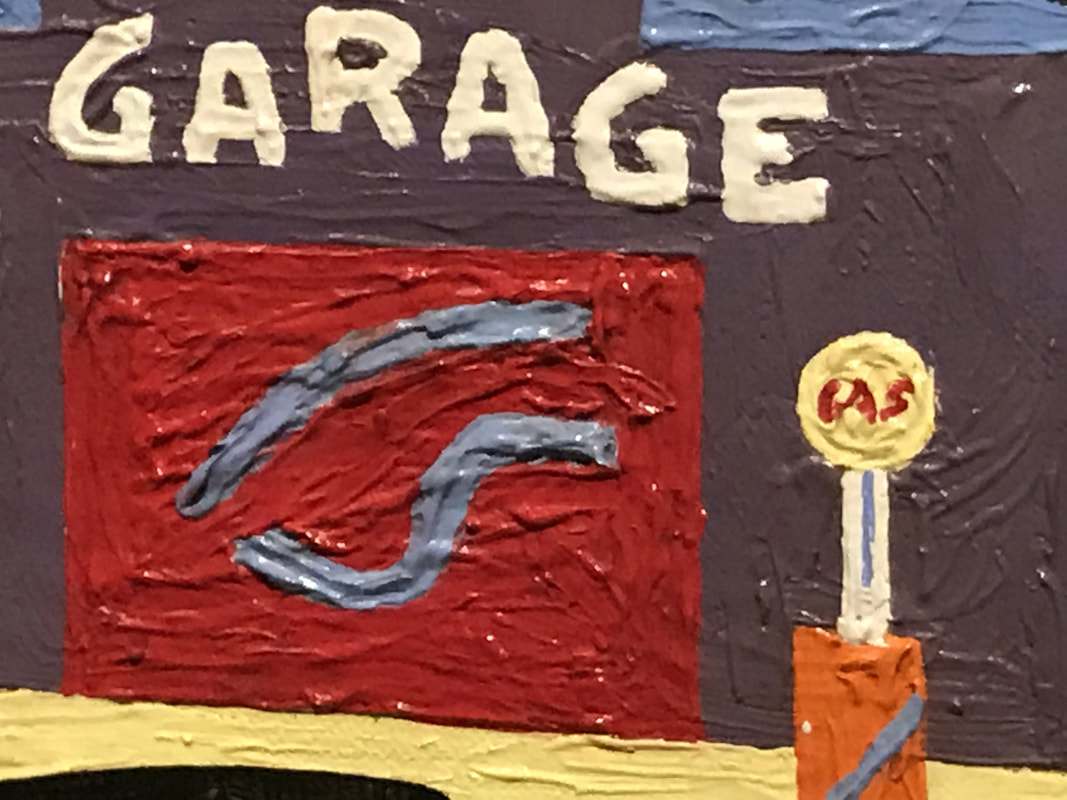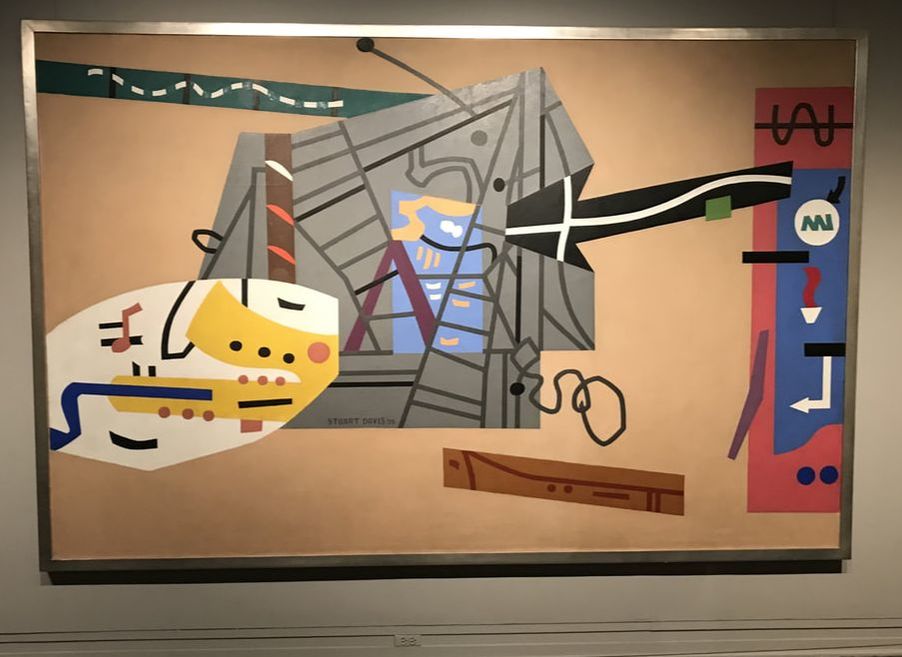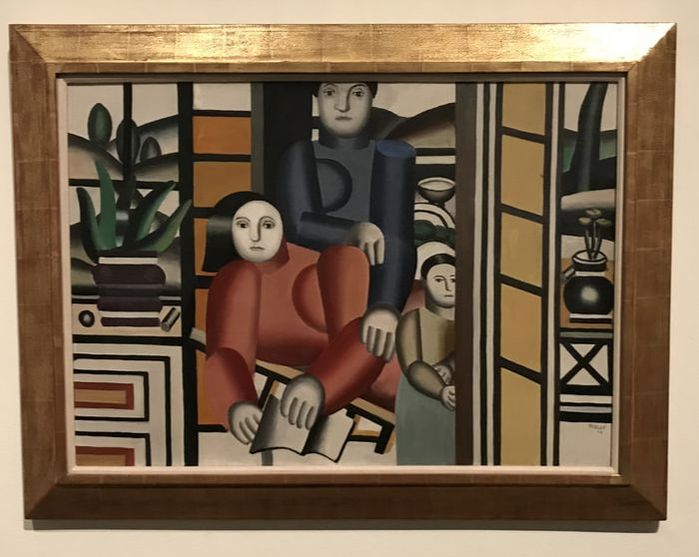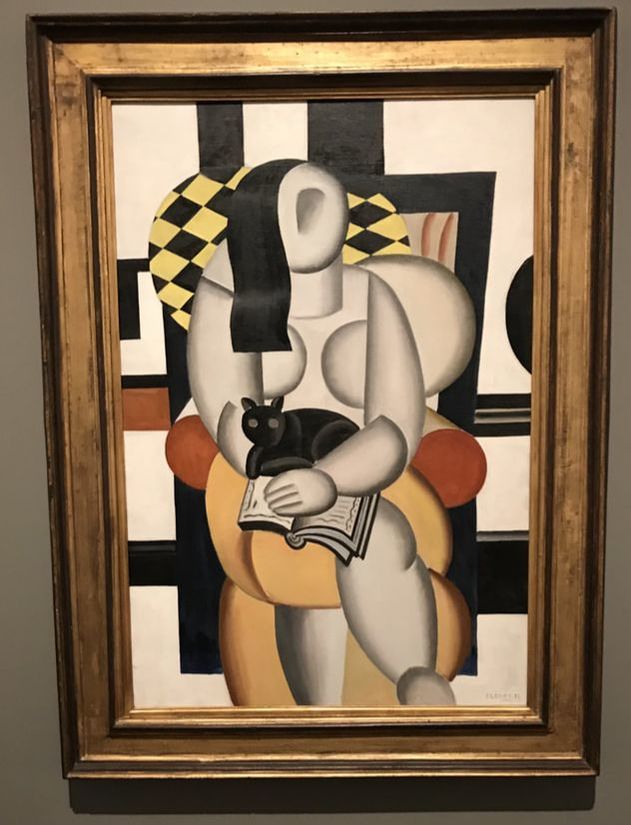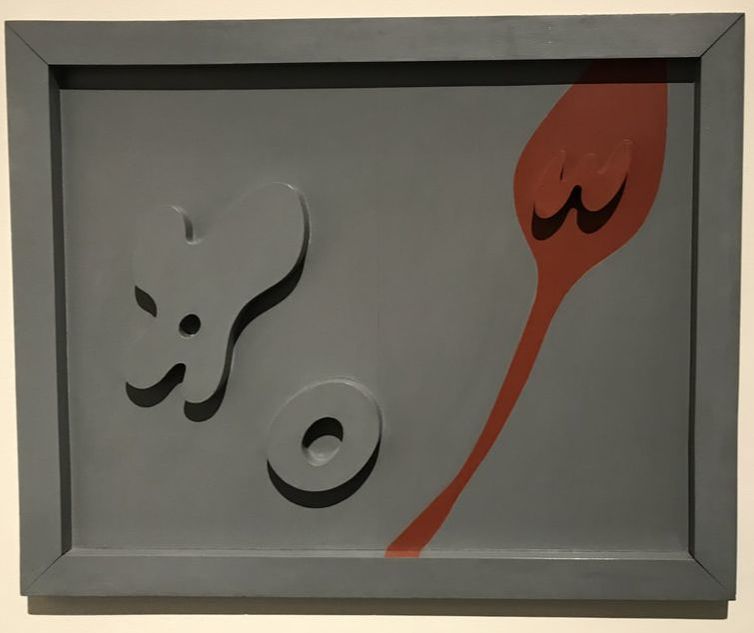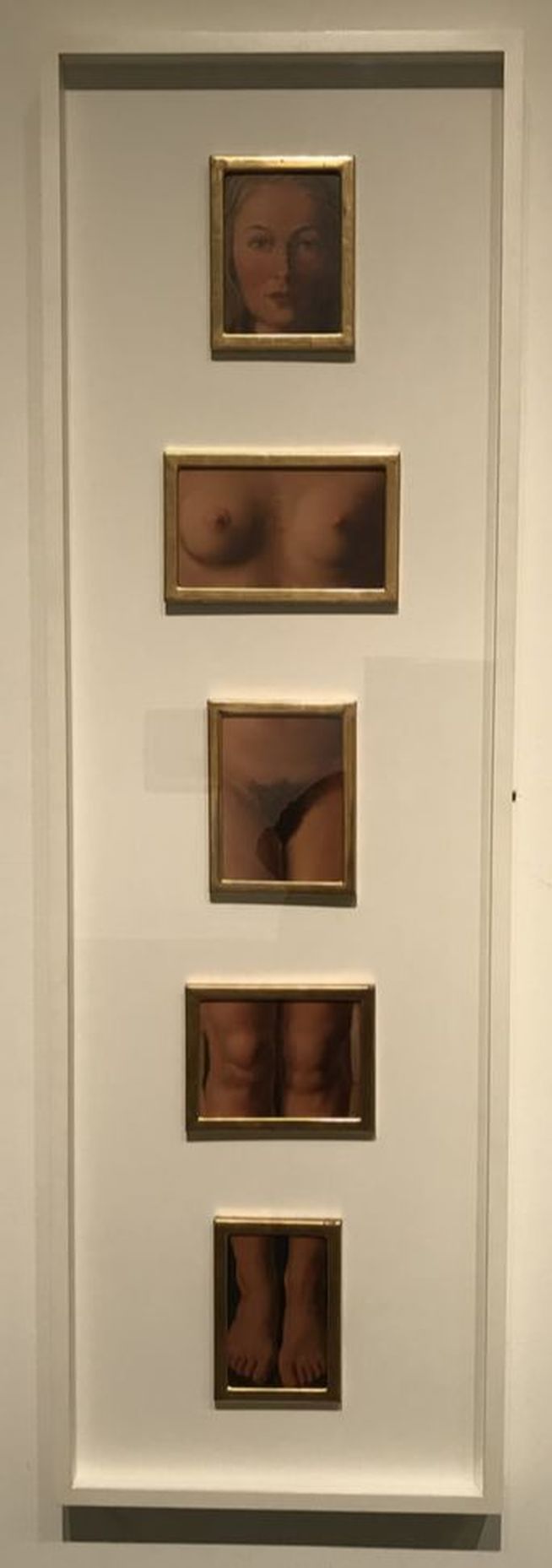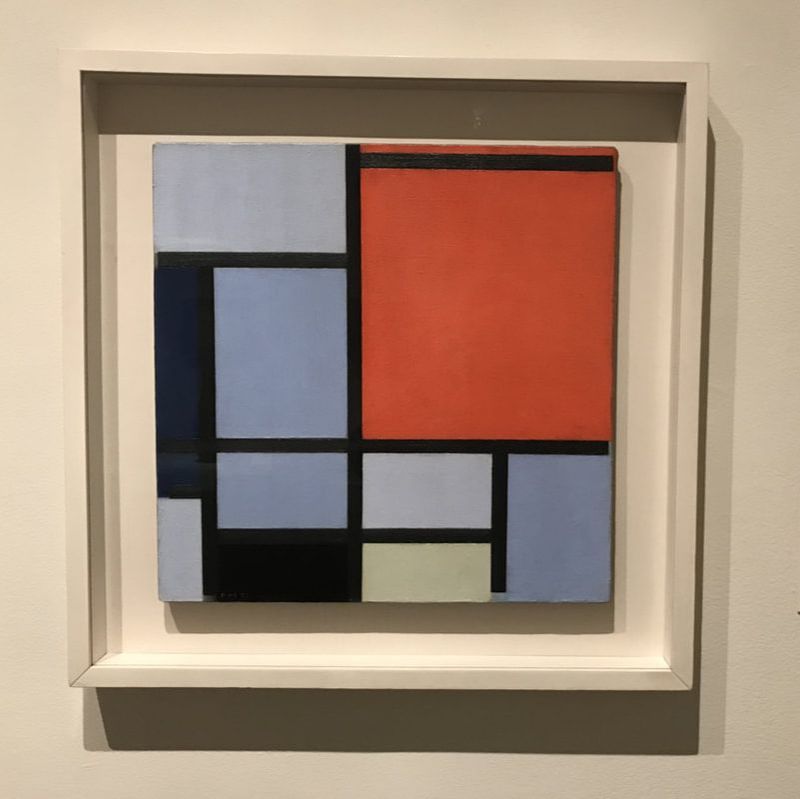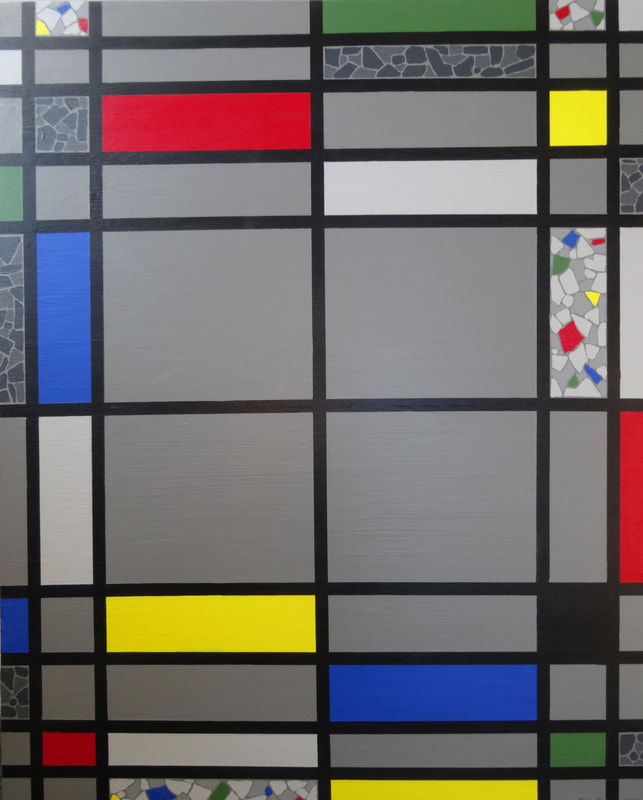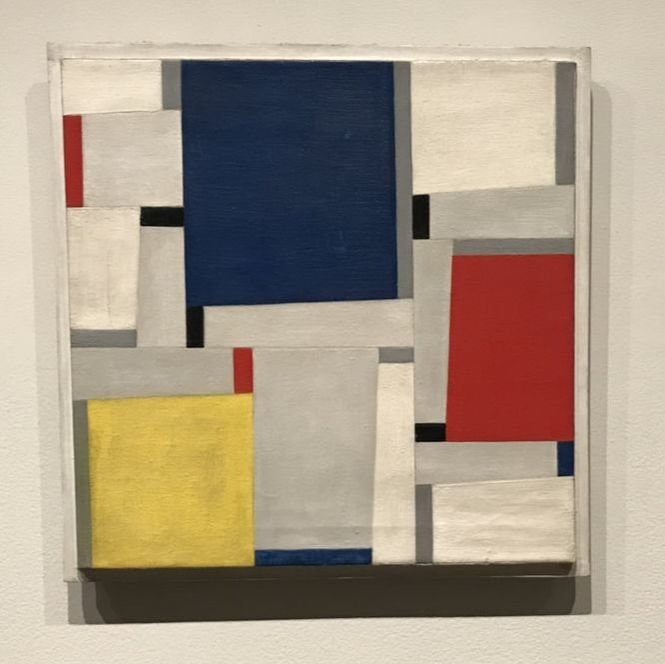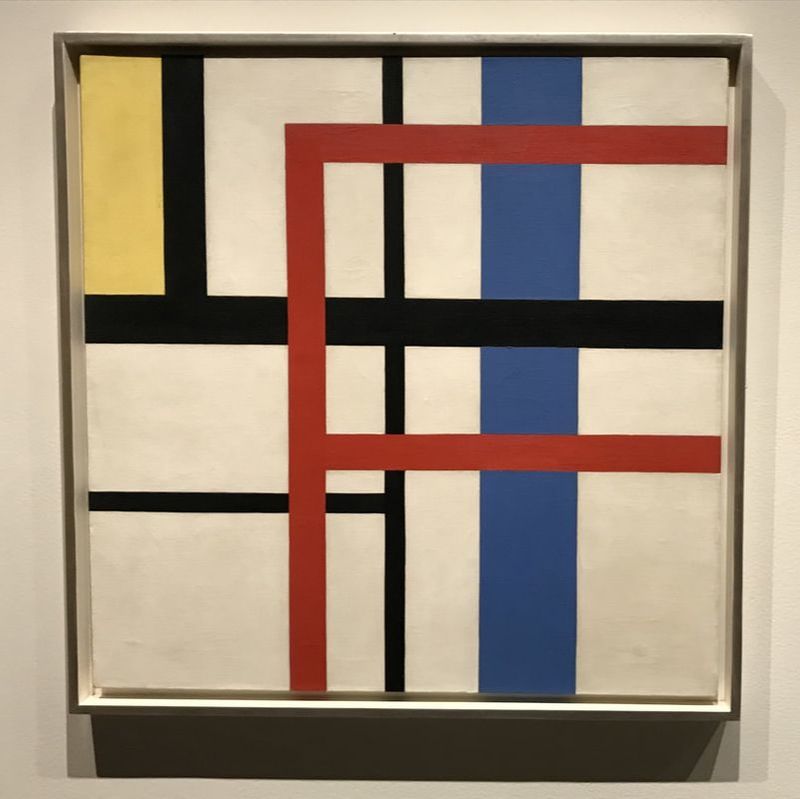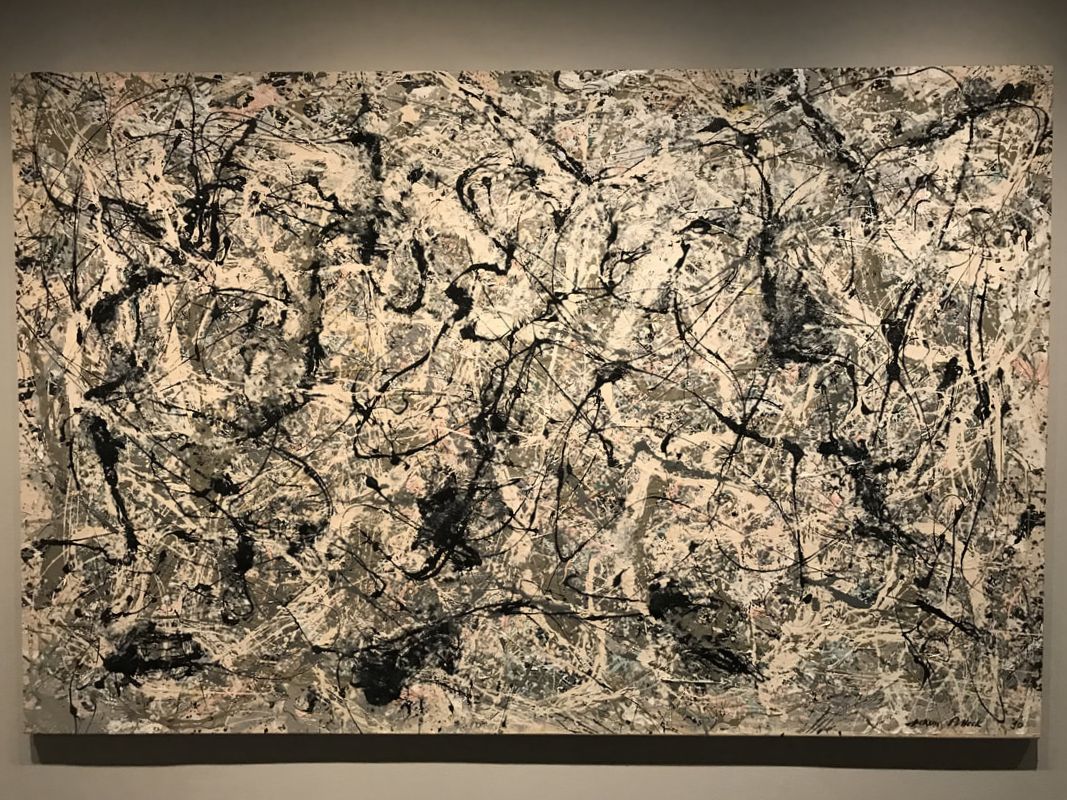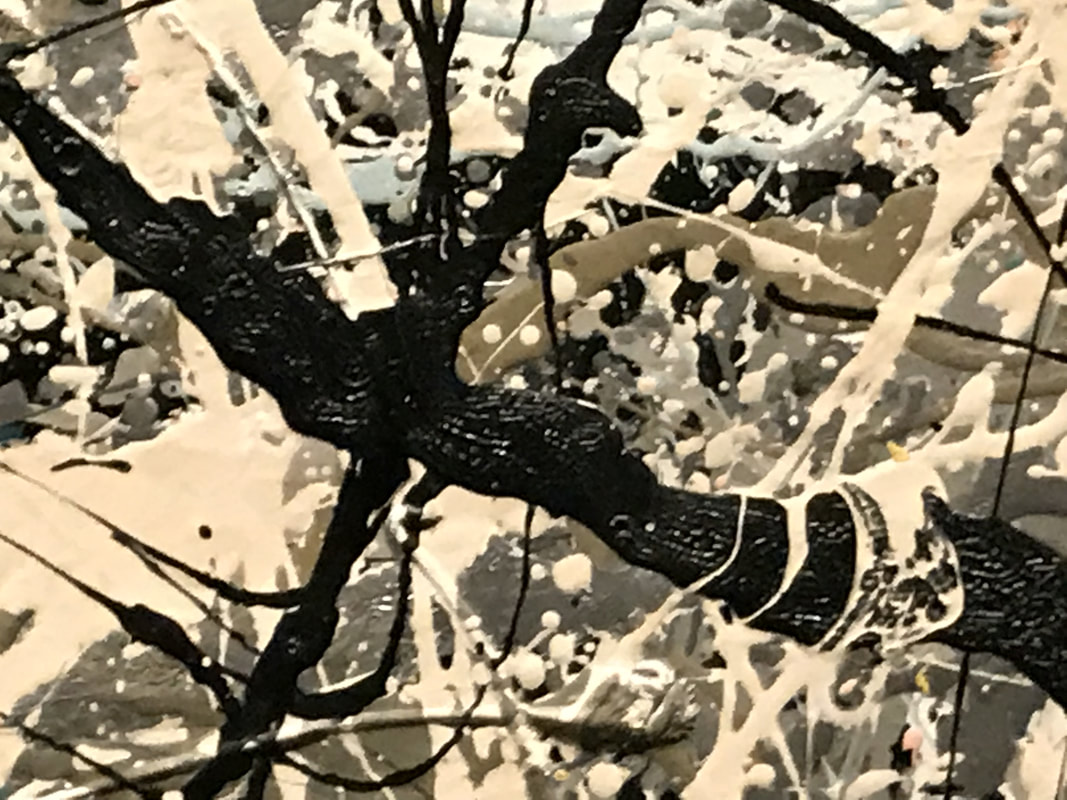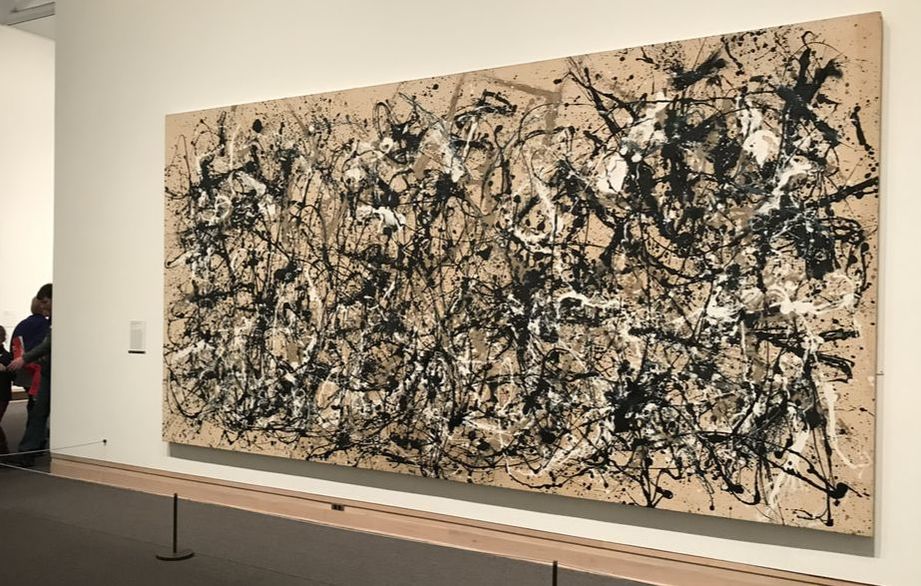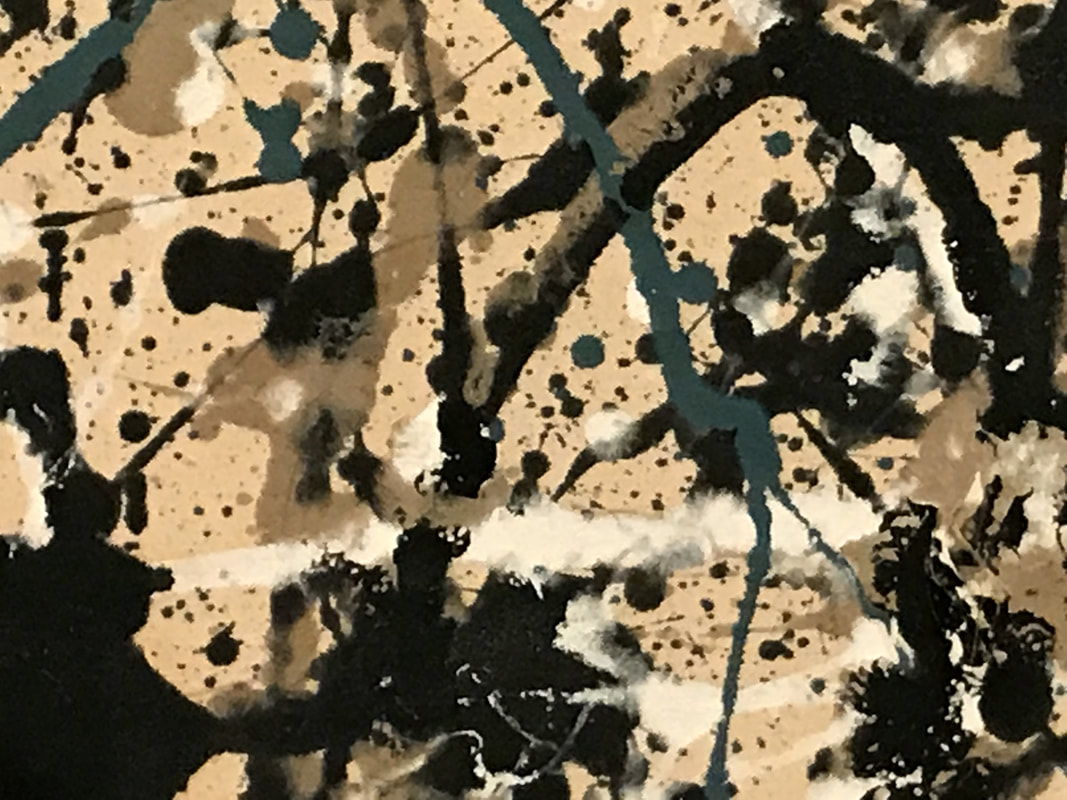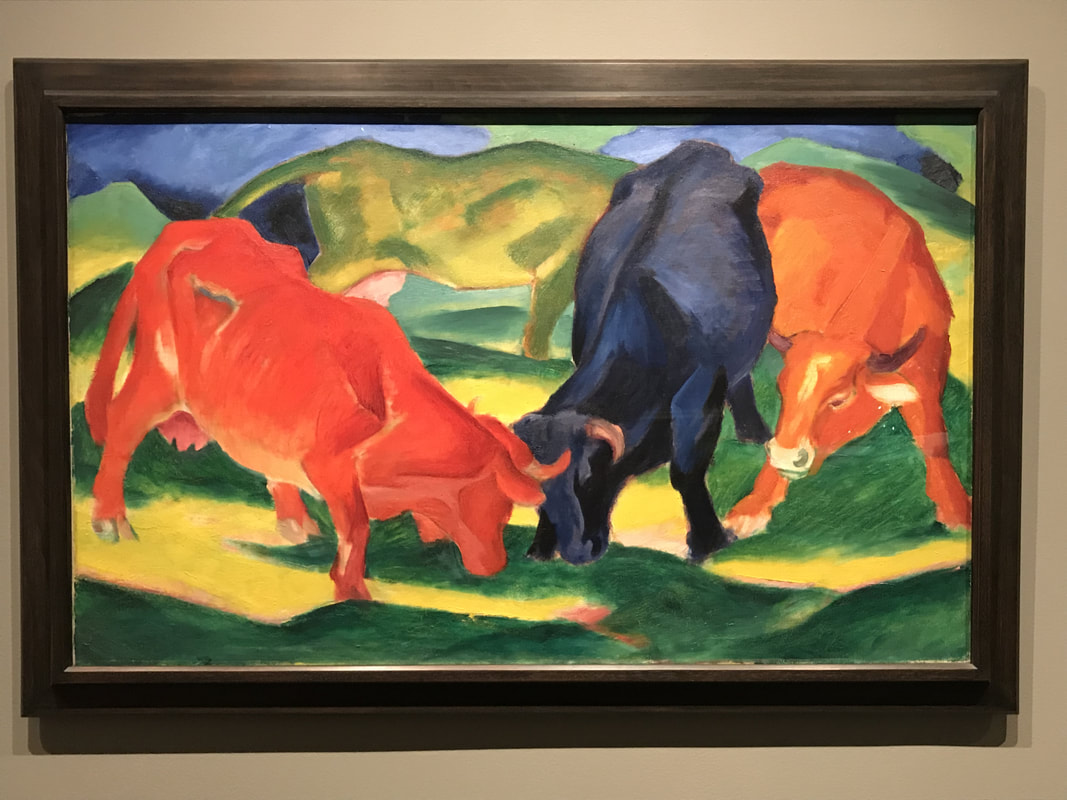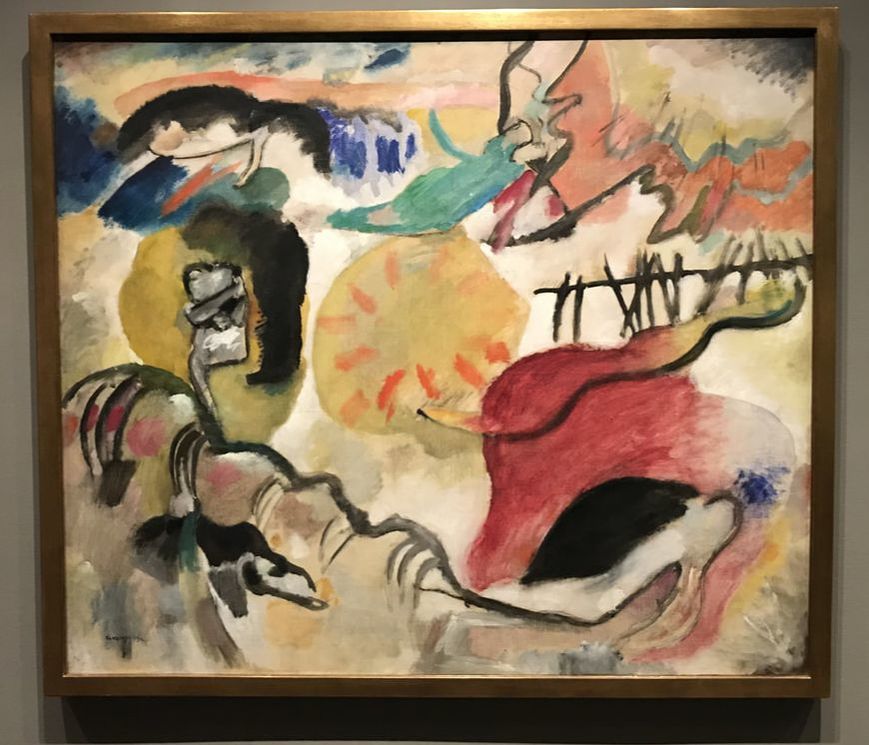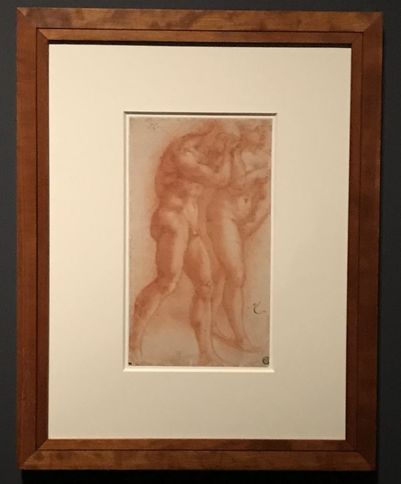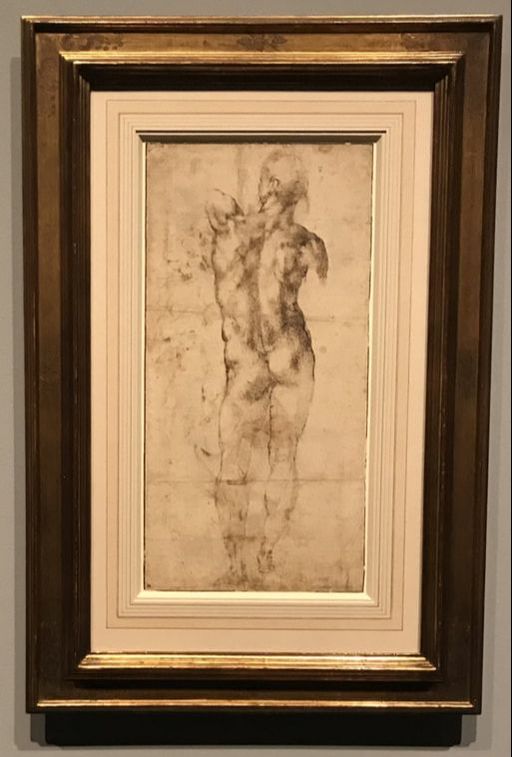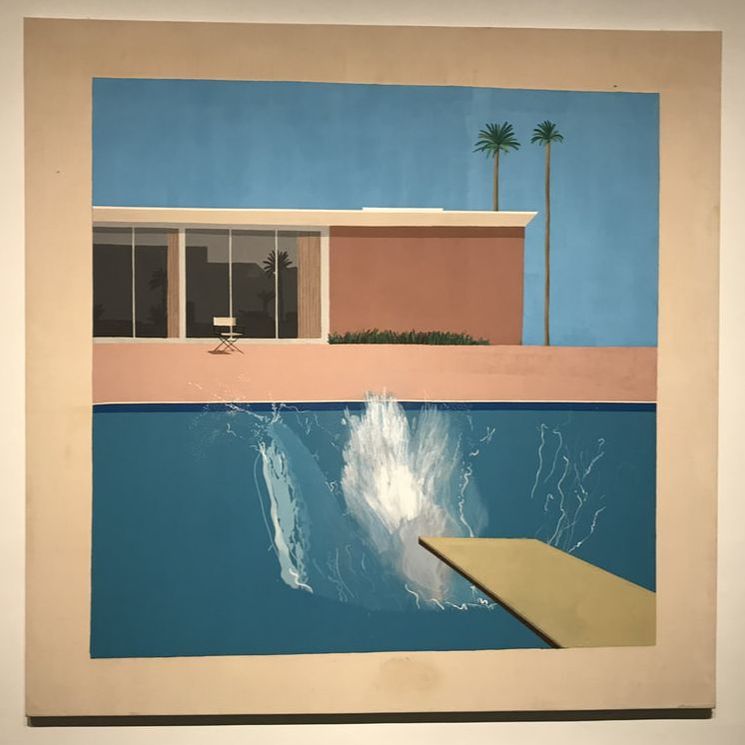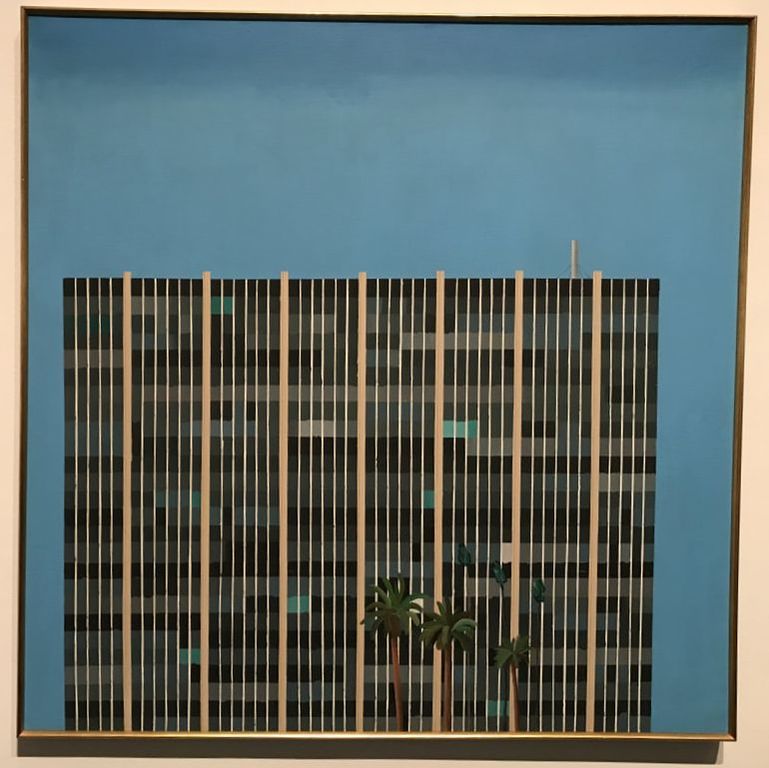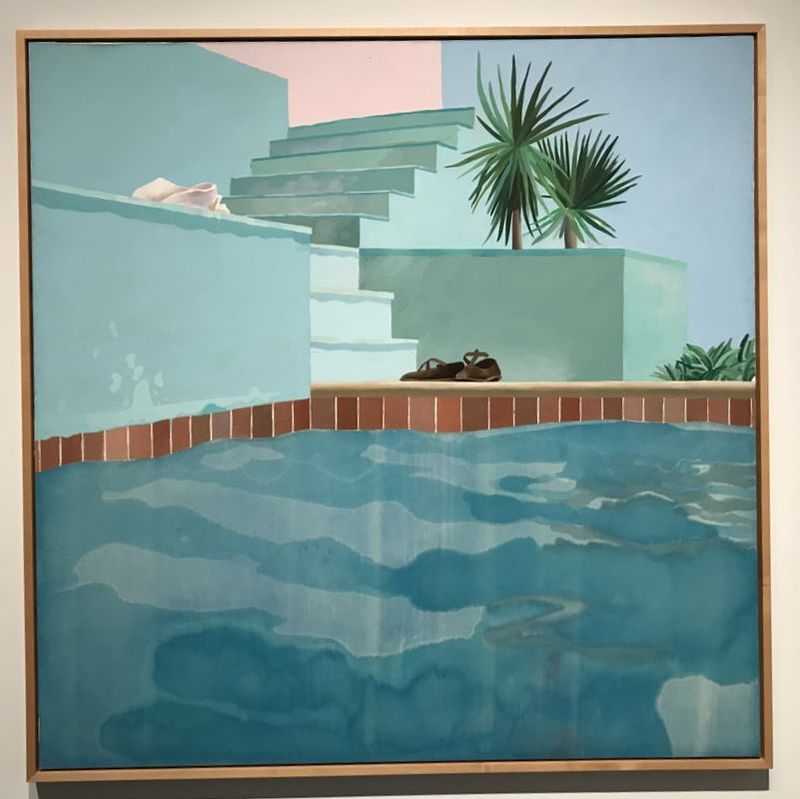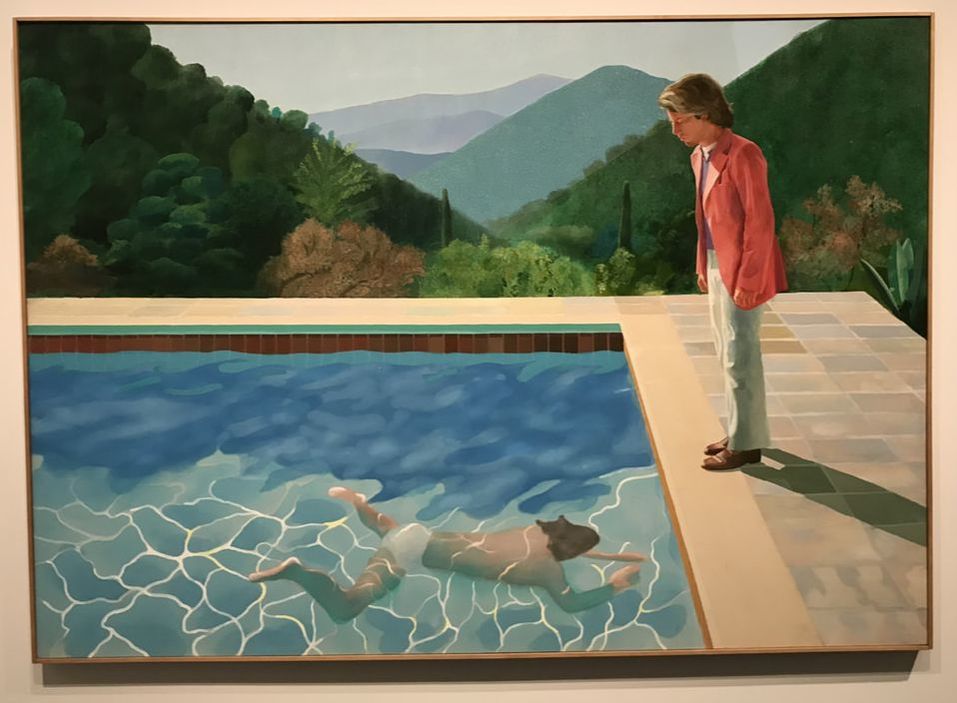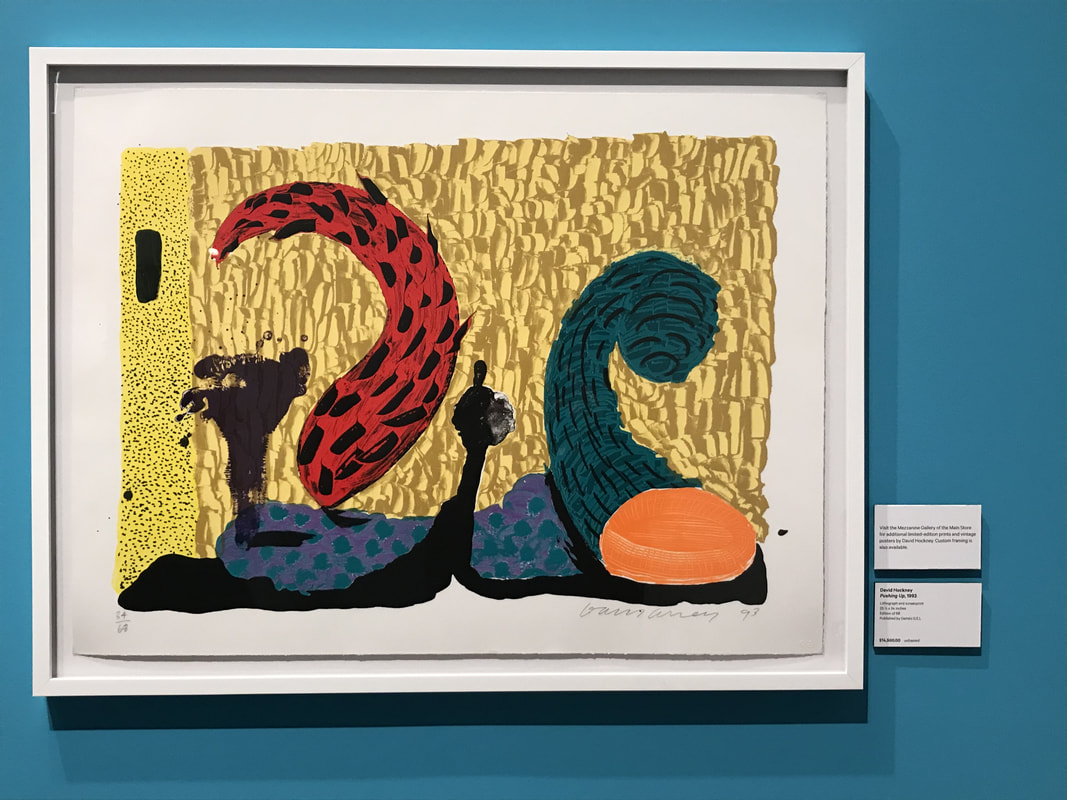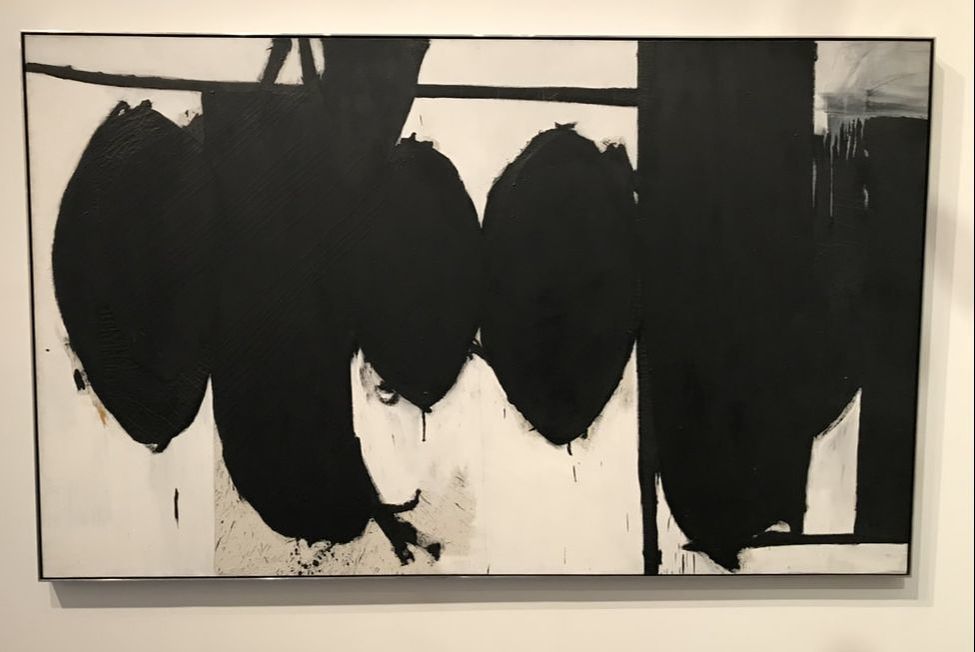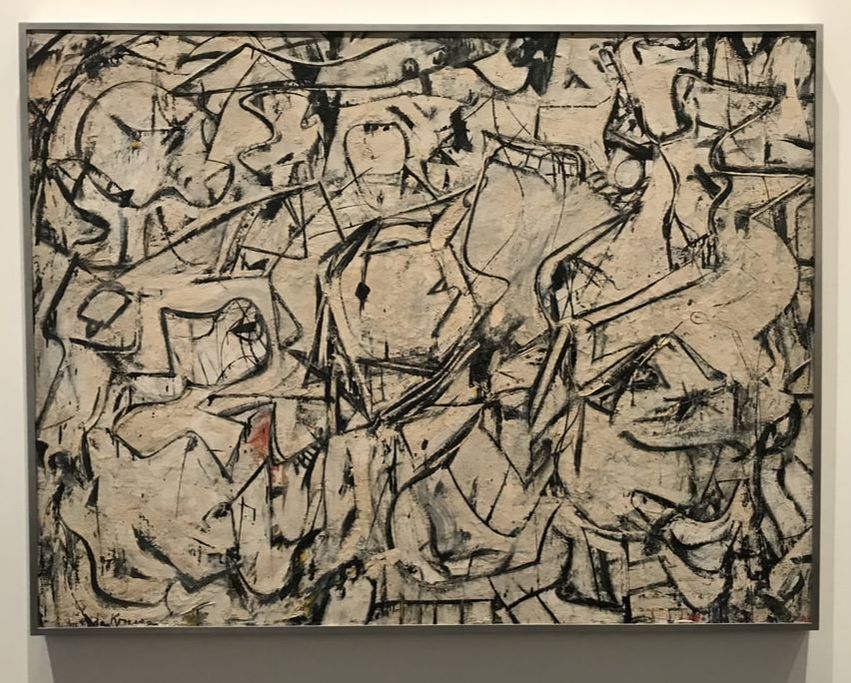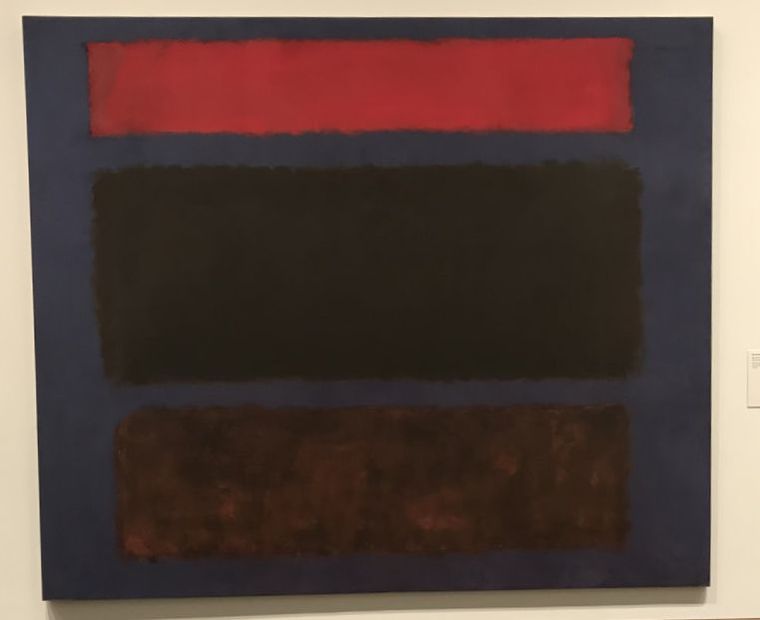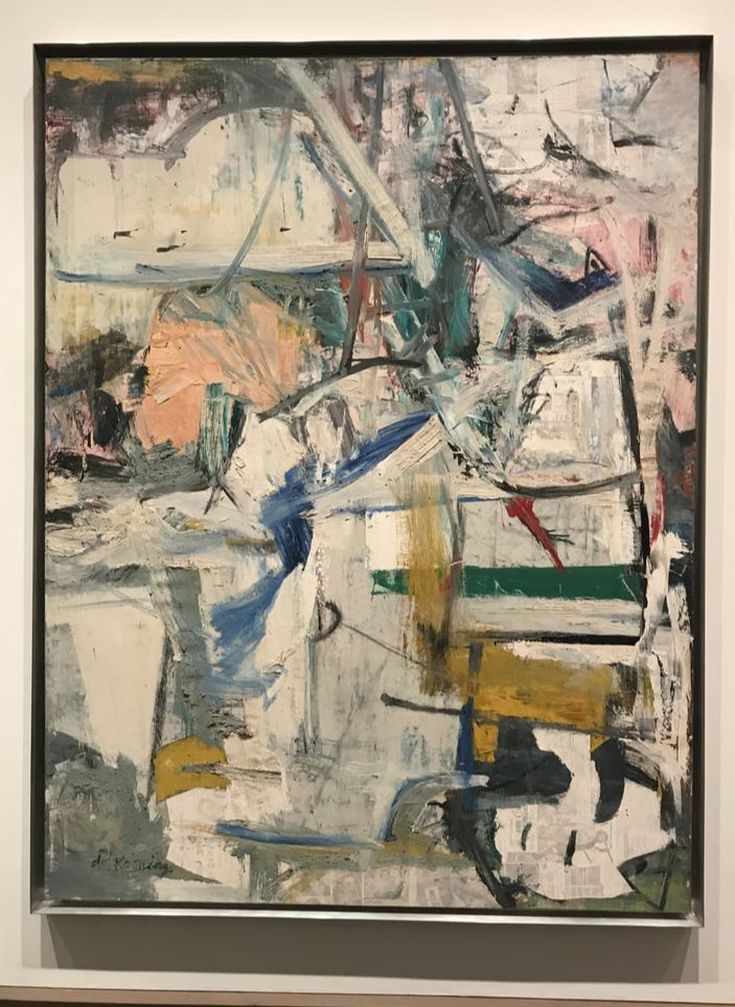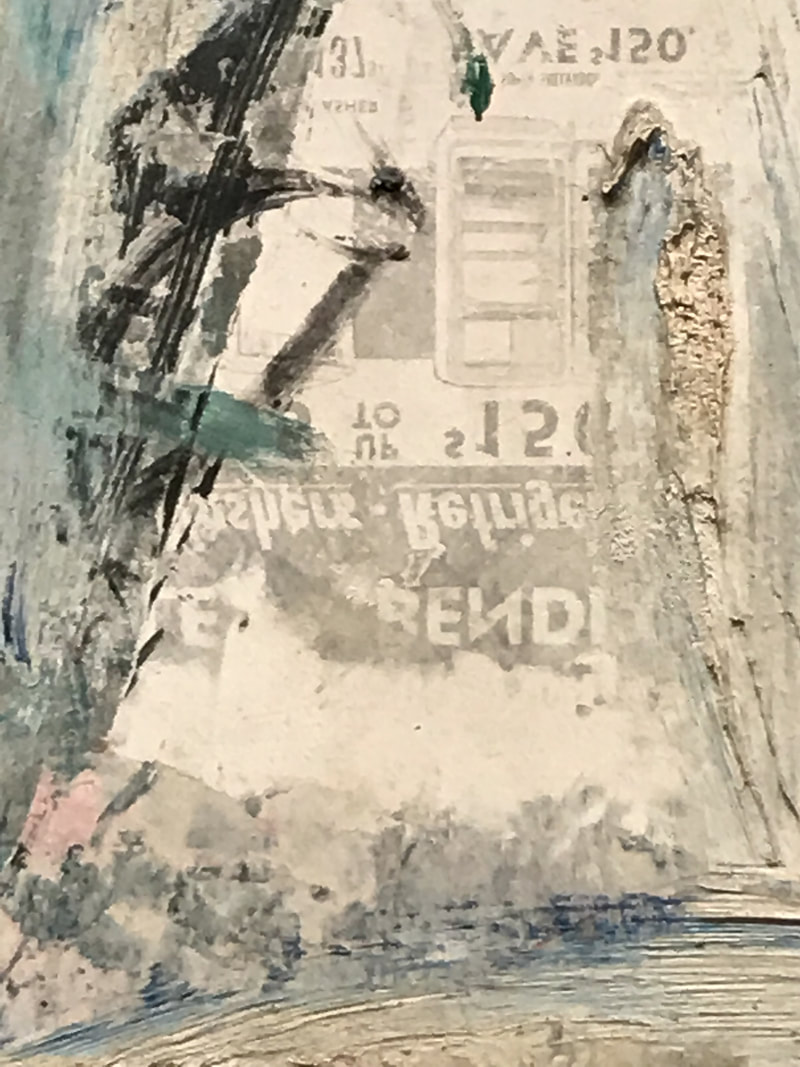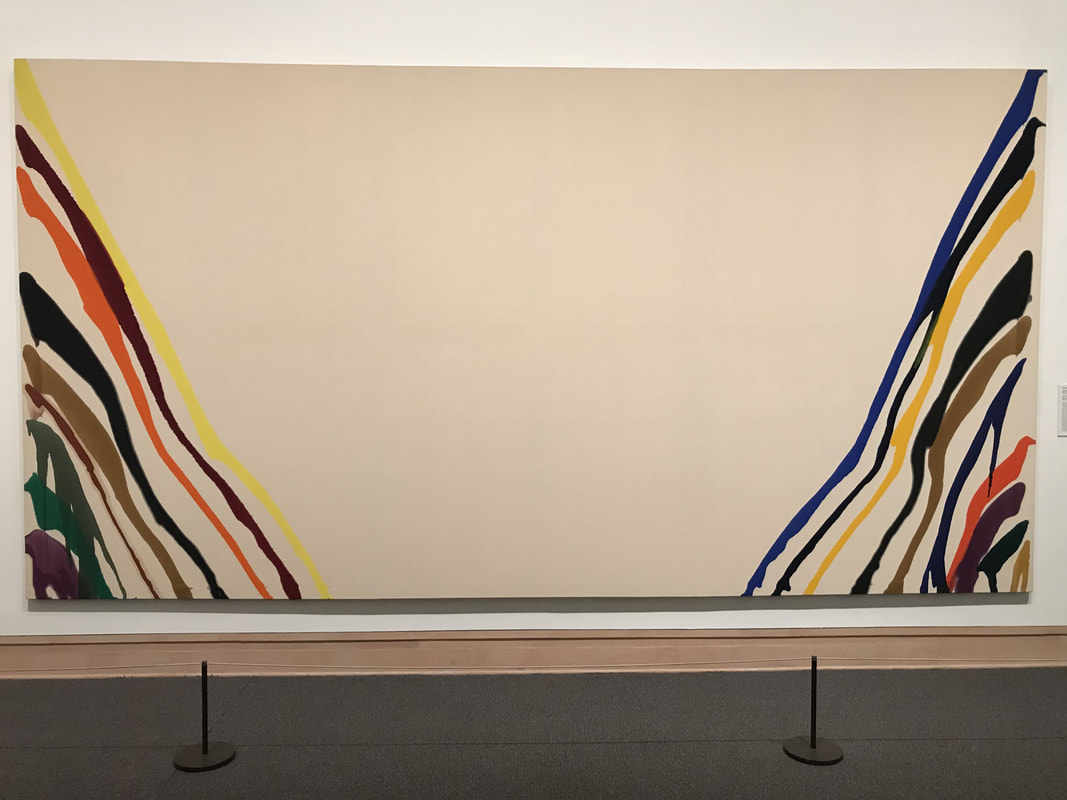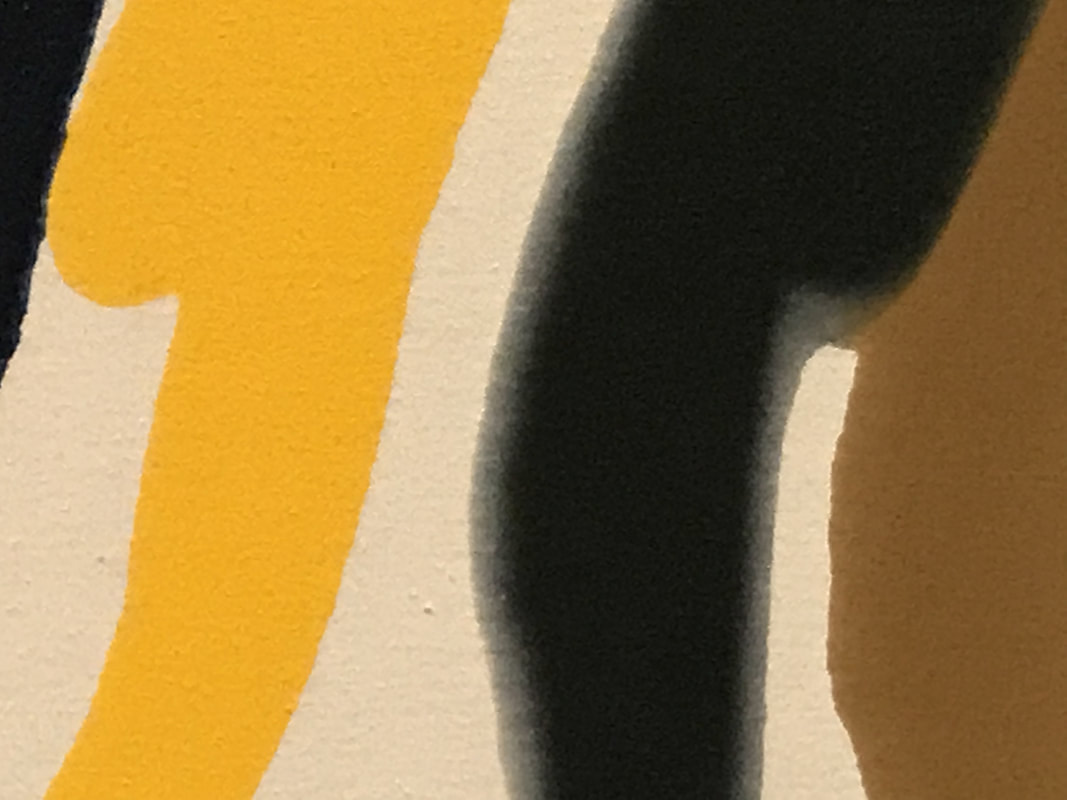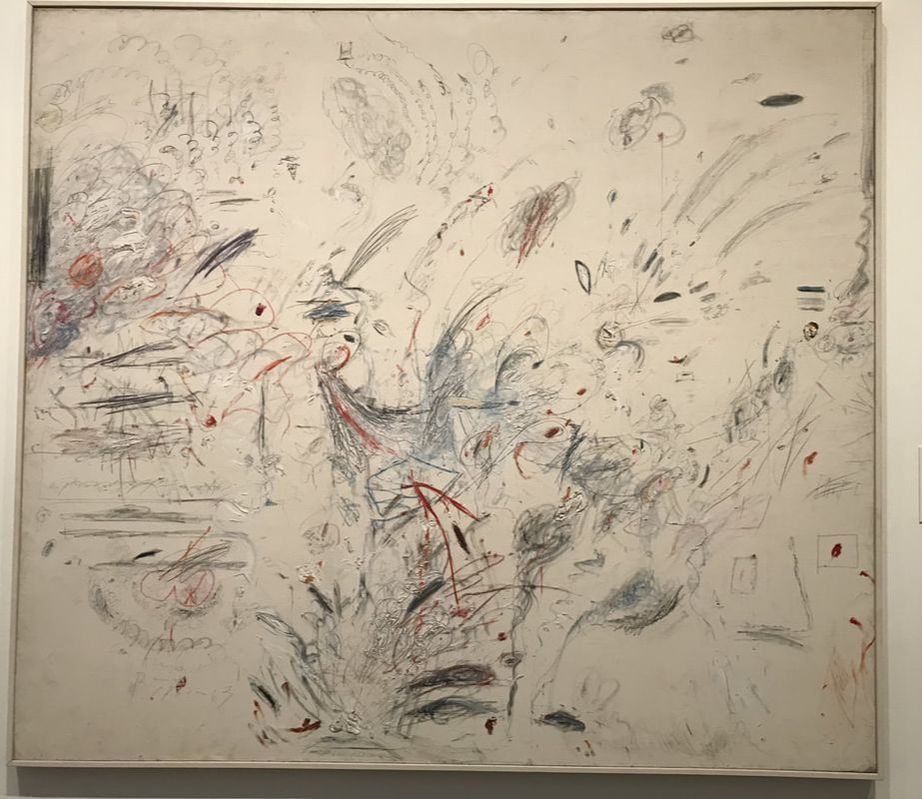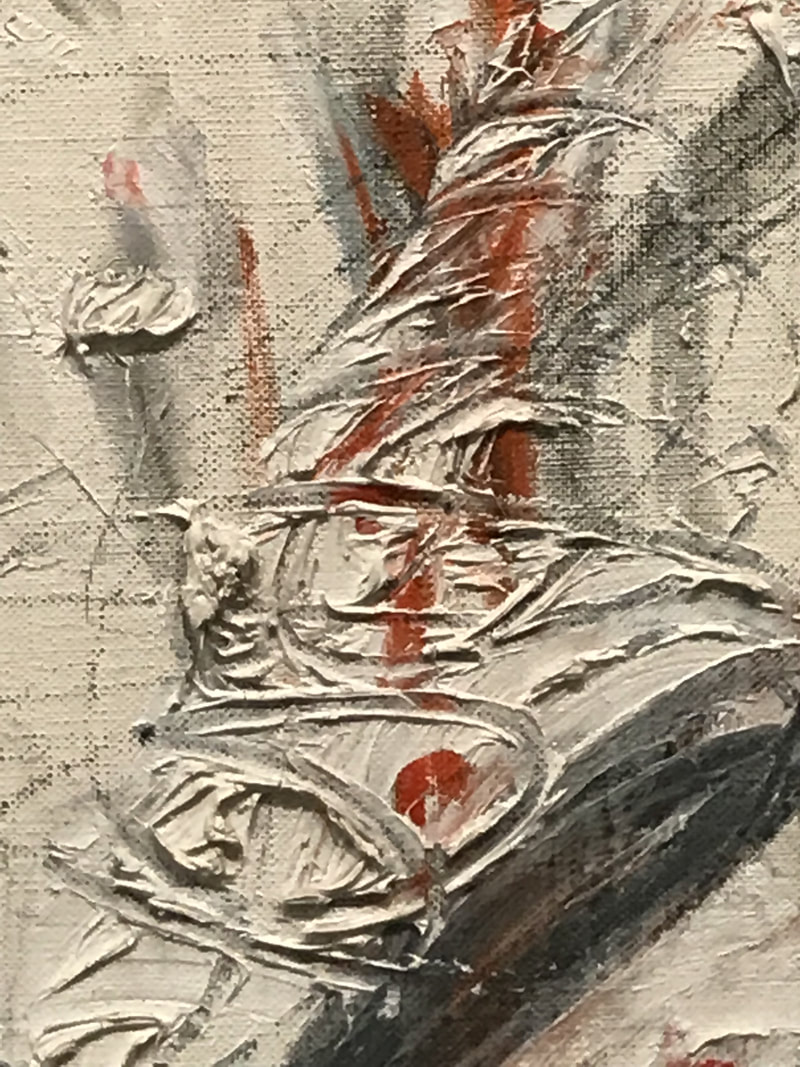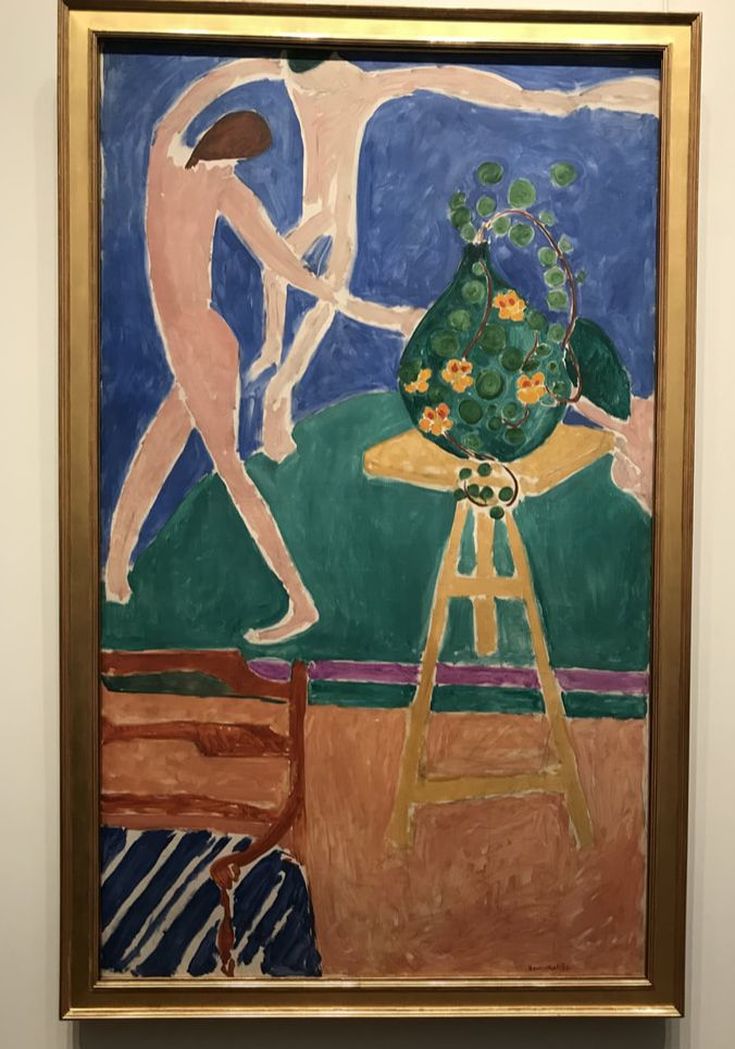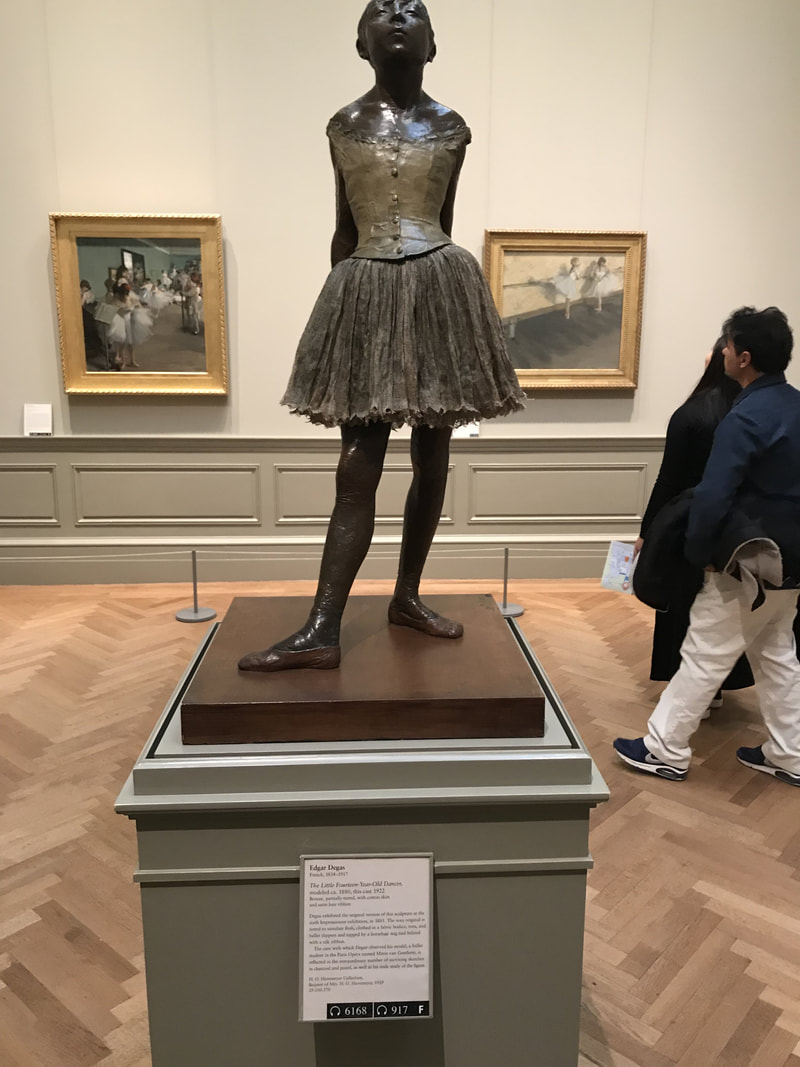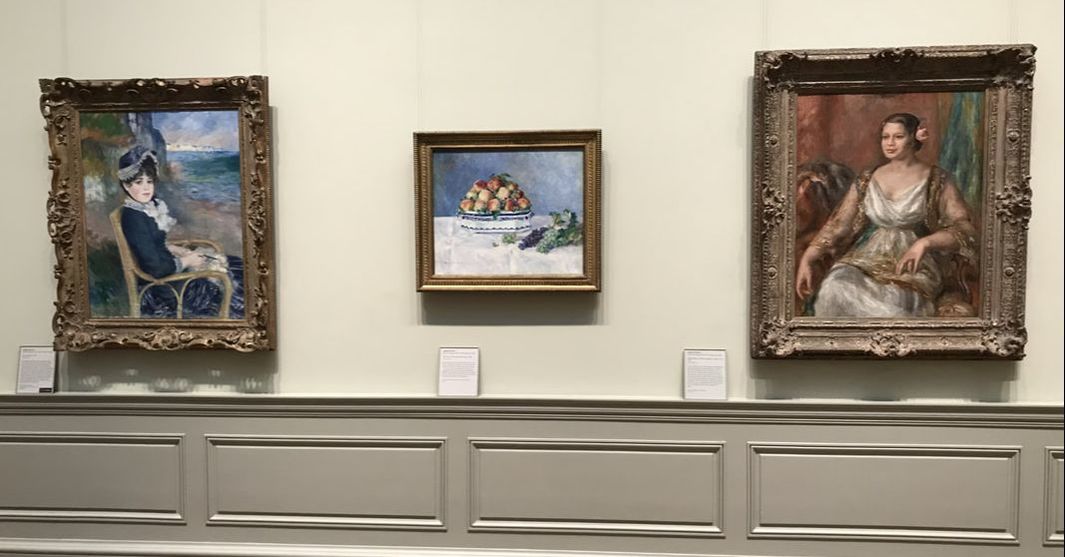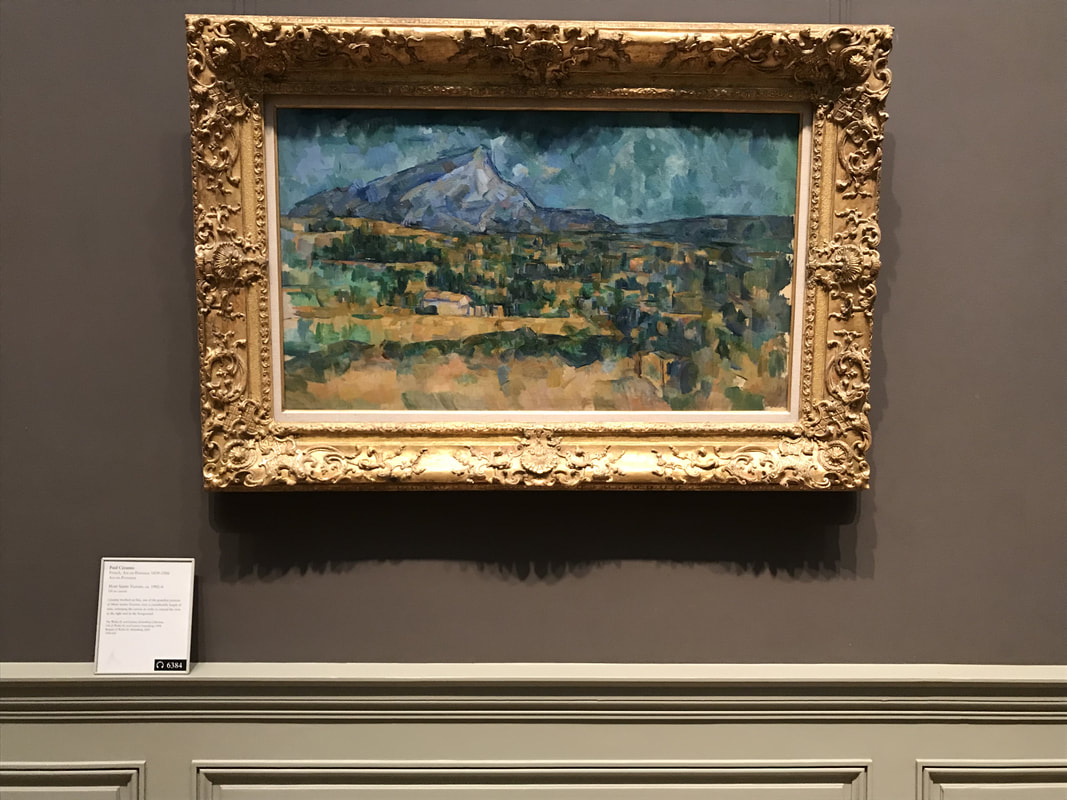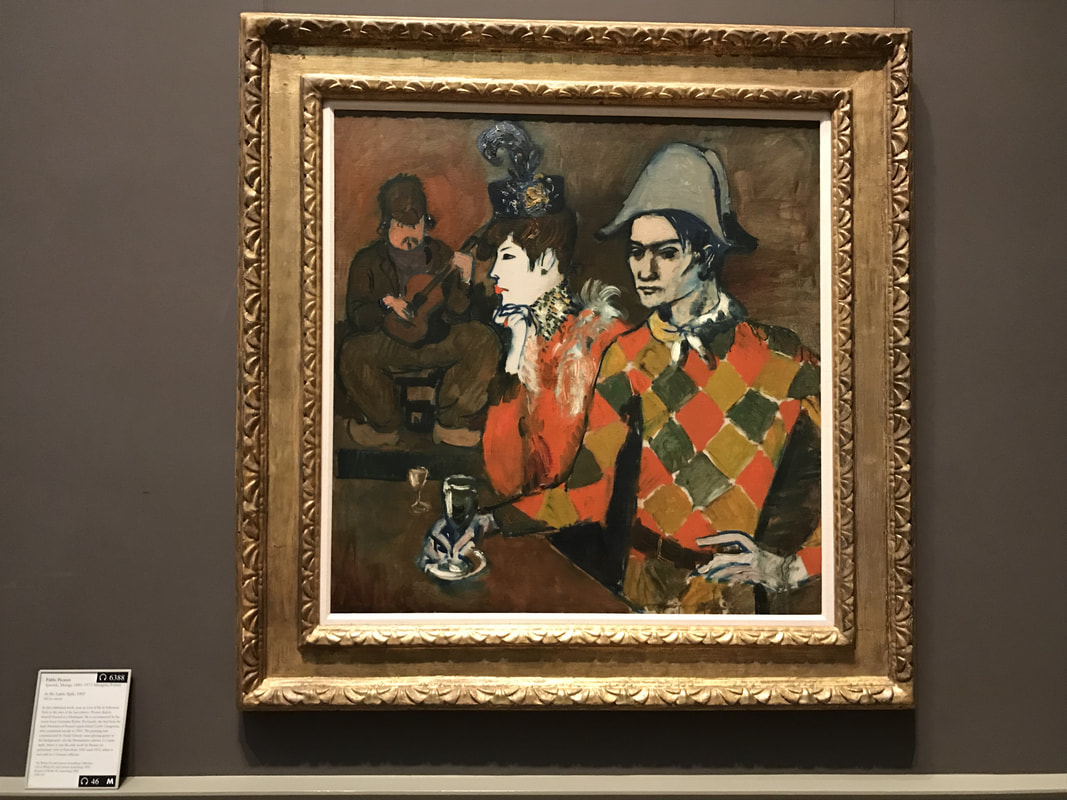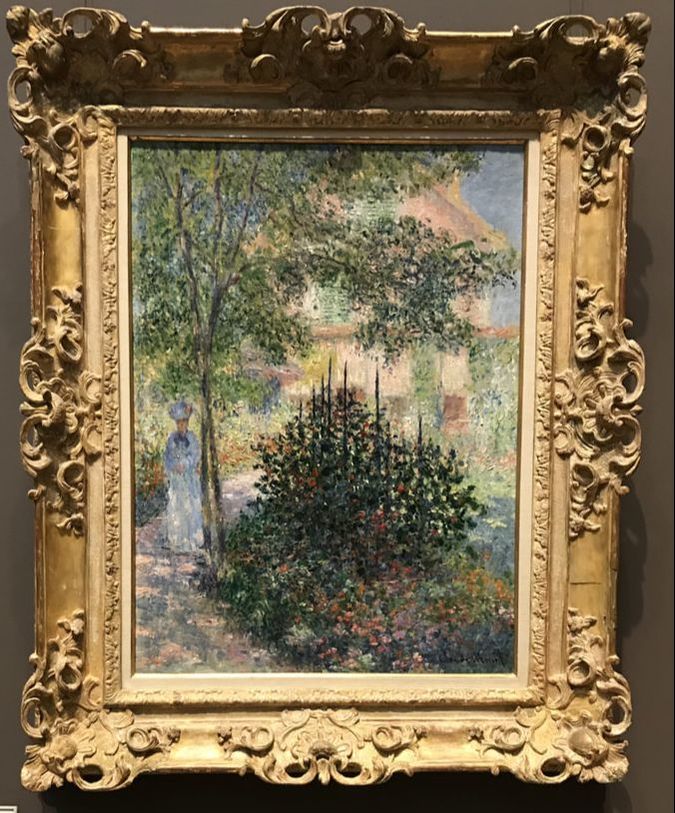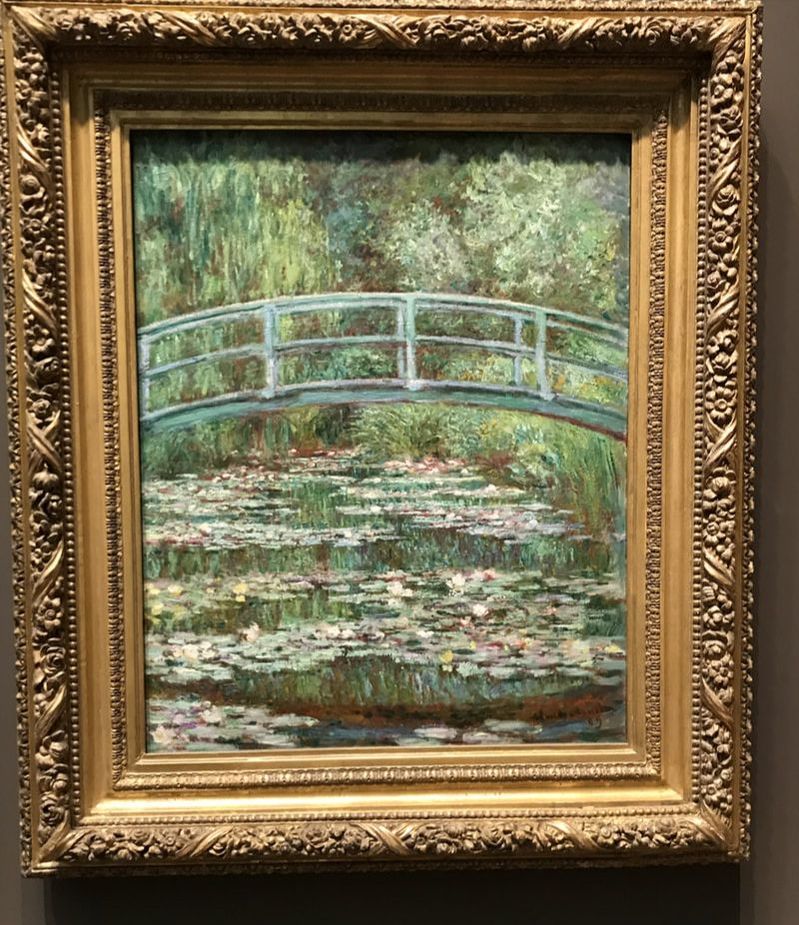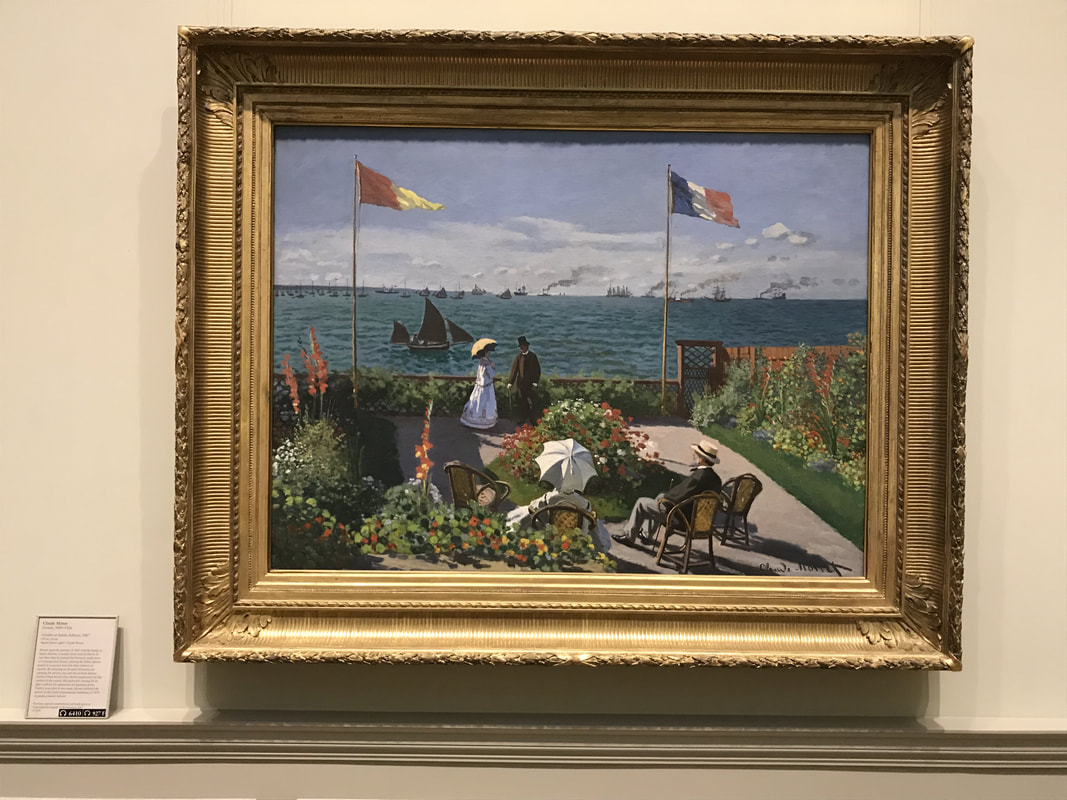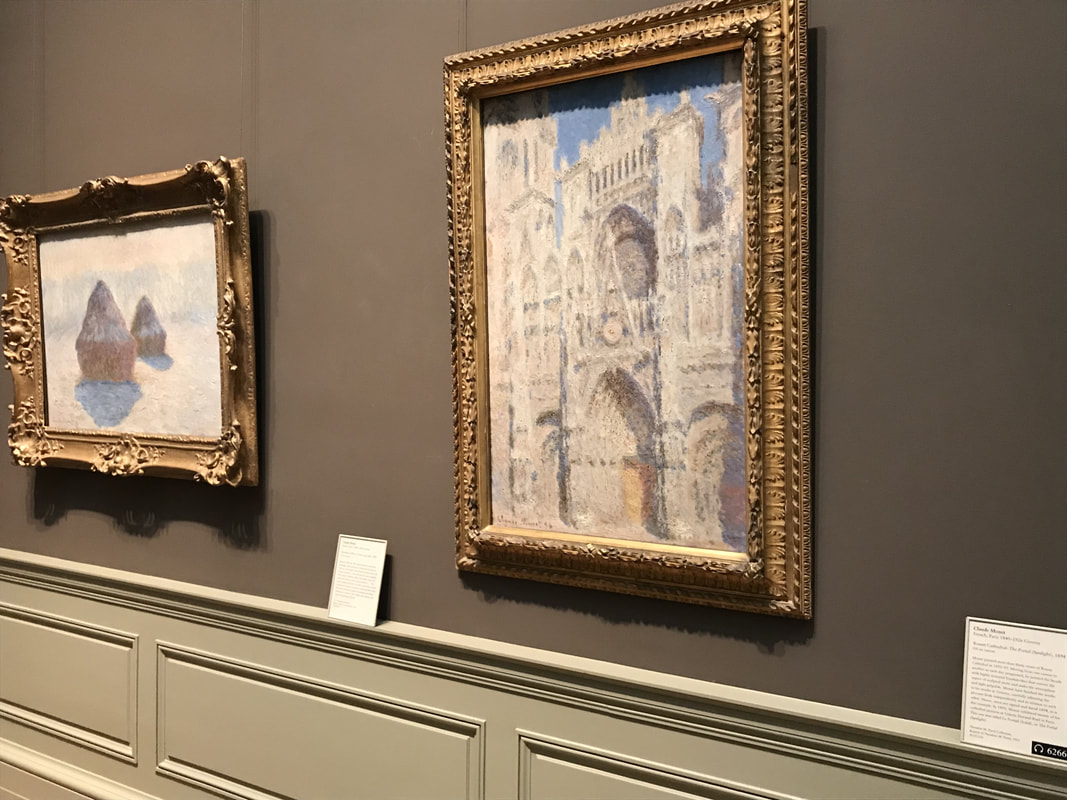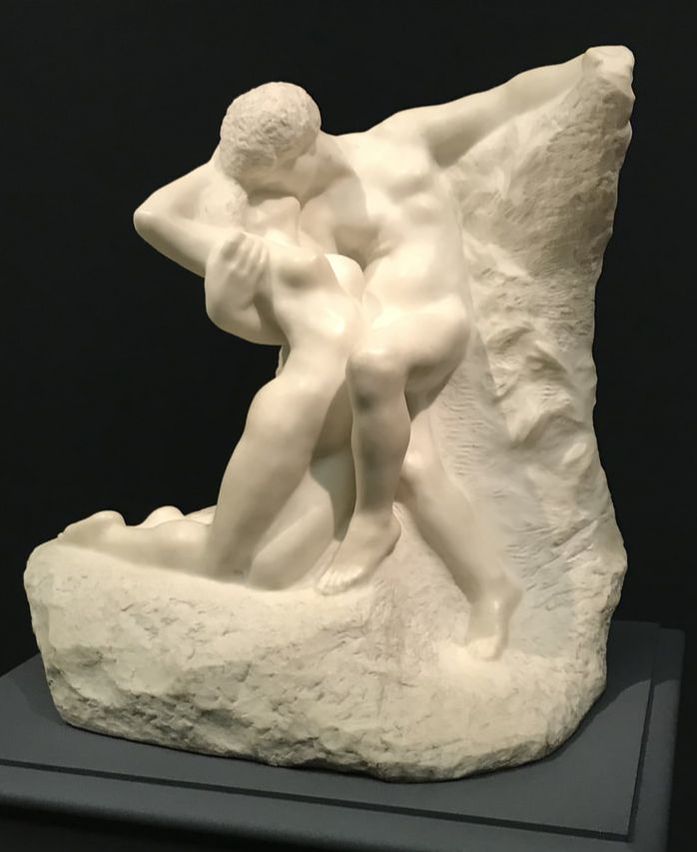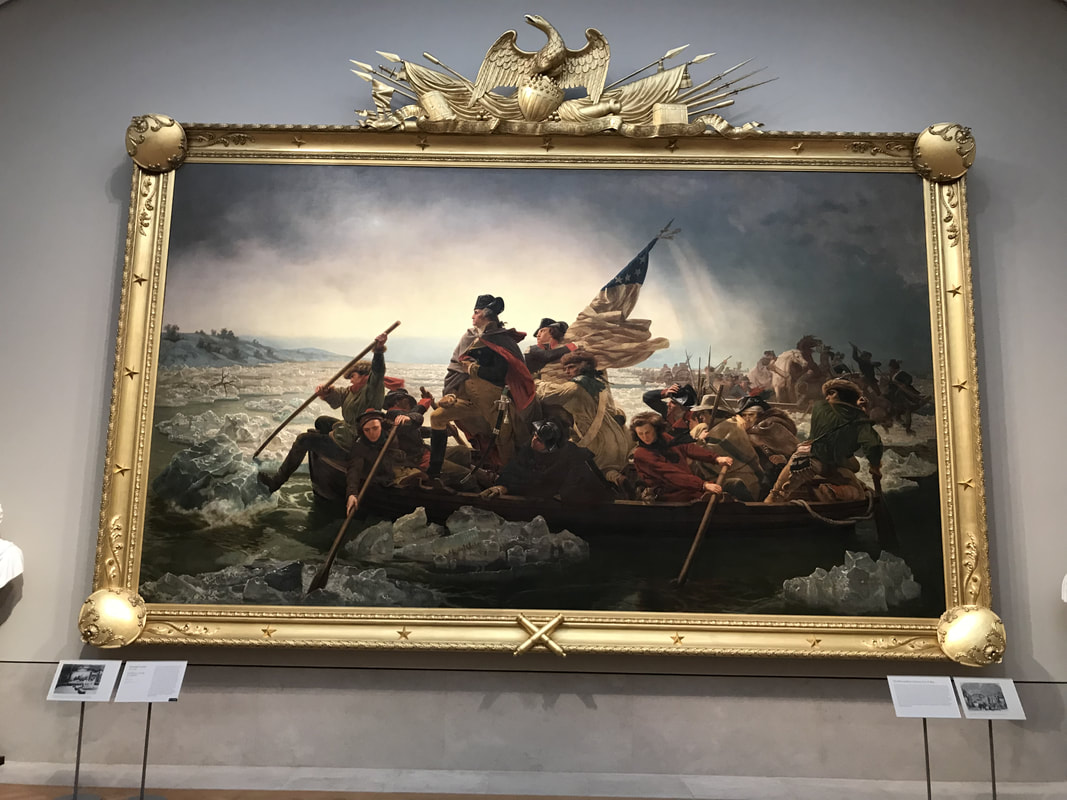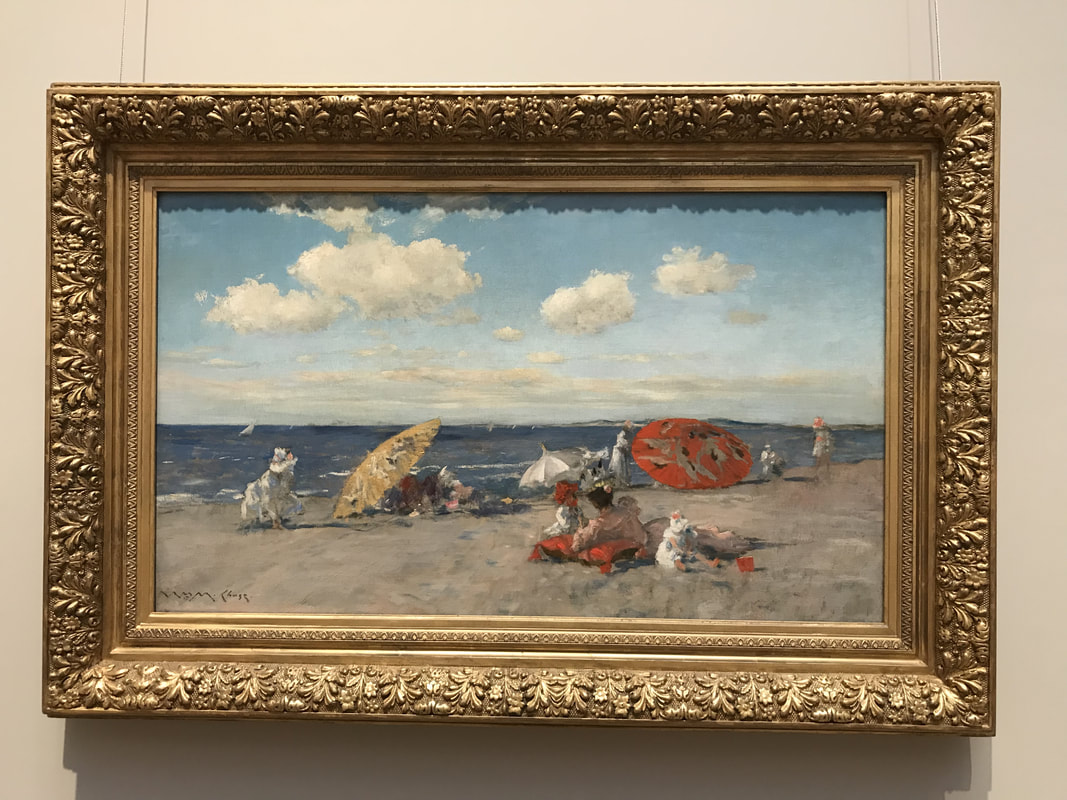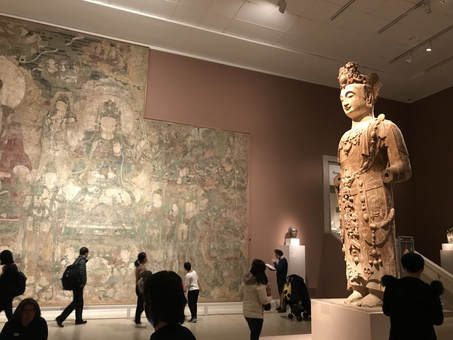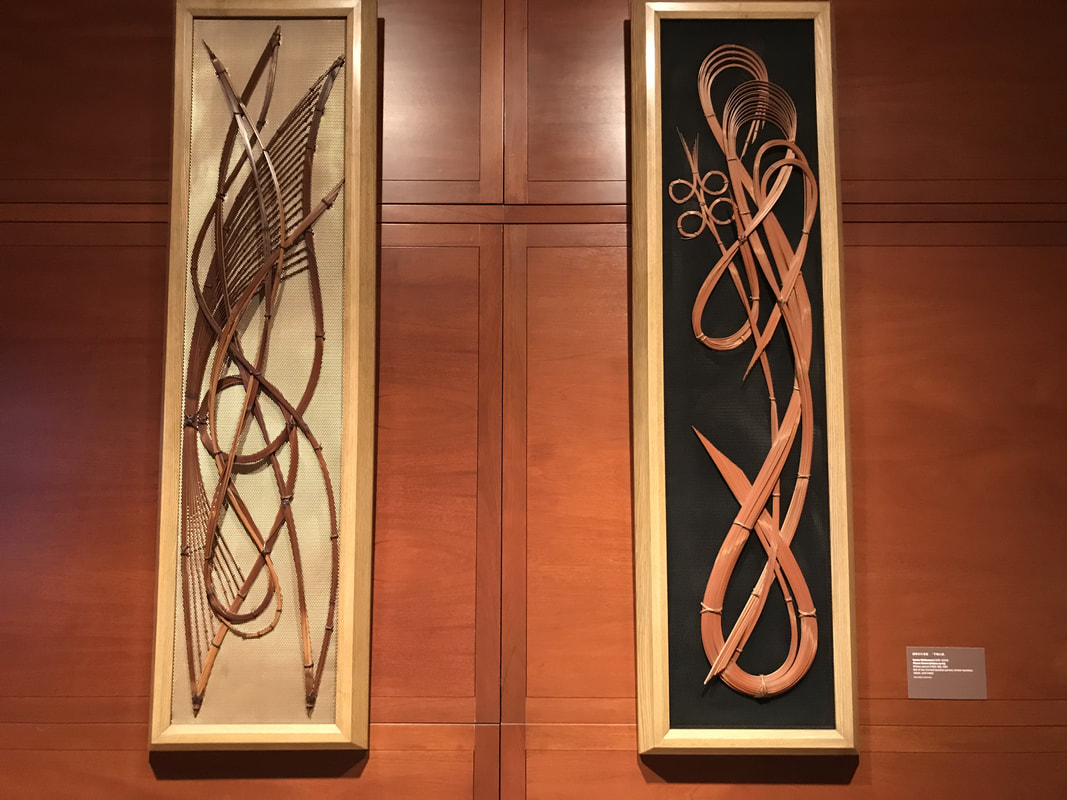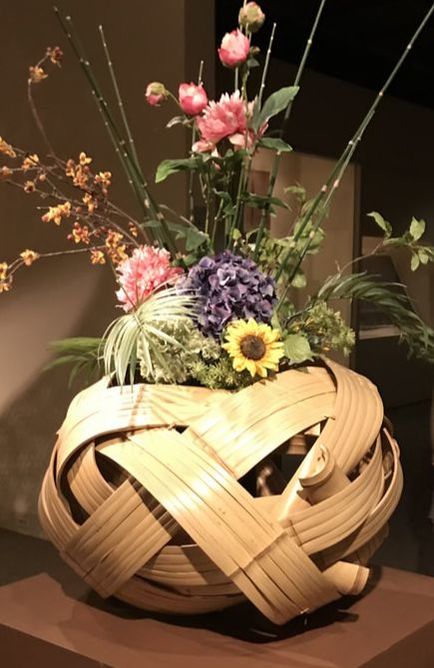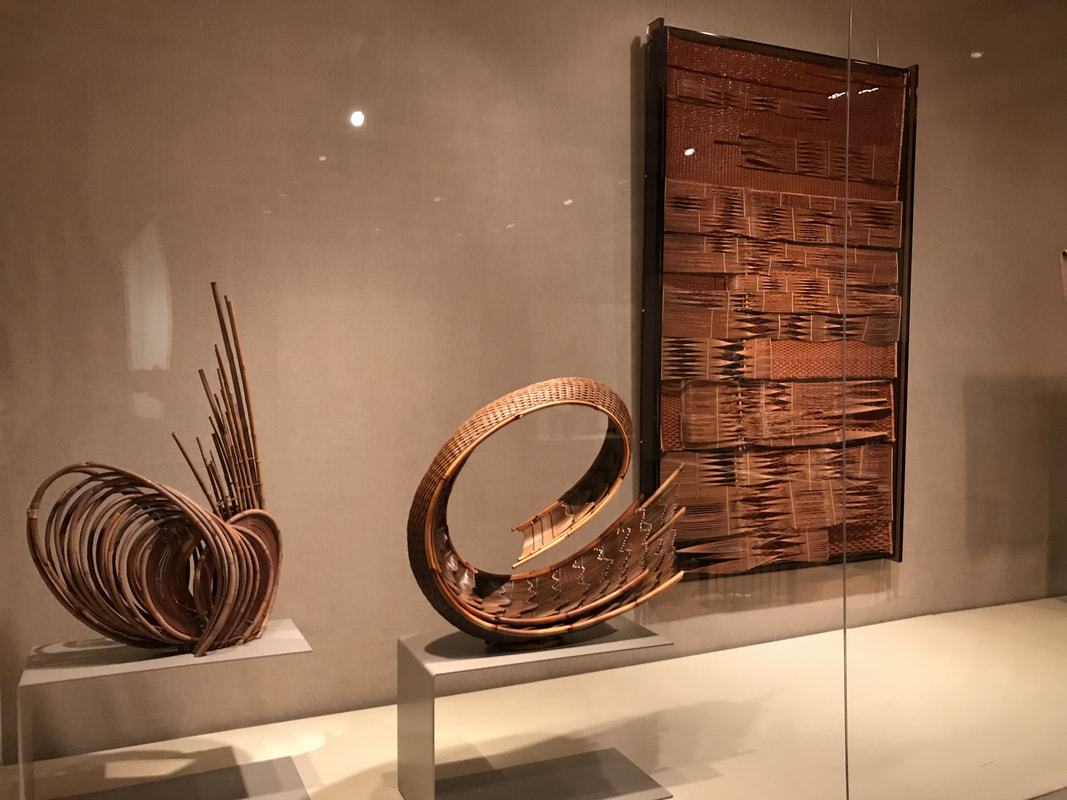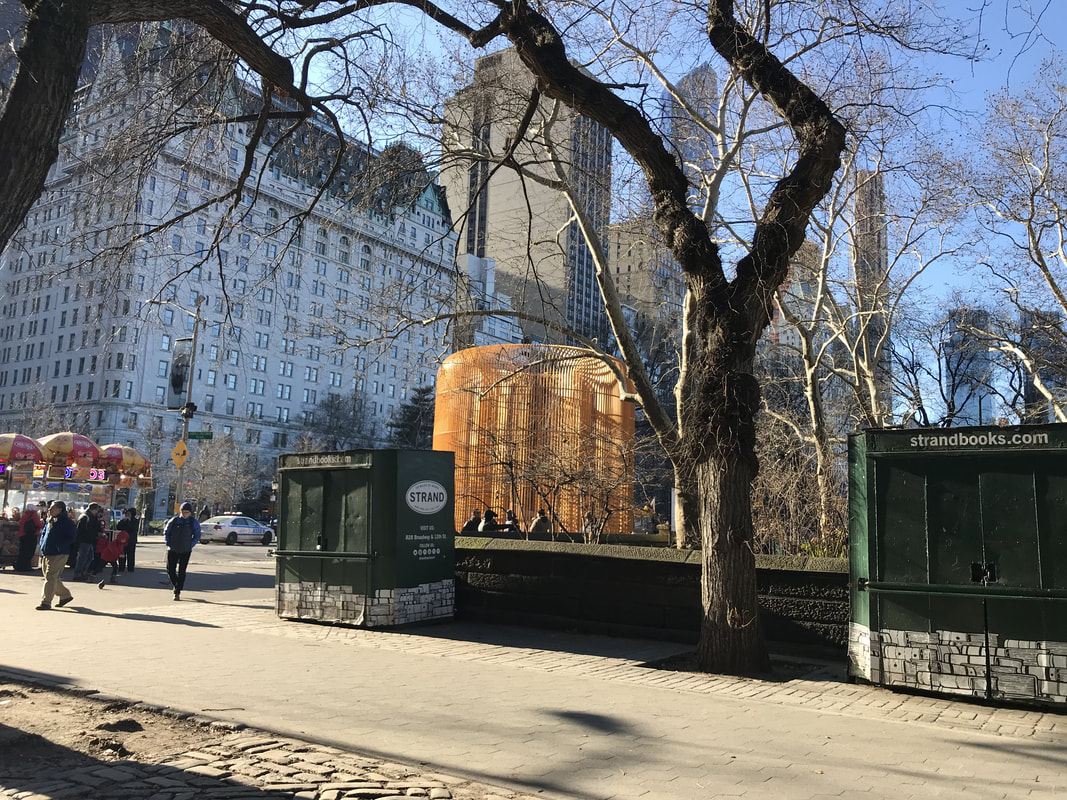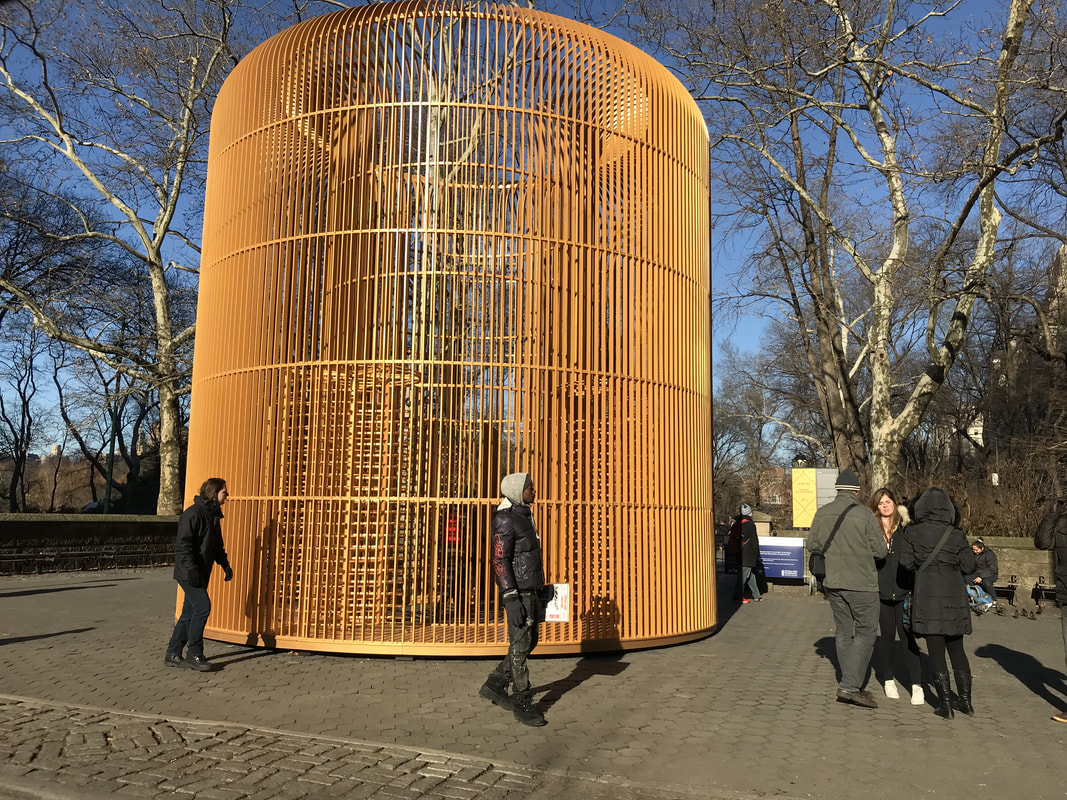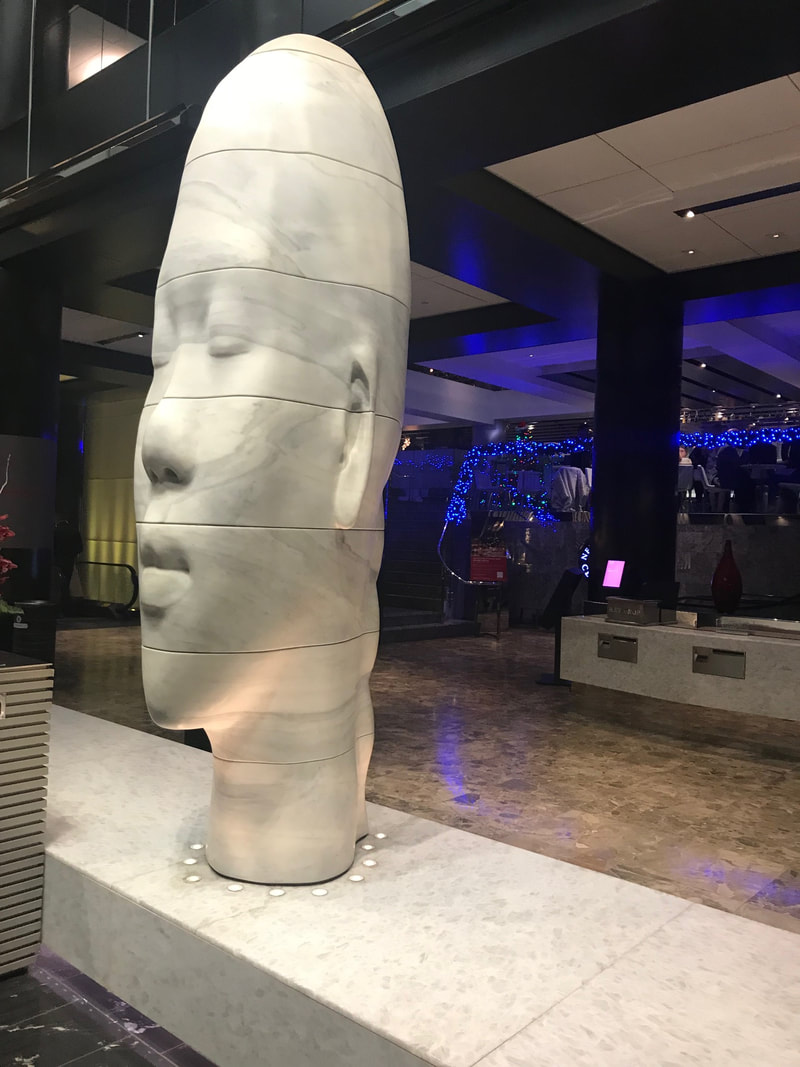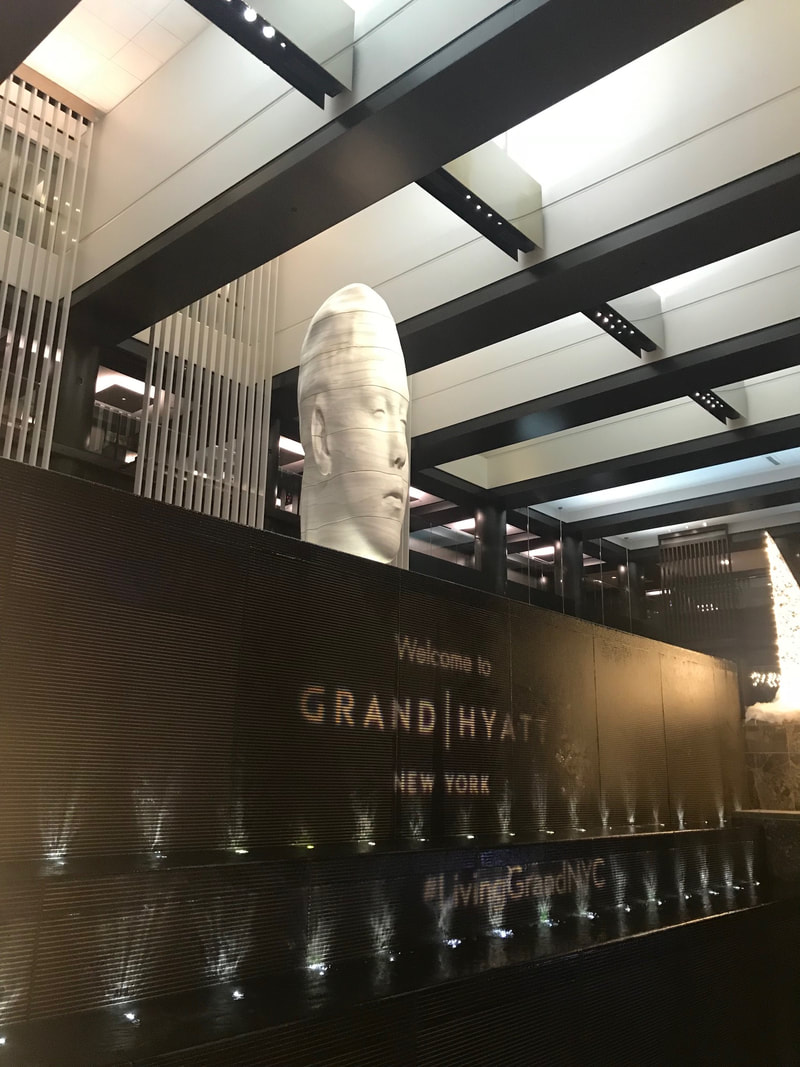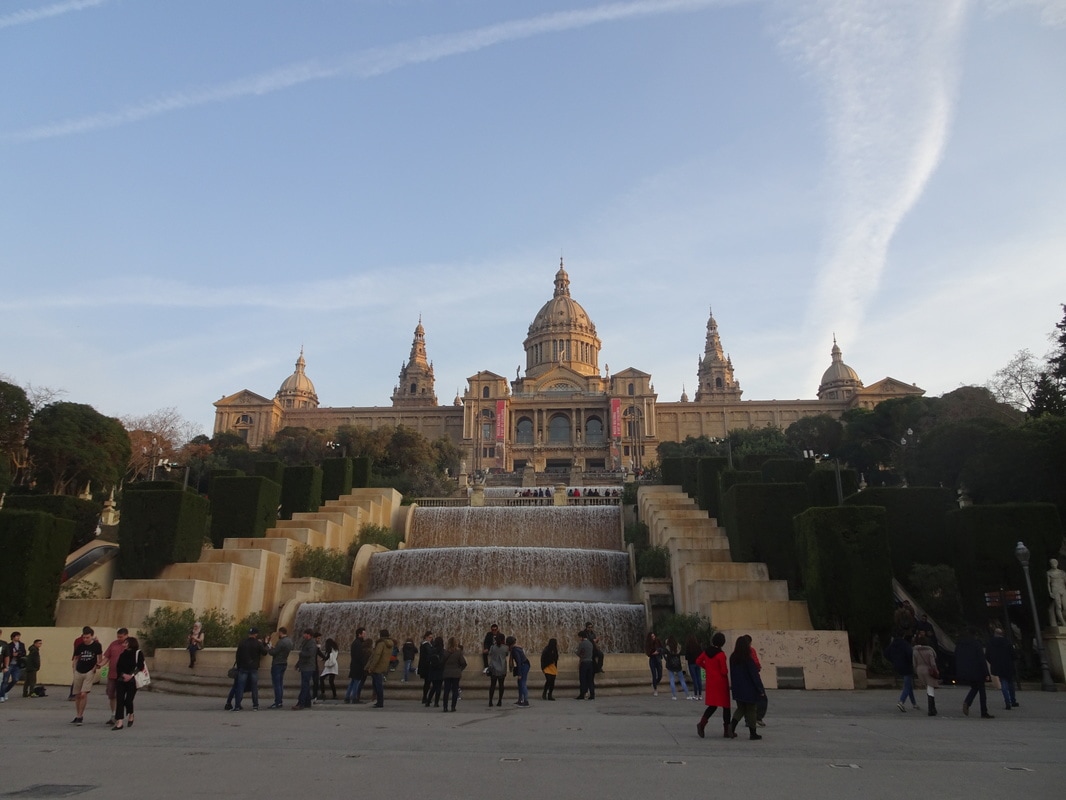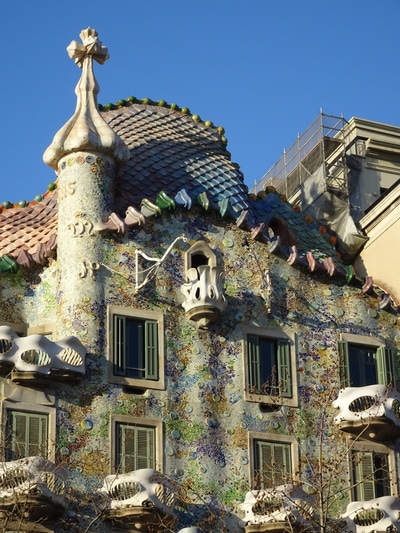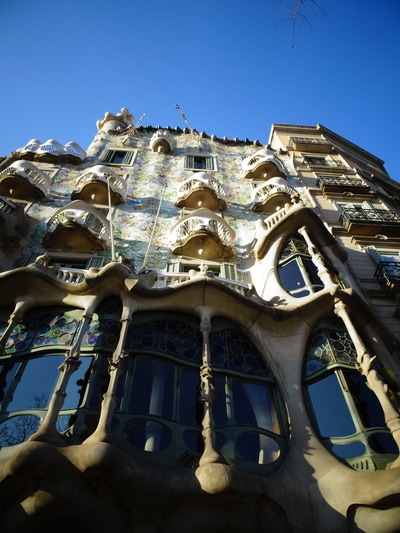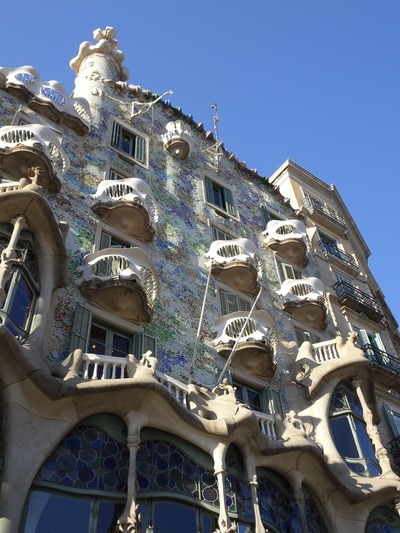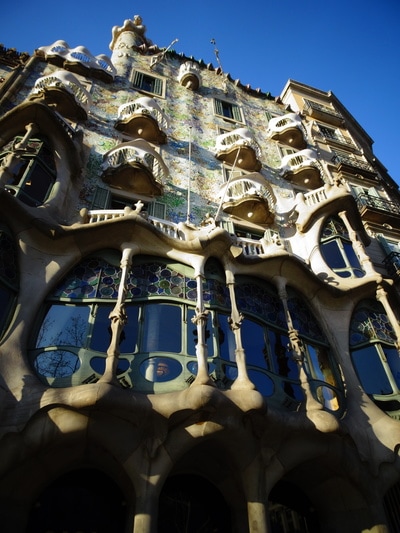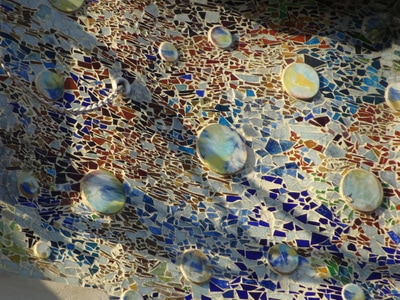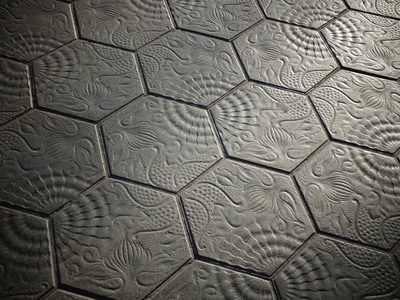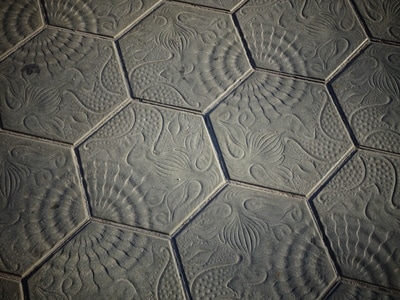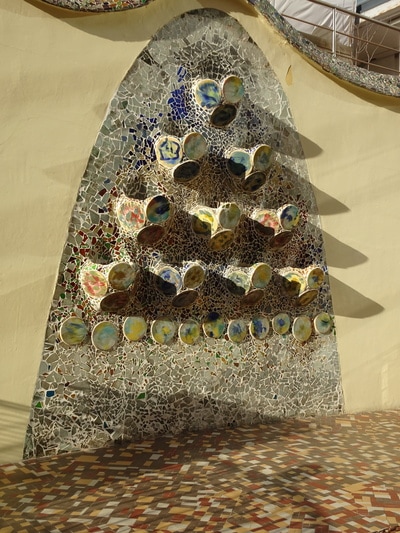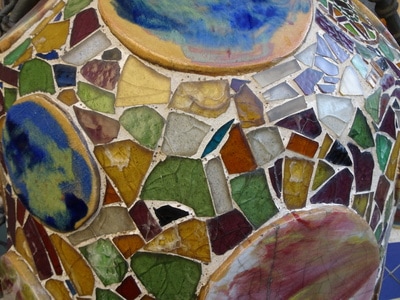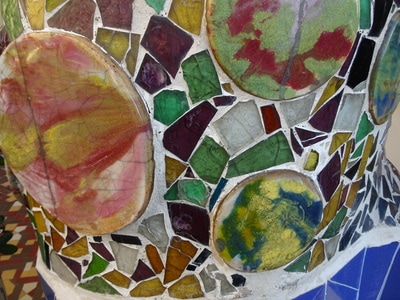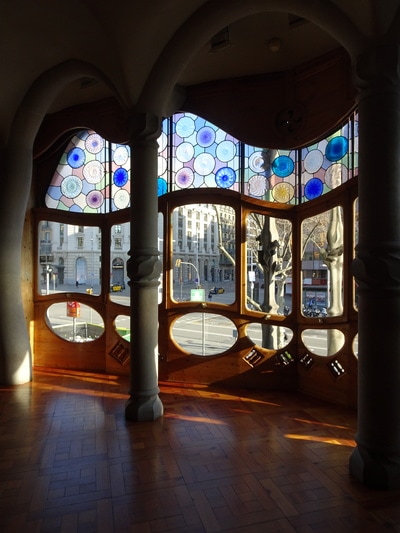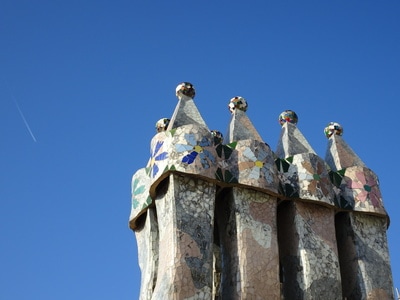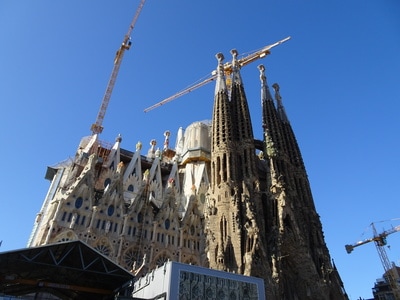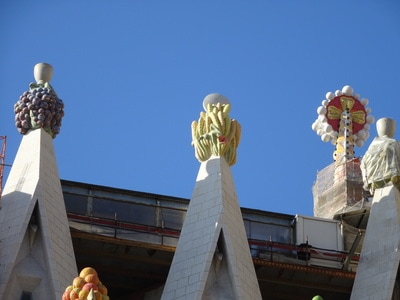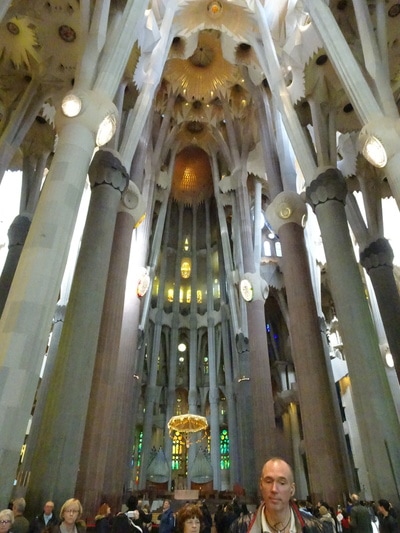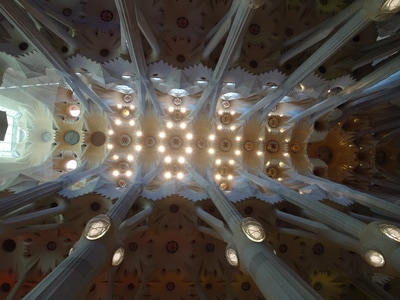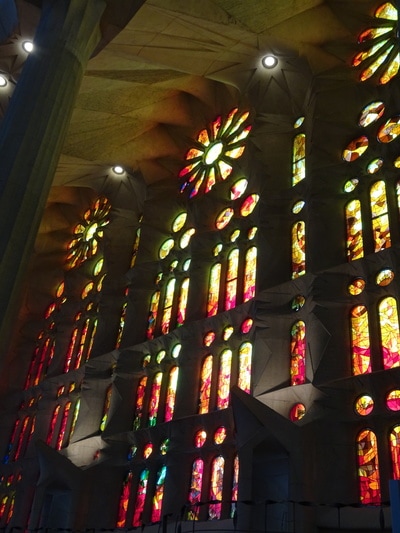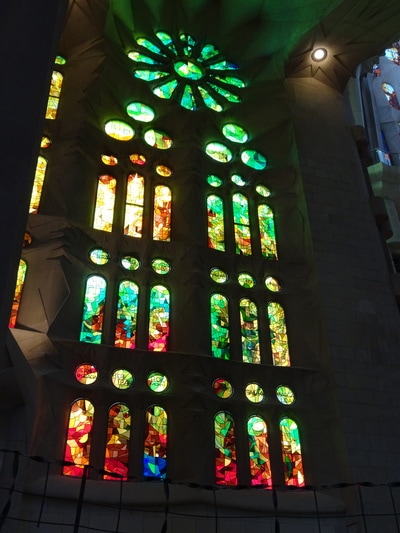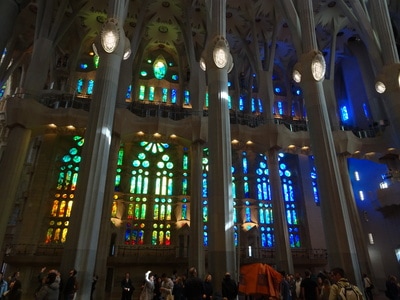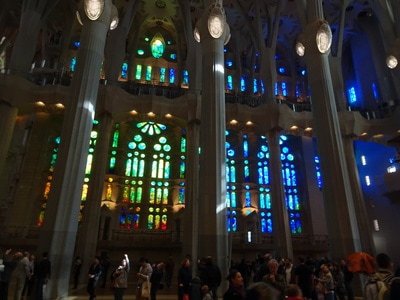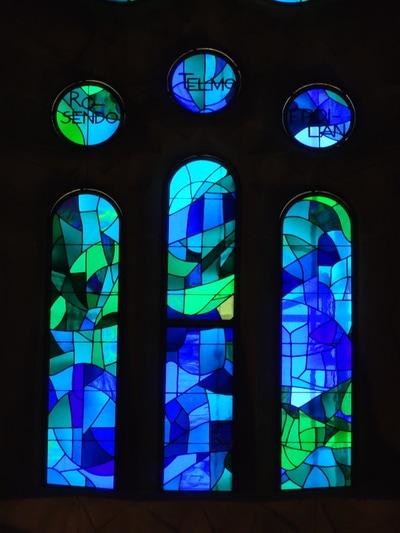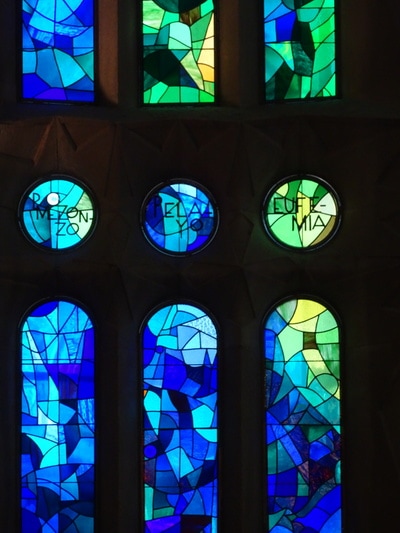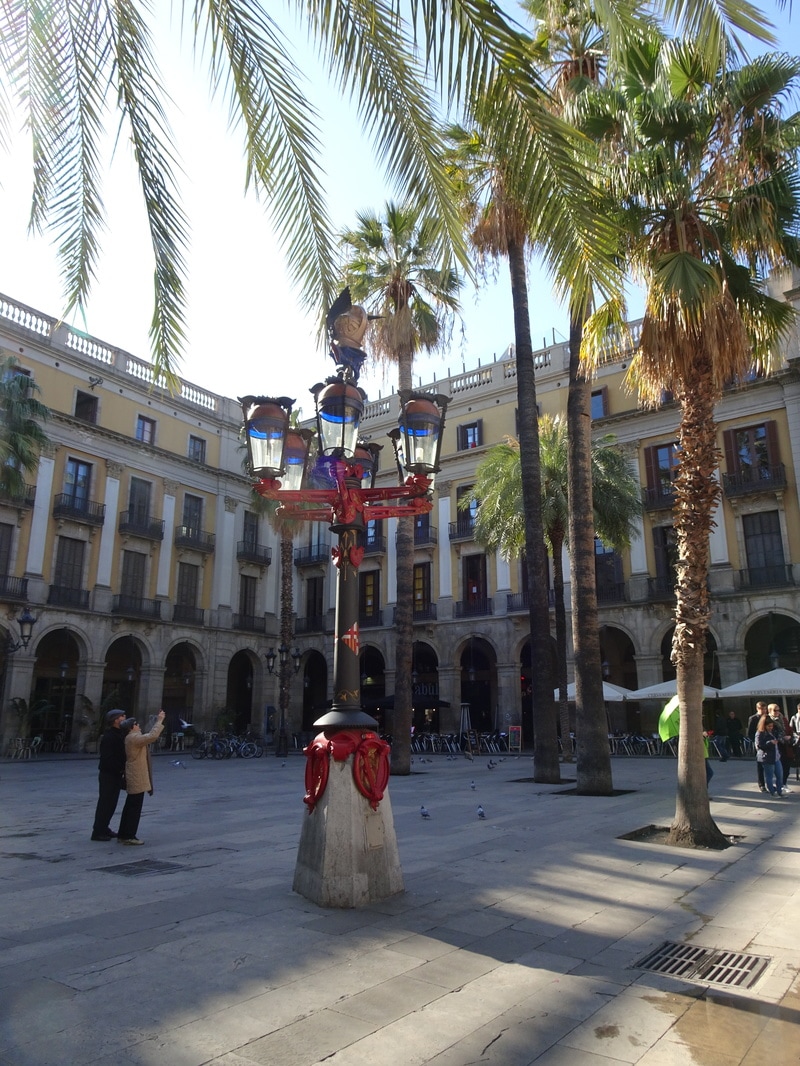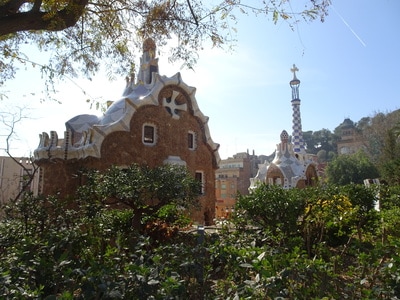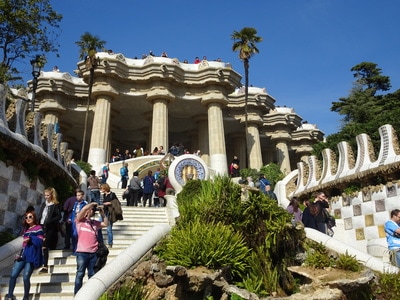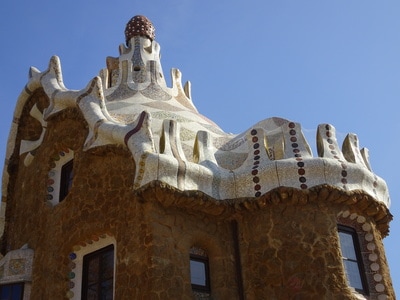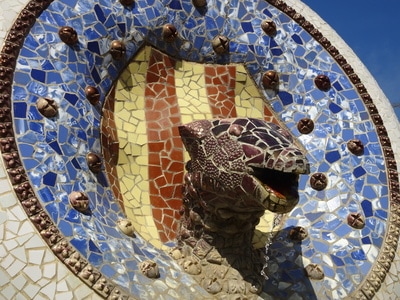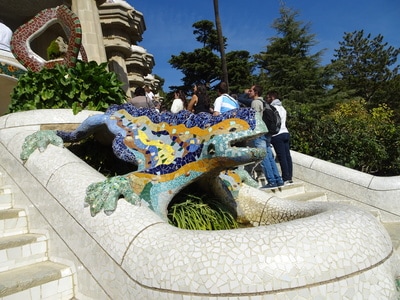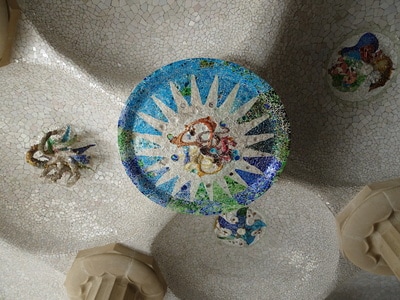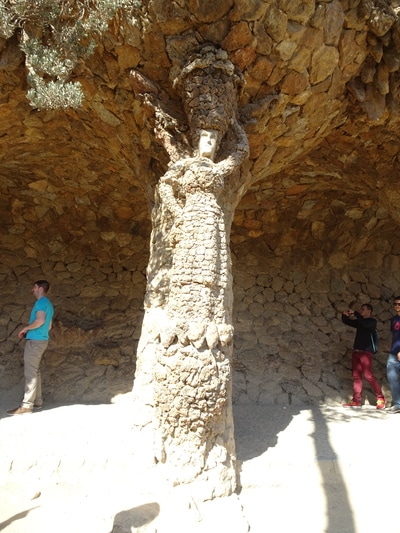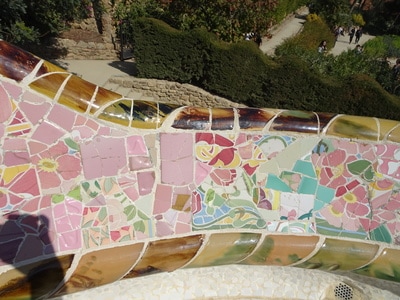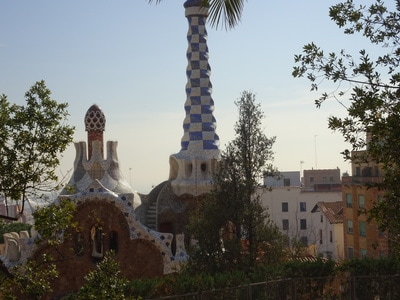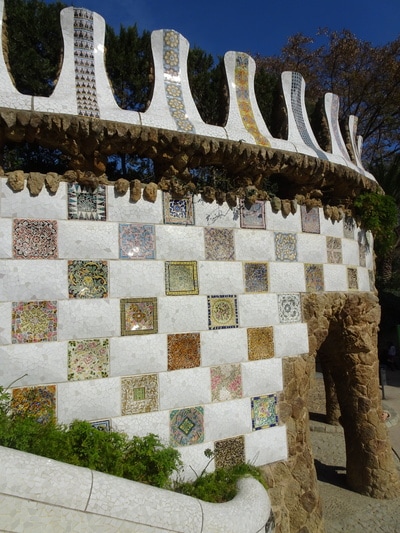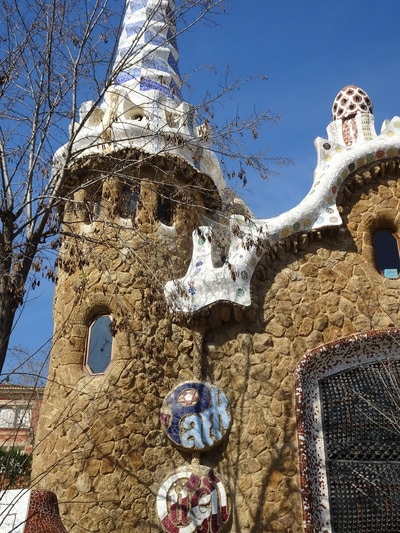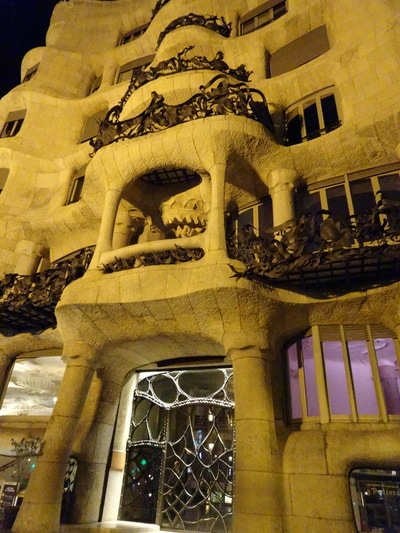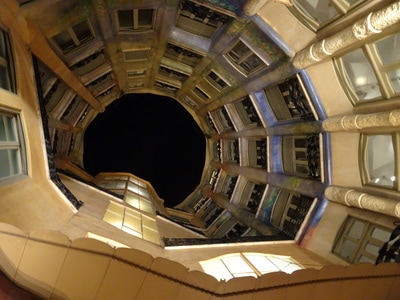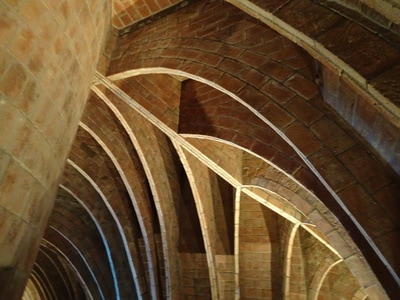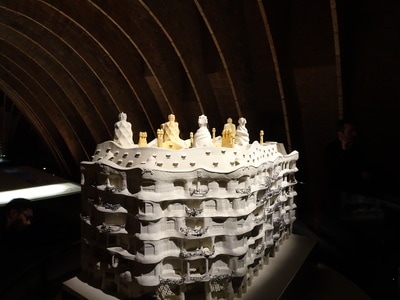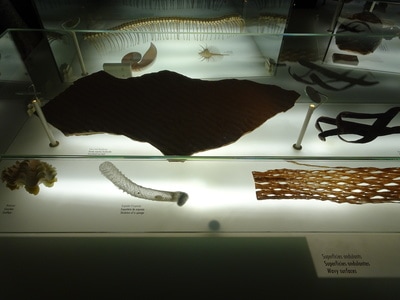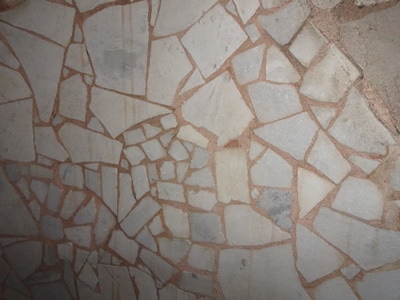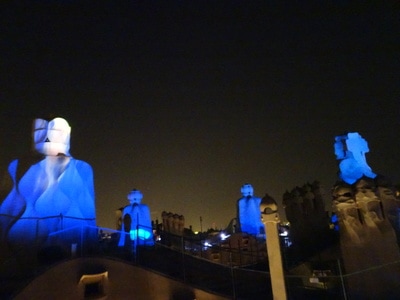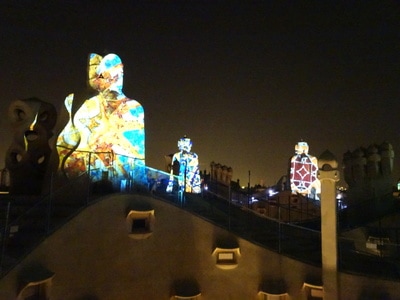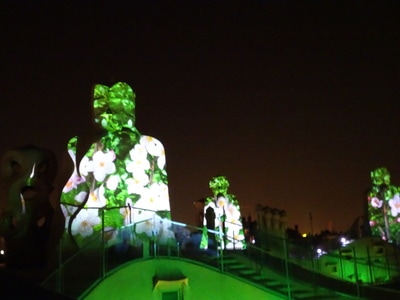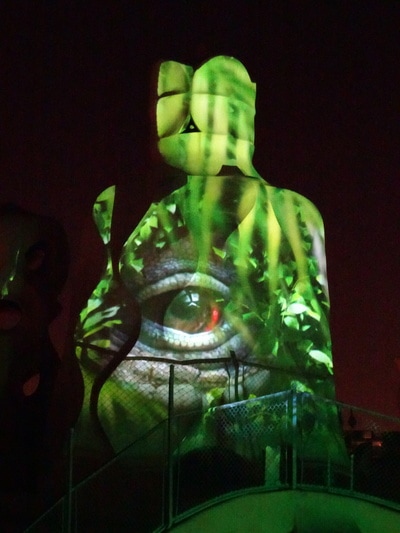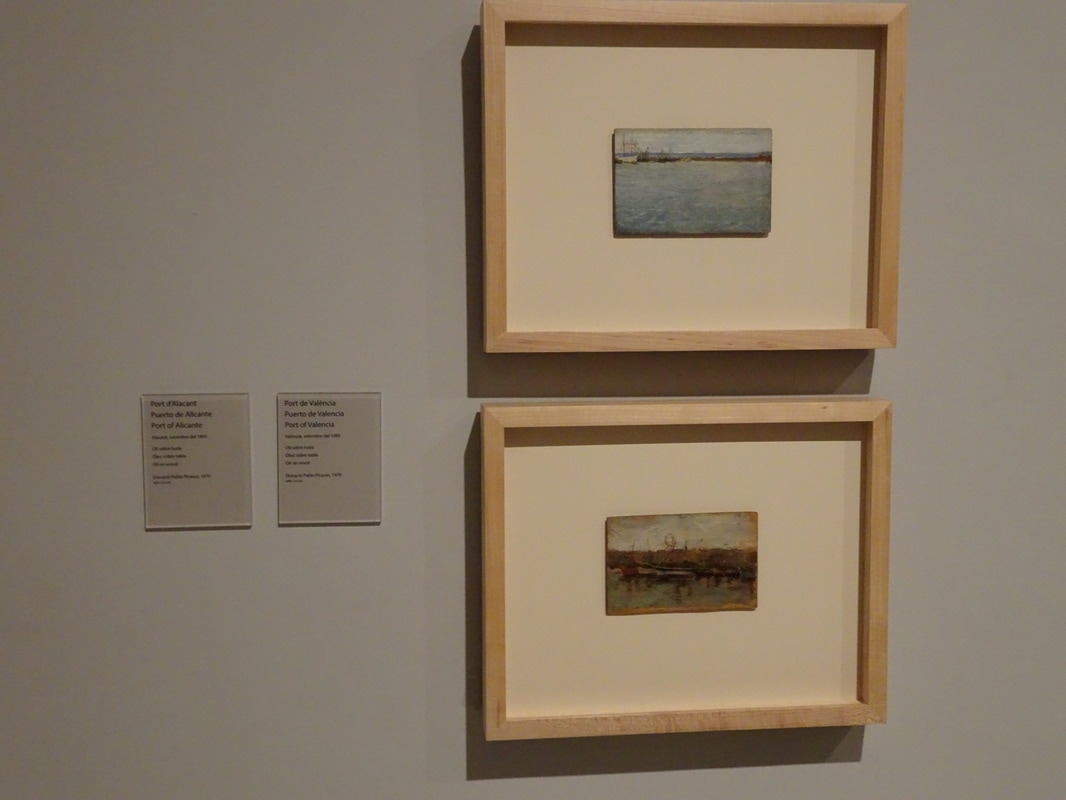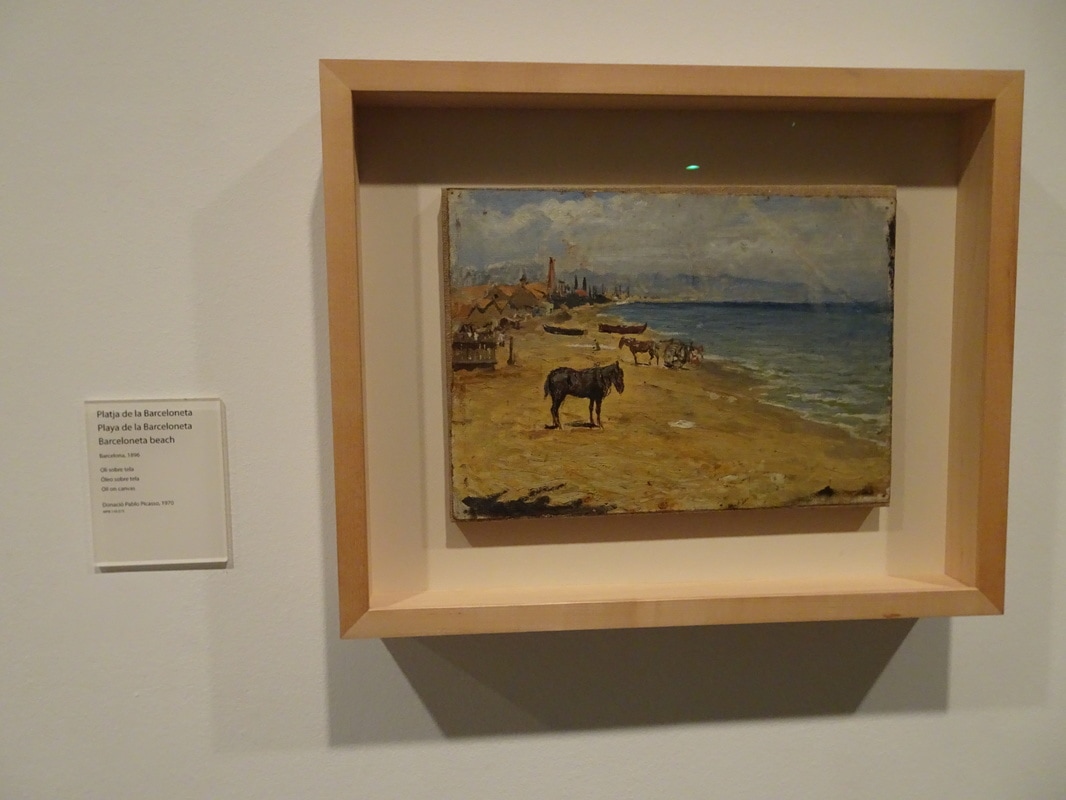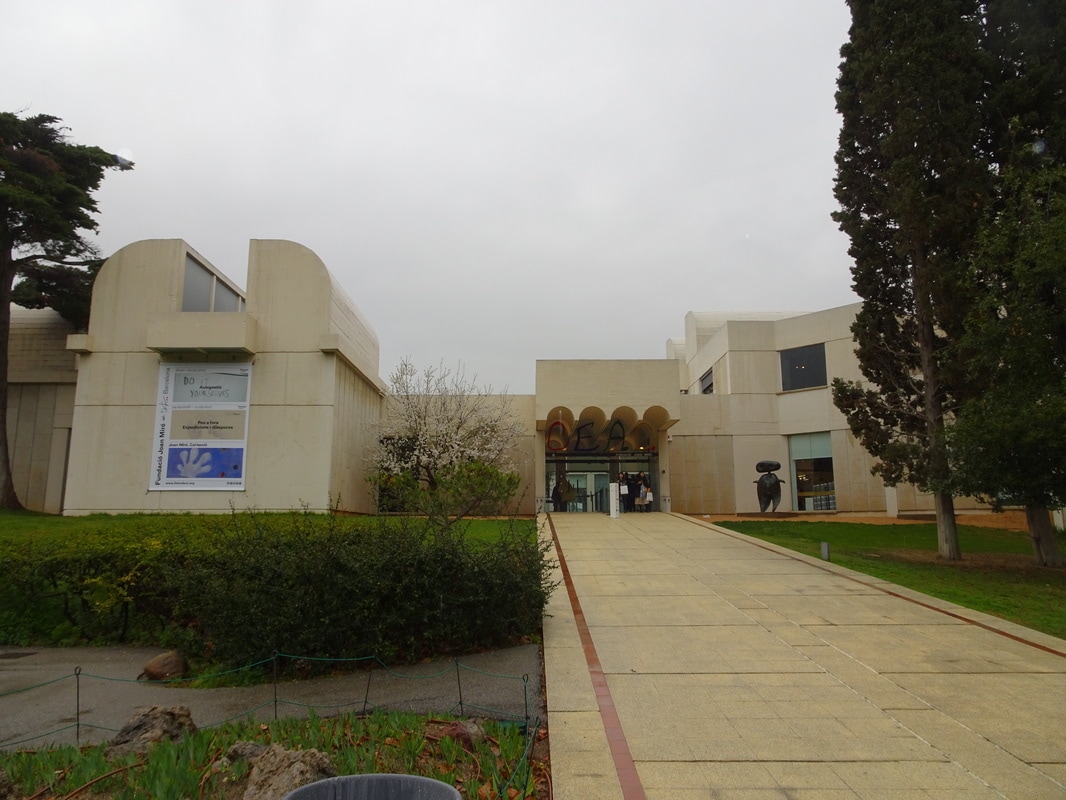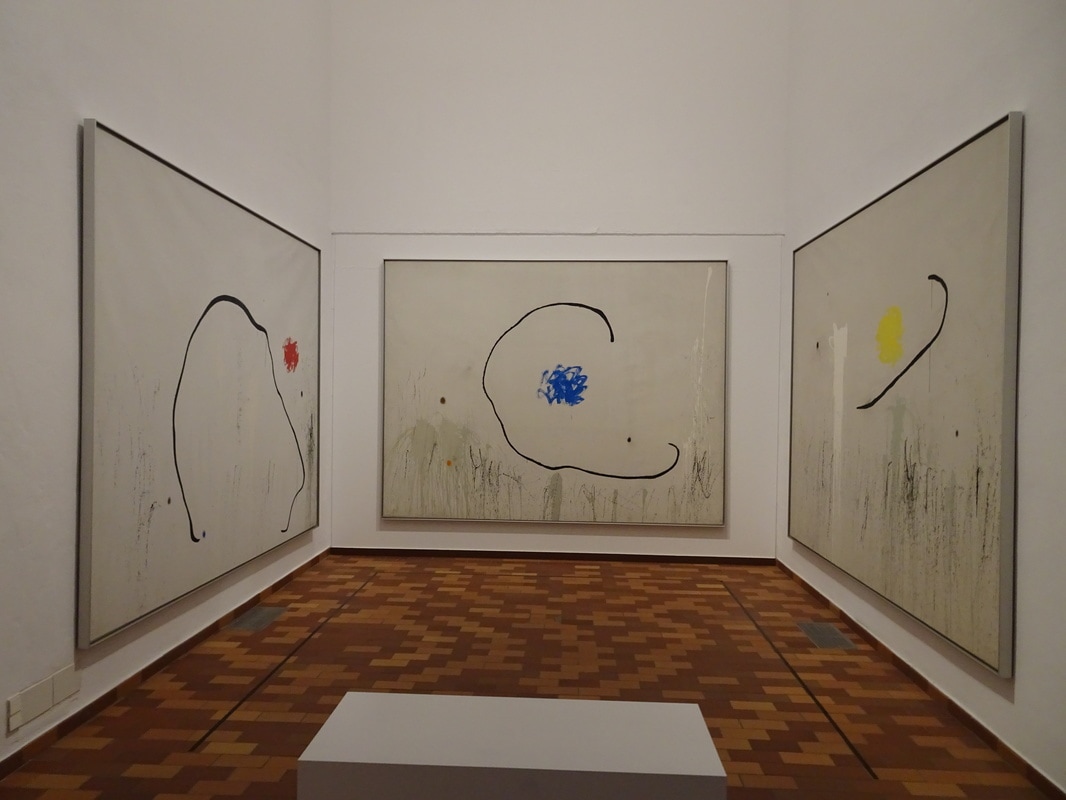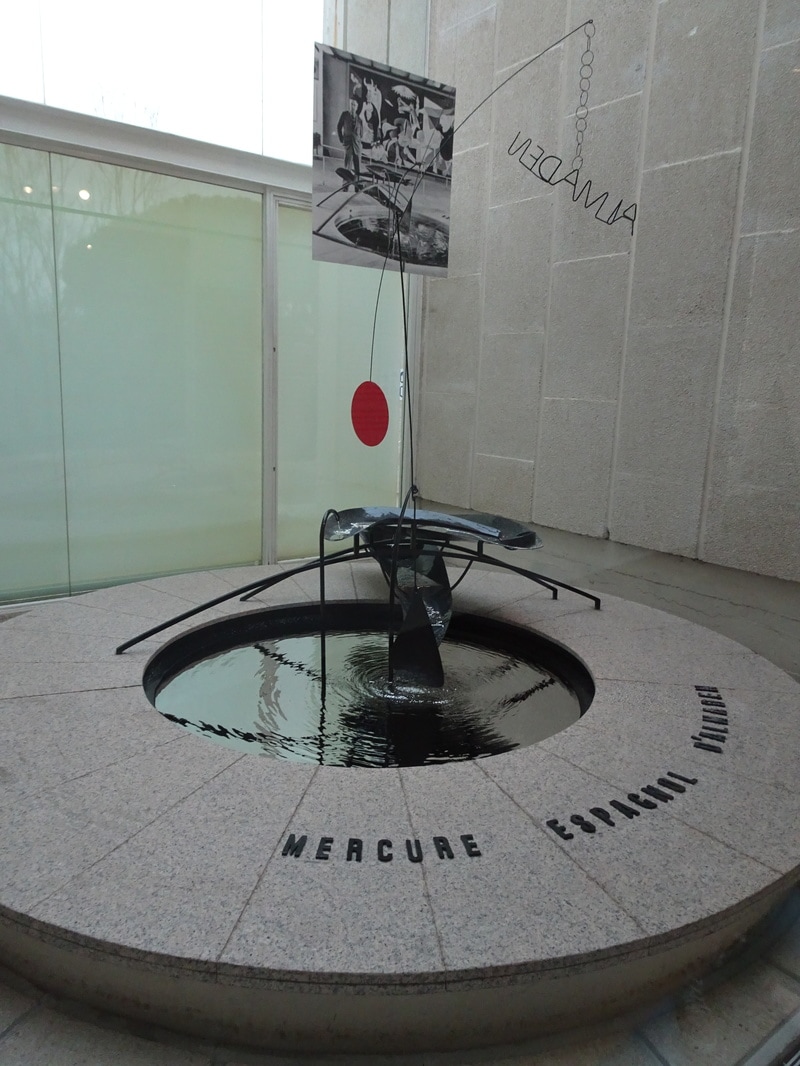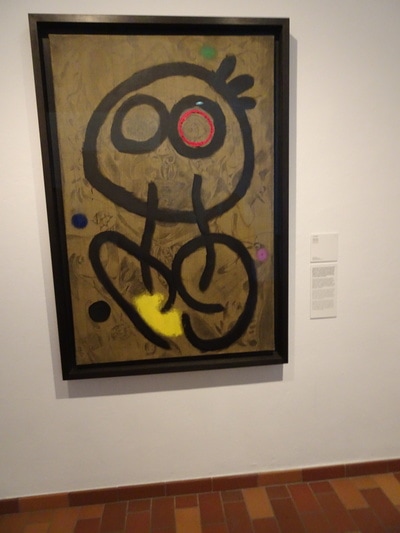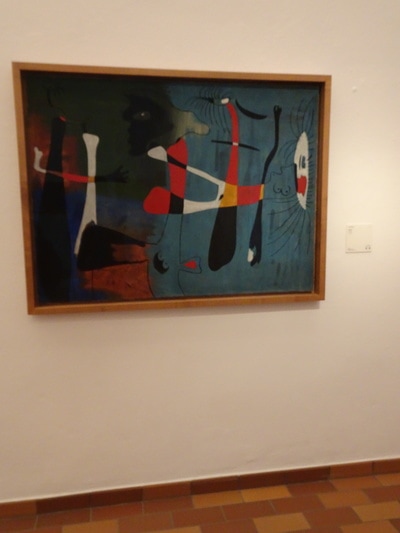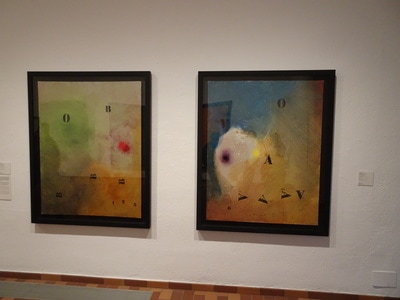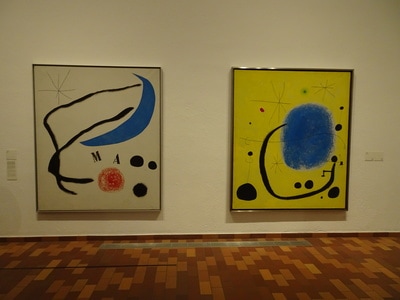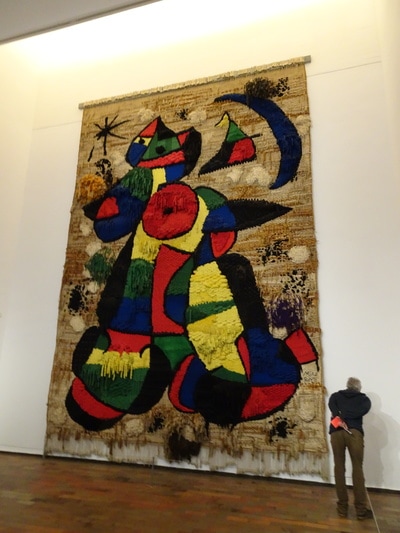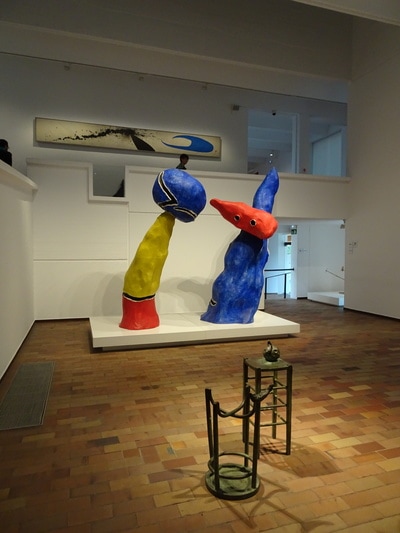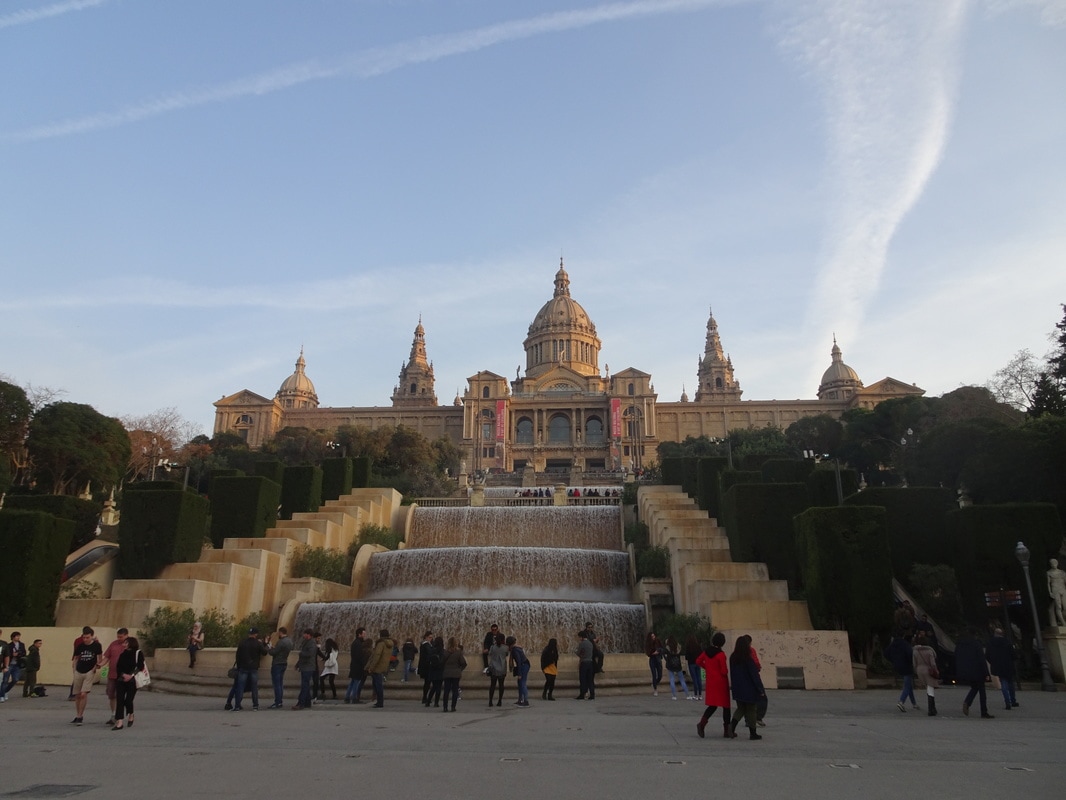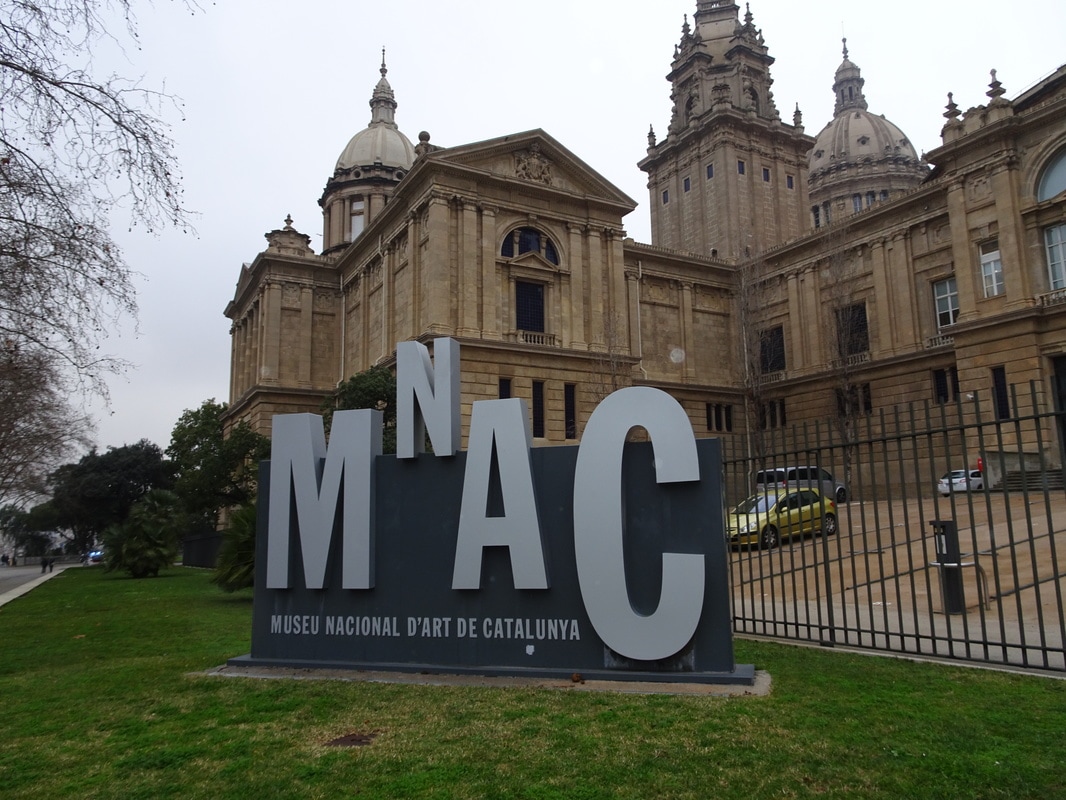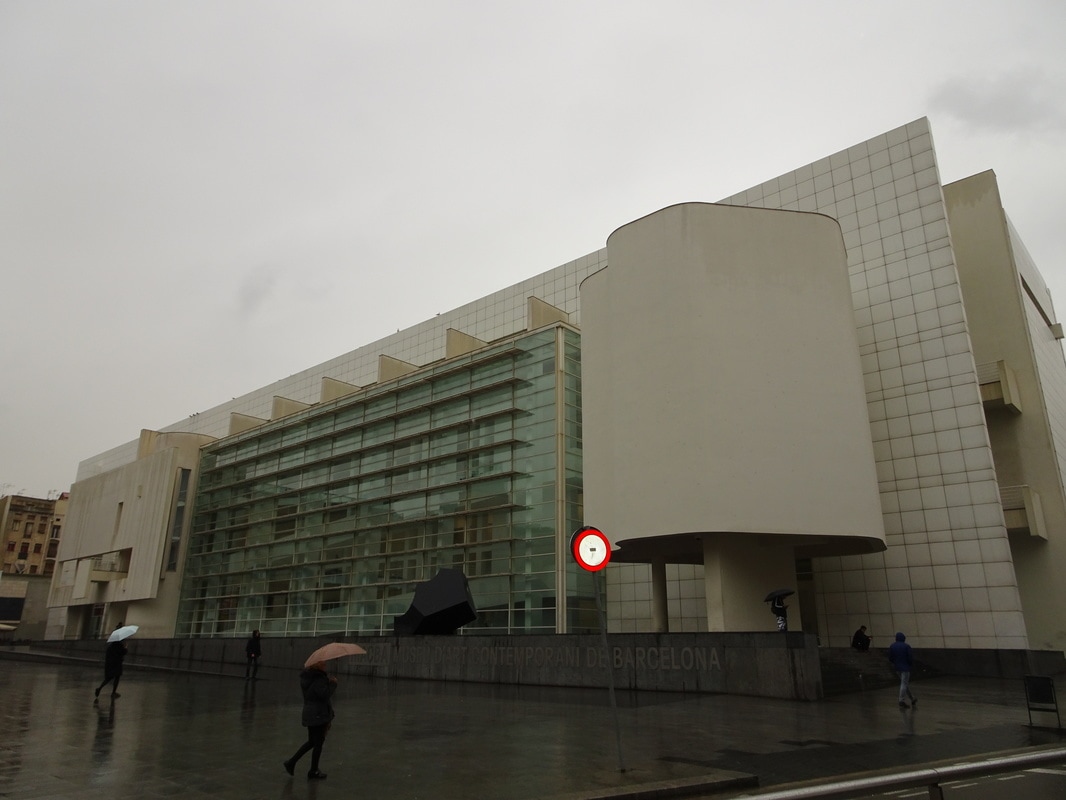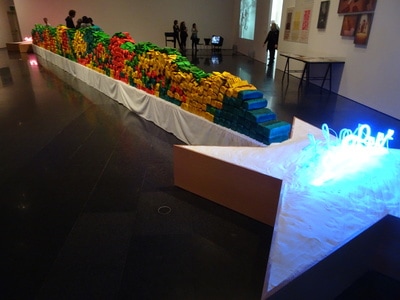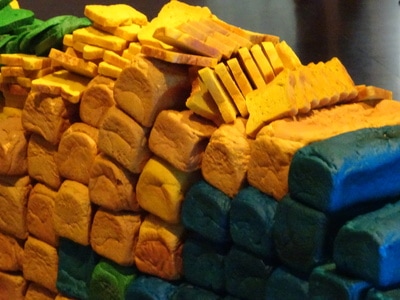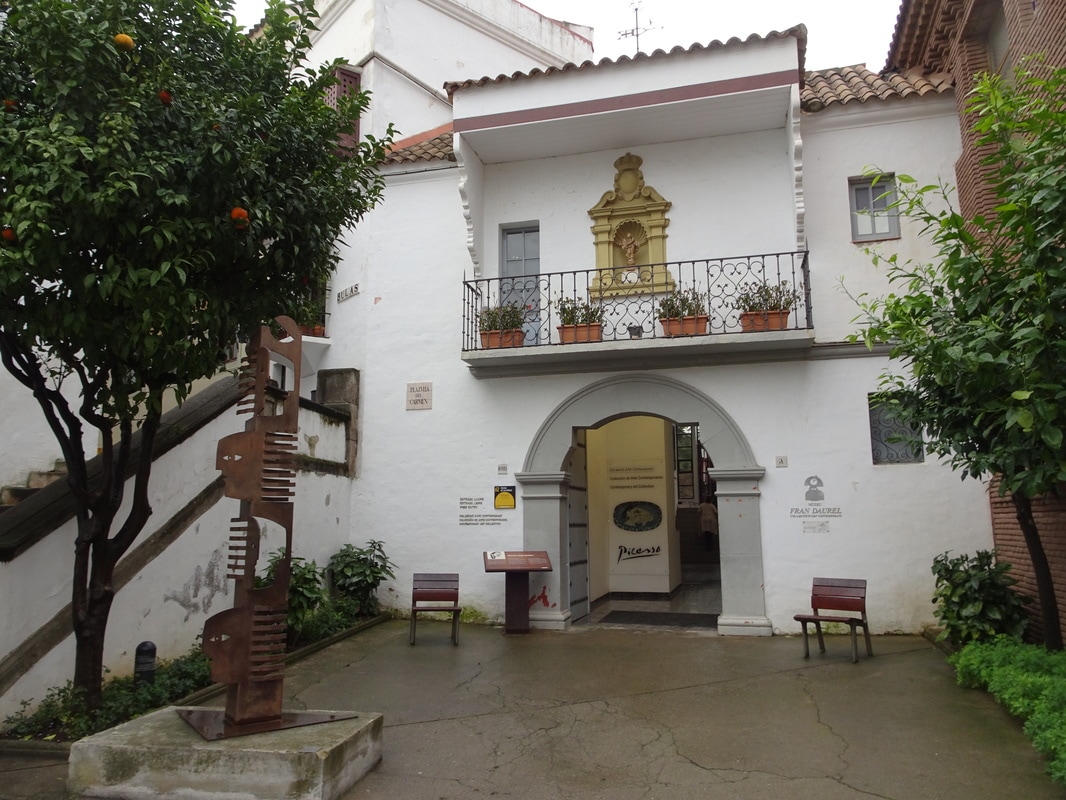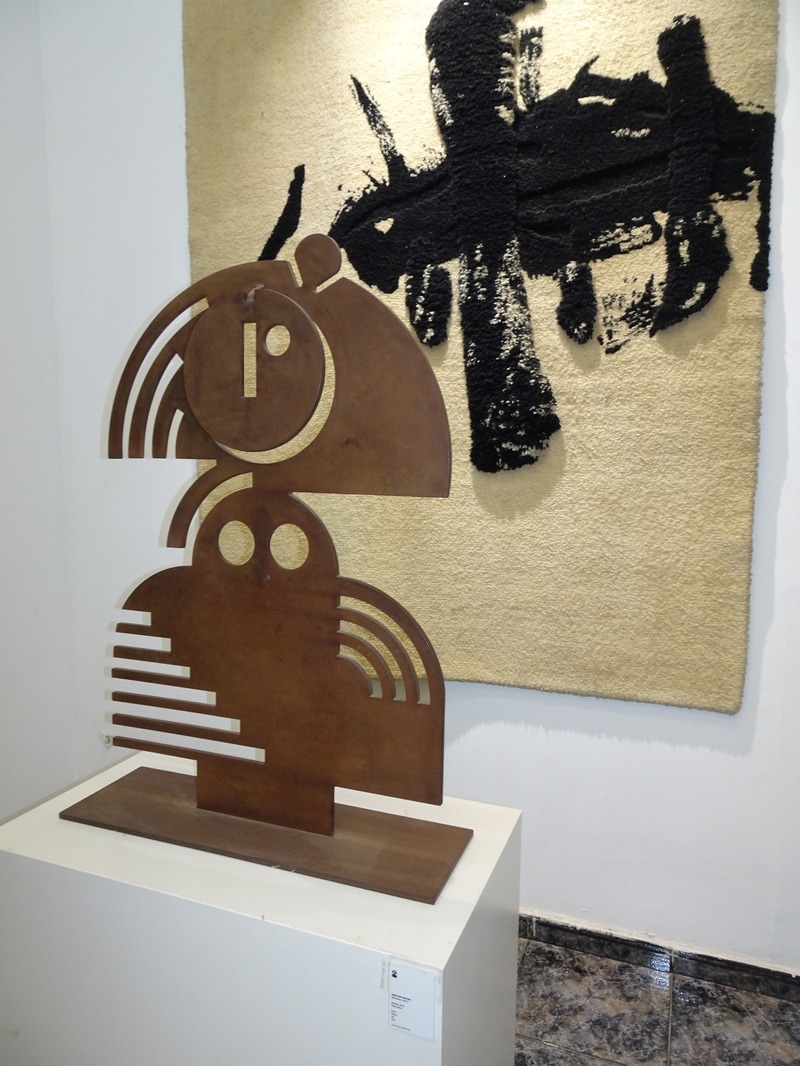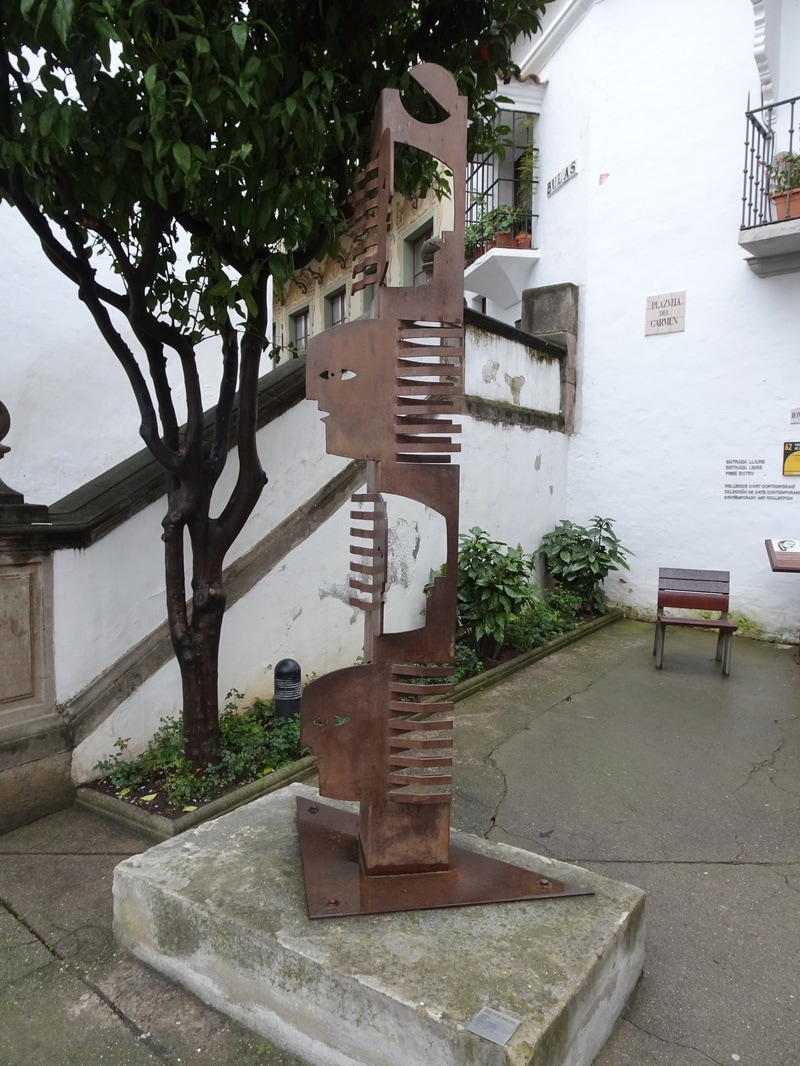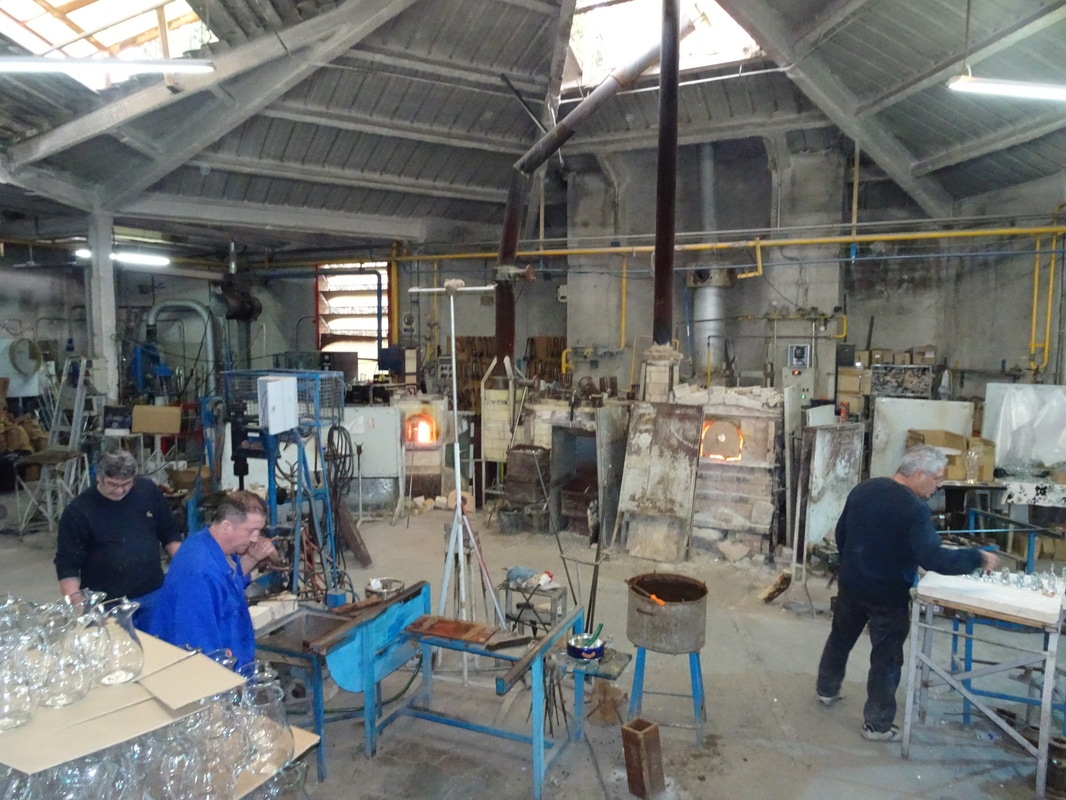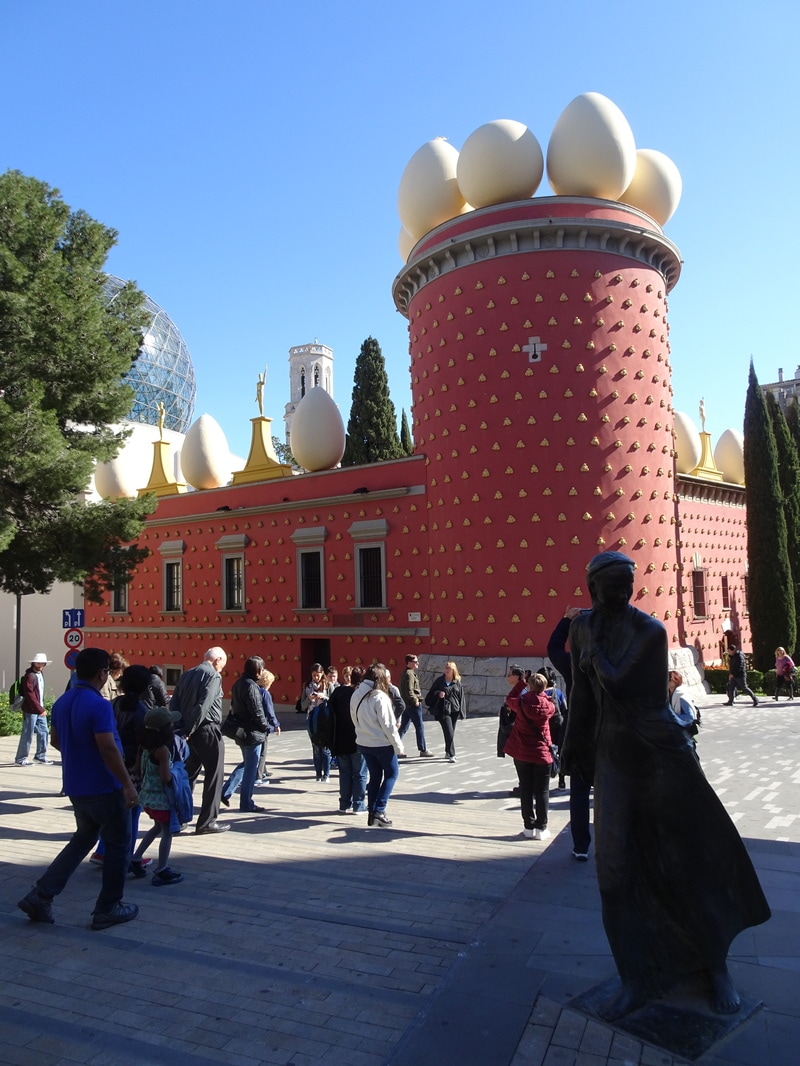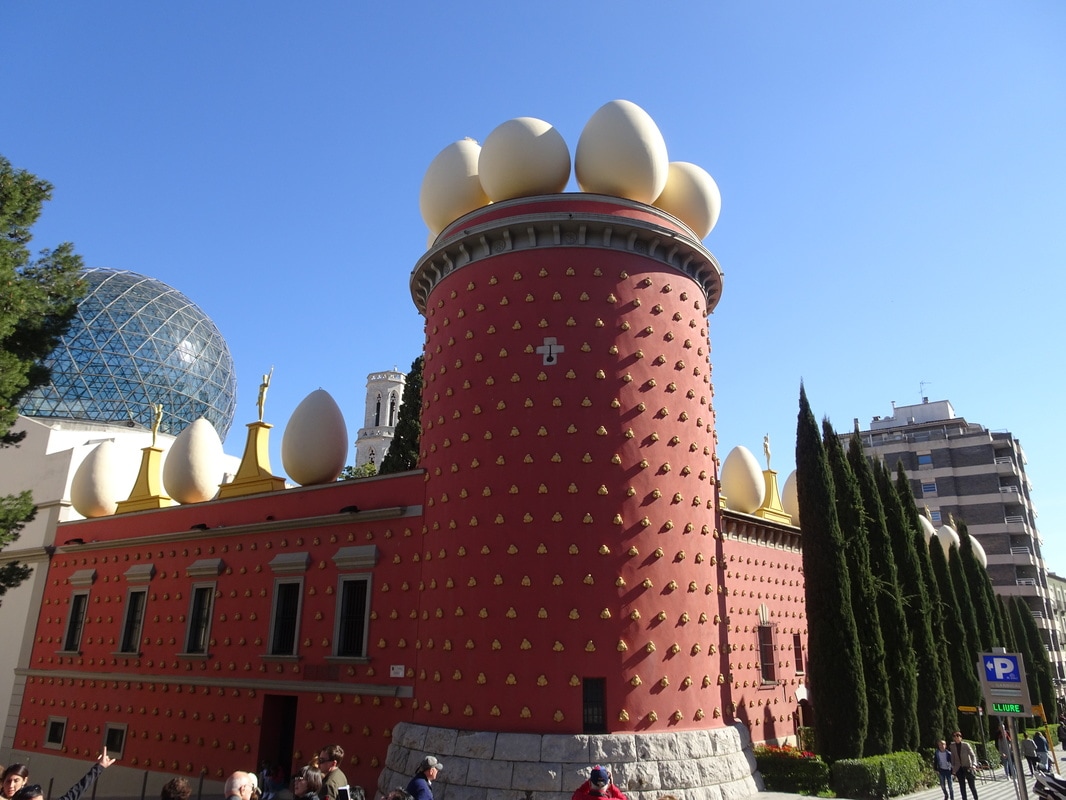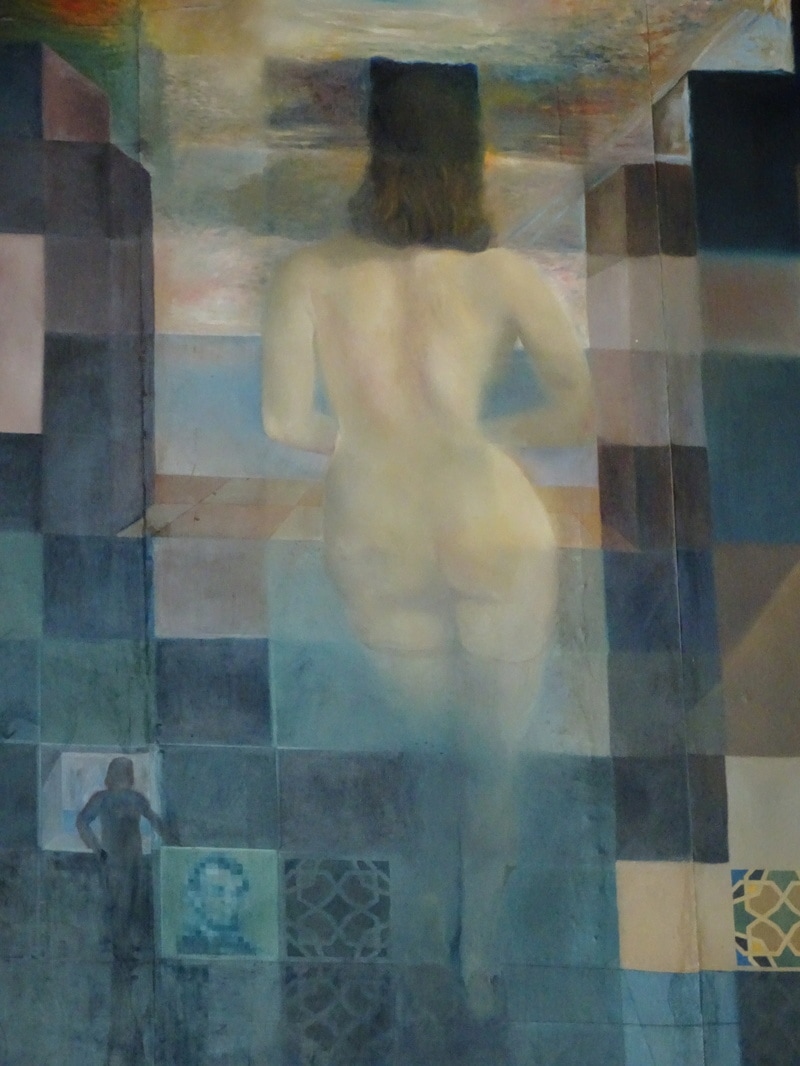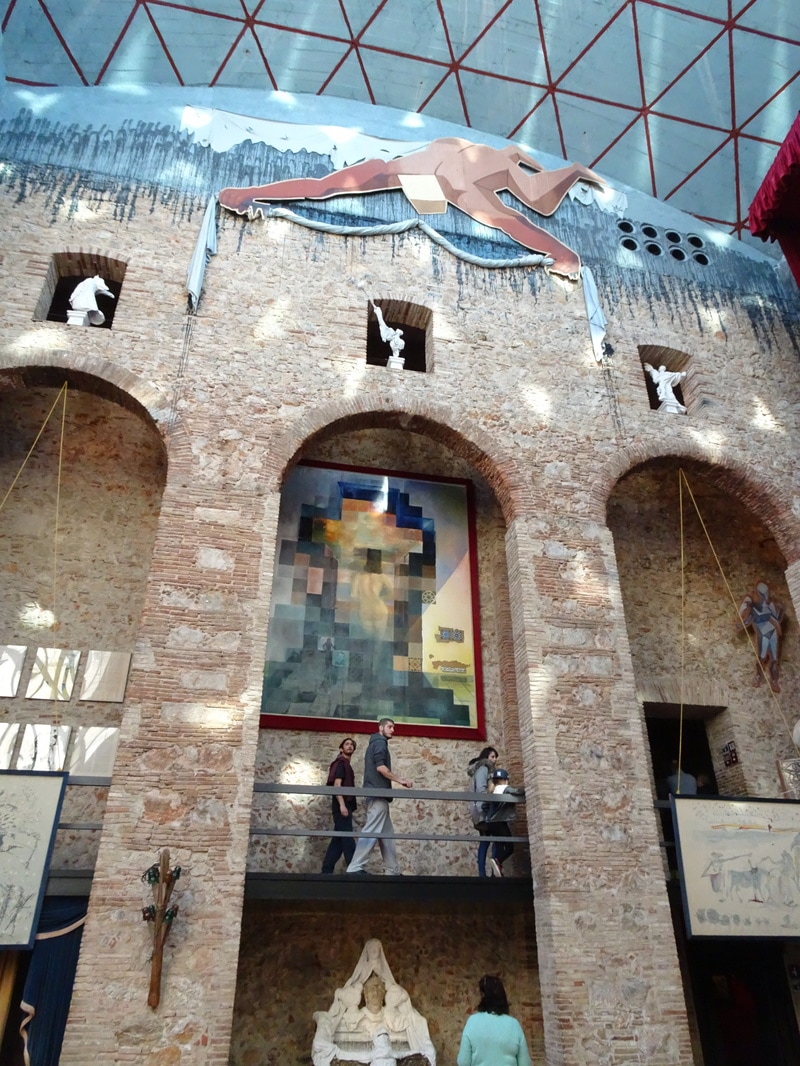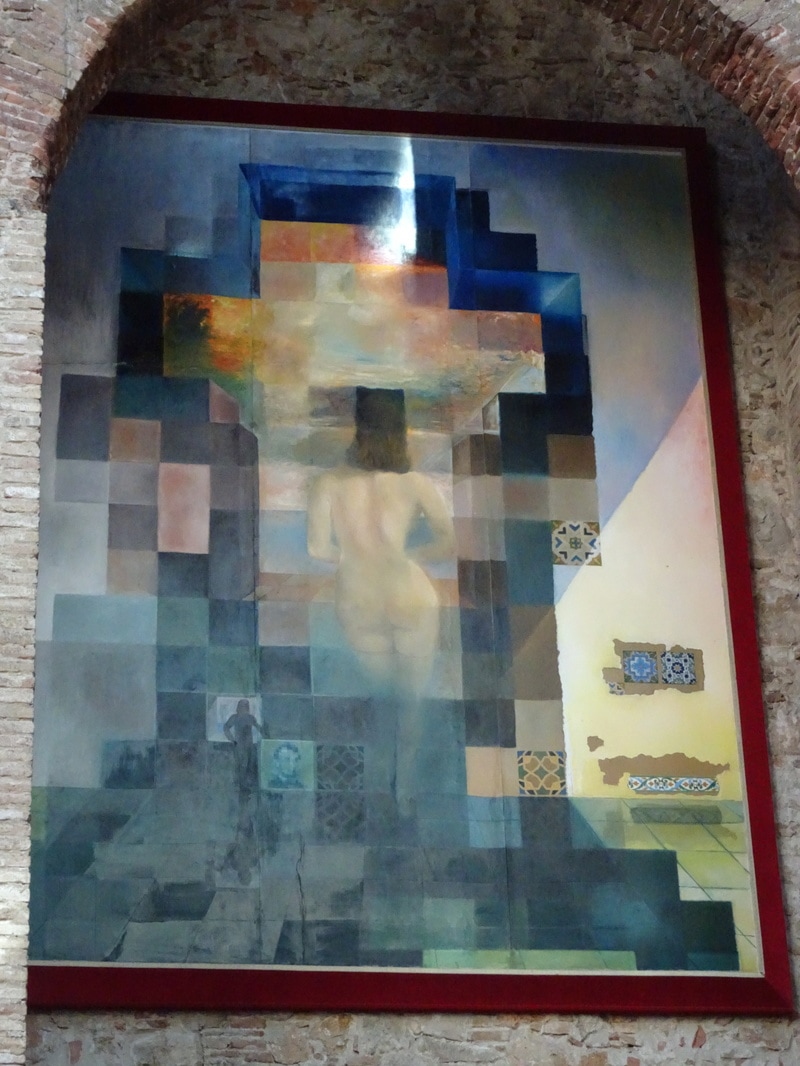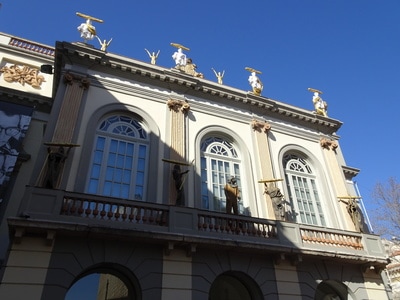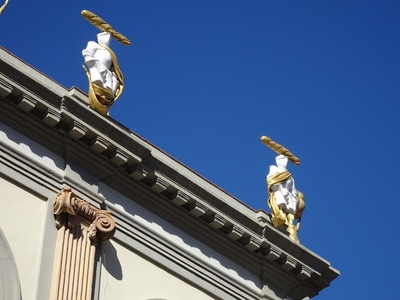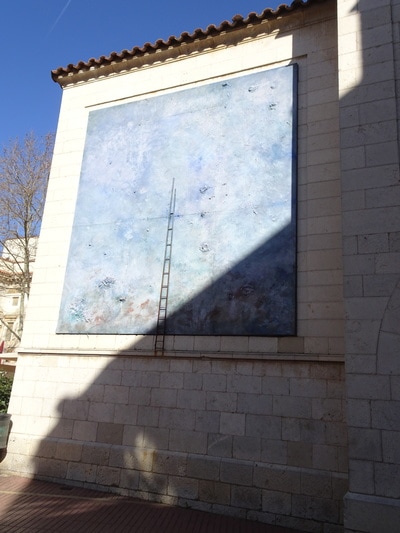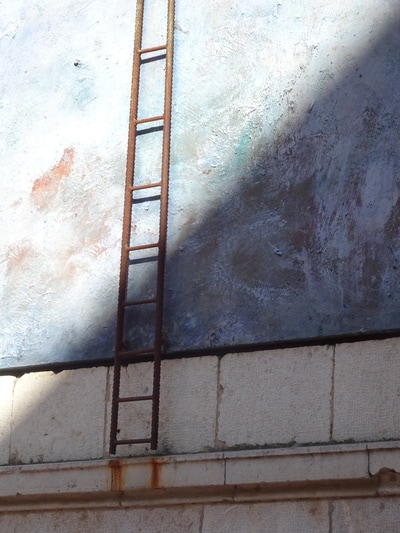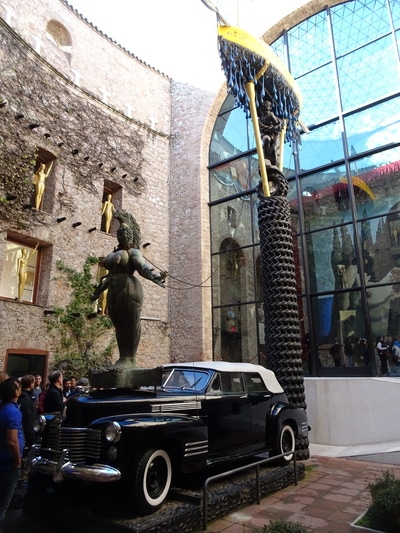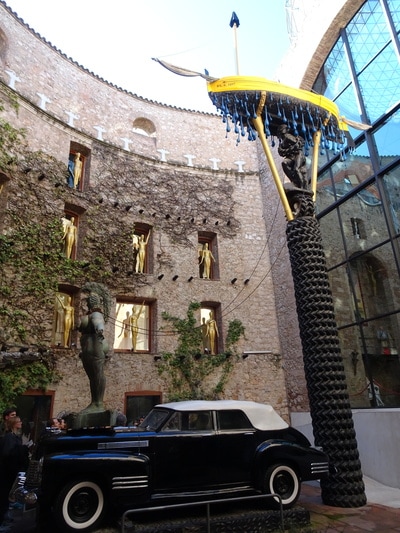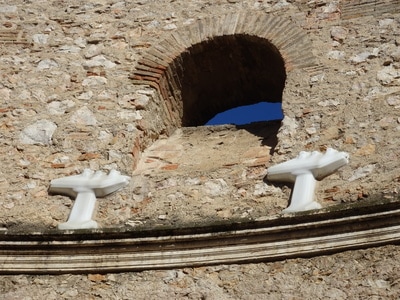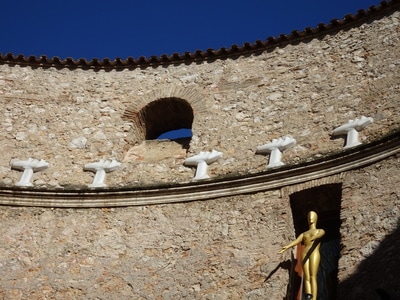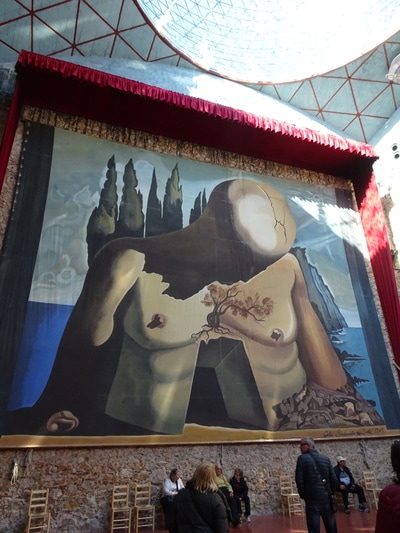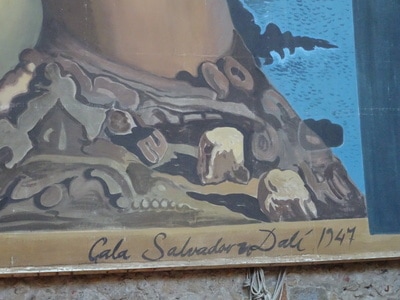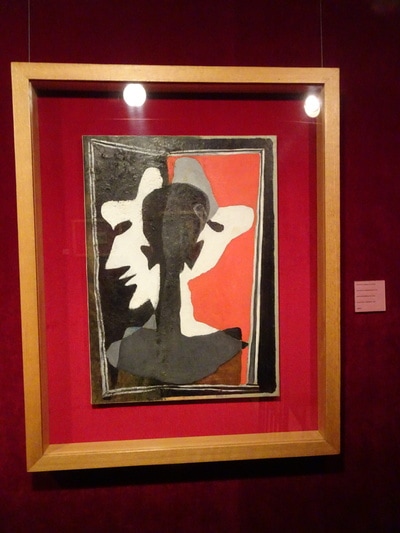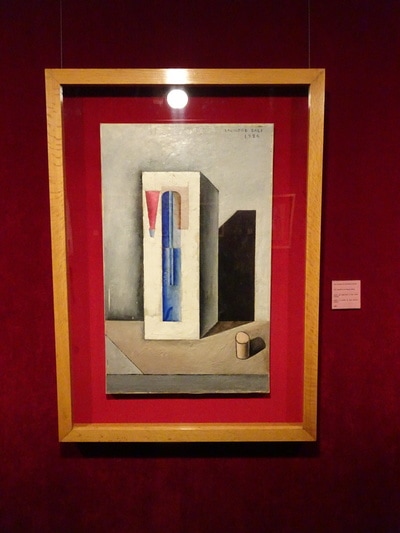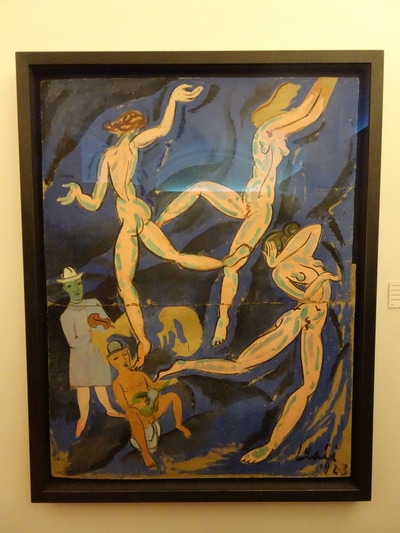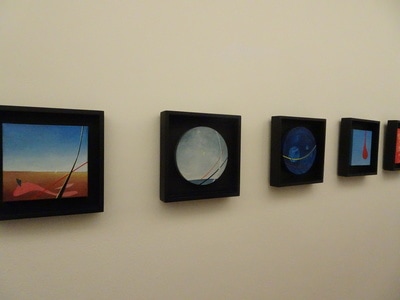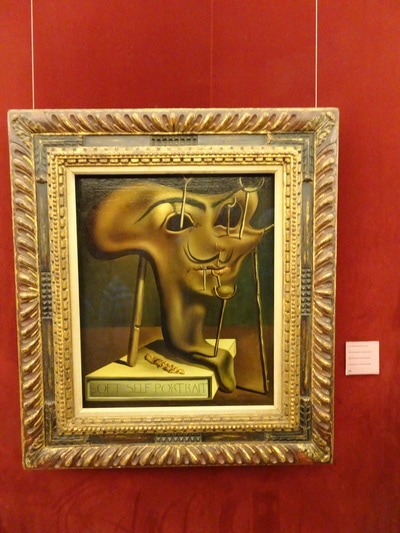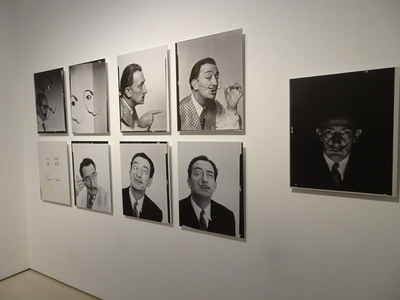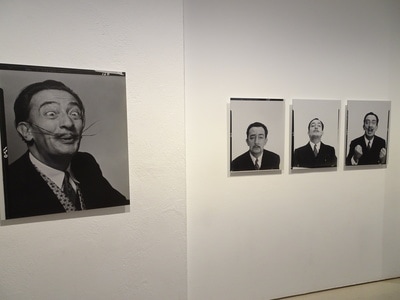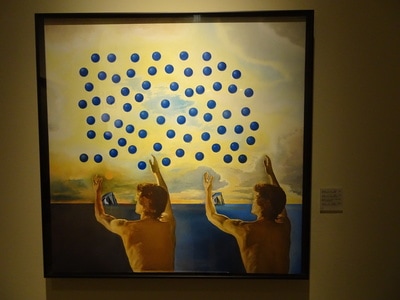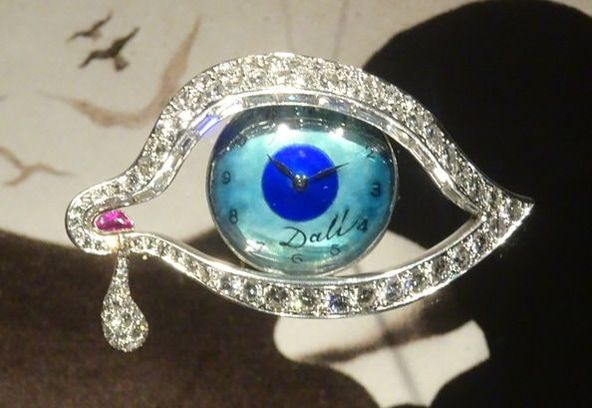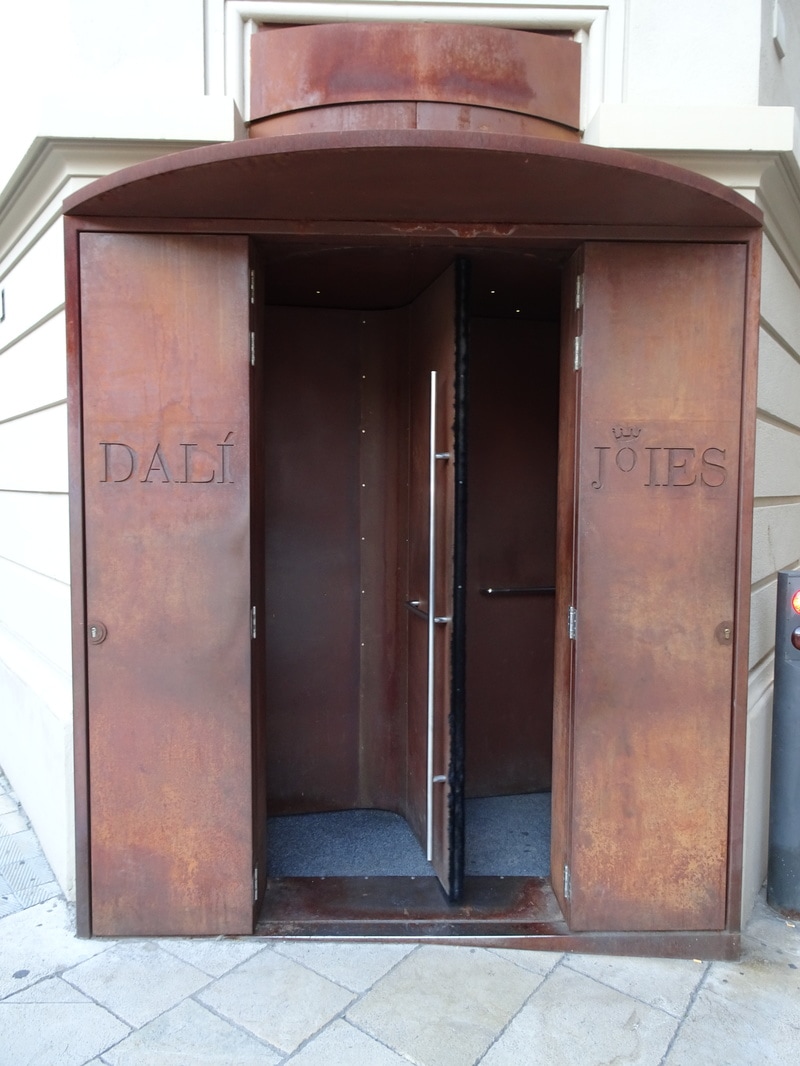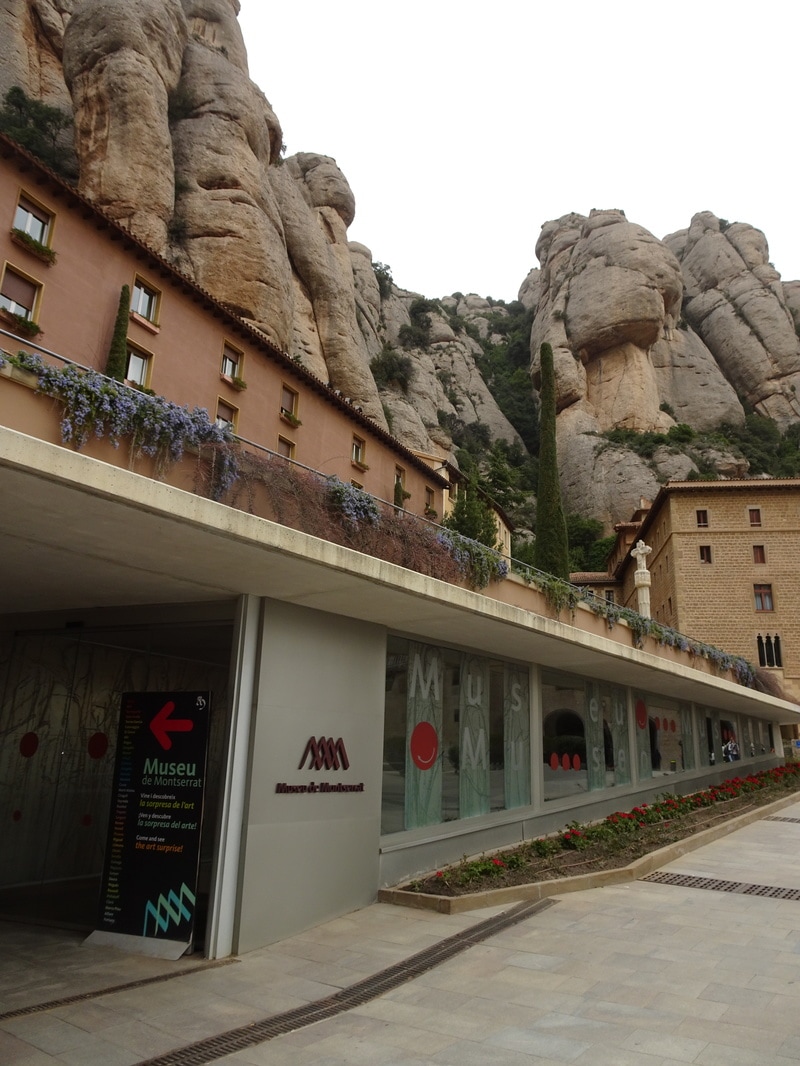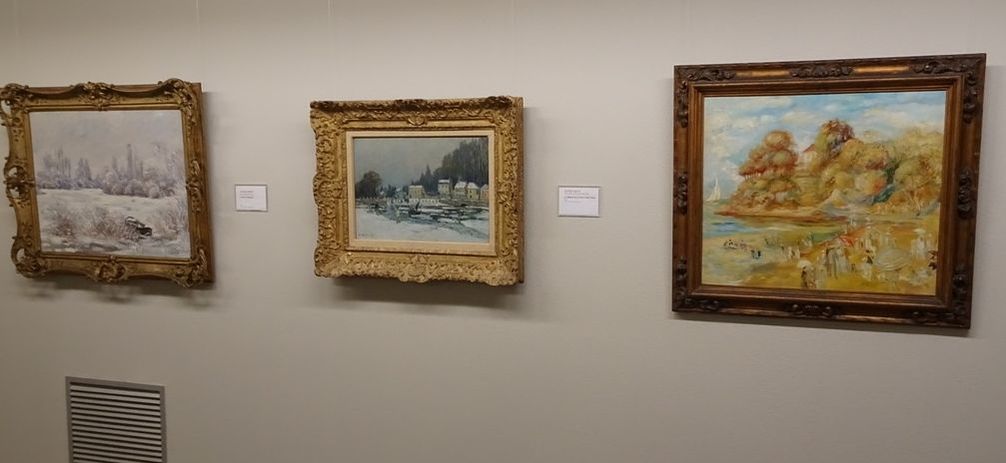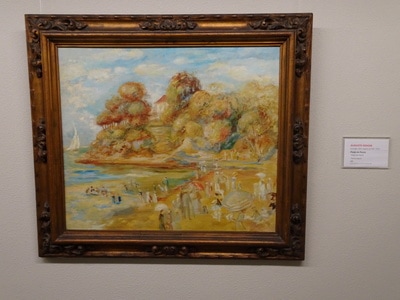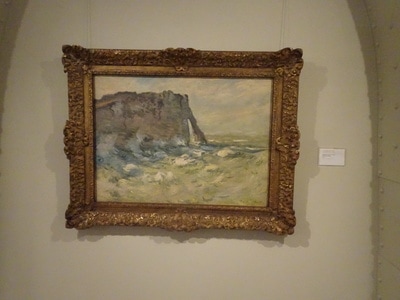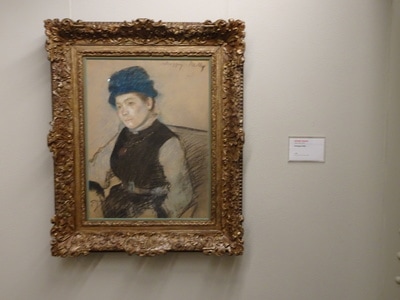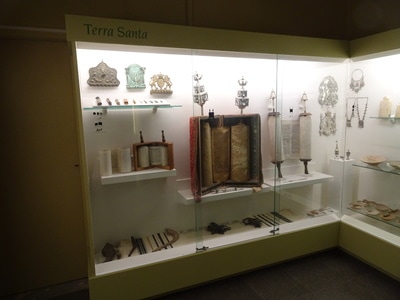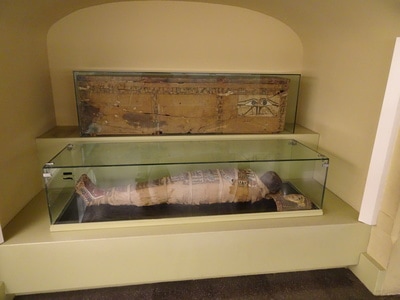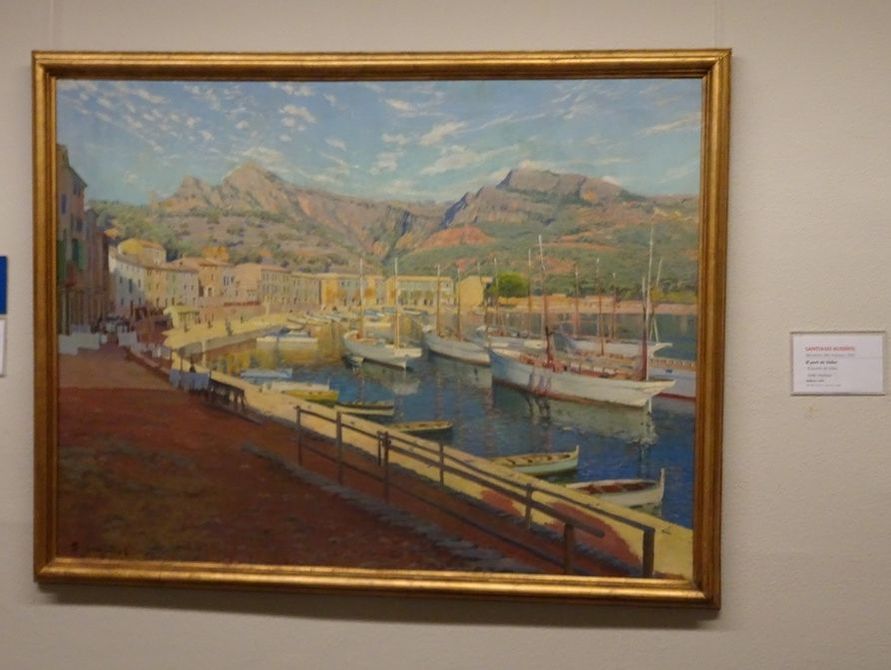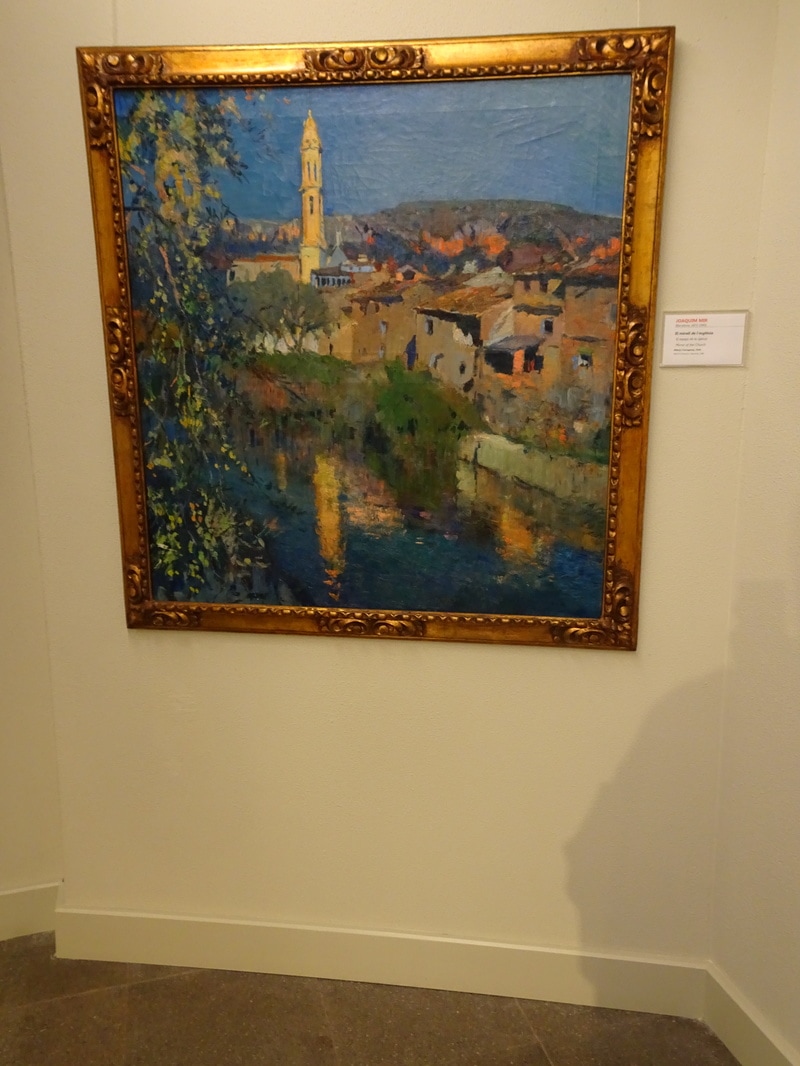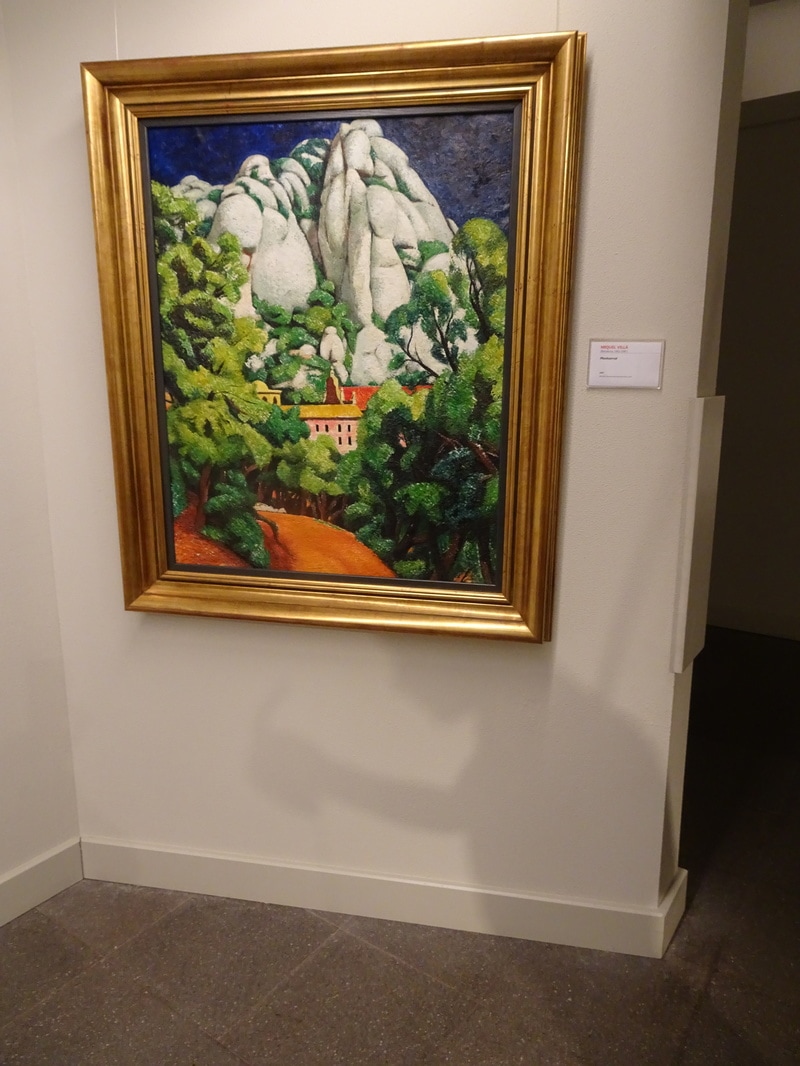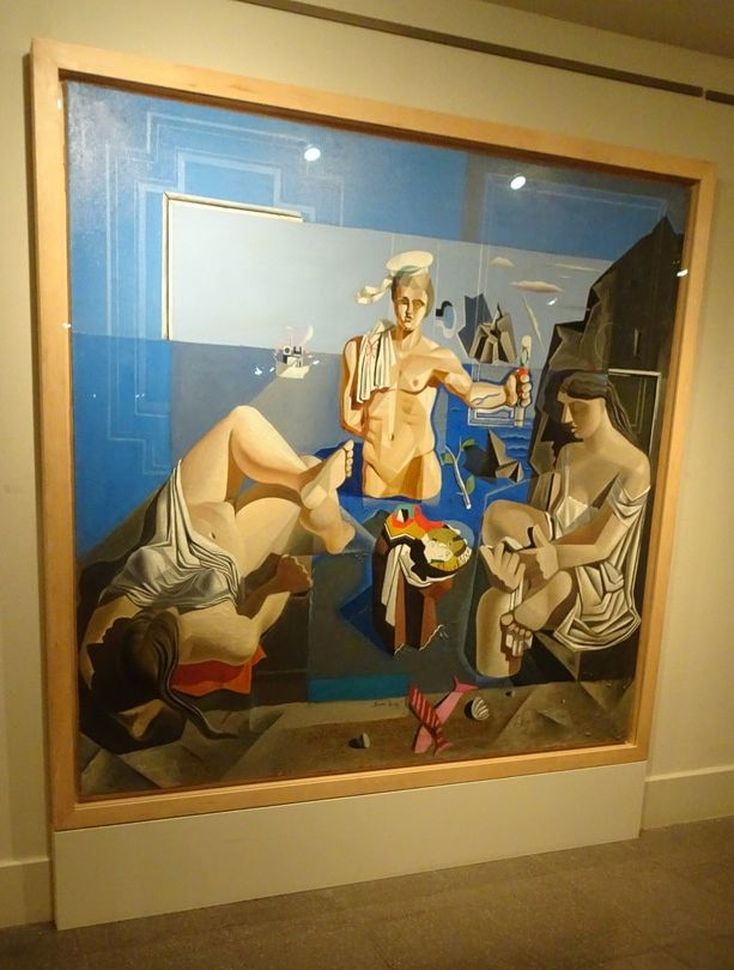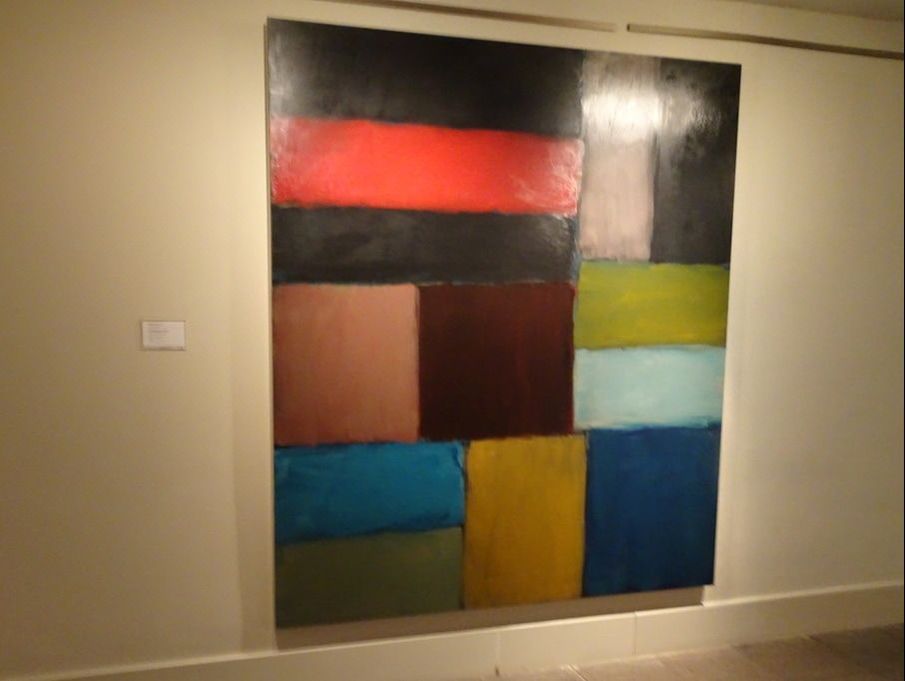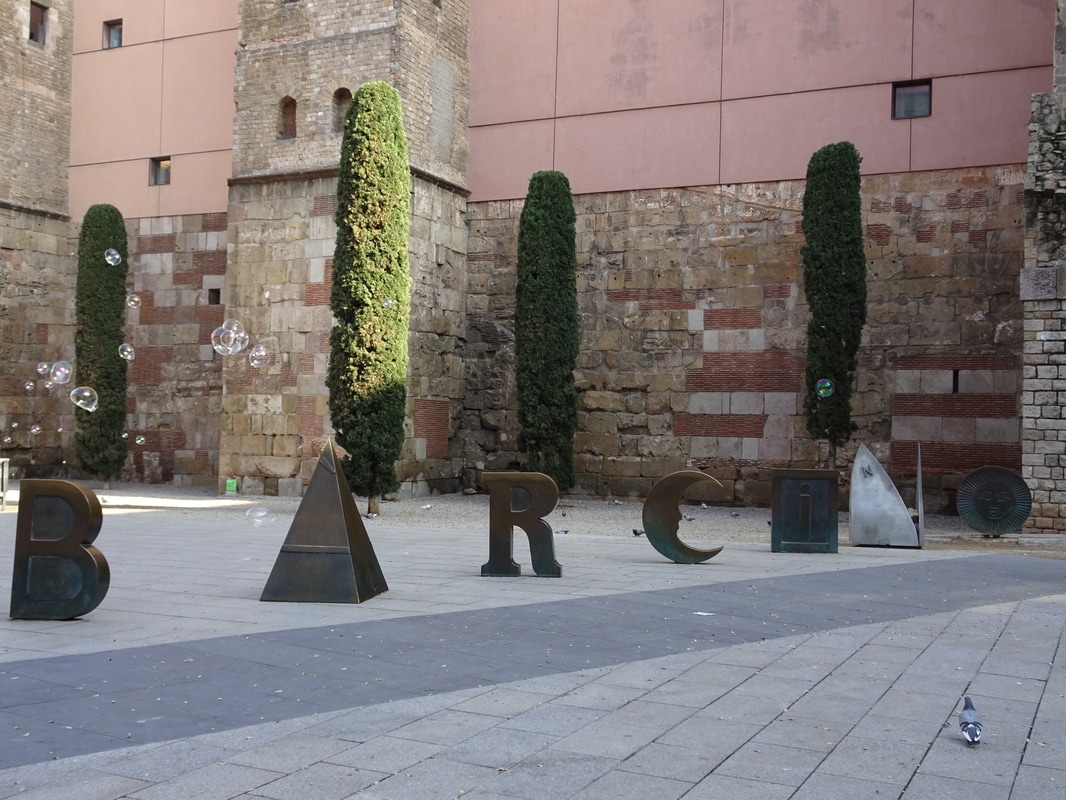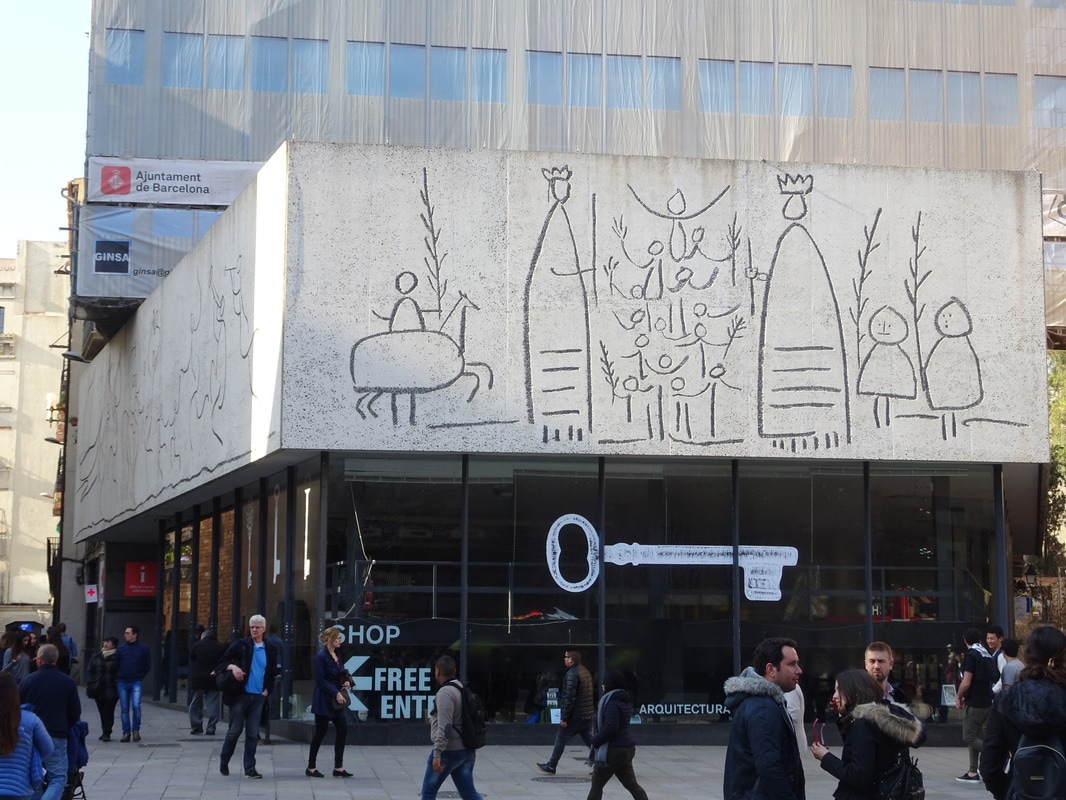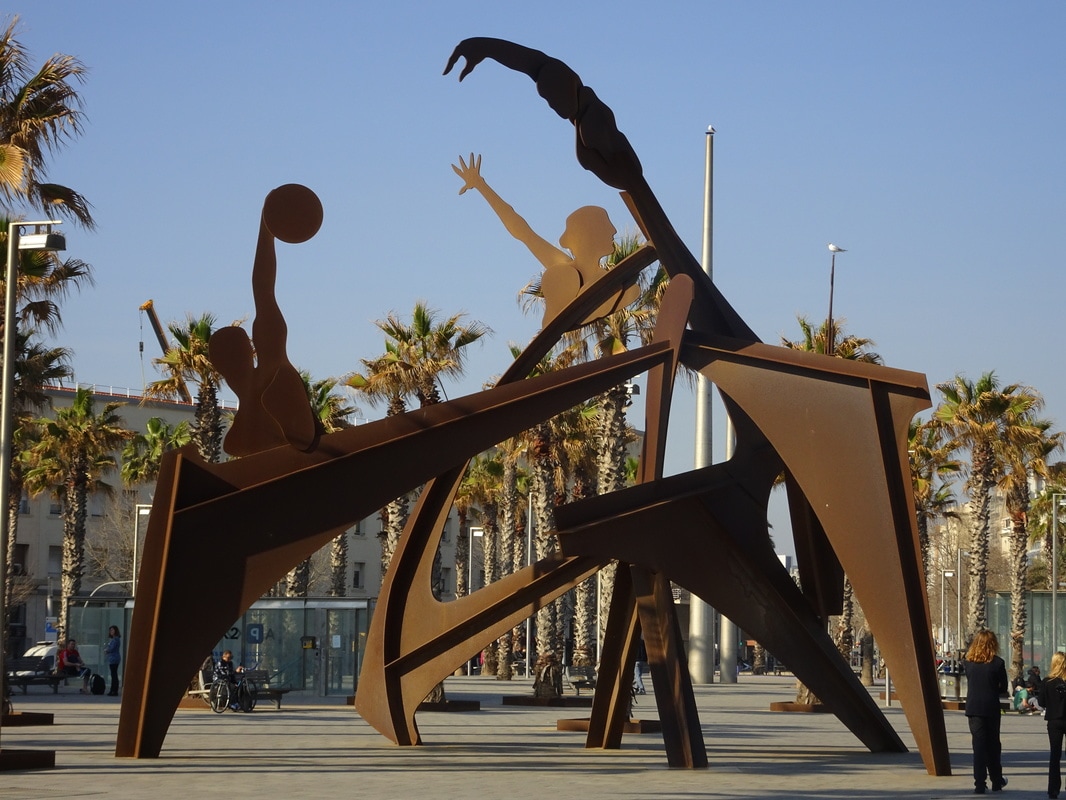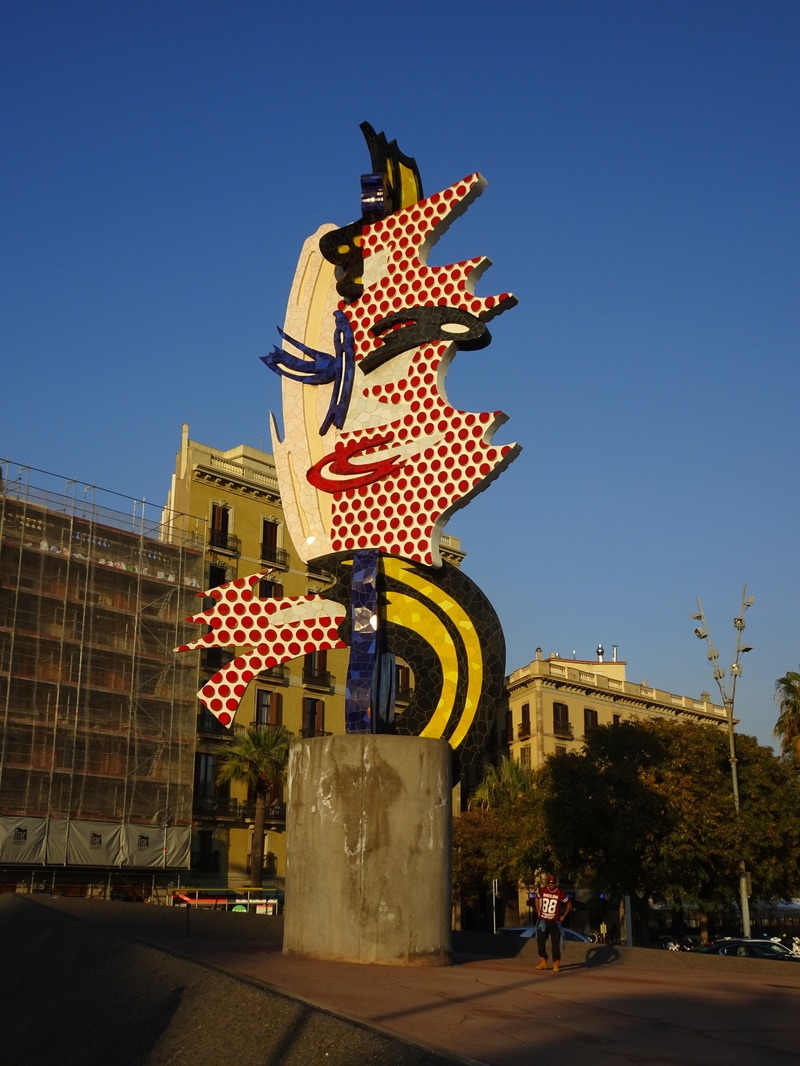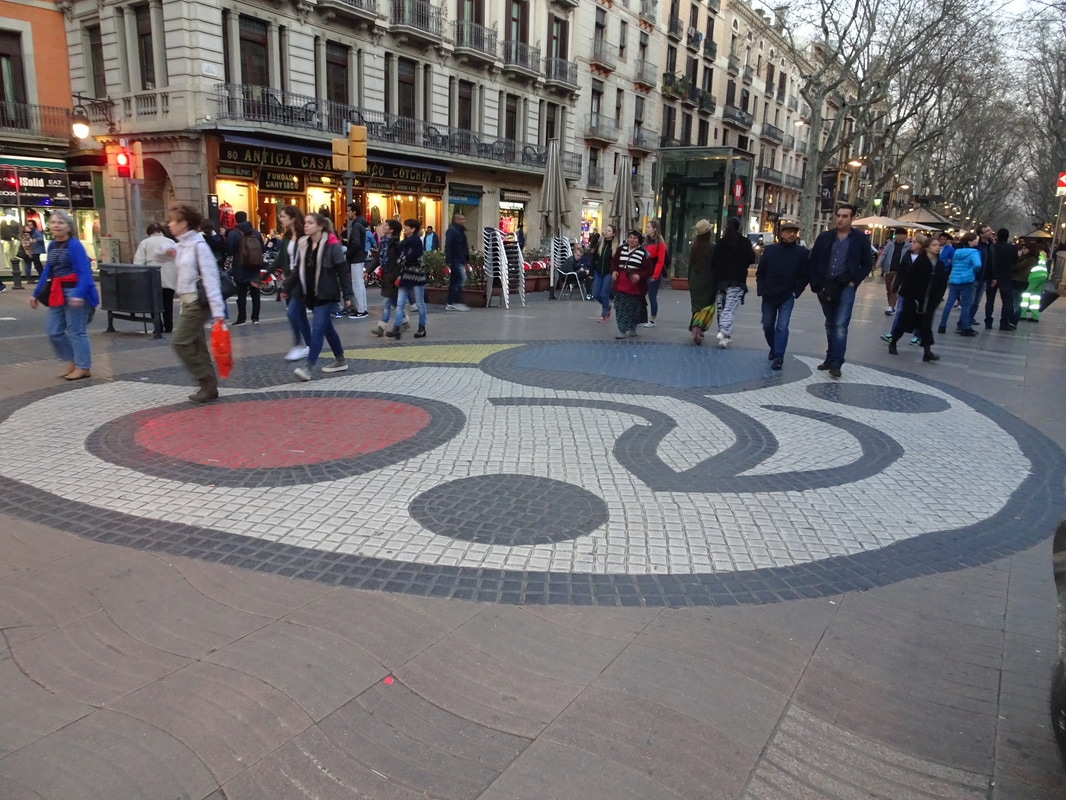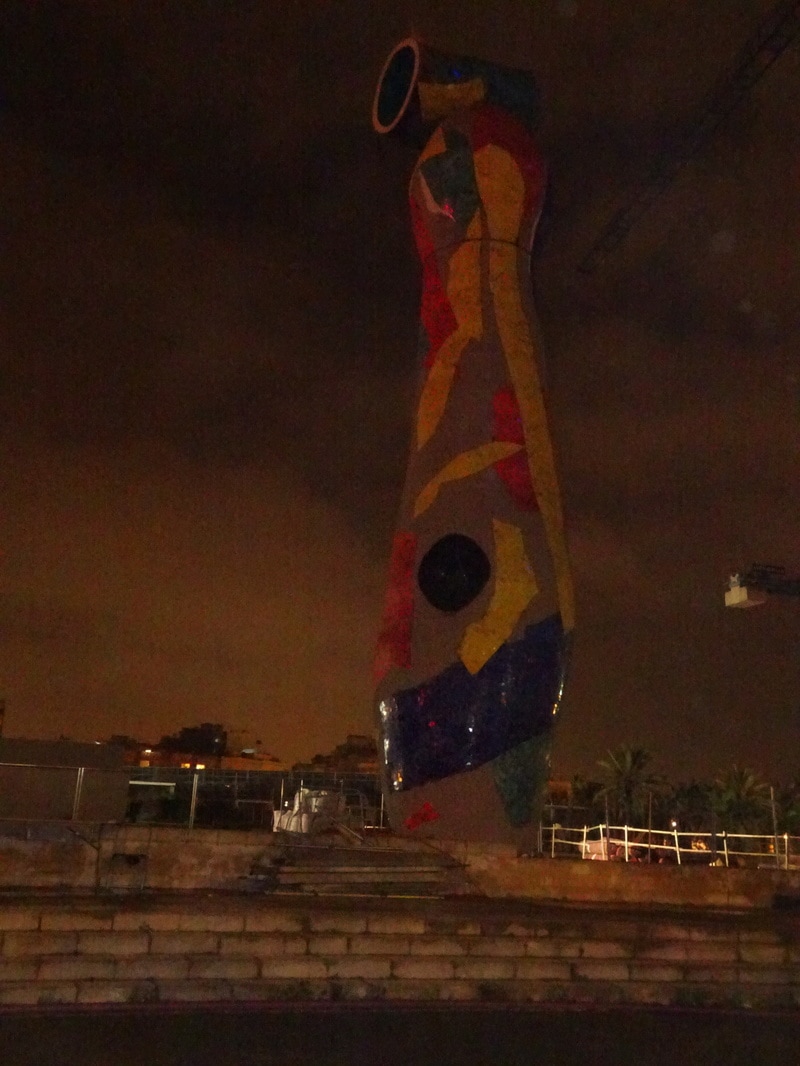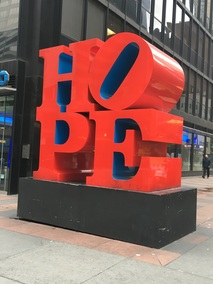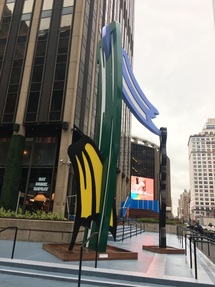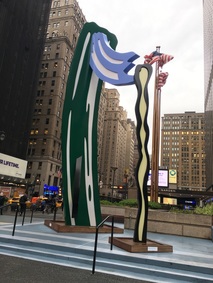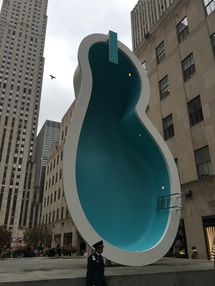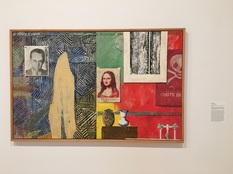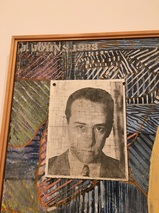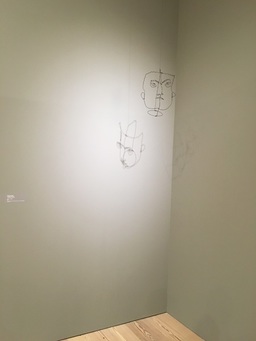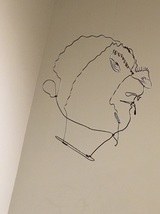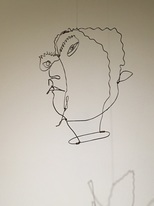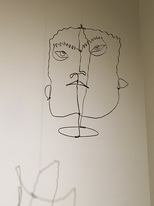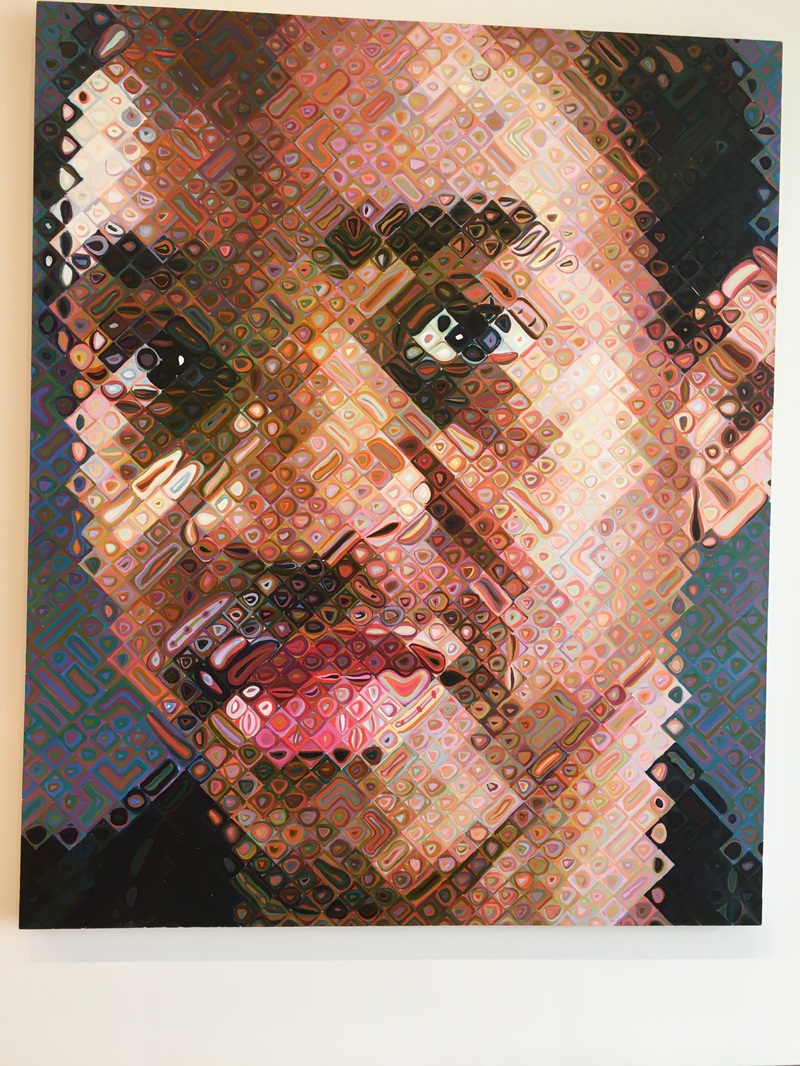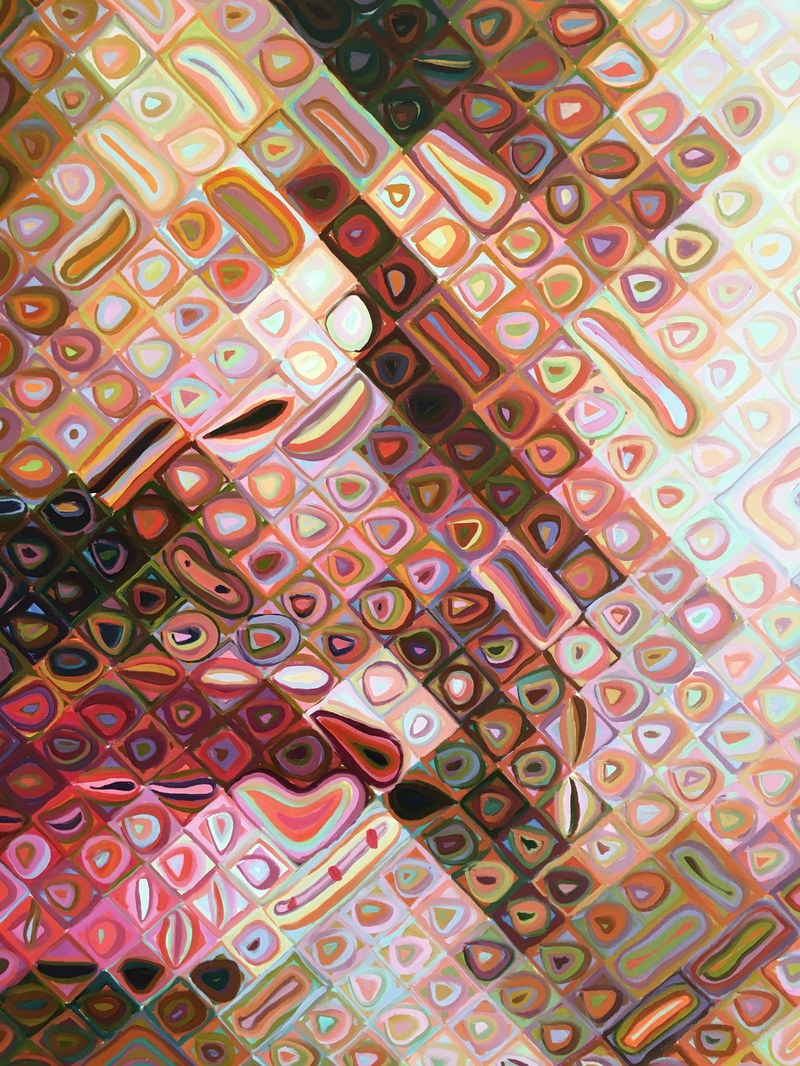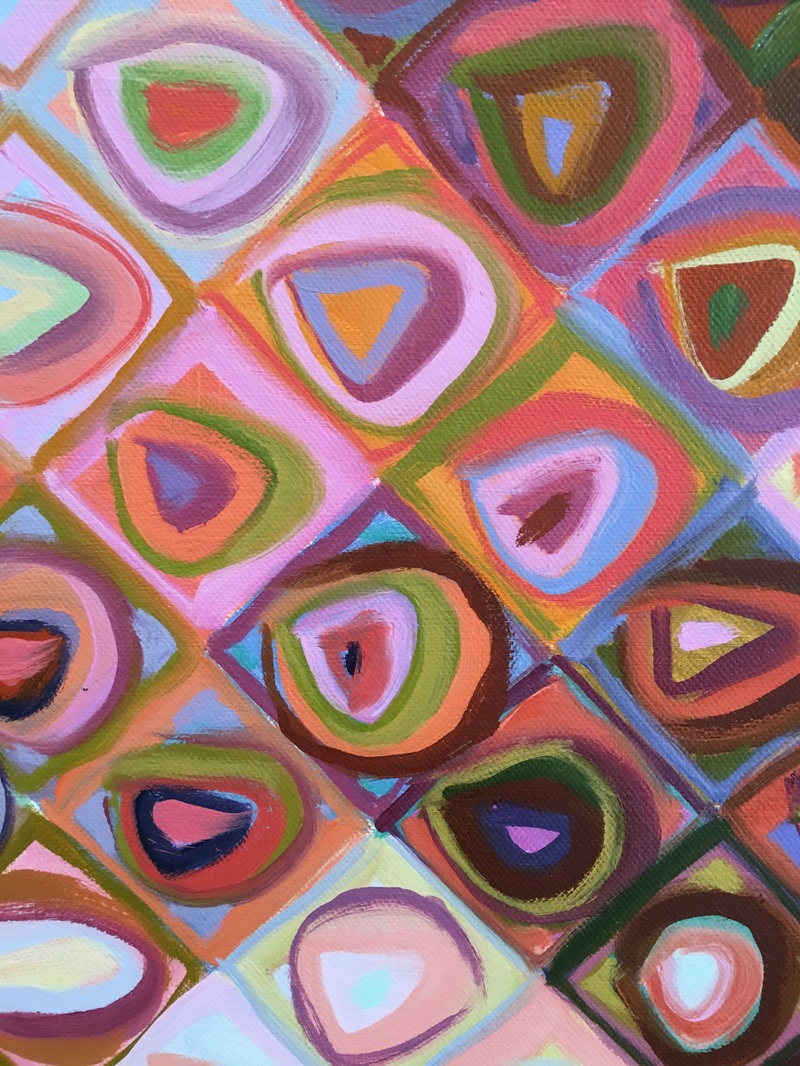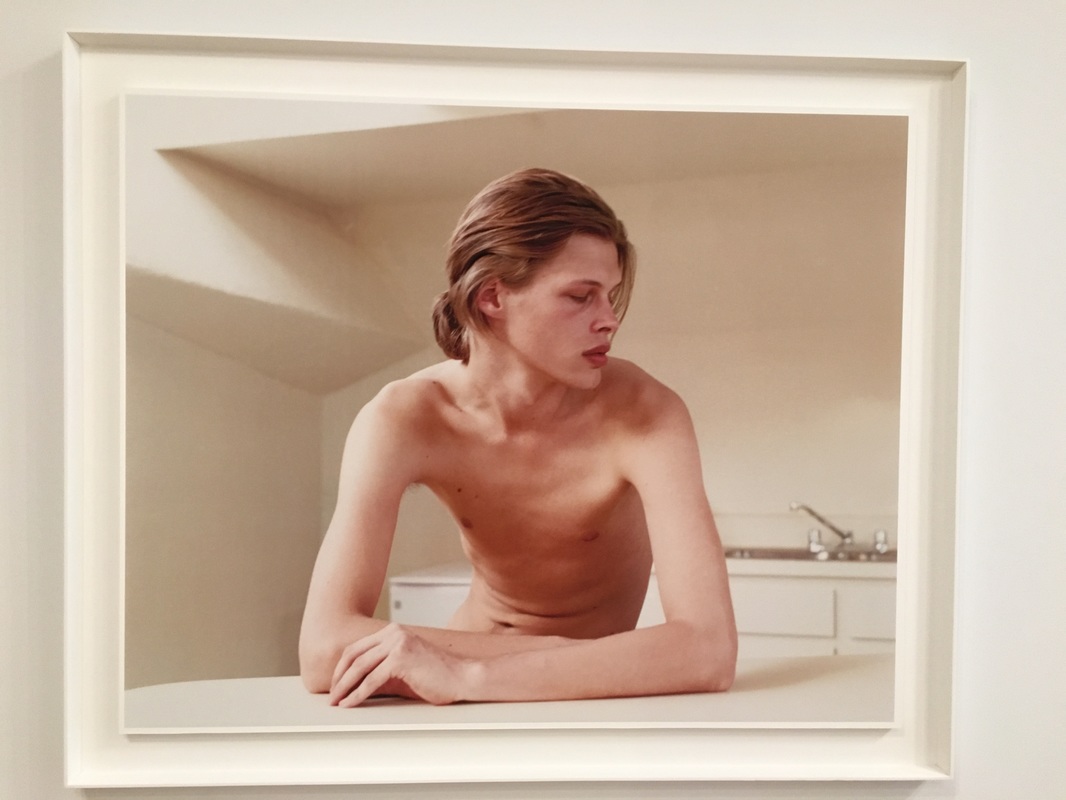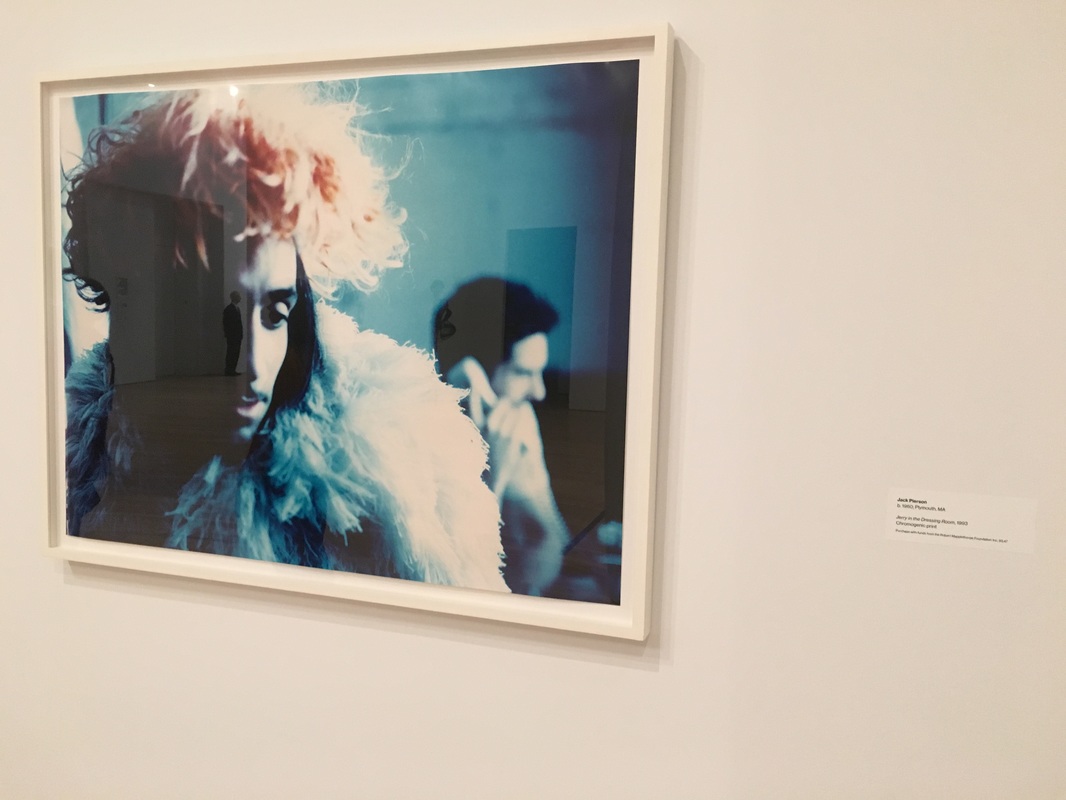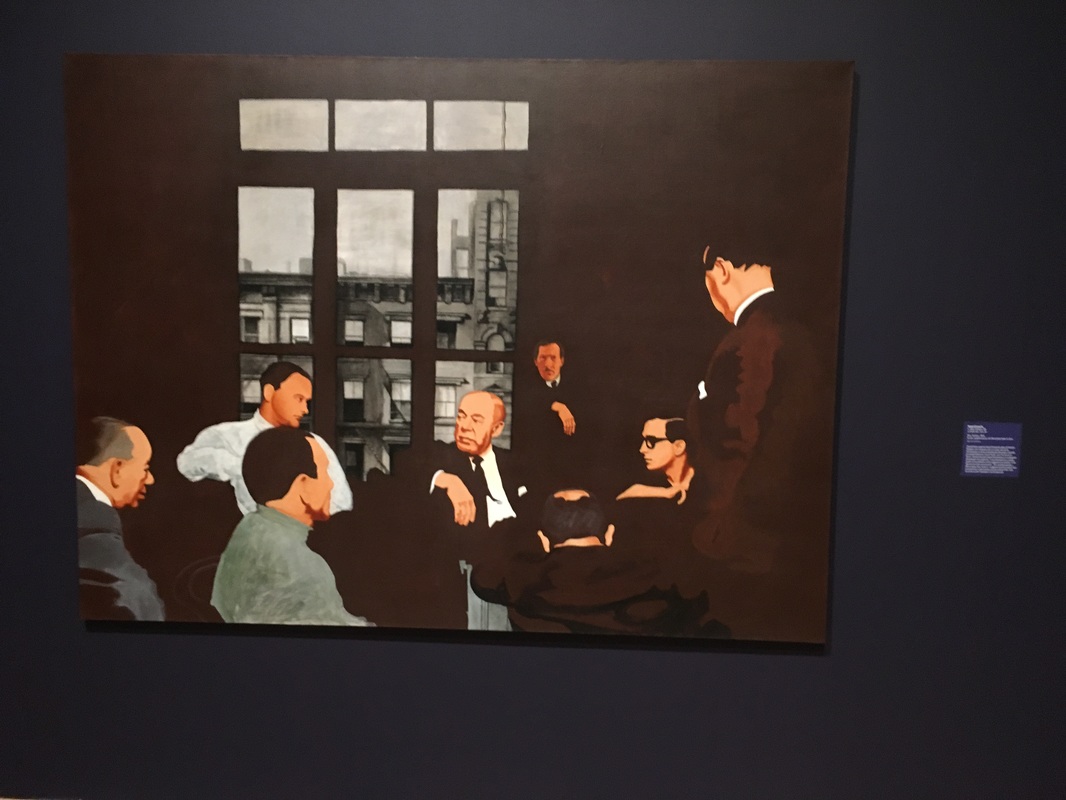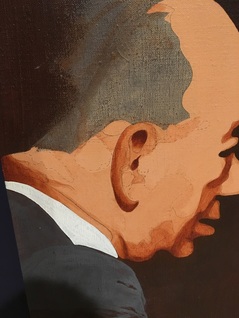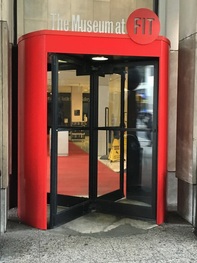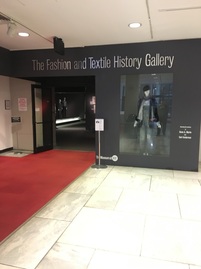Here is Willem de Kooning's 1937-1938 Oil on Masonite painting titled, "Untitled (The Cow Jumps Over The Moon). I learned that de Kooning was trained as a commercial artist and his artistic styles move back and forth between abstract and figurative methods. This painting below is one of his earlier works, which reminds me of Joan Miro's work to some degree. His later artwork, for which he is more well-known, is more gestural and epitomizes the abstract expressionism movement.
I stared at this painting below "Grazing Horses IV (The Red Horses), painted in 1911 by Franz Marc for quite a long time. Not because I love horses, but rather it struck me as fascinating. Franz Marc painted horses a lot, and was known for his preoccupation with animals. I learned that this particular painting was actually his first work of art to enter a museum's collection, the same year it was made. What struck me was his use of unnatural colors in a very natural scene. It's hard to see in the photo, but I was intrigued with the use of bright red in only one or two spots on the horses.
Below is Jasper johns' "The Dutch Wives", encaustic on canvas, created in 1975. If you haven't read my blog article on the Jasper johns retrospective exhibition at The Broad Museum in Los Angeles, you can find it HERE.
Below is a wonderful painting from a German artist that I was unfamiliar with named Corinne Wasmuht. It is titled, "50 U Heinrich-Heine-Str." oil on wood and created in 2009. The painting is a portrayal of Berlin's Heinrich Heine Street subway station and its surrounding neighborhood. It's hard to tell scale from photographs, but this is a huge painting and it's scale immerses the viewer, but the paintings various perspective points and different scales of objects also disorient the viewer. It's really a magnificent painting and I can see why it was gifted to Harvard's Busch-Reisinger Museum. Below are some fascinating samples taken from the Forbes Pigment Collection. Edward Forbes was the director of the Harvard Art Museums from 1909 to 1944. During his tenure, he traveled the world, collecting a large number of pigments for the library. Today, the Pigment Collection contains more than 2,500 samples that are beautifully displayed in cabinets on the 4th floor and are used to this day to help identify pigments used in historical artworks. I came across this wonderful, short video on the Forbes Pigment Collection that was created about 2 years ago. Check it out!
For more information about The Harvard Art Museums, please visit their website: www.harvardartmuseums.org. I definitely recommend visiting the Museum as you're in for a wonderful experience!
0 Comments
Here's a photo of me at the Los Angeles County Museum of Art in front of Chris Burden's sculpture, "Urban Light" installed in 2008. Burden restored over 200 cast-iron streetlamps to create this work of art. Burden was fascinated with urban life and how streetlamps are one of the fundamental building blocks of an urban metropolis. I found it interesting that the streetlamps were recently converted to LEDs, reducing the installations's annual energy consumption by 90%. The conversion to LEDs was funded by the Leonardo DiCaprio Foundation this year. Chris Burden was commissioned by Brandeis University's Rose Art Museum to create a similarly themed sculpture. You can see it by CLICKING HERE in an older blog article about the Rose Art Museum. Chis Burden's "Metropolis II" depicts an urban landscape. Burden created "Metropolis I" seven years before "Metropolis II". The earlier work featured eighty Hot Wheels cars zooming around a model city. This work is much larger and includes 1,100 custom designed cars, 18 highways, and a vast array of buildings and structures. The artwork runs on select days and times, so plan ahead! Richard Serra's "Band" is a massive sculpture that fills a huge exhibition hall from top to bottom, from front to back. The sculpture took two and a half years to develop. Made from over 200 tons of steel, it measures 12 feet high and over 70 feet in length. Below are two views of the same sculpture, titled "Phoenix" by Alexander Liberman, created in 1974-75. I love how a different view of this sculpture creates an entirely new image, a new feeling, a new perspective. "Levitated Mass" (Shown below) was conceived by artist, Michael Heizer, in 1969, but only realized in 2012. "Levitated Mass" is a 456-foot-long concrete pathway, over which sits a 340-ton granite boulder. As you walk down the pathway, it descends to fifteen feet in depth, directly underneath the massive boulder before ascending back up. Below are two views of the same Alexander Calder sculpture created in 1964 titled, "Three Quintains (Hello Girls)." It is made from sheet metal and paint with motor. To me, it appeared to be moved by the wind, but apparently it has a motor that moves the mobile sculpture.
In recent years as you've read in my previous blog posts, I visited museums like the Whitney, the Guggenheim, MOMA, the Brooklyn Museum, the New Museum, the Jewish Museum, just to name a few. I encourage you to look through the Categories Listing on the right side of this page and click on what interests you, whether it be museums, cities, or famous artists. The Met has been in the news this past week because it was announced that its admission policy is changing, requiring visitors to pay for admission (the Museum has been pay-as-you-wish for over 50 years). The new admission policy will go into effect on March 1, 2018. Residents of New York State, and students from New York, New Jersey, and Connecticut will remain pay-as-you-wish. Children under 12 will remain free. Be sure to check out their website for more information: www.metmuseum.org I'd recommend purchasing your ticket(s) online and arriving to the Museum when it first opens. You will wish you had more time for your visit if you don't! The line for admission seemed to span the entire length of the huge museum, but having purchased an advance ticket, I was able to walk in a separate door, check in, and head straight into the galleries. Admission will get you into the Met Fifth Avenue, the Met Cloisters, as well as the new Met Breuer. I didn't have the chance to visit the Met Cloisters and the Met Breuer. My visit to the Metropolitan Museum of New York on Fifth Avenue was amazing. First of all, it is massive. I forgot just how large the museum is that is located on the Upper East Side on Fifth Avenue between East 80th and East 84th Streets. This blog post covers my experience of the Metropolitan Museum of Art on Fifth Avenue, mainly what was on exhibit in their Modern & Contemporary Art galleries, 19th and Early 20th Century European Paintings and Sculpture, and some of their Asian Art collection. There were also two special exhibitions going on that I'll include: One on the hugely talented artist David Hockney. And the other on an artist that you may have heard of before, Michelangelo! At the end of this blog, I'll include a few other artistic surprises outside of the Met I encountered on my trip to NYC.
In Marc Chagall's painting shown below, "Le Pont de Passy et la Tour Eiffel," painted in 1911, we experience a fascinating view of Paris and the Eiffel Tower. The important thing about this painting is its composition. Chagall uses several converging diagonal lines: the bright red road, the orange cement wall, and the lines denoting the blue sky. If you think about the time period of the painting, it's interesting to note how it depicts some of the modern changes to the city of Paris, including the Eiffel Tower, the construction of the Pont de Passy Bridge and technologically modern train, electrical power-lines, and how it is juxtaposed alongside the element of the horses and wagon alluding to and earlier time in history.
With the onset of the Industrial Revolution, painters like Fernand Leger incorporated streamlined forms and contours of assembly-line production into their artwork. In the painting shown here, "Three Women by a Garden" painted by Fernand Leger in 1922, three generations of women are depicted. "Woman with a Cat" was painted in 1921.
Piet Mondrian is one of my favorite artists. Here is one of his iconic paintings called, "Composition" completed in 1921. It's an early example of the geometric style of painting that Mondrian called Neo-Plasticism, that emphasized planar relationships in painting, architecture, and design. Many people who look at my own personal artwork sometimes comment that they see hints of a Mondrian influence in my artwork. Here is Mondrian's painting at the Met, next to one of my paintings! Mondrian used black lines to divide the canvas into rectangles that are sometimes painted in shades of blue and red, creating lighter hues by mixing primary colors with white. Later on in his artistic process, Mondrian stopped creating these hues and used pure, primary colors. In comparing his painting with mine, we each use an entirely different process to create our black lines and blocks of color. If you notice, the black line at the bottom right of his painting doesn't quite reach the bottom. To me, it detracts from the overall design. Here are two other artists, whose works are hung alongside Mondrian's at the Metropolitan Museum of Art. I love Jackson Pollock's artwork! The painting below is called "Number 28" and was painted in 1950. His drip and pour paintings are widely recognized as his greatest achievement in art. He used simple sticks or paint stirrers and enamel house paint, sometimes poured right from the can, spilling lines directly onto raw canvas spread on the floor. What I love about his paintings are that the paint on the canvas we see is a record of the artist's creative process and his movement as he walked around all the sides of the canvas. One of the Special Exhibitions on display during my visit was "Michelangelo: Divine Draftsman and Designer." Michelangelo Buonarroti lived from 1475 to 1564 and is celebrated for his excellence of the power of drawing and invention that provided the foundation for all the arts. His drawing skills, design, sculpture, painting, and architecture all combined to give him the reputation of "The Divine One" by his contemporaries. The exhibition showed a range of over 200 works by the artist that was pulled together from 50 public and private collections across the United States and Europe. The exhibit opened in November and is on view through February 12, 2018. Below are just two of his incredible artworks I saw at the Met. #MetMichelangelo During my visit there was a magnificent exhibit of the British artist David Hockney that showcases 60 years of his art career. I highly recommend visiting this exhibit that is at the Met Fifth Avenue through February 25, 2018. David Hockney's painting address translating movement, space, and time into a two dimensional painting. Hockney is probably best known for depicting California swimming pools and backyards in the mid-1960s. Many of his paintings are quite large, perhaps over 6 or 7 feet square. I love how he uses Acrylic paint on canvas.
Alexander Calder created a series of moving sculptures called mobiles that he created in a diverse range of abstract configurations. Shown here, is a free-moving wind mobile that is carefully balanced on a movable pivot point. I learned that he was inspired by the work of Joan Miro, and the similar shapes and forms can be observed in Calder's mobiles. In the video below, you can see the kinetic nature of his mobile, "Mobile" created in 1941 from painted aluminum, steel, steel rod, and wire. Here are some of Claude Monet's masterpieces...
And lastly, I came across these wonderful sculptures created by artist, Jaume Plensa, that are permanently installed at the Grand Hyatt Hotel near Grand Central Terminal. I learned that these two huge sculptures are reminiscent of the Moai sculptures on Easter Island. Overall, my visit to the Metropolitan Museum of Art was simply amazing. I could have spent the entire day looking at all the art and taking photos of every piece of artwork, but I could only include these 6 dozen or so photos! I wish I had the time to visit Met Cloisters and Met Breuer as well. Well, reason for another visit! I hope you enjoyed this blog and I welcome your comments! Have a friend who would enjoy reading this blog? Then please share it with them via email or social media! You can click on the Facebook and Twitter buttons below! PS: If you liked this article, you might like these other articles on my artistic travels:
Kennebunkport, Maine Los Angeles, California New York City Street Art Napa Valley, California Park City, Utah Barcelona, Spain Caribbean Art Part 1: Barcelona Architecture One cannot talk about Barcelona's architecture without mentioning Antoni Gaudi. Part of the Modernista movement of the late 19th Century, Antoni Gaudi is Barcelona's most famous architect. Almost anywhere you look in Barcelona, Gaudi had some part in its creation, from the houses, apartment buildings, churches, sidewalks, parks, and even the city benches lining the streets. In Modernism, nature was a huge element present in decorative motifs as well as present in the actual architectural structure of Gaudi's buildings. Below are some of Gaudi's masterpieces, but there are dozens of others throughout Barcelona to visit and experience. Casa Batllo I really enjoyed seeing Casa Batllo, which is situated on a main street in the heart of Barcelona. Mosaic is everywhere. The Chimneys of the building are works of art. The roof is representational of a dragon's back. The exterior facade demonstrates Gaudi's expert use of texture and color. Below are some photos of the exterior of the building as well as the interior. The sidewalk tiles as shown in the photos below line the streets and feature an underwater, marine-life motif. Sagrada Familia Gaudi's Sagrada Familia is innovative and highly symbolic. The architect's objective was to explain the teachings of the Church through sculpture and architecture. Following Gaudi's death, work on the Sagrada Familia continues to be carried out by collaborating architects and artists. The project is expected to be complete by 2026, coinciding with the 100th anniversary of Gaudi's death. The stained glass windows were perhaps one of the most beautiful aspects of the Sagrada Familia. The colors were so vivid and bright. Park Guell Park Guell is another one of Gaudi's masterpieces. It was build between 1900 and 1914. It was opened as a public park where Gaudi let his imagination run wild with his incredible use of mosaics throughout the park. Below are some photos of Park Guell. The mosaic work is unbelievable and reminds me very much of the mosaic illusion that I paint in many of my own paintings. La Pedrera La Pedrera is also known as Casa Mila. It was completed in 1912 as an apartment building. There are curved walls that seemingly defy the laws of gravity. The rooftop is amazing at night and includes all of Gaudi's architectural trademarks. Bricks in the attic create arched ceilings and are uniquely used using the log side of the brick, which also features the brick-maker's fingerprints. There are terrific wrought iron balconies and exquisite ceramic mosaics. I highly recommend visiting La Pedrera by booking a night tour, which includes a full tour of the building and a surreal visual light display on the rooftop under the stars, followed by a champagne toast and cookies! Although my time in Barcelona didn't permit me to visit the Palau Guell, I should mention that it is an excellent example of one of Antonio Gaudi's early architectural masterpieces. It is a UNESCO World Heritage Site, and is a magnificent example of domestic architecture in the context of Art Nouveau and one of the first important commissions Gaudi received at the start of his career. It is located just steps away from La Rambla, not far from La Boqueria. Part 2: Barcelona's Art Museums and Fine Art A Guide to Visiting Barcelona's Museums: If you plan to visit Barcelona, I highly recommend purchasing the Barcelona Museum Pass, also known as an art passport from ArtTicket BCN, which will give you access to six Barcelona museums, including the ability to skip the lines. The Passport give you access to the Picasso Museum (Museu Picasso), the Joan Miro Museum (Fundacio Joan Miro), the National Museum of Art of Catalunya (Museu Nacional d'Art de Catalunya), the Antoni Tapies Museum (Fundacio Antoni Tapies), the CCCB, and the MACBA. I purchased the passport online (for 30 Euros), and simply showed the ticket to the first museum I visited to receive the passport. The passport is stamped upon entry at each museum. To learn more about the ArtTicket BCN, check out their website: http://articketbcn.org/en/barcelona-museum-pass. I should also mention that it is very important to check the hours of each of the museums as they vary significantly. Most museums, with a few exceptions, are closed on Mondays. Also, all city museums are free at last one afternoon per month, so be sure to check the websites in advance for hours and special exhibition dates. If you're interested in contemporary art, check out this website that provides a network devoted to contemporary art in Barcelona: http://www.artbarcelona.es/circuit/en/. Picasso Museum in Barcelona The Museu Picasso of Barcelona is a wonderful center documenting Pablo Picasso's early years of apprenticeship. With over 4,000 works of art in its permanent collection, you'll see why this museum is one of the most popular tourist attractions in Barcelona. The Picasso Museum highlights the artist’s relationship with the city of Barcelona. I learned that Pablo Picasso's father was a teacher at the San Telmo Fine Art and Crafts School. and had an important influence on Picasso's future career as an artist, who demonstrated a strong interest in art from a very young age. There are some drawings and small panels in oil that give an idea of his efforts to give his own creativity free rein and explore new techniques by taking in his immediate environment. In Barcelona, Pablo Picasso continued his art education at the La Llotja Fine Art School. The photos here show his artwork featuring Barceloneta Beach and two ports. After taking these photos, I learned that photos were not allowed, so unfortunately, I do not have photos showing the rest of the museum. This Picasso museum focused on his earlier works, and very few on display were "well-known Picasso masterpieces." The museum highlighted Picasso's creative process of some of his work of his Blue Period. Some of the highlights of the museum included Las Meninas Series. This was a series of paintings based on the Velazquez painting Las Meninas. For more information, please visit www.museupicasso.bcn.cat. Fundacio Joan Miro The Joan Miro Museum (Fundacio Joan Miro) is located in the Montjuic area of Barcelona and houses the work of Joan Miro as well as temporary exhibitions of 20th and 21st Century art. The collection of paintings, sculptures, drawings displayed at the museum is one of the most comprehensive collections representing every stage of Miro's career as an artist. There are paintings related to Surrealism and works based on the Spanish Civil War. Miro's work on large canvases in the late 1970s onward demonstrate his use of large color fields and painting with free gesture. For more information, please visit www.fmirobcn.org.
Museums Further Afield from Barcelona: In the town of Girona, I visited the Museum of Jewish History. The goal of the Museum is to preserve the history of the Jewish communities of Catalunya. Art at this museum included various Jewish ritual objects. Be sure to visit if you are in Girona, which is not far from Figueres, where the Dali Museum is located.
On of my favorite pieces was this one below entitled, "Gala Contemplating the Mediterranean Sea which at a distance of 20 meters is transformed into the portrait of Abraham Lincoln (Homage to Rothko).” Gala was his wife and muse for many years. The exterior of the museum is a work of art as well. Statues with loaves of bread on their heads. Inside the museum in the open air courtyard is a spectacular and wild work of art called, "Rainy Taxi". If you put a Euro in the slot located at the base of the artwork, it will rain inside the taxi, and an umbrella will open up on top of the artwork!
The museum includes paintings by Old Masters with works from the 13th Century to the 18th Century. The largest section of the museum is devoted to works from the 19th and 20th Centuries and includes a wonderful selection of Catalan painting and sculpture of the Modern period. I was very impressed with their collection of paintings by the great masters of French and international impressionism (Degas, Sisley, Monet, Pisarro, Sargent, etc.). Picasso and Dali, avant-garde artists are also well represented! Part 3: Barcelona's Public Art The streets of Barcelona are filled with art by world renowned artists. Below are just a few of these that I came across on my artistic journey.
PS: If you liked this article, you might like these other articles on my artistic travels:
Los Angeles, California New York City New York City Street Art Napa Valley, California Park City, Utah Caribbean Art I recently returned from a quick 2-day trip to New York City. The first day was primarily focused on a new movie I am working on (currently looking for investors for the film) called “Dan & Carla.” We had a spectacular table reading of the script with the actors along with a number of friends and interested parties of the film. After the reading, I had the pleasure of meeting and speaking with Jack Pierson, a longtime family friend of the film’s director. Jack Pierson is an incredible artist who works with a variety of different mediums, including sculpture, photography, video, and is best known for his word signage installations. His artwork is in the permanent collections of the Whitney Museum of American Art, the Metropolitan Museum of Art, the Guggenheim Museum, just to name a few. (See below for more about his two incredible pieces that were on view at the Whitney Museum.) Here’s some information about the film for those interested: It is a modern-day romantic comedy about two young NYC lovebirds who try to salvage their troubled relationship: Dan & Carla, two lovers from opposite sides of the subway tracks, are forced to confront the issues of romance, commitment, betrayal and sexual (dis)orientation.” For more information: www.Facebook.com/danandcarlathemovie http://www.imdb.com/title/tt4324704/?ref_=fn_al_tt_1 There is SO MUCH ART in New York City! There were three pieces of public art that I had the pleasure of seeing on this trip. Here is a photo of Robert Indiana’s HOPE Sculpture located on the corner of 7th Avenue and 53rd Street. A couple months ago, I wrote in my blog about Robert Indian’s LOVE Sculpture in Scottsdale, Arizona. This HOPE Sculpture is also only a few short blocks away from the LOVE Sculpture in New York City 55th and Avenue of the Americas/6th Ave. I’ve learned that each year on the artist’s birthday, September 13, Robert Indiana HOPE sculptures will be installed and displayed in locations throughout the world. The HOPE sculptures celebrate the message of hope and fulfill the artist’s vision of a more promising future for us all. Another public sculpture, located just outside of Penn Station and Madison Square Garden (7th Avenue and 33rd St.) is Roy Lichtenstein’s “Brushstroke Group.” And the last public art sculpture that I got to see was Elmgreen & Dragset’s “Van Gogh’s Ear” located in Rockefeller Center. It’s basically a huge swimming pool stood upright. I really liked how misplaced it looked, especially in such a dense area, with a huge amount of foot-traffic, in contrast to a large swimming pool, typically seen in a less congested area. This is a temporary installation, so be sure to see it before June 3rd! I started the second day of my trip at the Whitney Museum of American Art. The new Whitney’s architecture is spectacular inside and out. And the artwork within the walls of the Whitney is very special. On the Sixth and Seventh Floors of the museum, I experienced the exhibit, "Human Interest: Portraits from the Whitney's Collection." It made me rethink my own internal definition of the word "Portrait." The exhibit demonstrated the way portraiture has changed from the early 1900s to present day. When you think about it, the whole concept of portraiture has changed over time. The painting of portraits was once reserved for the elite, and those who could afford such a luxury, yet with the rise of photography, everything has changed. With the iPhone and other smartphones and with the influence of social media, the "selfie" is almost a new form of portraiture. Whatever the form, portraits get to the very essence of who we are as people and our place in the world.
Chuck Close, is very well known for his huge, floor to ceiling, portraits best viewed first from afar, and then up close (excuse the pun). This is his work titled "Lyle" and I've included a few views for you to see the genius behind his artwork. And Jack Pierson, who I had the pleasure of meeting the night before, had two of his many works that are part of the Whitney's permanent collection, on display. One a self-portrait, "Self Portrait #4", 2003, and the other called, "Jerry in the Dressing Room", 1993. I also saw some impressive works of art from some artists that I haven't been exposed to before. The painting shown here is one from the artist, Howard Kanovitz, called "New Yorkers 1". It's a very large painting and I found it to be very striking. I especially liked seeing the use of pencil within the painting as shown in this close-up photo. There is a beautiful outdoor space with stairs leading to other levels and views of the surrounding cityscape and the new, NYC treasure, the High Line. If you plan to visit the Whitney Museum, you could also walk on the High Line either before or after what is sure to be an incredible art experience at the Whitney! After the Whitney, I visited the Chelsea Market where I stumbled across a wonderful ID Pop Shop that featured apparel, accessories, Jewelry, and art. www.Idpopshop.com I then proceeded on my quest to visit some of the Chelsea galleries that feature modern and contemporary art. Some galleries were focused on established artists and artists who are well-known to the general populace and others showcased emerging artists. I walked my feet off and ended up visiting about two dozen difference art galleries in Chelsea. I'll share some of my favorites here: One of the galleries that I really enjoyed visiting in Chelsea was Jim Kempner Fine Art. http://jimkempnerfineart.com/ It was at this gallery that I was introduced to an artist named Greg Parker. His artwork features a unique process that results in an unbelievably cool work of art. He starts with a wood panel that is covered with up to 20 layers of polished gesso, thin layers of powdered pigment and graphite that is applied in progressive steps within mathematical systems. Kind of looks like metal or wood but the end result is a subdued reflective surface that is solid at nature. At the Bryce Wolkowitz gallery, http://brycewolkowitz.com located at 505 W. 24th St., I saw a truly unique exhibit of multimedia sculptures and video installations from the artist, Yorgo Alexopoulos, I have learned that he films the 4K video, makes use of a translucent LCD video screens, robots, 3-D printers, motorized dollies, and multiple cameras simultaneously shooting time lapse photography. The piece that I found most compelling was one titled "First Time On The Moon,” which is comprised of the digital animation on a high definition translucent LCD display, aluminum and patina steel, glass, and custom electronics. The subject matter is the moon with the earth hovering in the distance in space. The Berry Campbell Gallery www.berrycampbell.com presented the work of the artist Stanley Boxer, a Massachusetts born artist known for his thickly painted abstract works of art. I visited the new Lisson Gallery at 504 W. 24th St. lissongallery.com It was a brand-new exhibit that opened just this past week, featuring the artwork of Carmen Herrera. I learned that she has been painting for almost 80 years in her Manhattan studio. She's perhaps the oldest living artist I've seen on my venture; she will celebrate her 101st birthday later this month and will be honored with a survey exhibition at the Whitney Museum of American Art in September 2016. The exhibit at the Lisson Gallery represents a new body of work produced in the last two years. The paintings exhibited were primarily acrylic on large-scale canvases. They almost had an Ellsworth Kelly kind of feel to them, in terms of the colors used in a very minimalist way. At 138 10th Ave., I visited Lori Bookstein Fine Art. www.loribooksteinfineart.com There were a few artists represented in this gallery exhibit, but one stuck out to me, an artist named Diana Horowitz. The exhibition featured a series of small paintings depicting the landscape of and around Lake Como, Italy. She painted on en plain air and each of the small 5" x 7" or smaller canvases had subdued tones and colors capturing the light across the landscapes. One of the most unusual, yet fascinating exhibits that I saw was at the Lions Wier Gallery at 542 W. 24th St. www.lyonswiergallery.com The gallery featured the pop artist, Jae Yong Kim in the exhibit titled "Pop Goes The Donut". The walls of the gallery were lined with ceramic, glazed donuts, many featuring Swarovski crystals, gold, and other mixed media. At the Cheim & Read Gallery, a brand new exhibit features the work of Spanish artist, Juan Uslé. Jack Pierson has shown his work at this gallery in the past. Many of the works were in excess of 9 feet in height. I learned that the short, broad brushstrokes comprising the bands in his paintings are based on the artist's pulse, similar to a cardiogram. www.cheimread.com The Agora Gallery at 530 W. 25th St. focuses on emerging artists, and I recommend checking this gallery out for emerging talent! www.Agora-Gallery.com The Rush Arts Gallery (Rush Philanthropic Foundation www.rushphilanthropic.org) at 520 W. 26th St. featured an exhibit called “Medium: Black.” The Rush Philanthropic Foundation is a non-profit founded in 1995 by media mogul Russell Simmons and his brothers and is committed to bettering the lives of under-served city youth through exposure to the arts and to provide professional support for emerging artists and curators. The group show featured artists that all use the color black. One of the pieces of artwork that I found most fascinating in this gallery was the work of Charlotte Becket who used a motor within the artwork, giving the artwork almost an organic or living feeling to it. The Tagliatella Galleries featured some originals and prints from some of the more well-known contemporary artists like Alex Katz, Andy Warhol, Roy Lichtenstein, Mr. Brainwash, Bansky, Kaws, Damian Hirst, Keith Haring, Jeff Koons, etc. http://www.taglialatellagalleries.com/ Another well-known and established gallery, The Pace Gallery, featured David Hockney prints entitled, “The Yosemite Suite”. http://www.pacegallery.com/ The Robert Miller Gallery on 26th St featured the work of Lee Krasner. http://www.robertmillergallery.com/ And the Mitchell-Innes and Nash Gallery featured the incredible work of Tom Wesselmann. http://www.miandn.com/ Before heading back to Boston, my final stop was the Fashion Institute of Technology where I was able to see a wonderful exhibit on the history of denim. When you think about fashion, denim is one of the many materials out there that really stands out and has lasted for hundreds of years. Denim may even be the most popular fabric in the world today. The exhibit entitled: “Denim: Fashion’s Frontier” showed the evolution of denim. The exhibit takes you from the very earliest use of denim all the way to present day, highlighting the milestones denim has had impacting the fashion world. In its last days, this exhibit will be followed by an exhibit on May 20th, entitled “Uniformity,” which will explore the history behind a variety of uniforms (military, work, school, and sports), considering both their social role and their influence on high fashion. The Museum at FIT is located at 7th Avenue at 27th St. http://www.fitnyc.edu/museum/ I hope you enjoyed reading this blog and my reflections on the art I've seen. Please check out the websites of these galleries for more information and for current exhibition dates! PS: If you liked this article, you might like these other articles on my artistic travels:
Kennebunkport, Maine Los Angeles, California New York City New York City Street Art Napa Valley, California Park City, Utah Barcelona, Spain Caribbean Art |
The Art ConnectionWelcome to Eddie Bruckner's Art Blog! Archives
April 2022
Categories
All
|
